Allison Collection Photos
December, 1943
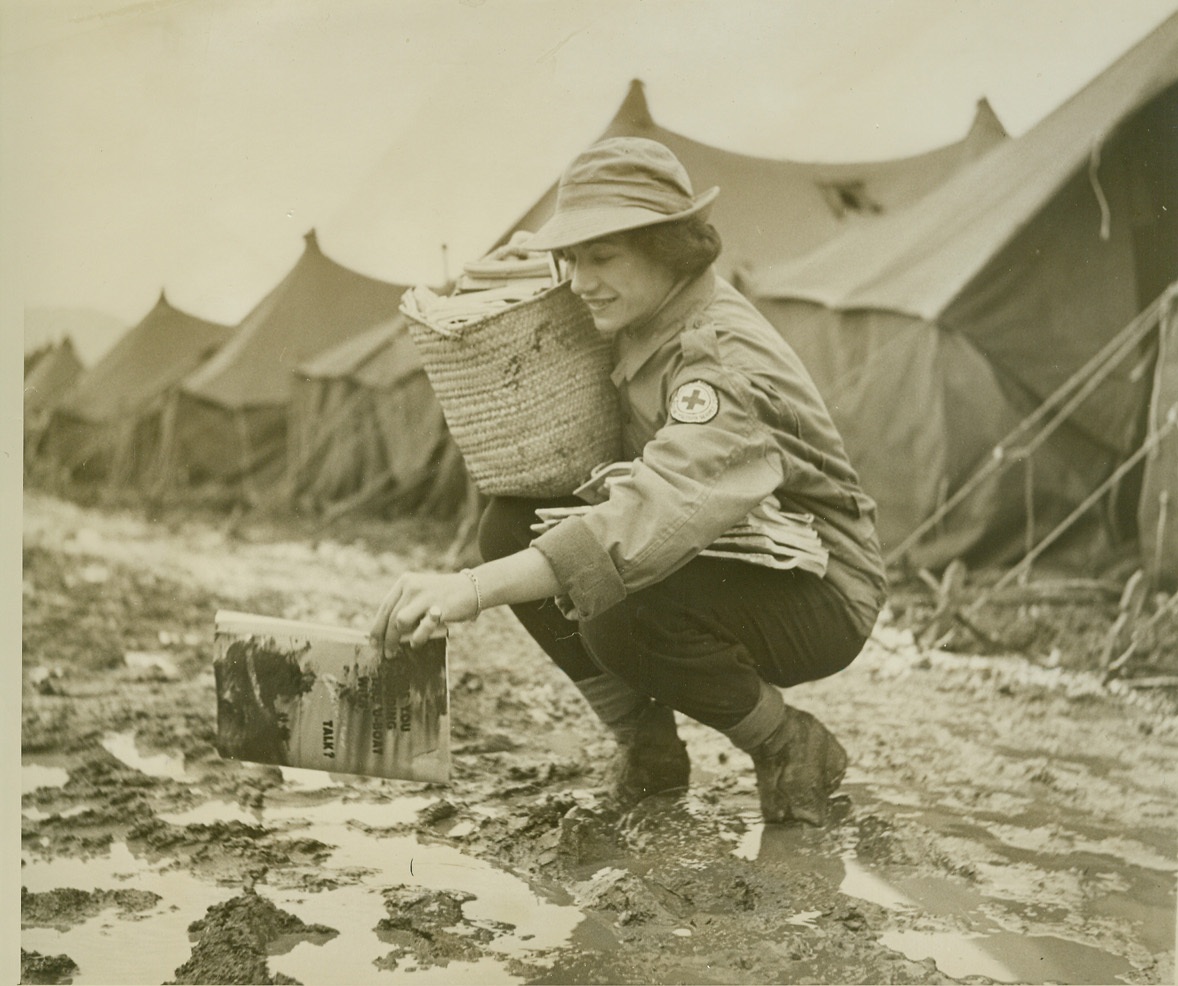
Magazine Bites the Mud, 12/3/1943. Somewhere in Italy – “Butterfingers” don’t go on the Italian front these days because anything dropped in the mud that covers the countryside is ruined. Red Cross worker Nancy Gres of Narberth, Pa., stoops to pick up a mud-covered magazine dropped as she was making the rounds of an evacuation hospital with books, cigarettes and magazines. Credit: (Photo by Bert Brandt, ACME Correspondent for War Picture Pool);
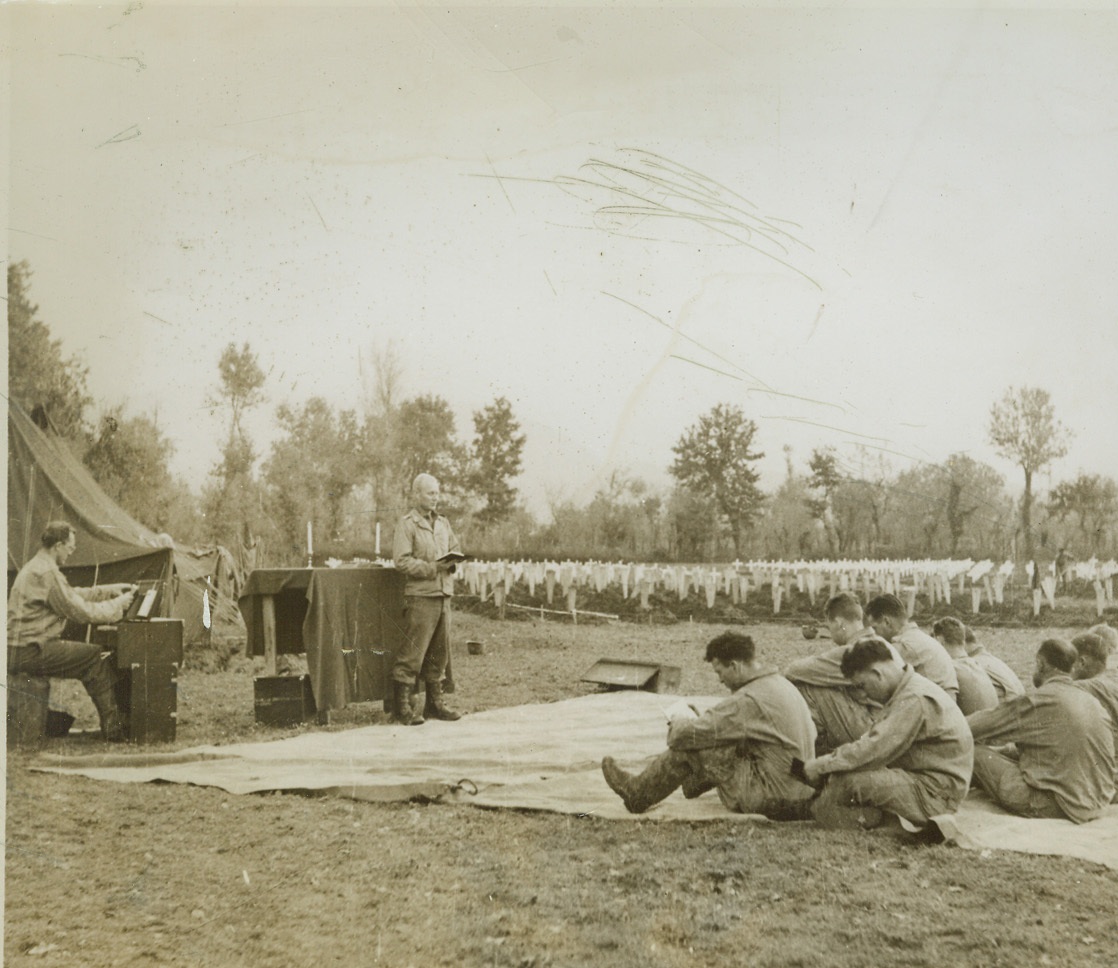
Prayer for Lost Comrades, 12/19/1943. Italy – Close to the graves they tend, Allied Fifth Army soldiers bow their heads in prayers led by Capt. Christ A. Lehne, Chaplain of Fredericksburg, Texas. In the background, other service men erect crosses and tidy the final resting places of Americans who died in battle. Credit: (ACME);
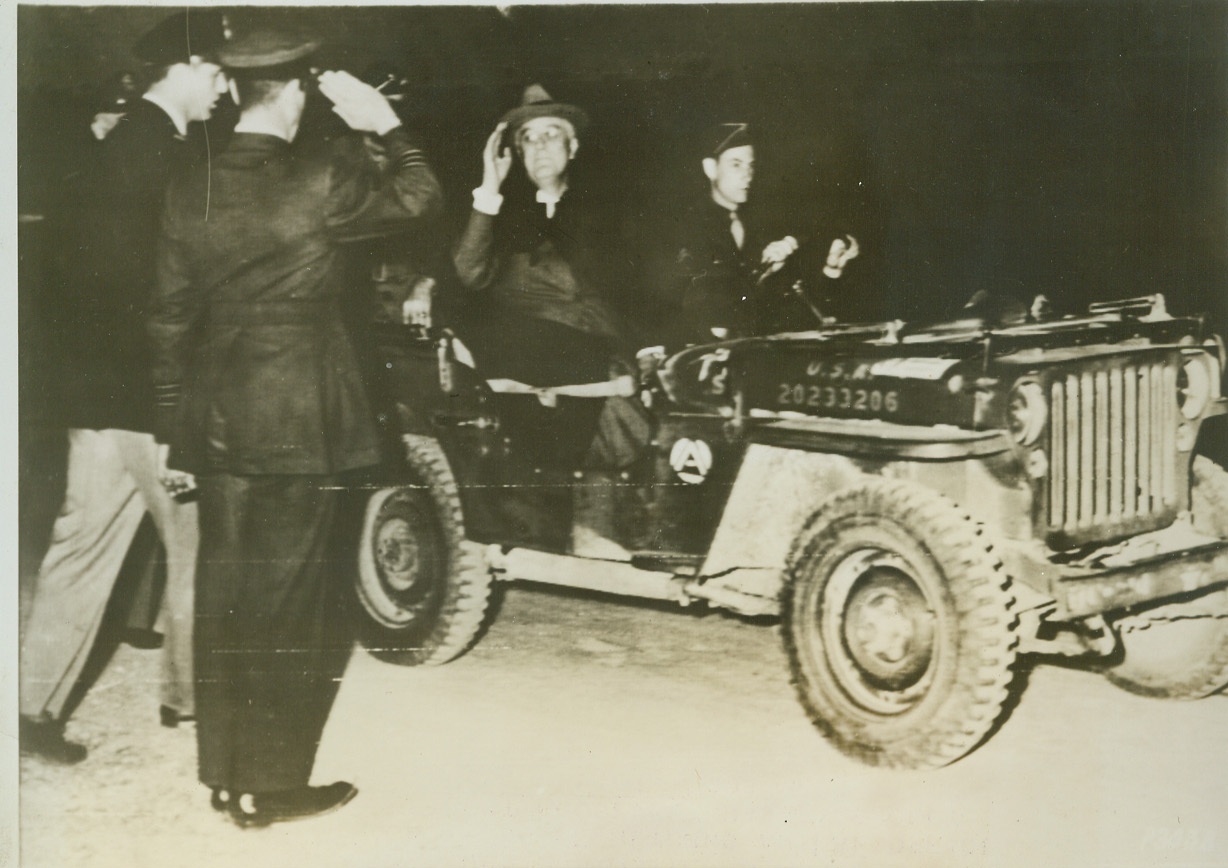
FAMOUS FATHER MEETS FIGHTING SON, 12/4/1943. NORTH AFRICA – As he returns an RAF officer’s salute, President Roosevelt has eyes only for his son, Col. Elliot Roosevelt, (left) Commanding Officer of a reconnaissance unit, who greets the American Chief Executive at an airfield in North Africa. Driver of the Presidential jeep is Cpl. Arthur S. Rice, of Greensburg, MO who also had Gen. Eisenhower and Lt. Gen. Carl Spaatz as passengers. The RAF officer is Wing Comdr. Eric L. Fuller, Deputy Commander of a photo unit. Credit: Signal Corps photo via OWI Radiophoto from ACME;
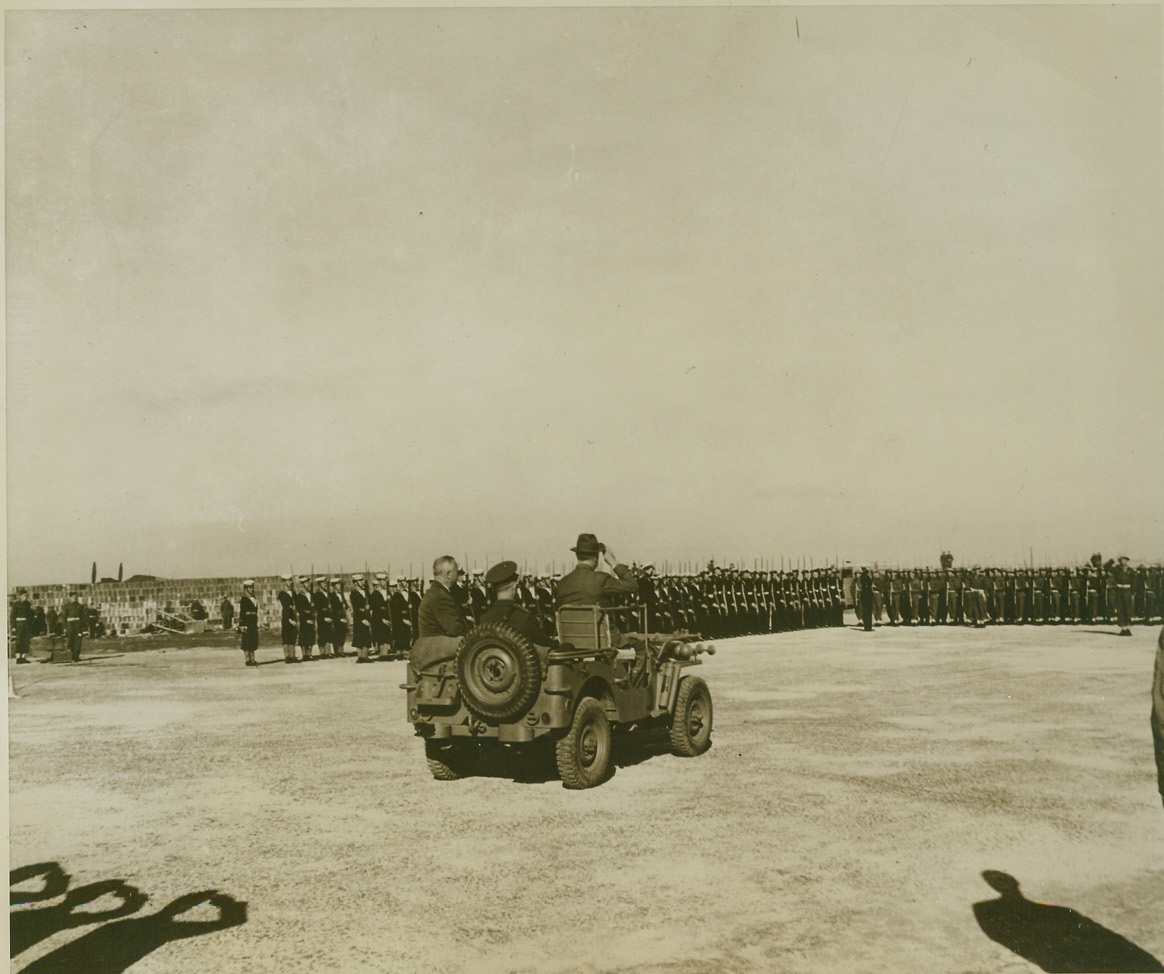
ROOSEVELT REVIEWS GUARD IN MALTA, 12/14/1943. MALTA – President Franklin D. Roosevelt, (seated in front), and Field Marshal Lord Gort, (seated in rear), Commander-In-Chief of Malta, as they rode along in a jeep to review a Guard of Honor, during the President’s recent visit to the Mediterranean Island. The Guard was made up of a RAF Unit, 50 British Marines, 50 Royal Navy men, and 100 Maltese troops. The jeep is one of three presented to the British by Gen. Dwight Eisenhower and the vehicle bears the name, “Husky” Credit: OWI Radiophoto from ACME;
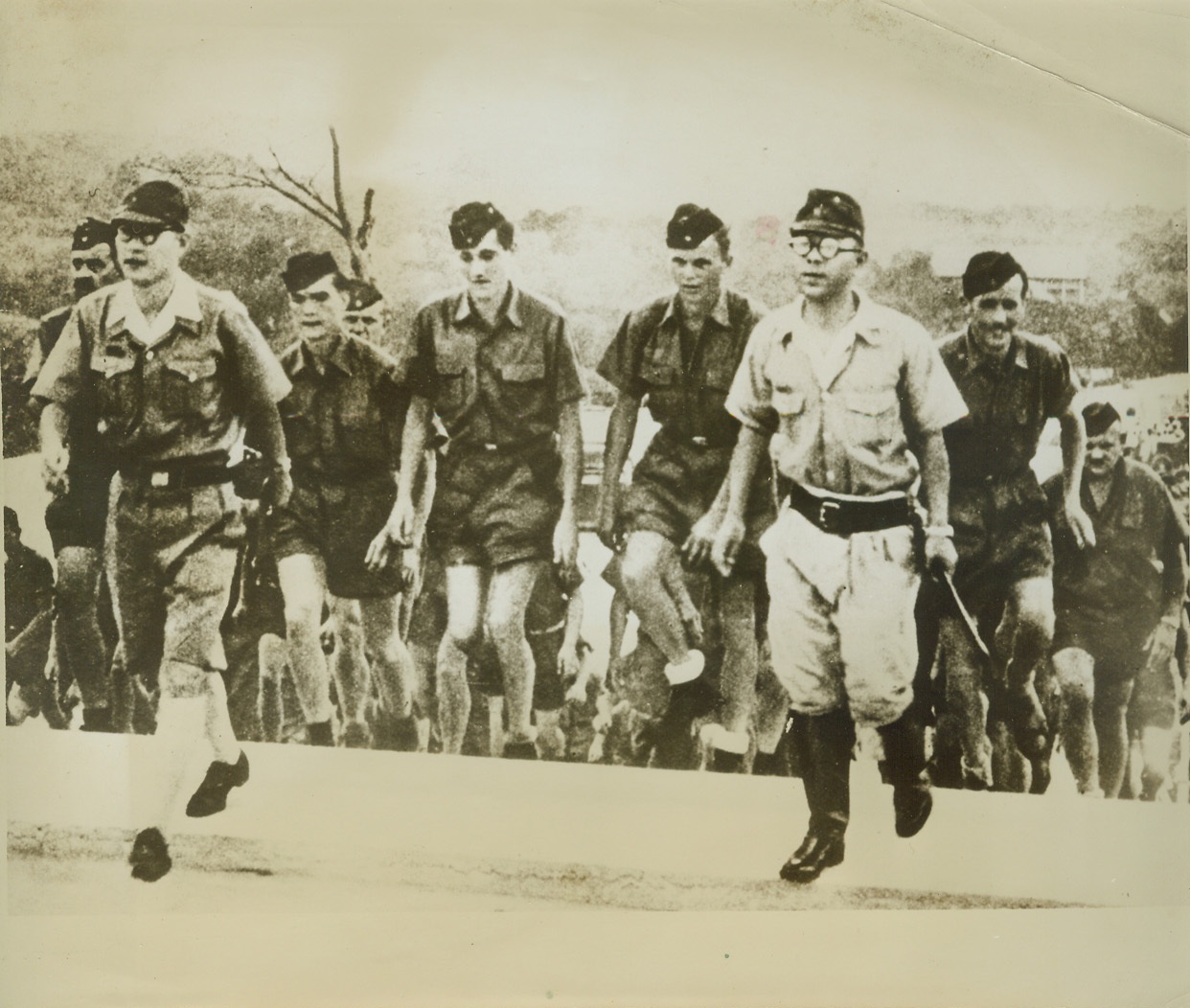
”SUPERMEN” OF THE EAST AND WEST, 12/13/1943. SINGAPORE – Two Japanese officers lead a party of German soldiers on a sight-seeing tour of the great Jap naval base at Singapore. Base is under the command of General Yamashita and a number of Nazi soldiers are stationed there, forming part of the garrison at the former British “Gibraltar of the East.” Credit: ACME;
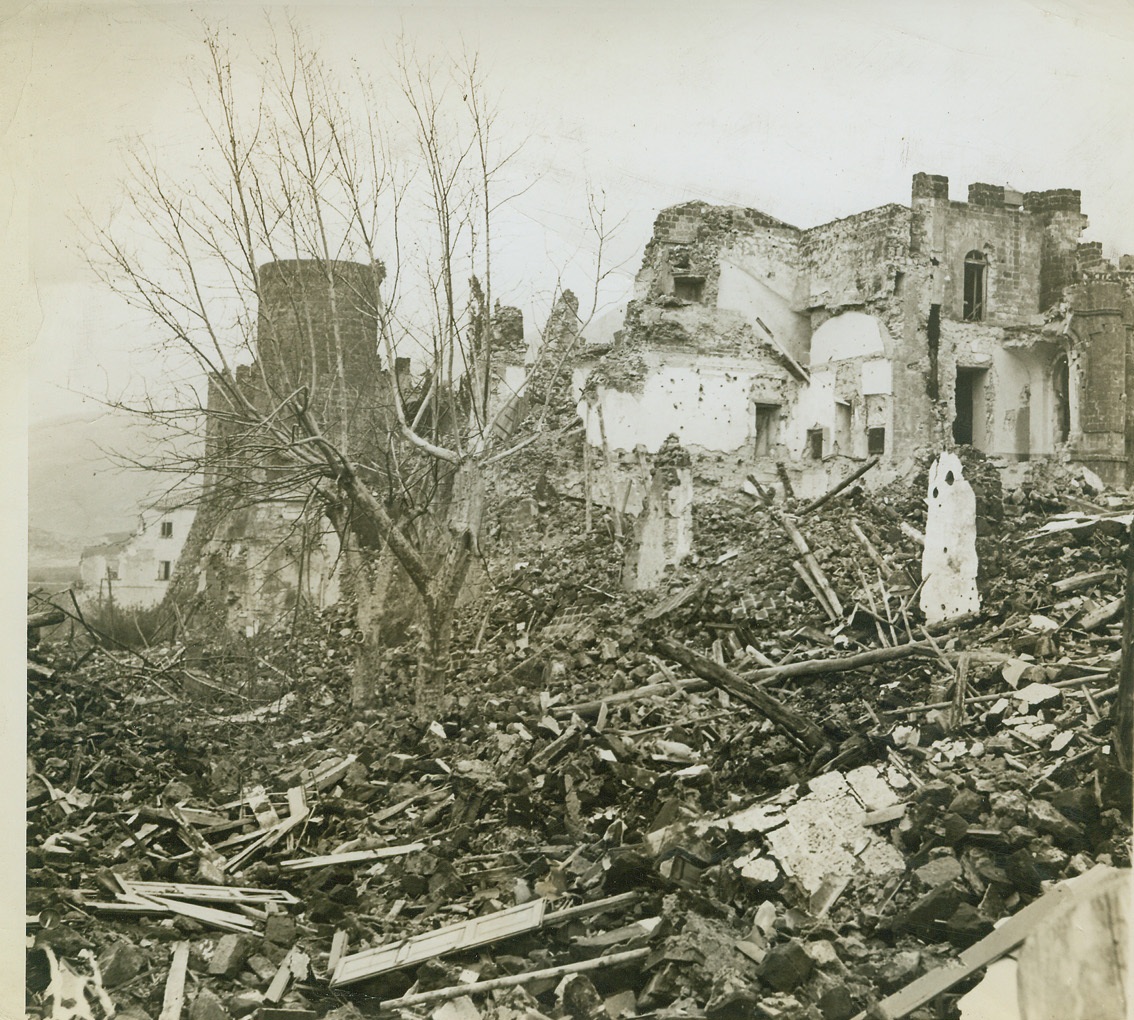
War’s Devastation, 12/221943. Italy – Here’s what was left of the town of Mignano when American troops marched in after pounding out the Germans. Debris clogs every open area and in many cases it is impossible to tell from the ruins what a house looked like before it was smashed. Credit (ACME Photo by Sherman Montrose, War Pool Correspondent);
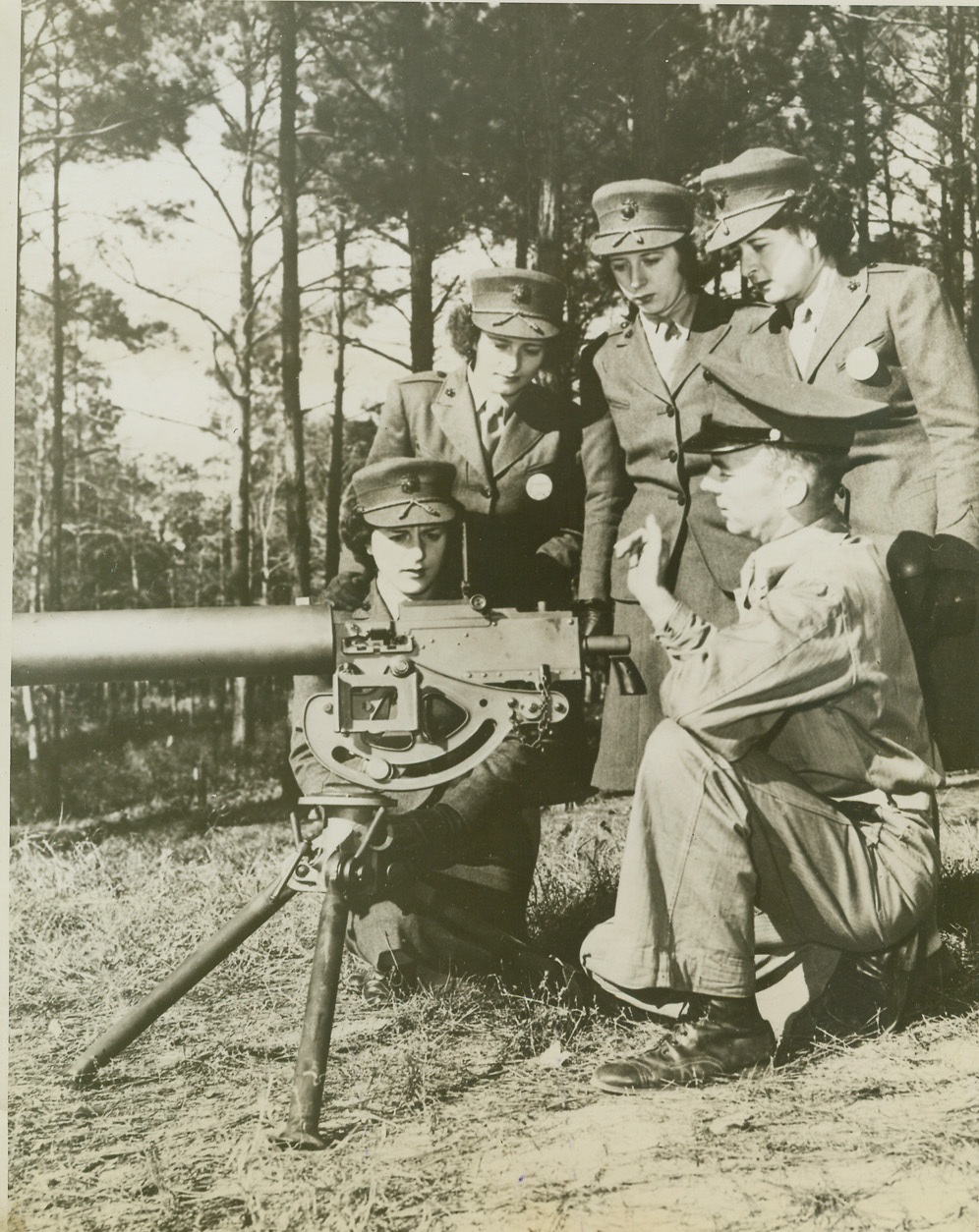
Platoon Sgt. K.L. Smith, (right), USMC, of Cumberland, MD, explains the mechanism, , 12/30/1943.
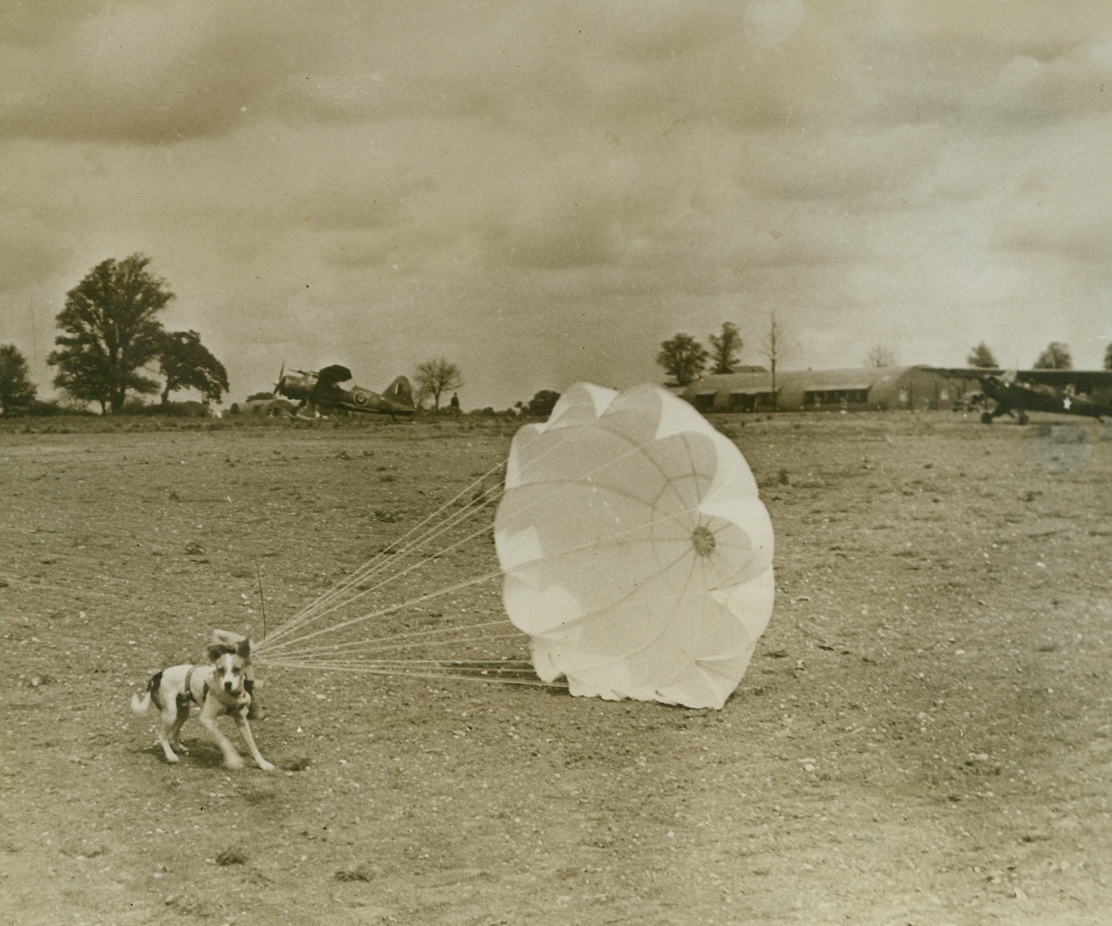
What's In A Breed?, 12/7/1943. ENGLAND – Although his breed is uncertain, this spunky terrier is chock full of the stuff that heroes are make of. Called “Salvo” by the Airmen for whom he is a mascot, the dog goes on operational flights and makes parachute jumps whenever his masters take to the silk. Landing after a jump, Salvo plants his feet firmly on the ground, to resist the pull of his billowing chute, until someone comes along to unharness him.Credit: U.S. Signal Corps photo from ACME;
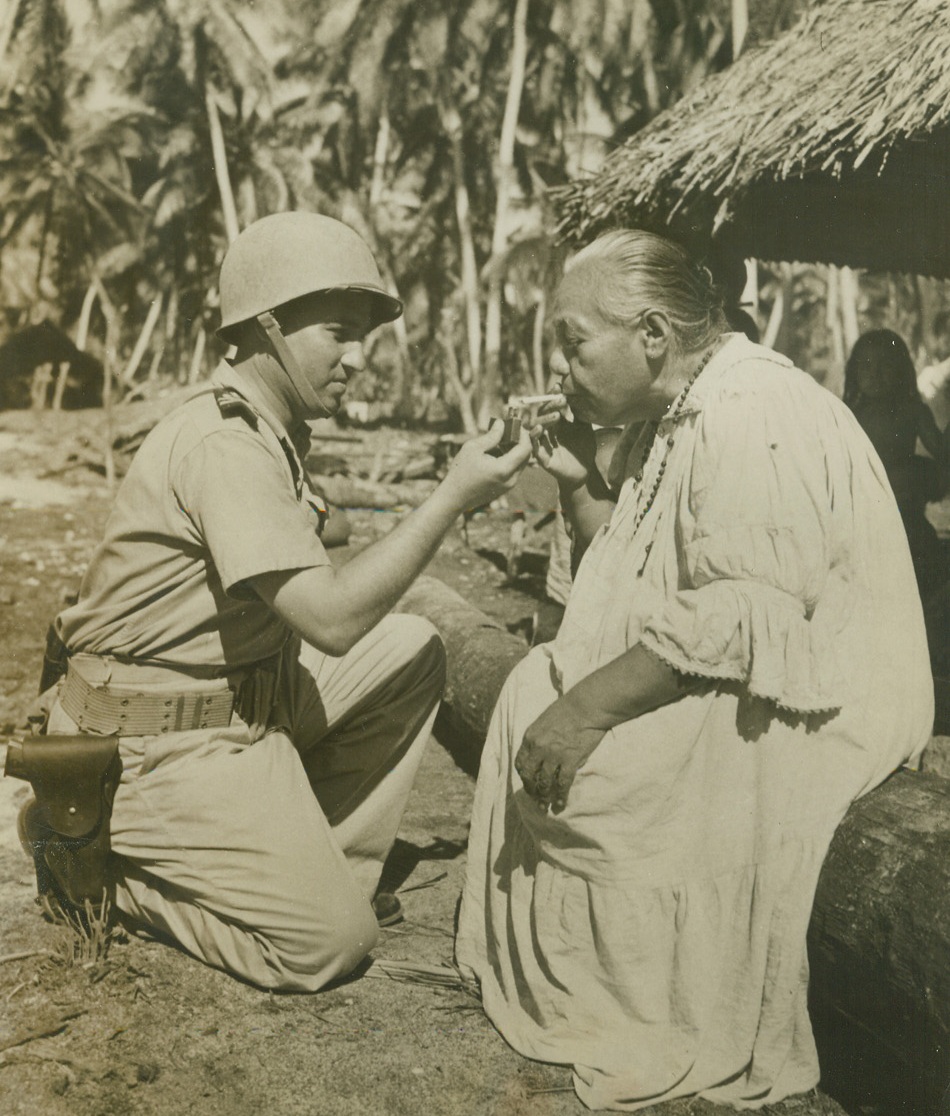
Her Majesty The Queen, 12/17/1943. MAKIN ISLAND – Queen Tabonou, of the Gilbertese Natives, gets a light for her cigarette from Lt. Bruno Raymond, Royal Australian Naval Volunteer Reserves, who was born in the central Pacific islands. The Queen hadn’t seen Raymond since he was a baby. He “Visited his home town” after the allies captured Makin.Credit: ACME;
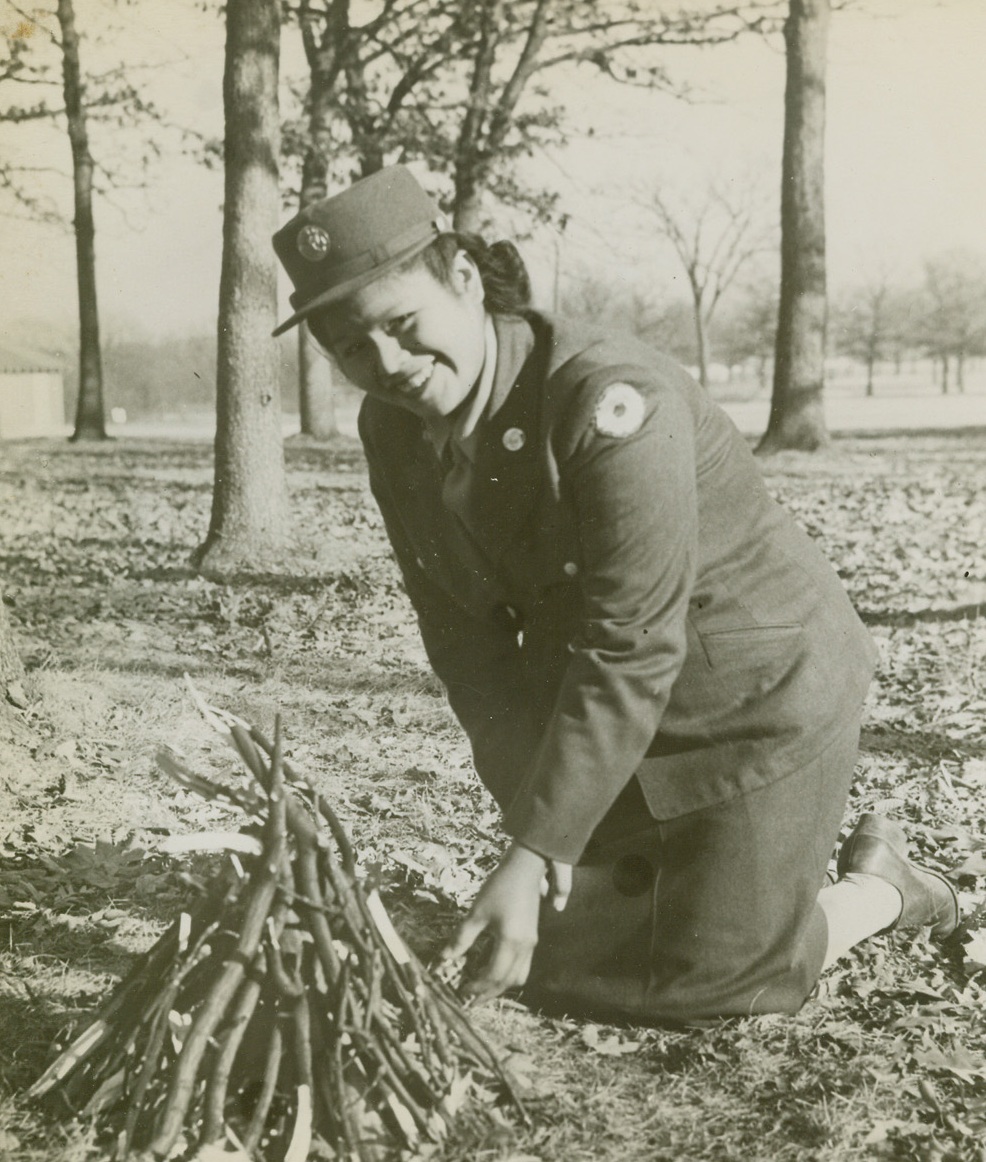
WITH FLINT AND STEEL, 12/3/1943. CAMP GRANT, ILL.—Kathryn N. Butler, Hudson, Wis., first Indian WAC to be stationed at Camp Grant, Ill., where she works in the hospital’s diet kitchen, demonstrates how a modern Indian starts a fire with flint and steel—by using a cigarette lighter.Credit: Signal Corps photo from Acme;
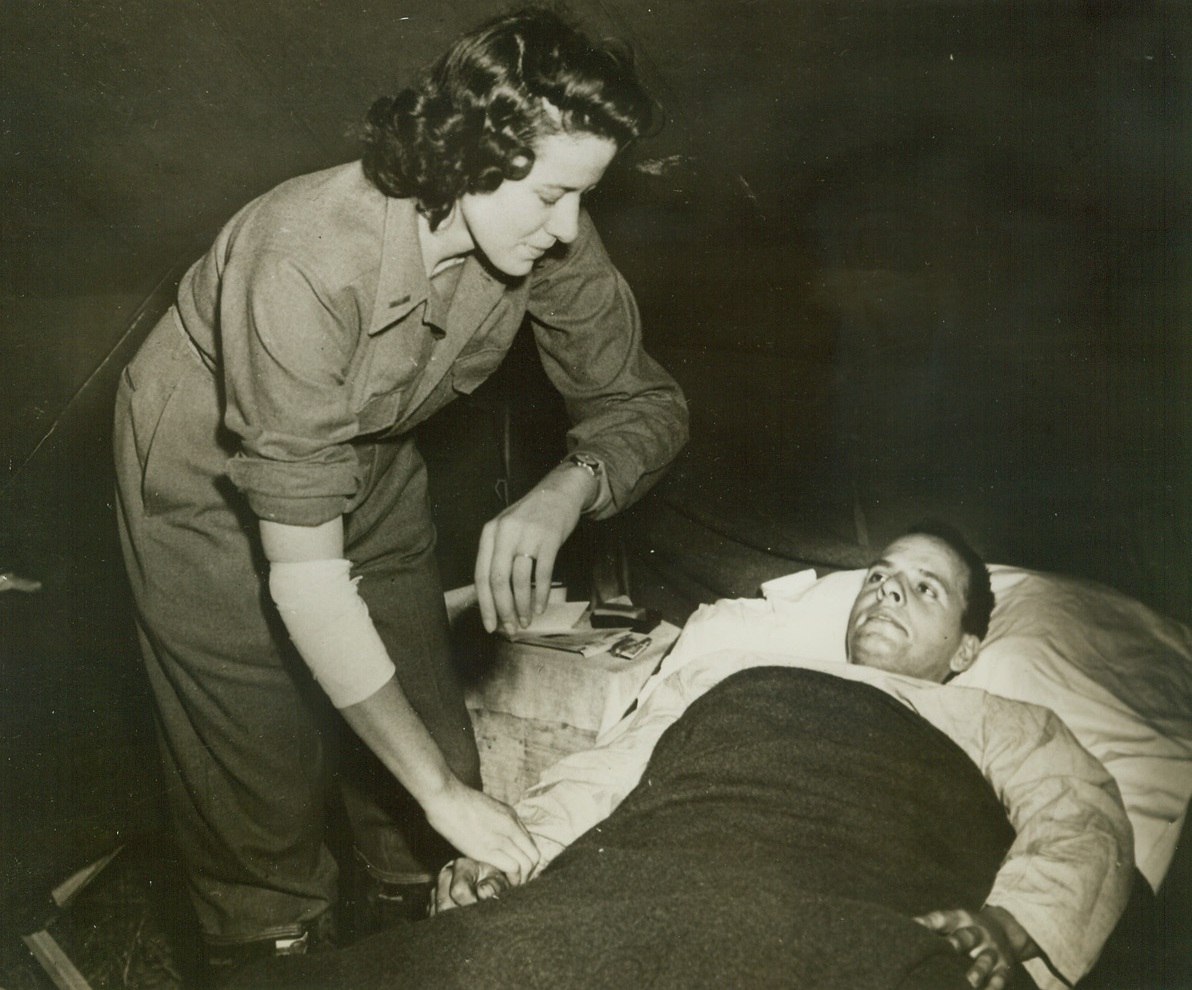
WOUNDED NURSE CARRIES ON, 12/29/1943. AT A FIELD HOSPITAL SOMEWHERE IN ITALY—Lt. Cordelia E. Cooks, first Army nurse in Italy to be wounded by enemy fire, sustaining a shrapnel wound, refuses to take time out to recover. With her arm bandaged she attends a patient, Pfc. Joseph Uhrin, Latrobe, Pa., member of a field artillery unit on the day after she received her wound. Lt. Cooks is from Ft. Thomas, Kentucky.Credit: Signal Corps photo from Acme;
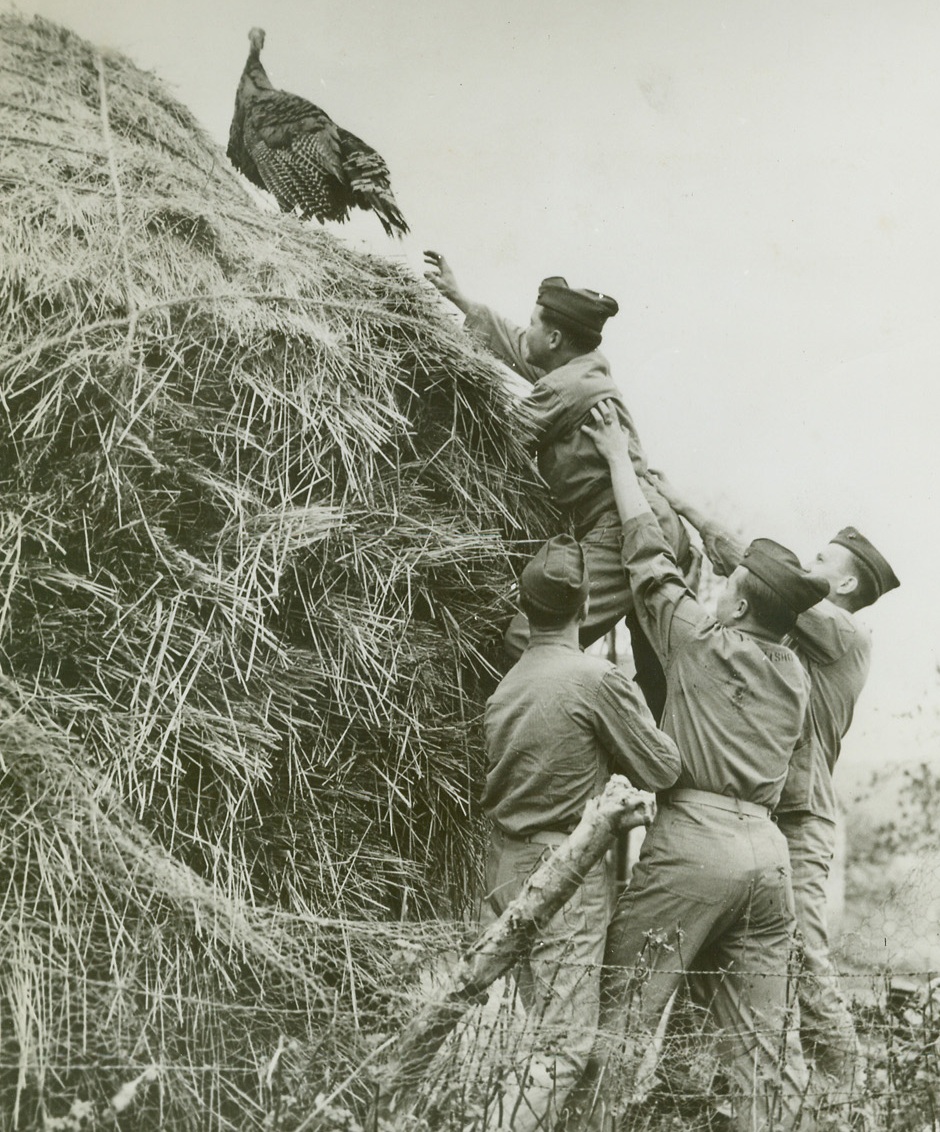
TURKEY IN THE STRAW, 12/24/1943. LONDONDERRY, NORTHERN IRELAND—It’s “catch-me-if-you-can” for this poor bird as he tries to evade a group of Yanks in Londonderry, who are going after their Christmas Dinner “on the hoof”. Pfc James E. Fuller of Bothan, Ala., starts up the haystack after the bird, with assistance from: Pfc Alfred V. Samson, New Bedford, Mass.; Cpl Jesse C. McConnell, Clayton, Ga.; and Pfc John a Hermanski, Ipswich, Mass. The boys are Marines.Credit: U.S. Marine Corps photo from Acme;
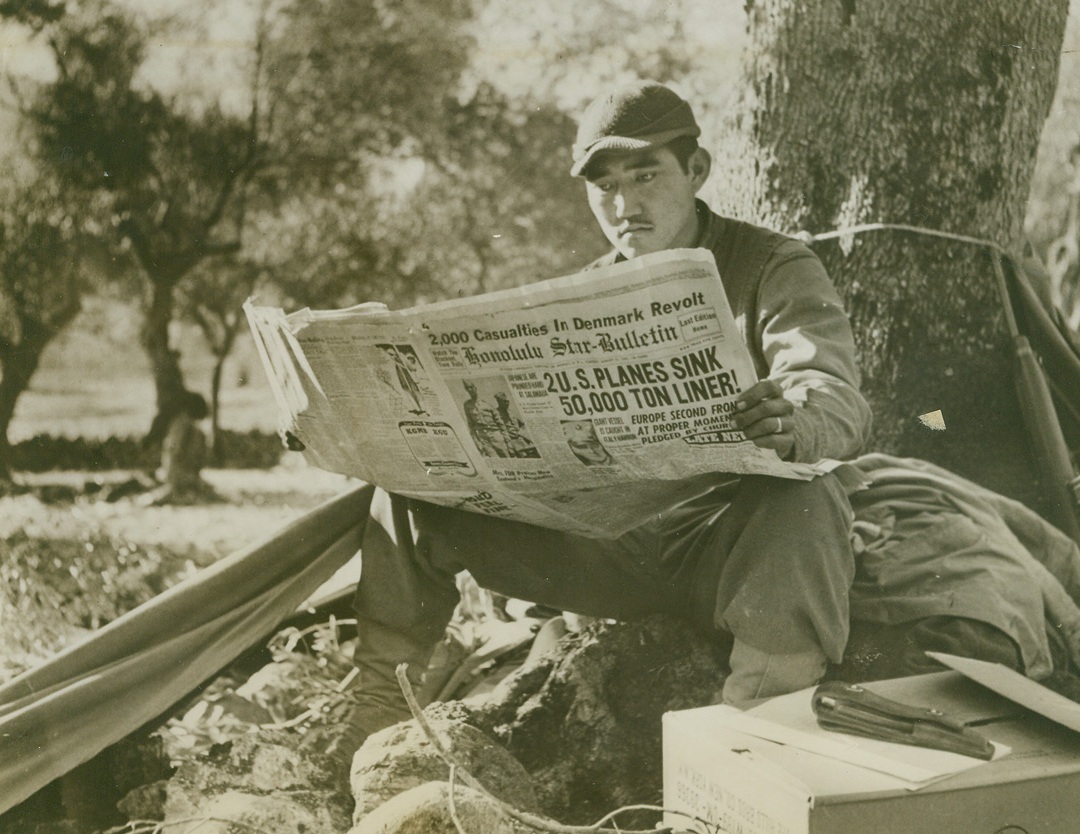
No Title., 12/10/1943. ITALY—You don’t need to ask a unit of Japanese infantry in Italy what they think of the Axis. Daily, they have been giving their lives for Uncle Sam in rough mountain action against the Germans. The U.S. Army unit, which is made up of men who are…theater. Before Pearl Harbor…were in the National Guard in Hawaii, and now they are putting their training to work for America. These photos were taken during a breathing spell when the fighting Japanese-Americans waged continuous warfare for eight days running. Pfc. Isami Tsuda eagerly scans the Honolulu Star bulletin of August 31 for news of home. Not until the Japanese-Americans pulled out of the fighting line for a rest were they able to get any news or mail from their homes. It was the first they’d received since landing in Italy.Credit: Acme;
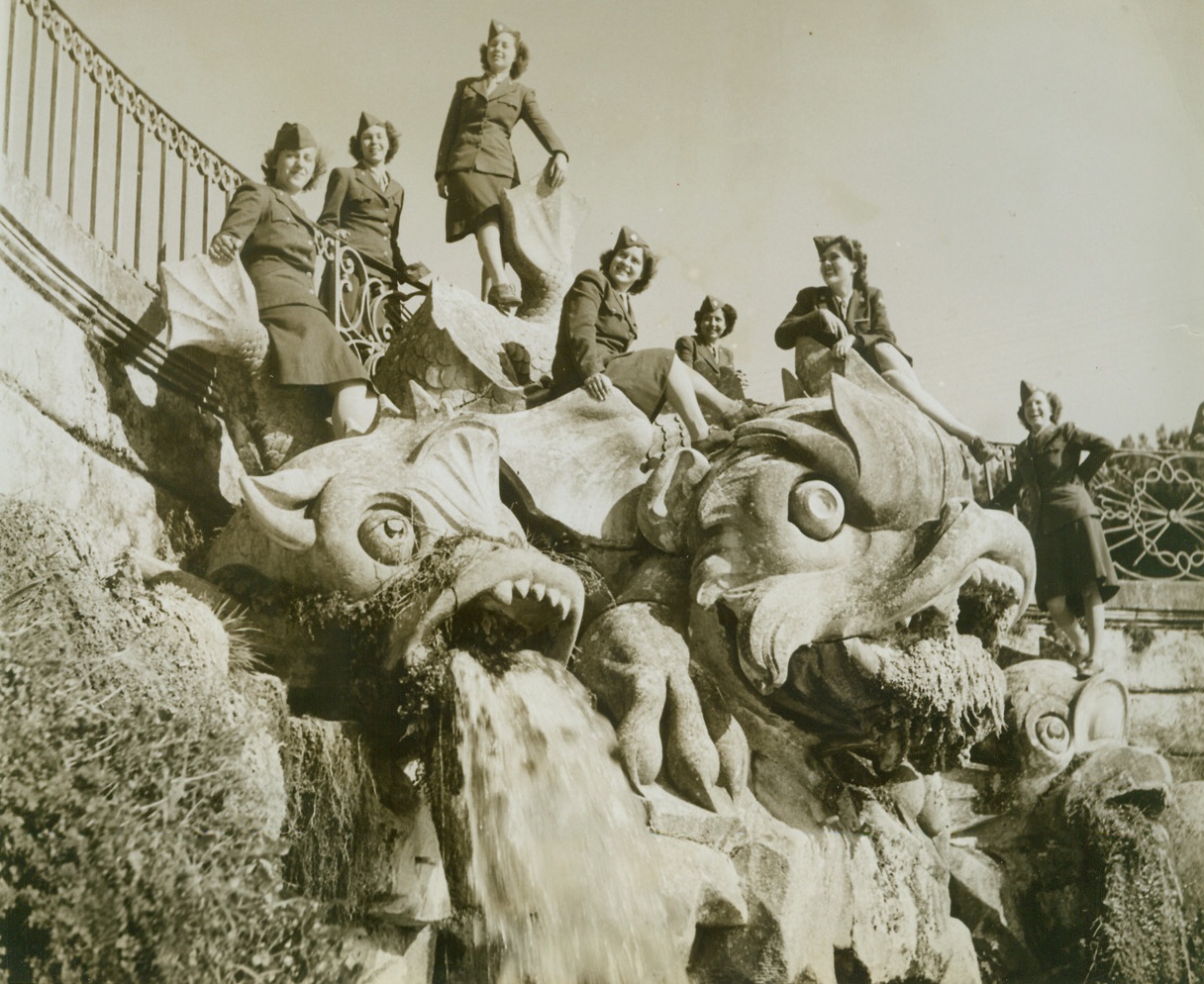
DECORATIVE TOUCH, 12/5/1943. ITALY—A vast improvement is effected in the weird statuary of the royal gardens of Caserta, italy, by seven sightseeing WACS who are (left to right) Pvt. Jeanne Zientek, of Buffalo, N.Y.; Pvt. Jerry Horne, Lucedale, Miss; Pvt. Betty Hoefler, of Buffalo, N.Y.; Pvt. Laura Howleson, of Pittsburgh, Pa.; Pvt. Zanaida Johnson, of New York City; Pvt. Rena Hicks, of Louisville, Ky., and Pvt. Ruby Hale, of Wharton, Tex.Credit: Acme photo by Bert Brandt, War Pool Correspondent;
![DISPLAY OF CAPTURED SOUVENIRS, 12/9/1943. MAKIN ISLAND—Back from the battle front with their captured souvenirs are the men of the 165th Infantry, the old “Fighting 69th”. Pictured are a Japanese flag and Japanese marine insignia taken at [illegible] grove, Makin Island.Credit: Official U.S. Army Signal Corps photo from Acme;](/media/12965/77091347.jpg)
DISPLAY OF CAPTURED SOUVENIRS, 12/9/1943. MAKIN ISLAND—Back from the battle front with their captured souvenirs are the men of the 165th Infantry, the old “Fighting 69th”. Pictured are a Japanese flag and Japanese marine insignia taken at [illegible] grove, Makin Island.Credit: Official U.S. Army Signal Corps photo from Acme;
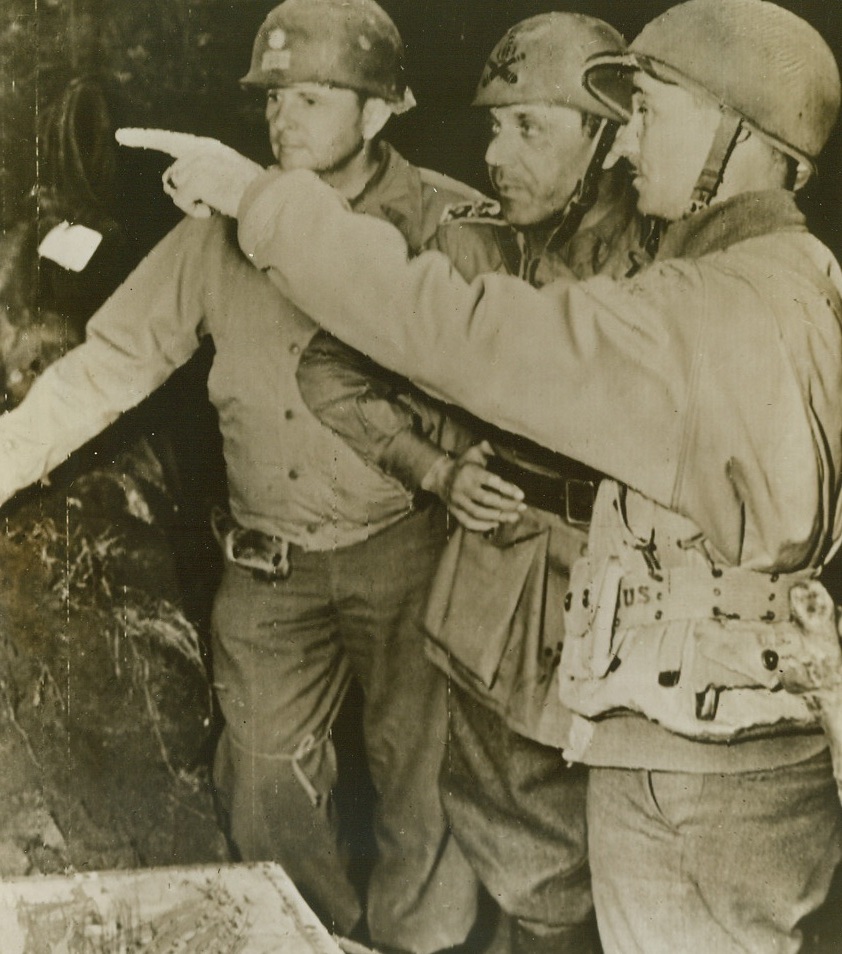
Hunting the Same Prey, 12/11/1943. Italy—An American officer points out the positions of German forces to an Italian commander whose unit has joined Allied fighters in Italy. Lt. Col. Andrew Price, of Fort Worth, Texas, is at left. Today, an Italian general whose troops are fighting alongside American and British units in the Mignano sector charged that the Nazis are executing. All captured Italian officers are traitors. Credit: ACME radiophoto, by Sherman Montrose, War Pool Correspondent, via U.S. Army Signal Corps radiotelephoto.;
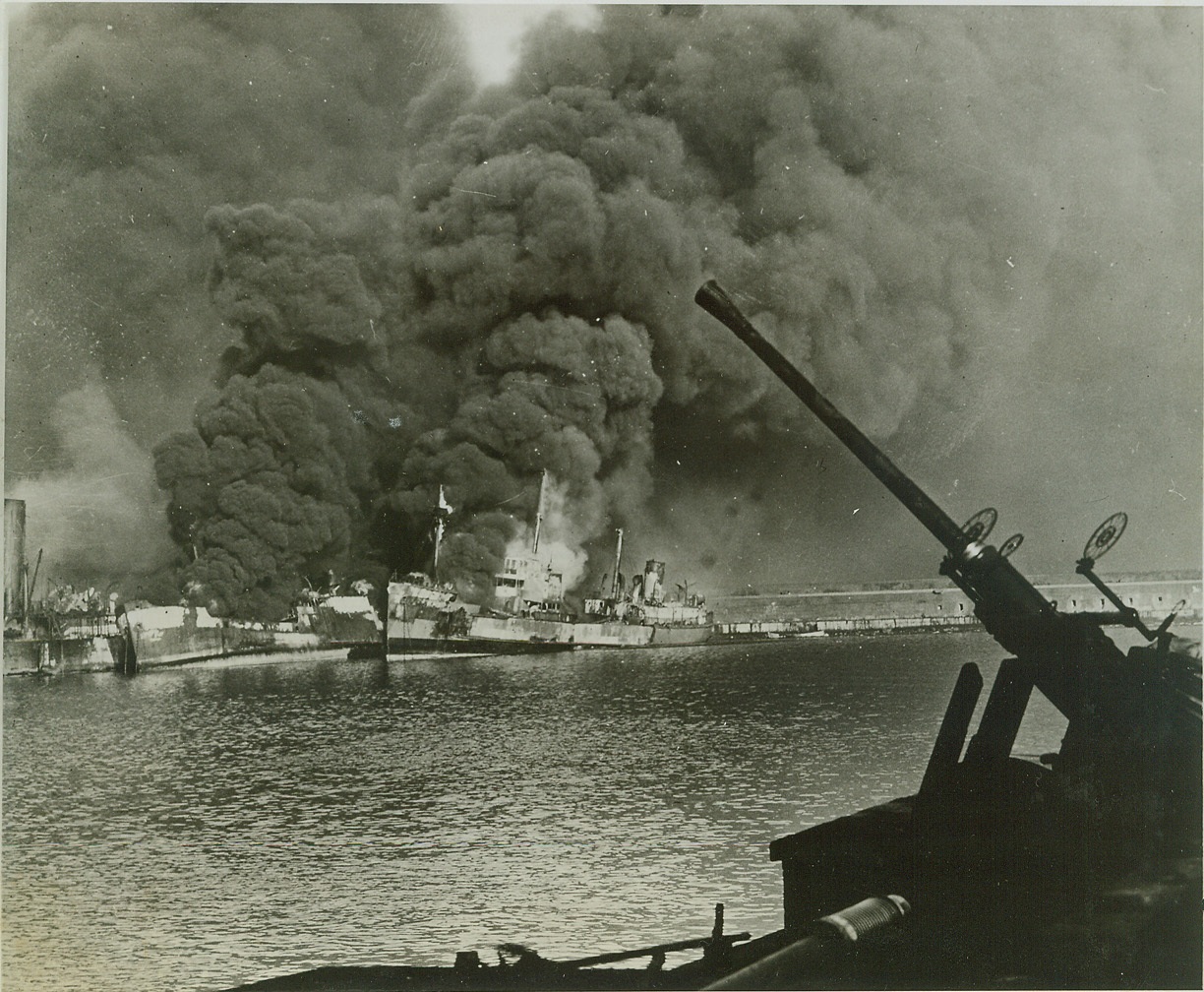
Axis Attack on Bari, 12/16/1943. In the shadow of an anti-aircraft gun, Allied ships burn furiously in the Southern Italian port of Bari, following a German air raid on Dec. 2, 1943. Secretary of War Stimson today announced that two ammunitions ships were hit and the resultant explosion caused spreading fires which destroyed or damaged a number of Allied cargo ships and small harbor craft. There were an estimated 1,000 casualties, including 37 American naval personnel. Credit Army Signal Corps Photo From (ACME);
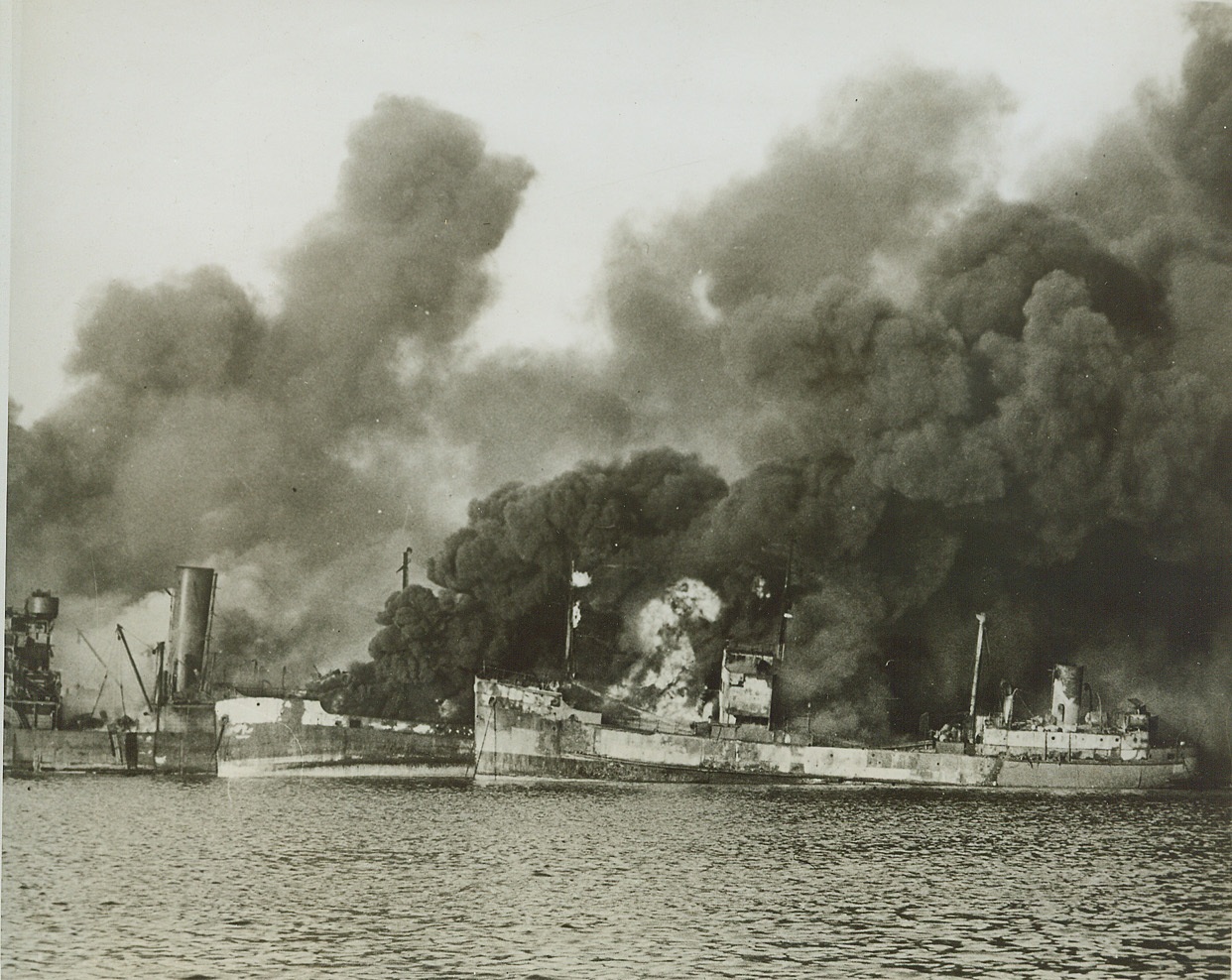
Axis Attack on Bari, 12/16/1943. Allied ships burn furiously in the Southern Italian port of Bari following a German air raid on Dec. 2, 1943. Secretary of War Stimson today announced that two ammunitions ships were hit, and the resultant explosion caused spreading fires which destroyed or damaged a number of Allied cargo ships and small harbor craft. There were an estimated 1,000 casualties, including 37 American naval personnel. U.S. Army Signal Corps Photo From (ACME);
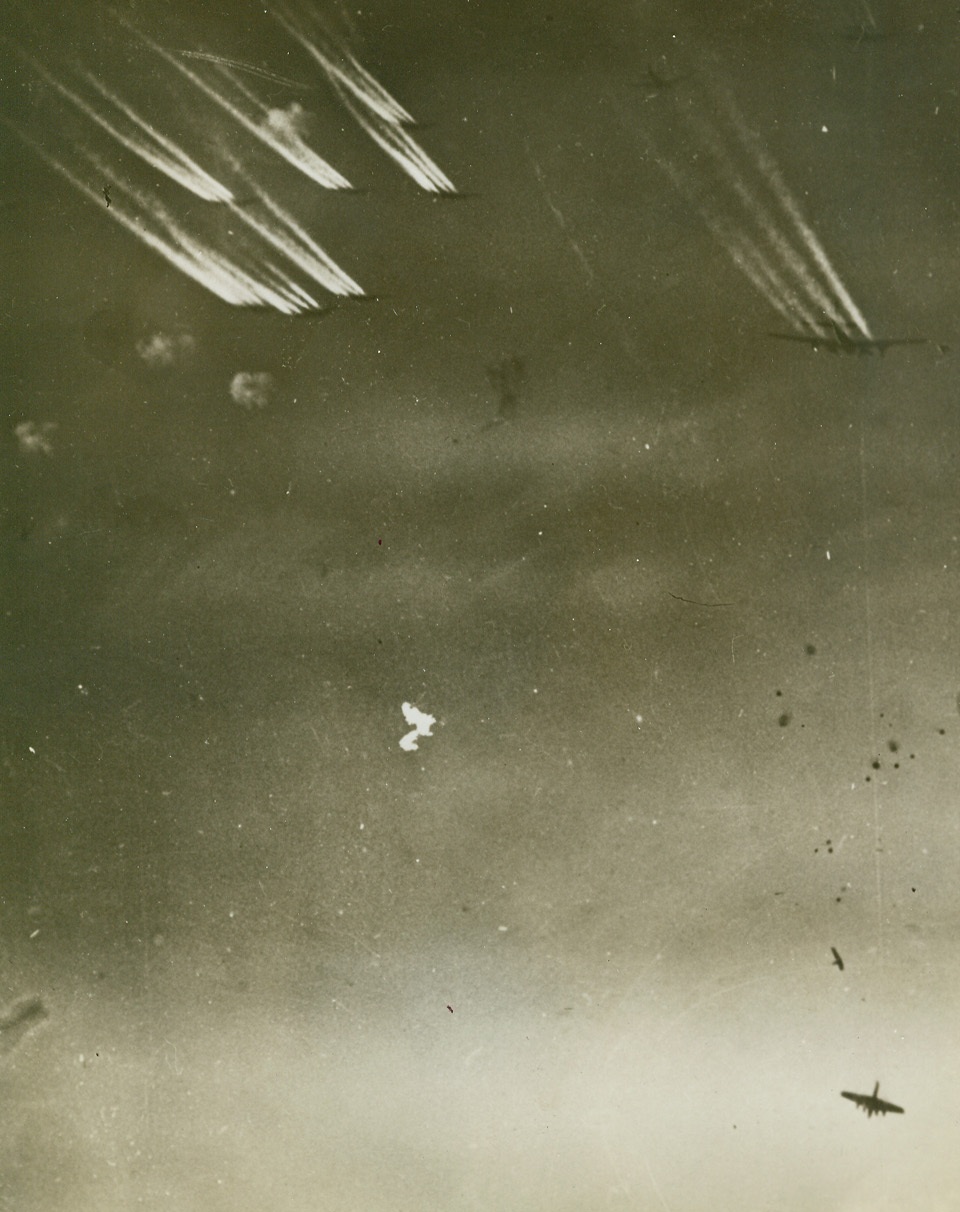
Carry On, Mates, 12/28/1943. A U.S. flying fortress (lower right) is brought to earth, its tail piece following, as other of the giant planes continue to unleash bombs over Bremen, Germany. The 8th Army Air Force bombers leave their contrails in the flak filled sky, where more devastation goes hurtling downward than is tossed up from Nazi guns. Credit: U.S. Army Air Force photo from ACME.;
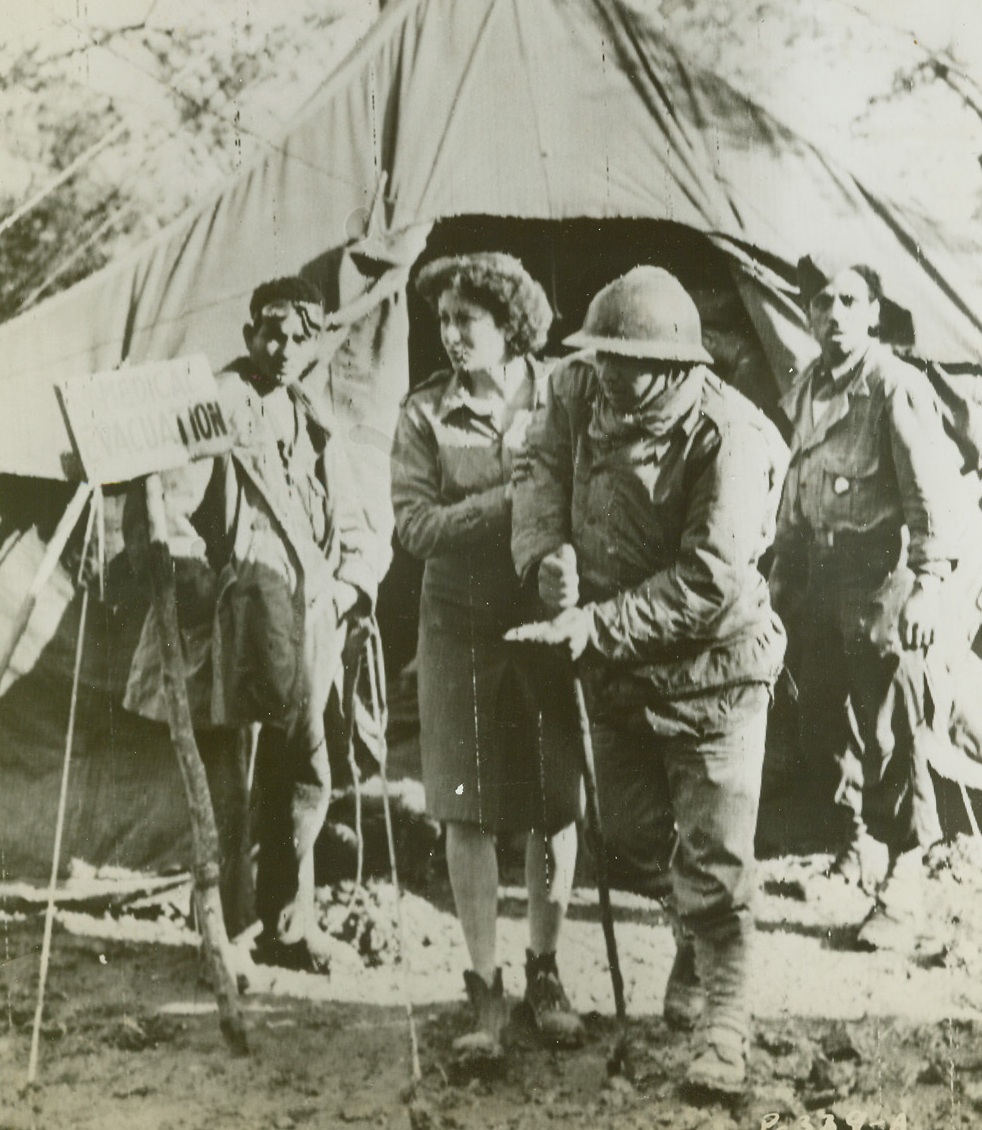
Aided By His Own Countryman, 12/28/1943. Italy – As a wounded French soldier hobbles out of an evacuation medical tent somewhere in Italy, a French woman ambulance driver is there to meet him. She will speed him to a rear medical base for treatment. Credit (U.S. Signal Corps Radio From ACME);
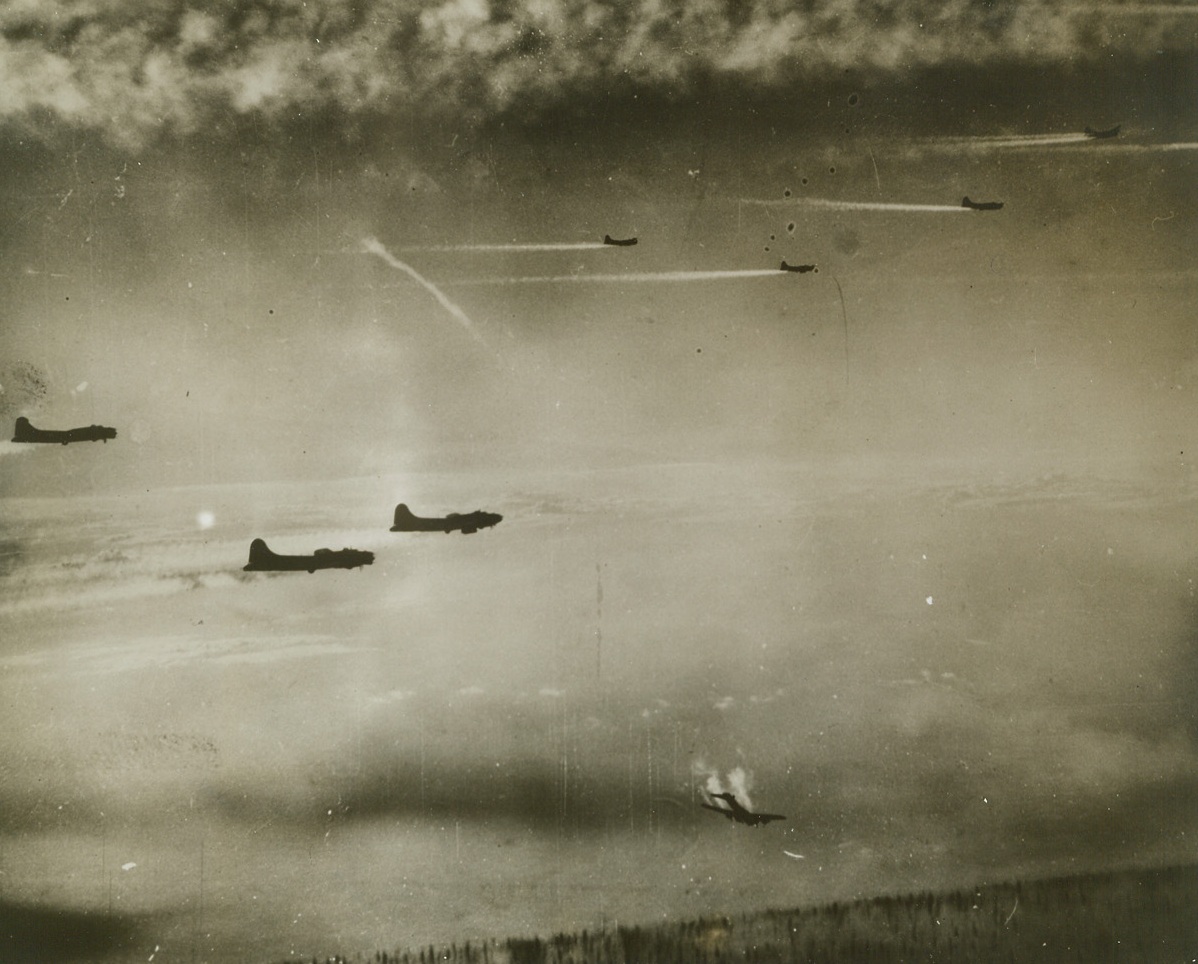
Death of a Flying Fortress, 12/28/1943. Smoke pouring from its motors and part of its tail assembly shot away, a flying fortress hurtles from a formation of the big bombers speeding towards Bremen, Germany. The rest of the U.S. 8th Army Air Force planes soar onward, for no help can be given the fallen eagle. Credit: U.S. Army Air Force photo from ACME.;
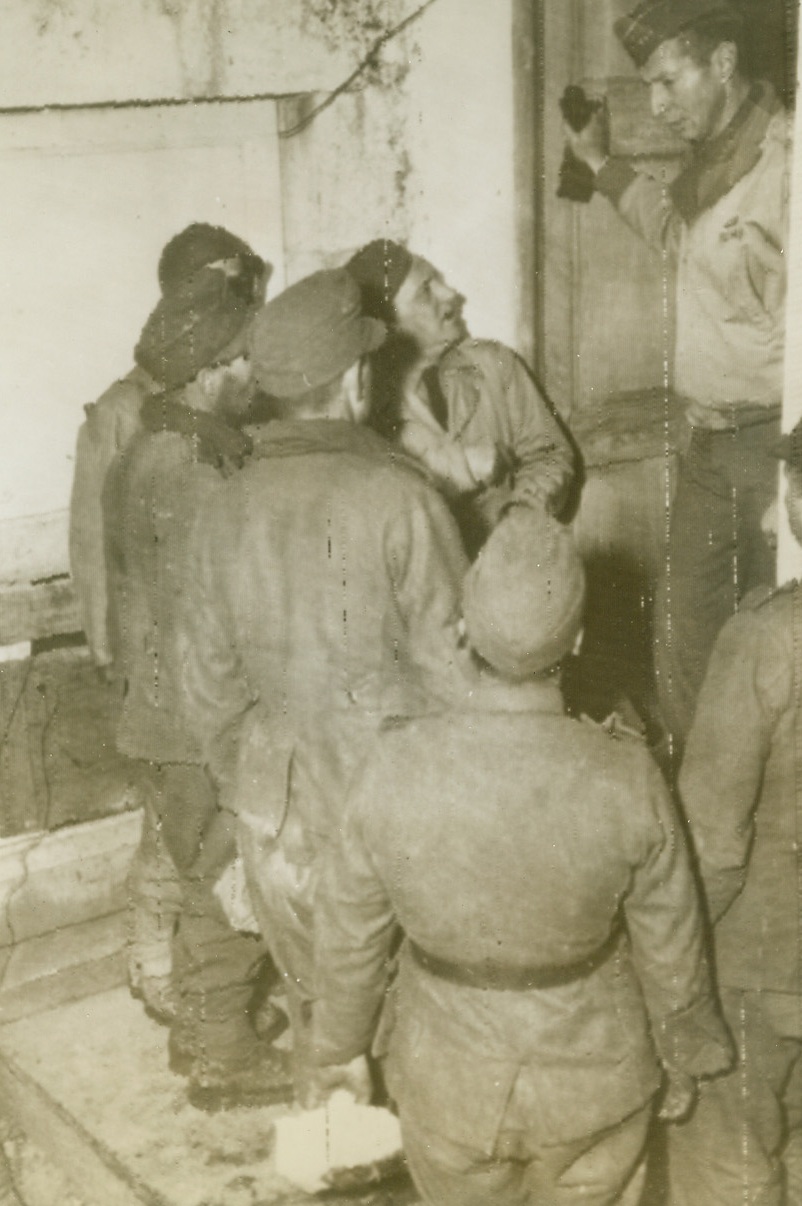
Ready for a “Nice, Friendly Chat.”, 12/28/1943. Italy—General Mark W. Clark is very interested in these guests. They are German prisoners-of-war just brought to headquarters and undoubtedly the Fifth Army Commander will follow the rules of a successful host and ask questions about his guests’ doings rather than talk about himself. Credit: OWI radiophoto from ACME.;
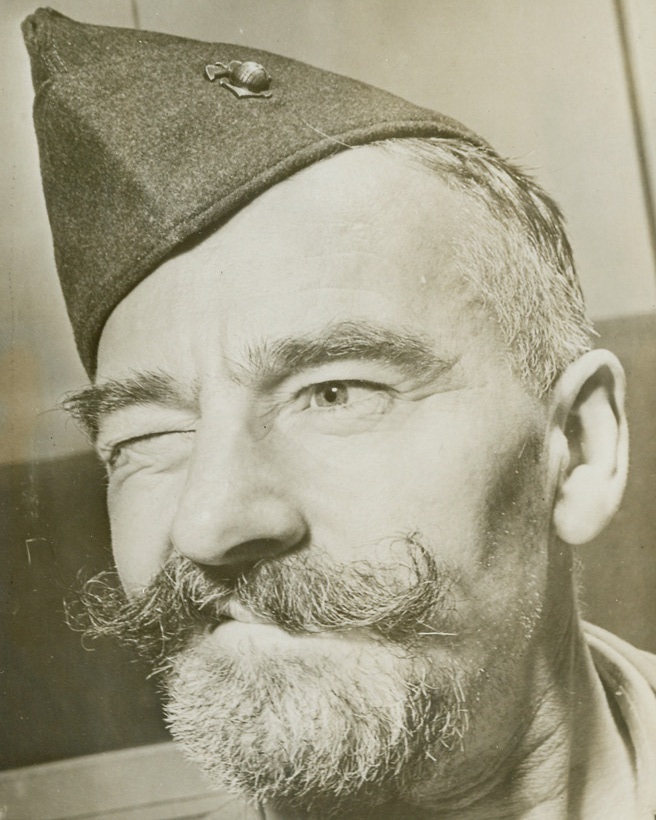
Soup-Strainer and Beaver de Luxe, 12/29/1943. Oakland, Calif.—The Italian Army with its General “Electric Whiskers” has nothing on the U.S. Marine Corps which boasts its own Gunnery Sgt. Carl Otto Ostrom, just returned from the South Pacific and somewhat irked that he had no chance to tangle with the Japs, a leatherneck since 1917 and veteran of World War I, and having seen service in China, Guam, Guadalcanal, and numerous other places, Ostrom is resting at the U.S. Naval Hospital, Oakland, Calif., with a slight case of “feeling worn out.” Born at Cambridge, Mass., 47 years ago, he calls his home the Marine Corps. Credit: Official Marine Corps photo, ACME.;
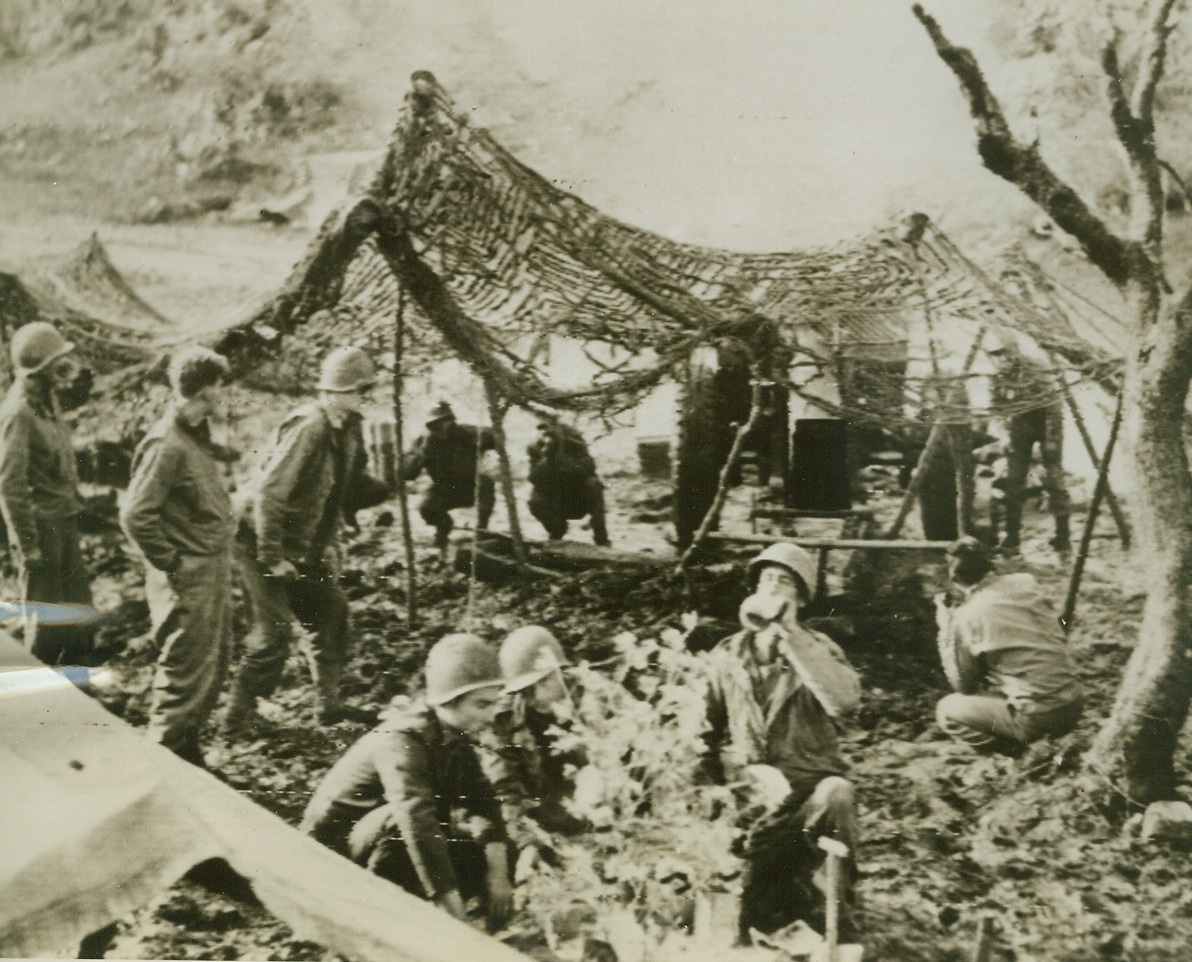
Christmas at the Front, 12/29/1943. Italy—Between rounds in the hills above San Vittore, this American gun crew with the Fifth Army snatches a moment to celebrate Christmas. Clustered around a tiny tree set up behind their barking cannon, the boys drink a toast from their canteens and exchange good wishes. Credit: U.S. Signal Corps radiotelephoto-ACME.;
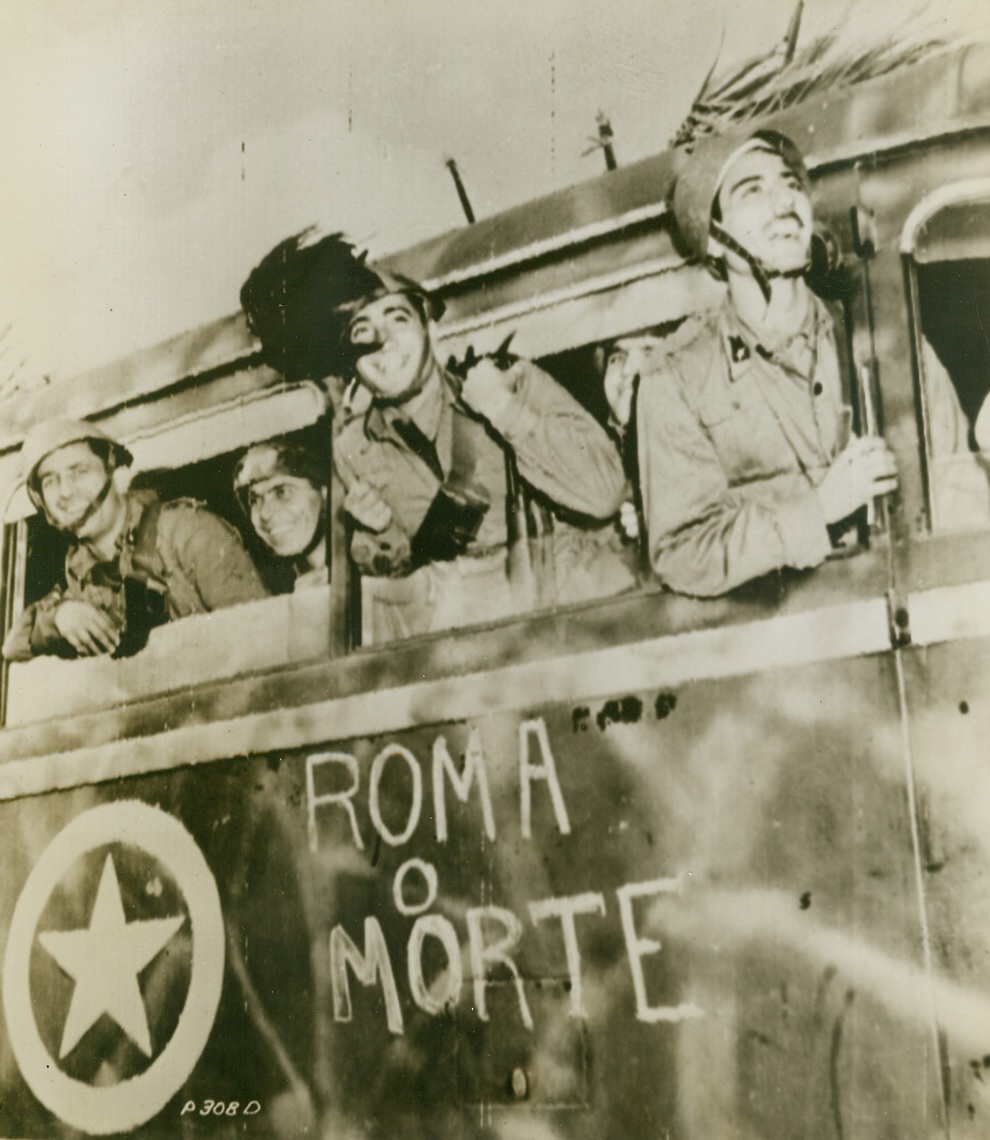
No Excursion, This, 12/ 11/1943. Italy—Italian soldiers are living up to the “Rome or Death” slogan lettered on their vehicle which travels to the front. Fighting alongside British and American troops, they hate the Germans as strongly as the Allies and with good reason, for an Italian general reports that the Nazis kill all the native soldiers they capture, calling them traitors. Credit: Signal Corps radiotelephoto from ACME.;
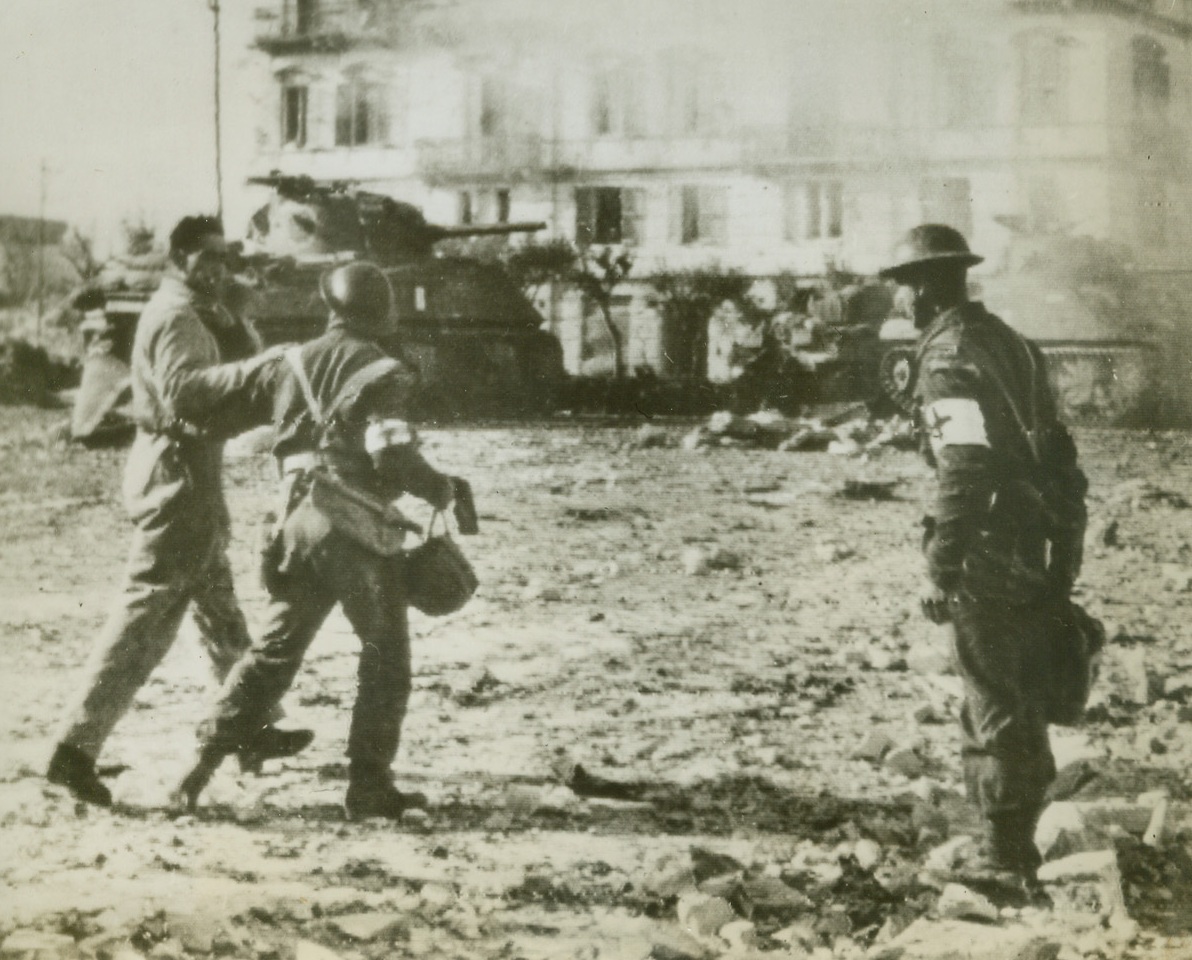
Assisting Wounded Commander, 12/31/1943. Ortona, Italy—A tank commander, who was shot when he opened a turret to check firing results, is led to a dressing station by a medical attendant. The two men walk through the littered streets of battleworn Ortona, which fell to troops of the British Eighth Army after eight days of fighting. Credit: OWI radiophoto from ACME.;
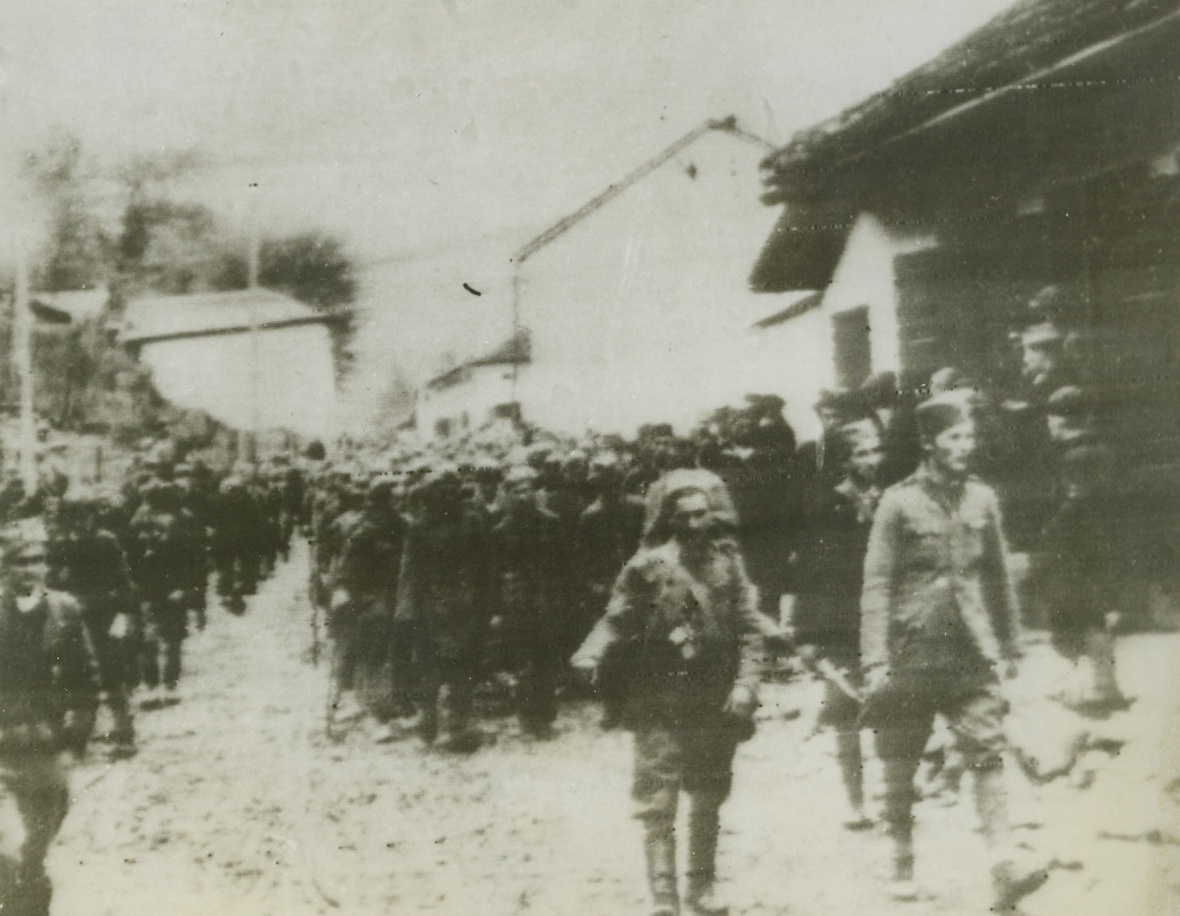
German Prisoners in Yugoslavia, 12/27/1943. Yugoslavia—Partisan detachment of troops, under the command of Tito, leads a group of German prisoners through a liberated Yugoslavian village. Villagers stop to stare at their conquered enemies. Credit: OWI radiophoto from ACME;
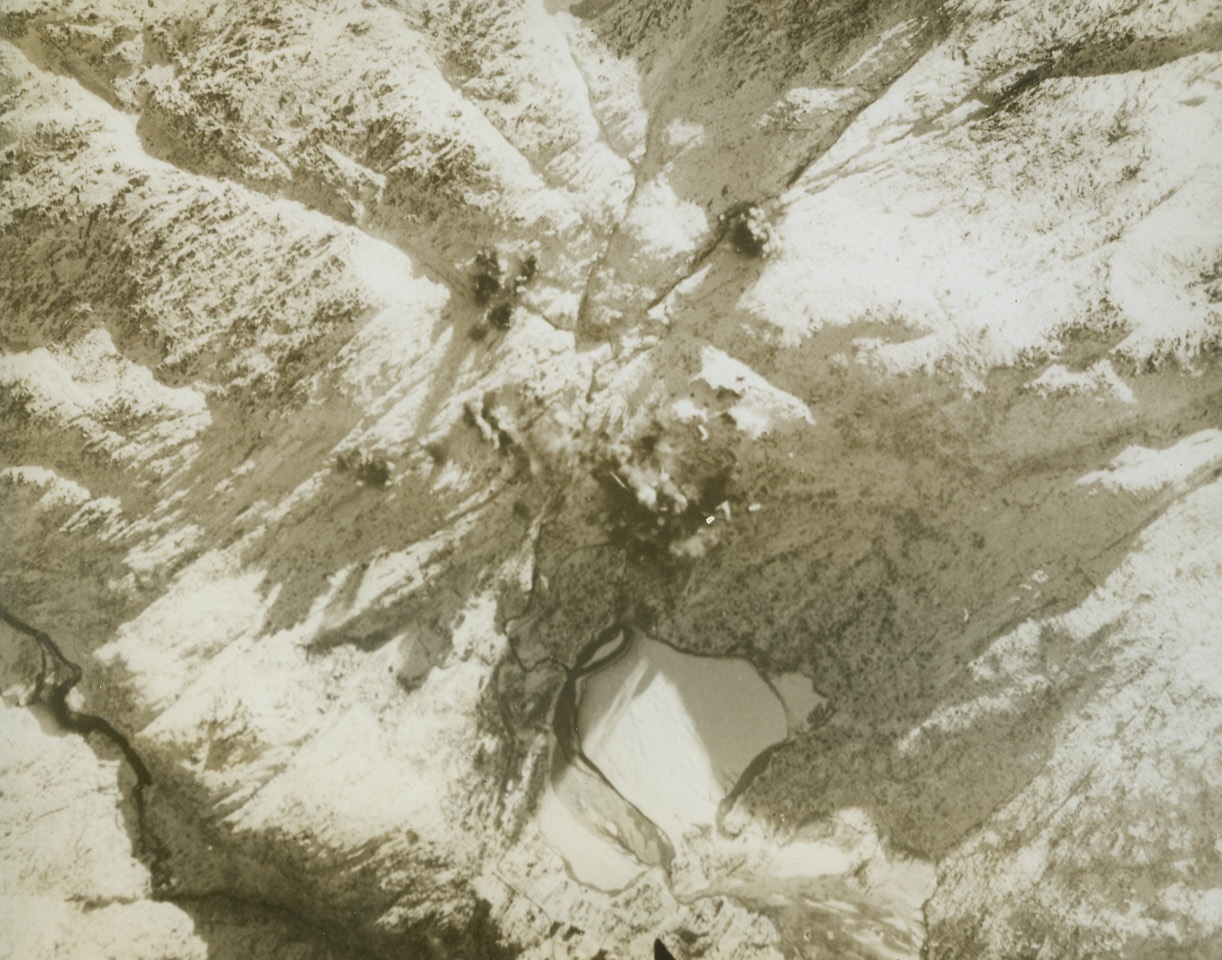
Veni, Vidi, Vici, 12/2/1943. Norway—Tiny puffs of smoke rise from bombs bursting on a Molybdenum Mine in the mountains of Norway. Germany’s most important source of the vital metal. Nestled on the mountainside, almost obscured by the vast, snow-covered rock, the target was a difficult one to find, and a still more difficult mark to hit. But raiders of the U.S. Eighth Air Force found the minute target, made three trial sighting runs overhead, and then bombardiers sent their eggs down for a “bull’s eye.” Credit: U.S. Army Air Forces photo via OWI-ACME.;
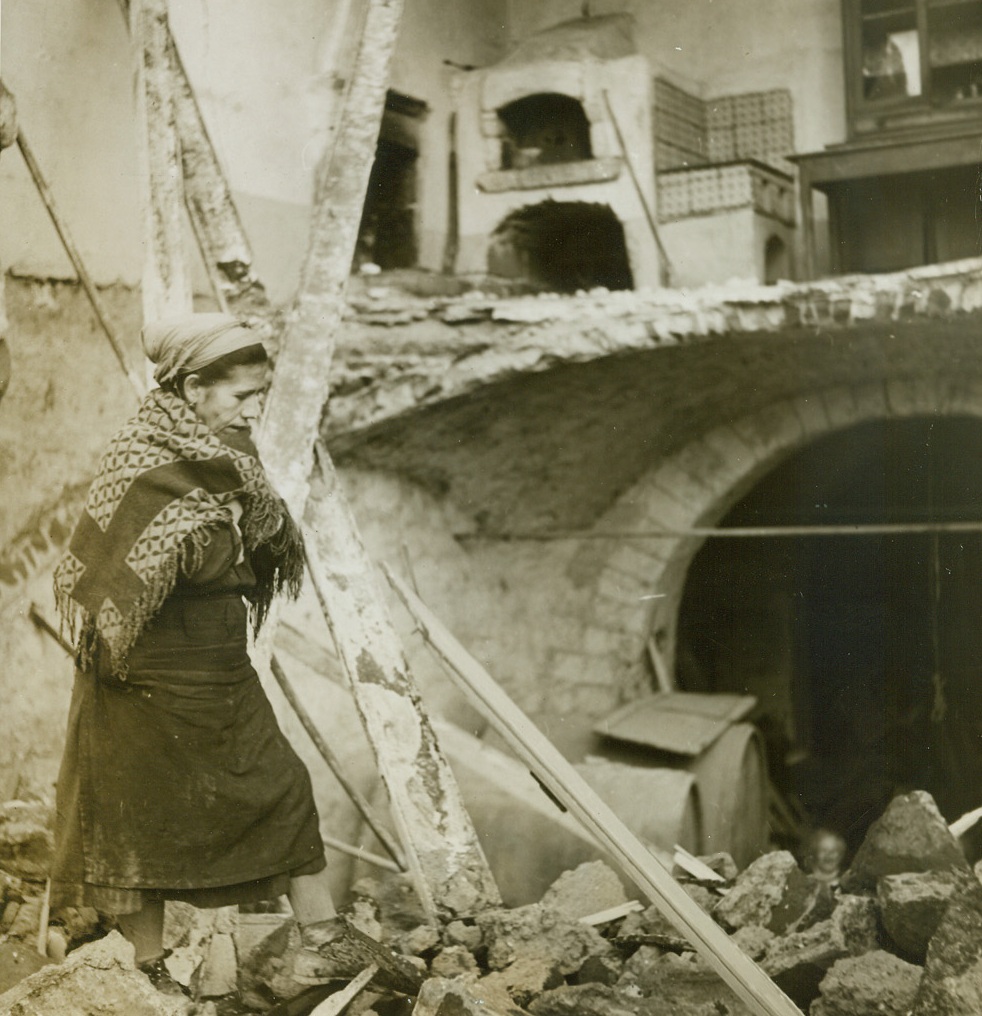
She Stuck It Out, 12/22/1943. Italy—When American troops took over the town of Mignano, they were surprised to see this old Italian woman emerge from the rubble and debris that clogged the streets. She had been living in her home through weeks of shelling and bombing, refusing to be driven from her few prized possessions. The Germans left the Italians very little when they evacuated the area, taking everything of value with them. Credit: ACME photo by Sherman Montrose, War Pool Correspondent.;
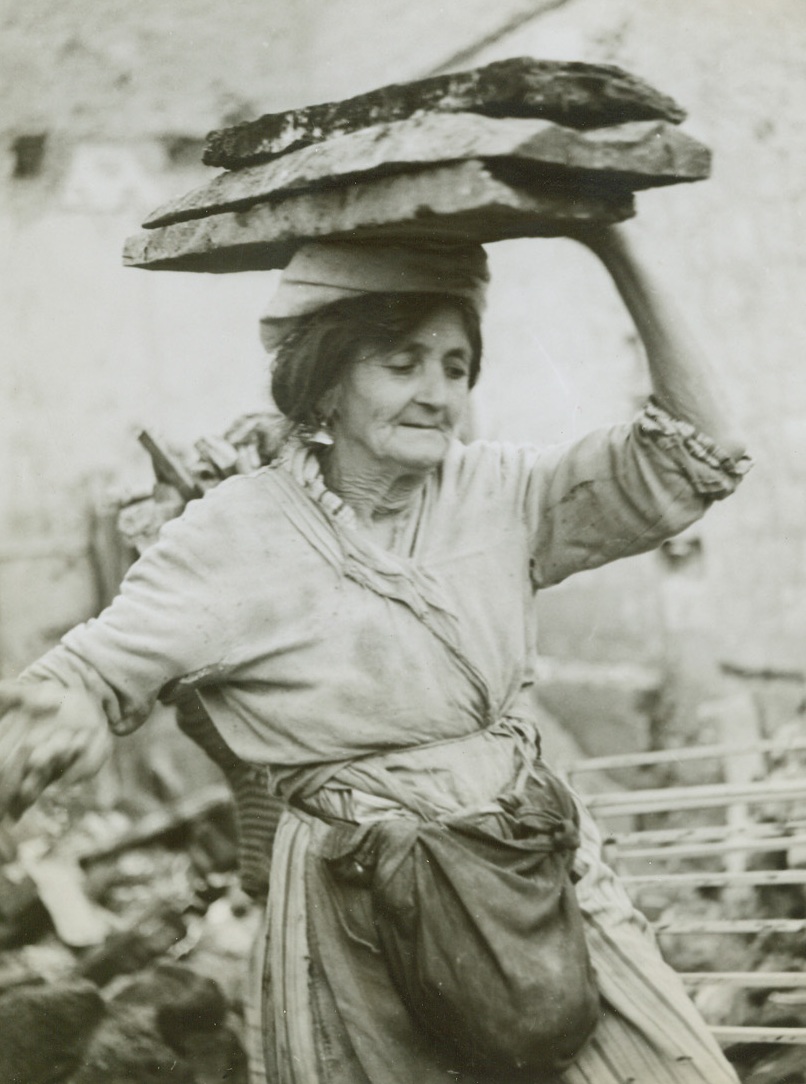
Precious Burden, 12/22/1943. Mignano, Italy—Walking unsteadily through the ruined streets of Mignano, this old Italian woman carries a precious burden atop her head. The three huge slabs of wood, found in the bomb debris that clutters the town, will be used to provide fuel for her cookstove. Credit: Photo by Sherman Montrose, ACME photographer for War Picture Pool.;
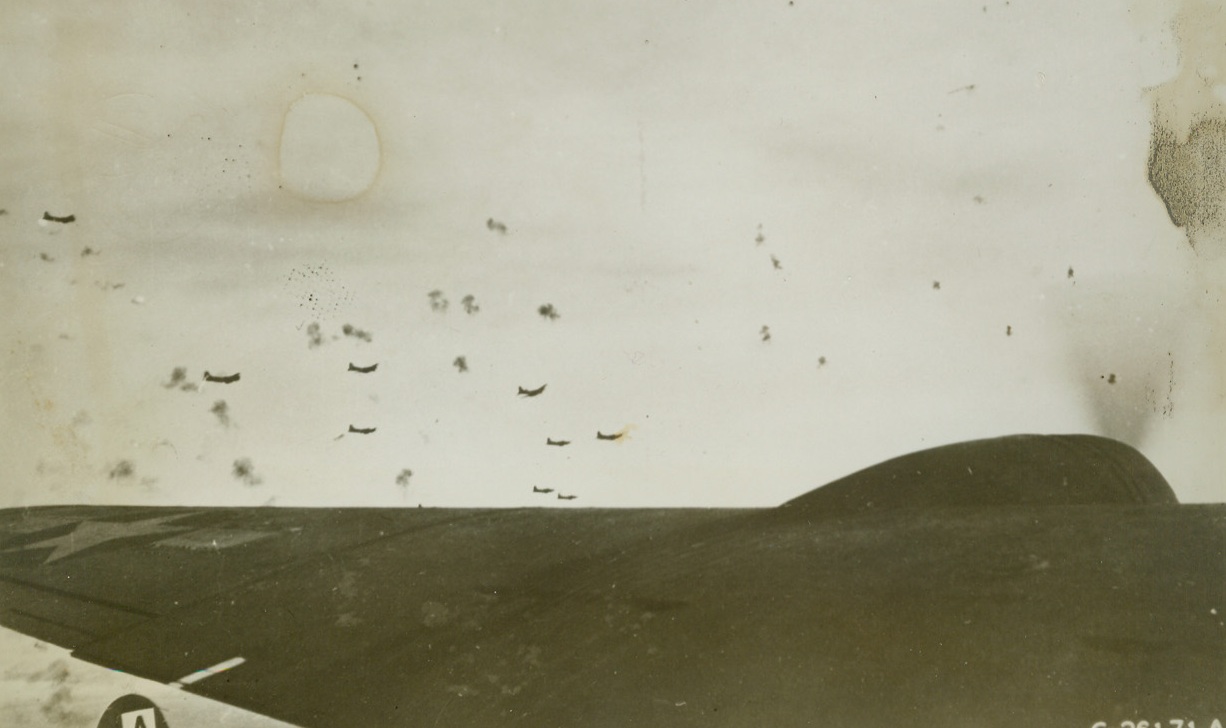
“Flak Garden” Doesn’t Stop Fortresses, 12/9/1943. This photo, just released in the United States, shows a formation of flying fortresses of the U.S. Army Air Forces, as they passed through clouds of bursting anti-aircraft shells, on their way to bomb the Nazi communications center at Munster, Germany, last Armistice Day. Credit: U.S. Army Air Forces photo from ACME.;
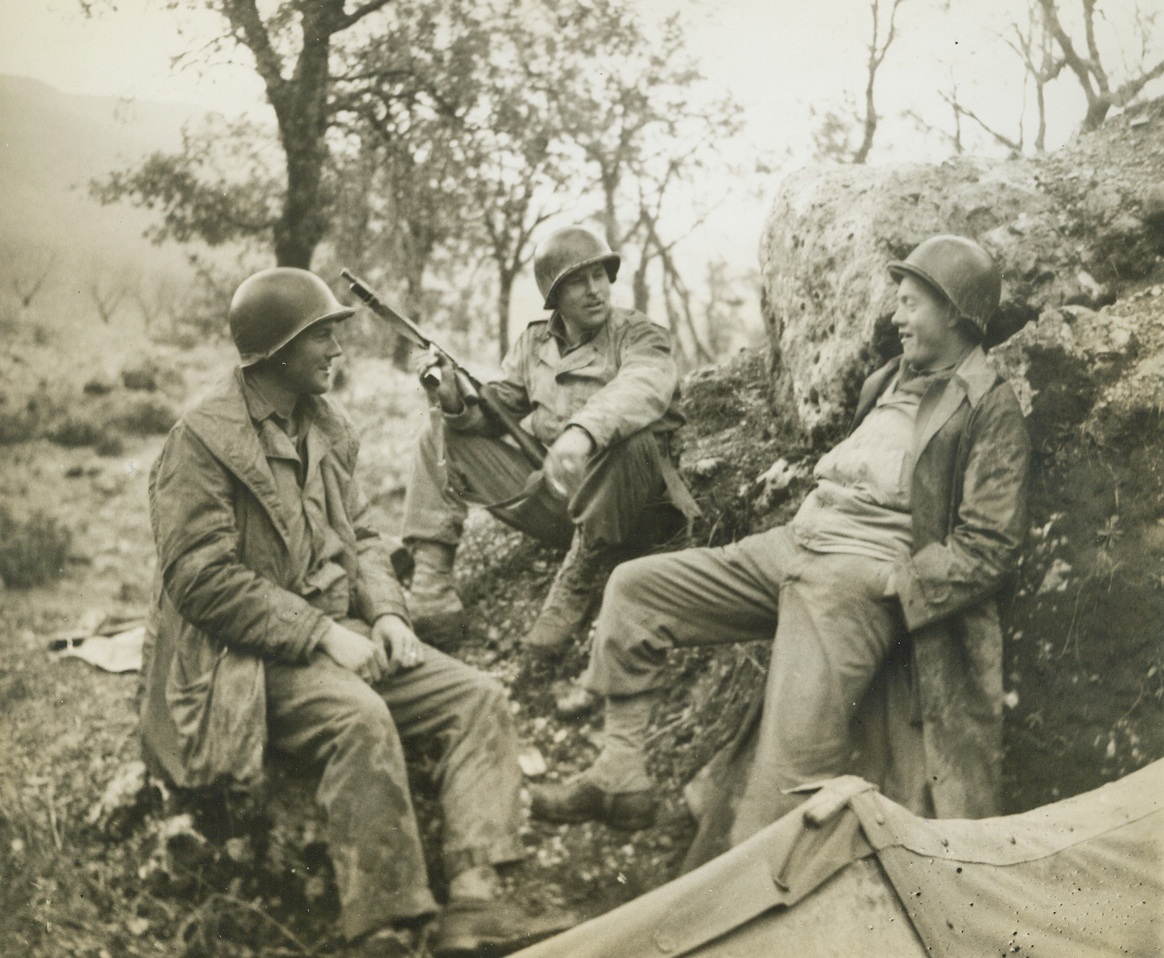
Conversation Piece in Italy, 12/9/1943. A trio of Yanks discuss the fortunes of war by a bomb crater behind the front lines in Italy. Left to Right are: Cpl. F.C. Griffith, Mansfield, Texas; Pfc. Doc Owens, Meigs, Ga.; and Pvt. Eldon D. Long, Dallas, Texas. Credit (ACME);
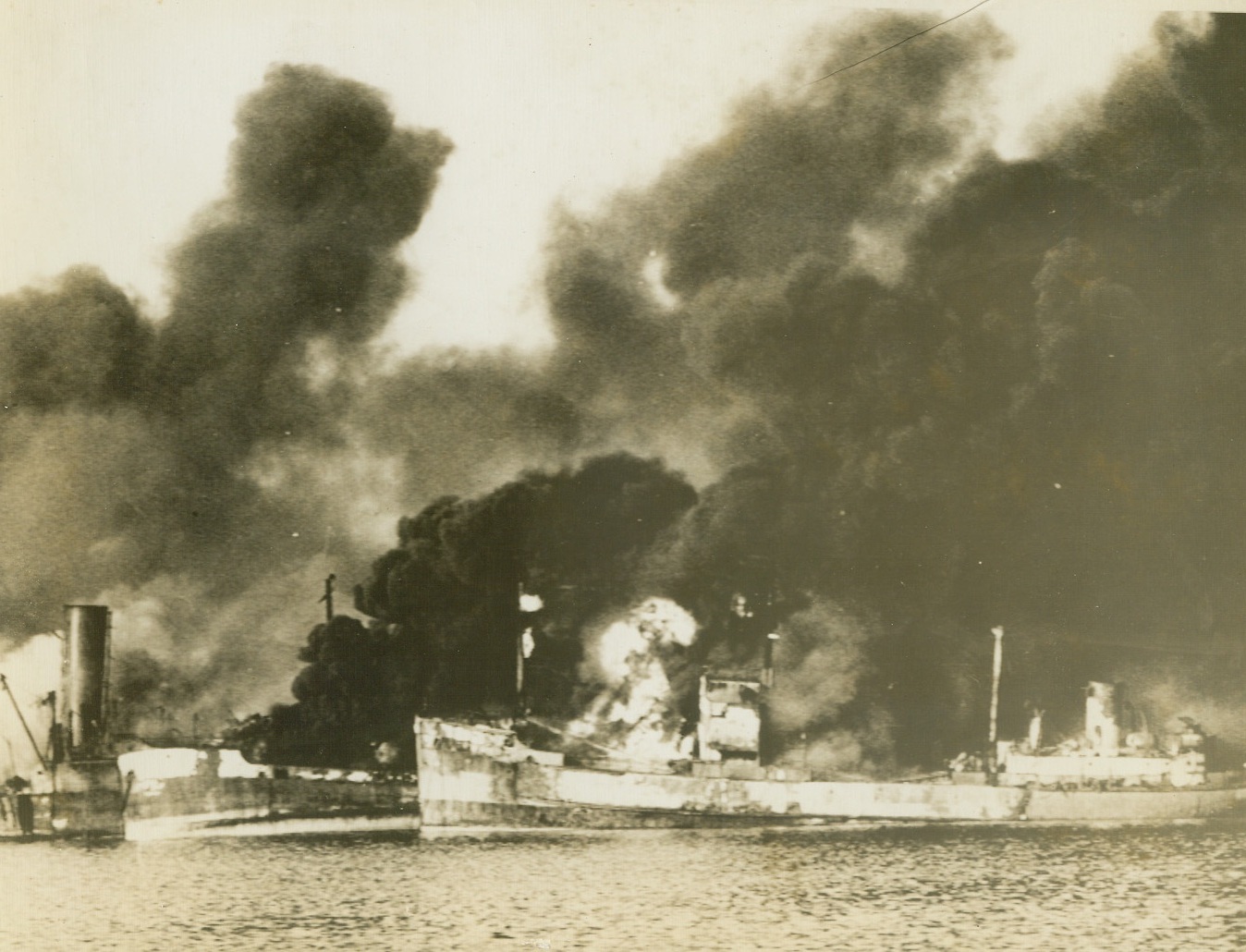
No Title, 12/16/1943. Allied ships burn furiously in harbor at Bari after attack & air raid by Nazi bombers Dec. 2. Most of precious cargo of ships had been removed prior to attack. U.S. Signal Corps Photo from ACME;
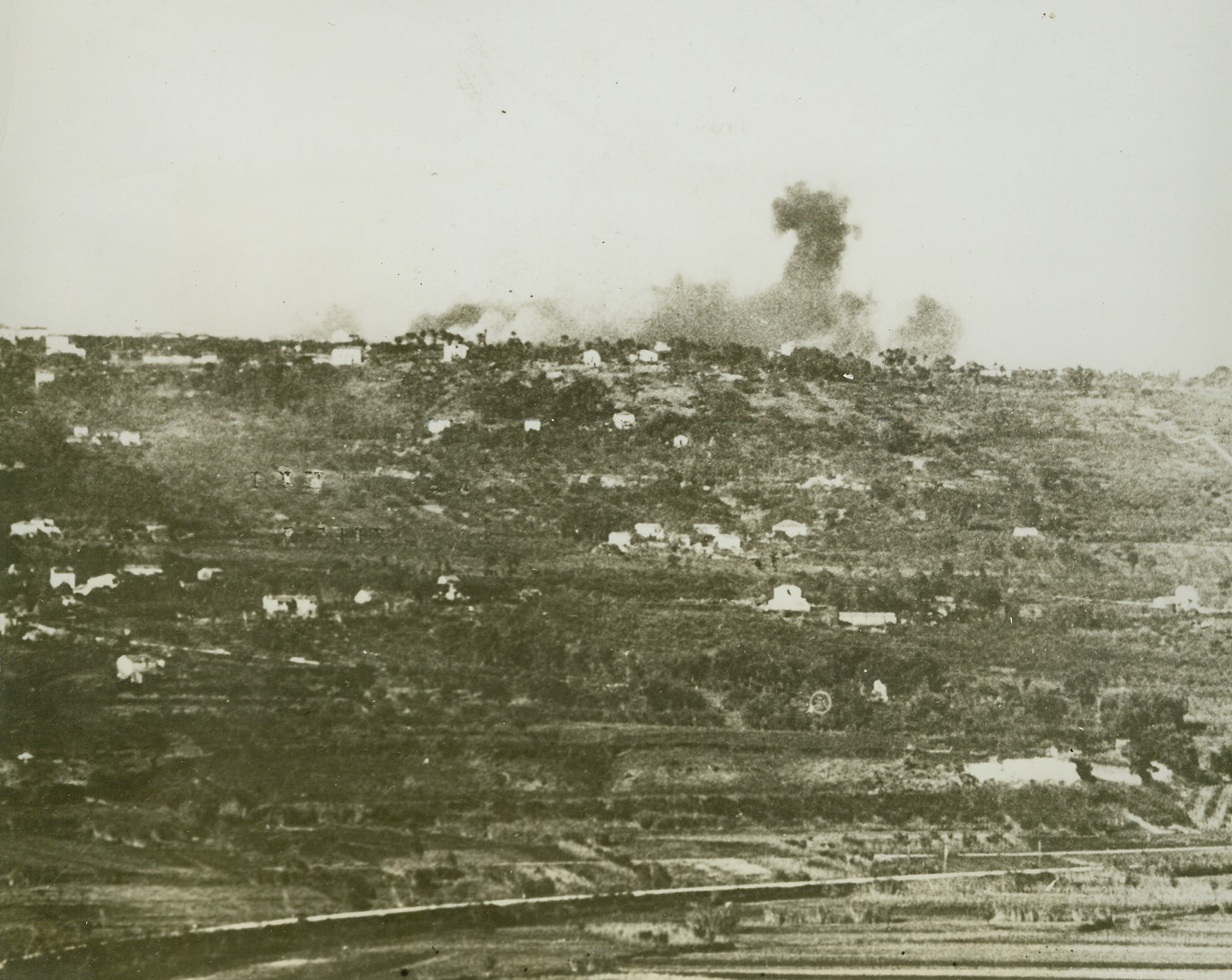
Softening Up the Enemy, 12/16/1943. ITALY – Dark smoke marks Allied bomb hits on German positions across the Sangro River (foreground) as a terrific aerial “softening-up” precedes an 8th Army advance across the Italian waterway. Looking toward Santa Maria the river, crossed by the British on November 25, can barely be seen in the foreground. Credit Line (ACME);
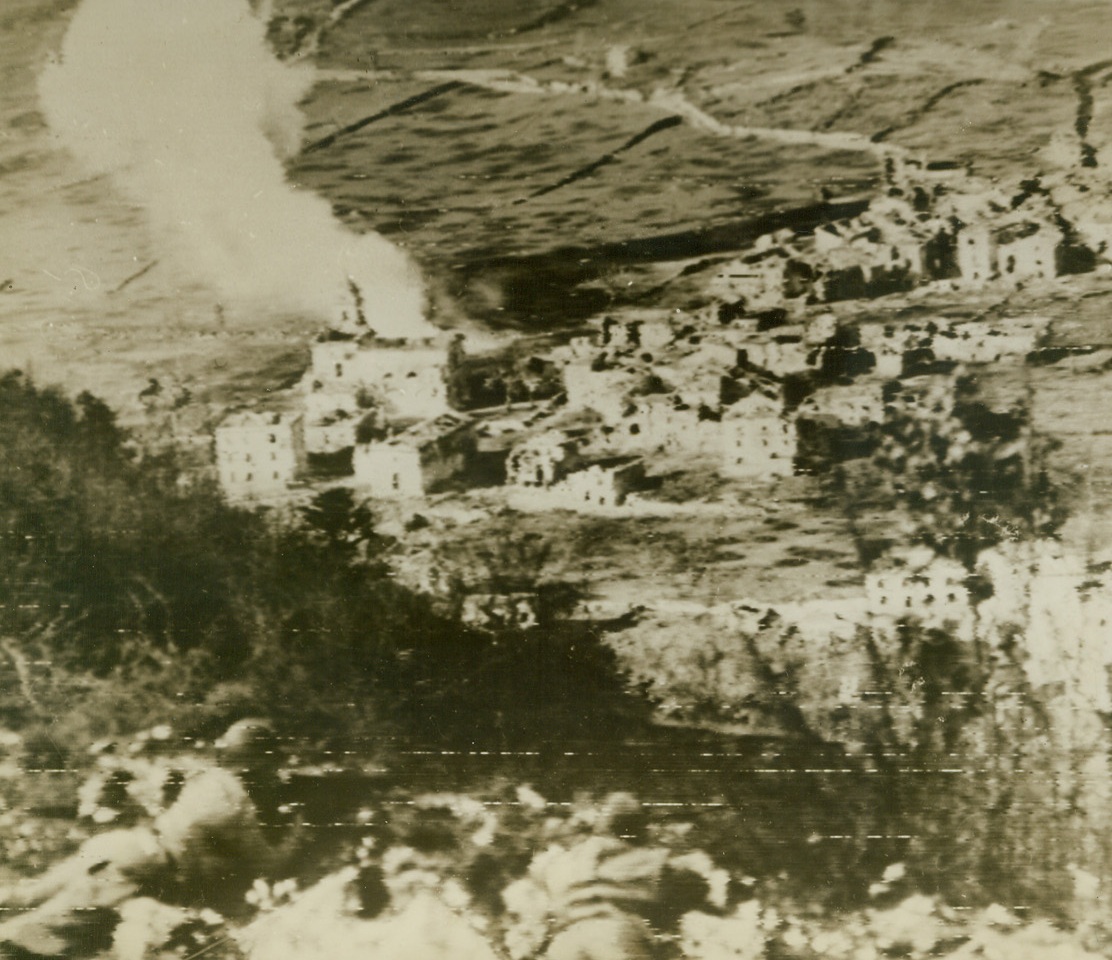
Dropping Shells on Nazi Headquartersf, 12/16/1943. CONCA CASALE, ITALY – A towering column of white smoke marks an exploding American shell, just beyond the church (note steeple), which houses the German headquarters in Conca Casale, just North of Venafro. In foreground, (photo above), U.S. snipers lie ready to pick off any of the Nazis who try to escape from the bombarded building. Credit Line (ACME Photo by Bert Brandt for the War Picture Pool transmitted by Signal Corps Radiotelephoto);
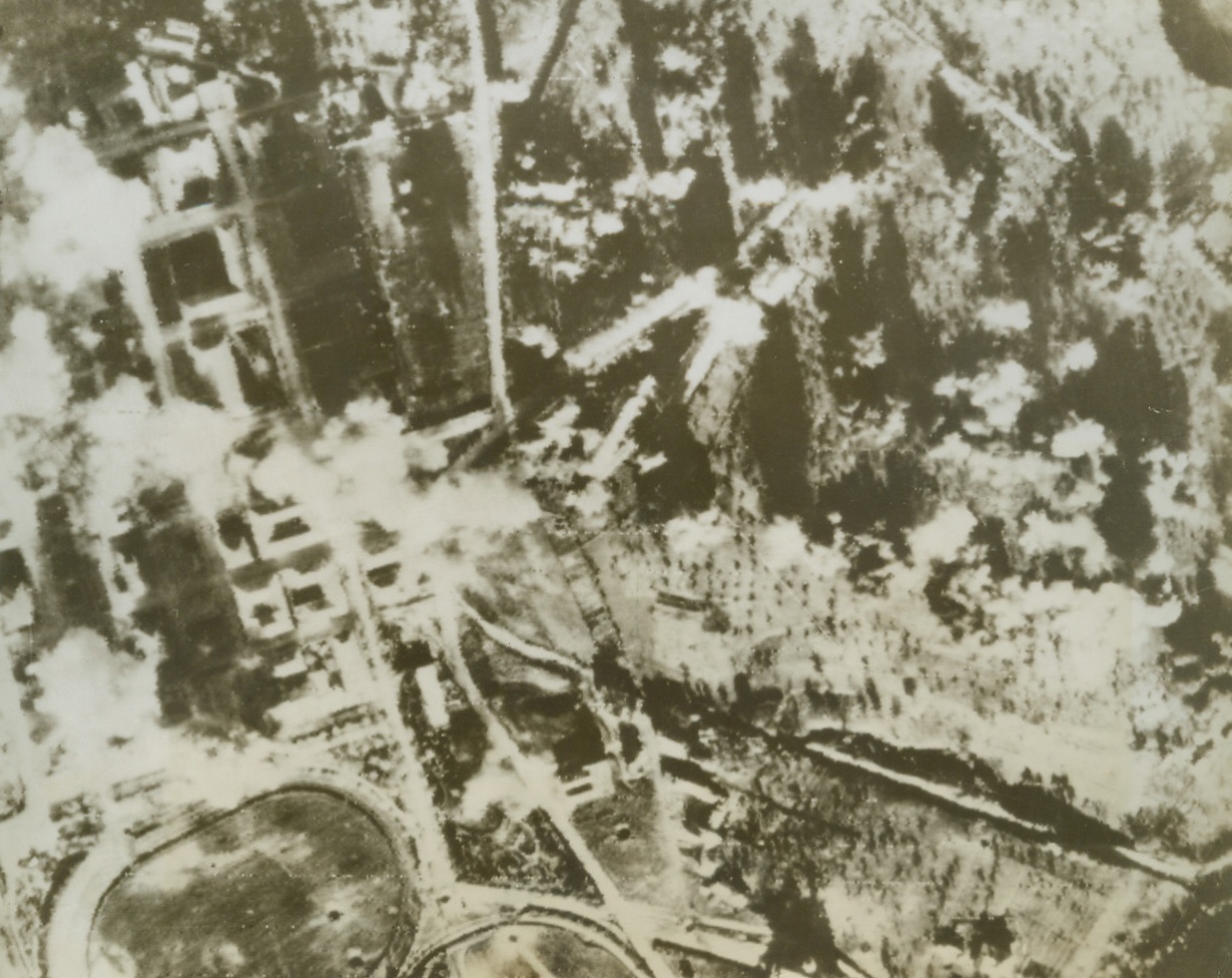
“Excellent Bombing”, 12/3/1943. LANCIANO, ITALY – Allied bombardiers won another round of praise after their recent bombing of roads and enemy-defended positions on the Sangro River front. The marksmanship behind the bomb bursts shown here, at Lanciano, won a report of “excellent bombing” from the Eighth Army. Photo radioed to New York from Algiers. Credit Line (ACME Radiophoto);
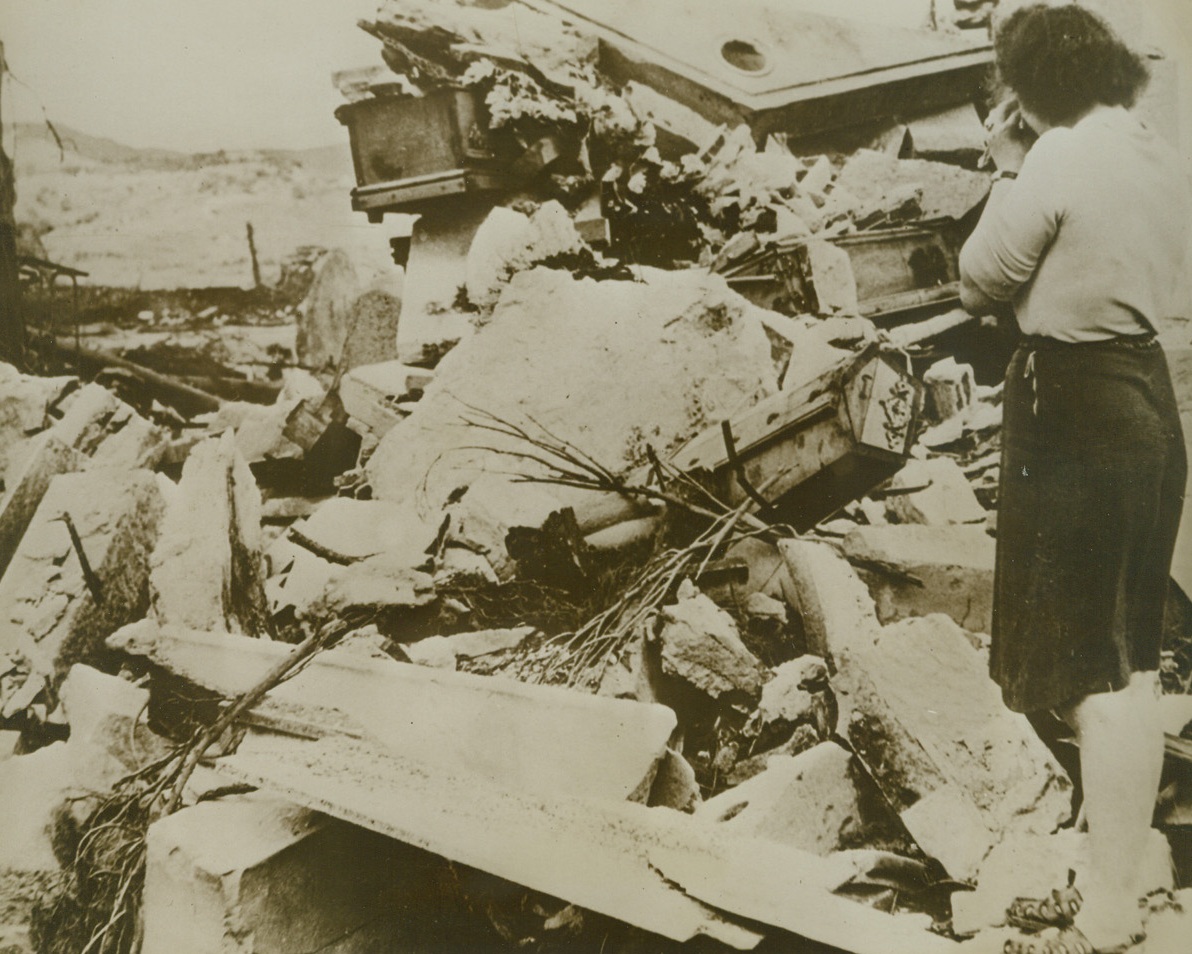
Nazis Desecrate Graveyard, 12/2/1943. BASTIA, CORSICA – A native woman weeps as she views the destruction done by Nazi Demolition squads to this graveyard in Bastia, where members of her family are buried. Germans ruthlessly destroyed buildings and installations in Corsica as they retreated into the corner, where they were beaten by the Allies. Credit Line (OWI Photo from ACME);
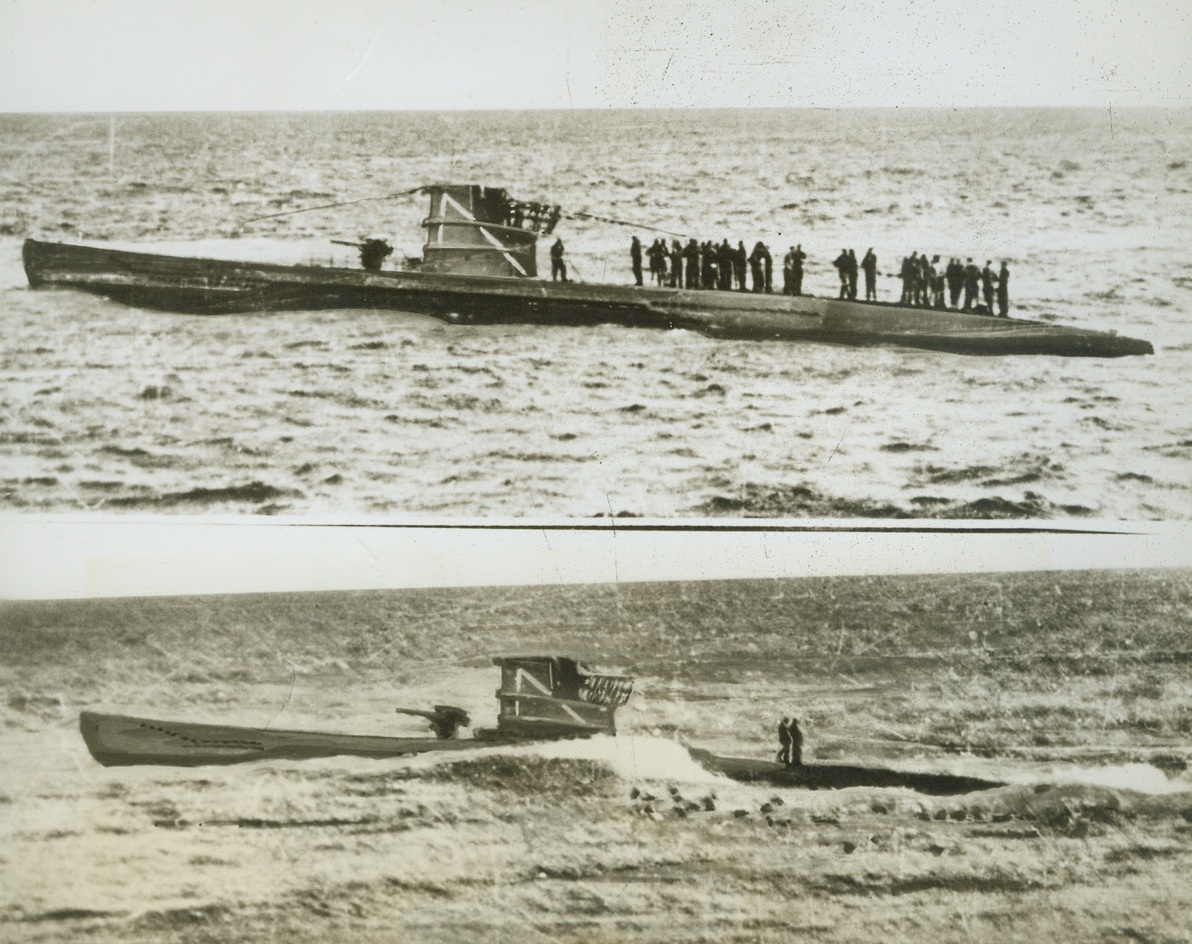
Corvette Versus Sub, 12/5/1943. IN THE ATLANTIC – When a British corvette tangles with a Nazi sub, it usually means plenty of customers for Davey Jones – and, more often than not, the boys in the “locker” are wearing Nazi uniforms. This sub, meeting the corvette HMS Starwort in the Atlantic, was brought to the top by depth charges. In upper photo, the crew lines the deck of the undersea fighter. In lower photo, Nazi sailors dive from the sinking sub to be picked up by the enemy vessel. Credit Line – WP—(ACME);
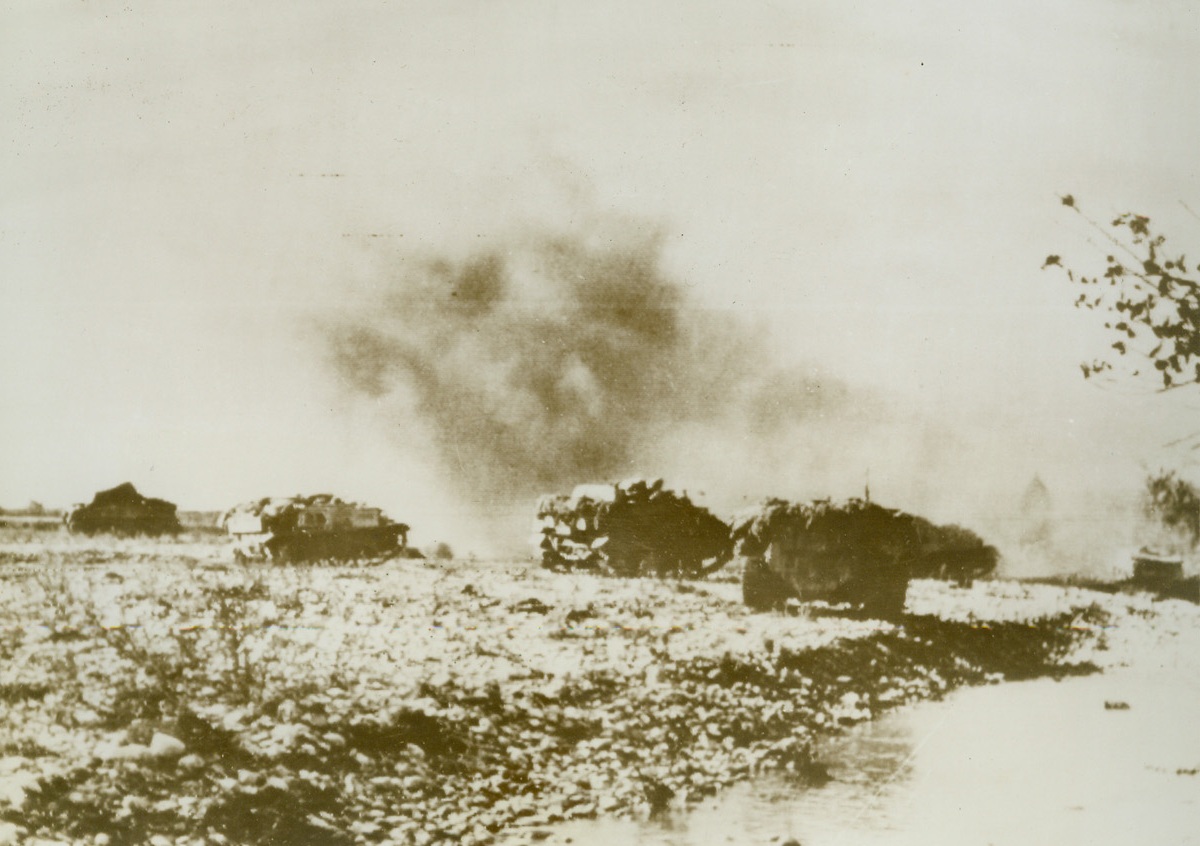
Rolling to Rome, 12/4/1943. ITALY – Sherman tanks and carriers move up as mortar fire explodes in the Sangro River bed where the British 8th Army has knifed through to secondary German defenses. As the Americans stubbornly beat back the enemy in the western part of Italy, the English are doing an equally brilliant job of crushing the Nazis on the Adriatic flank. Credit (OWI Radiophoto from ACME);
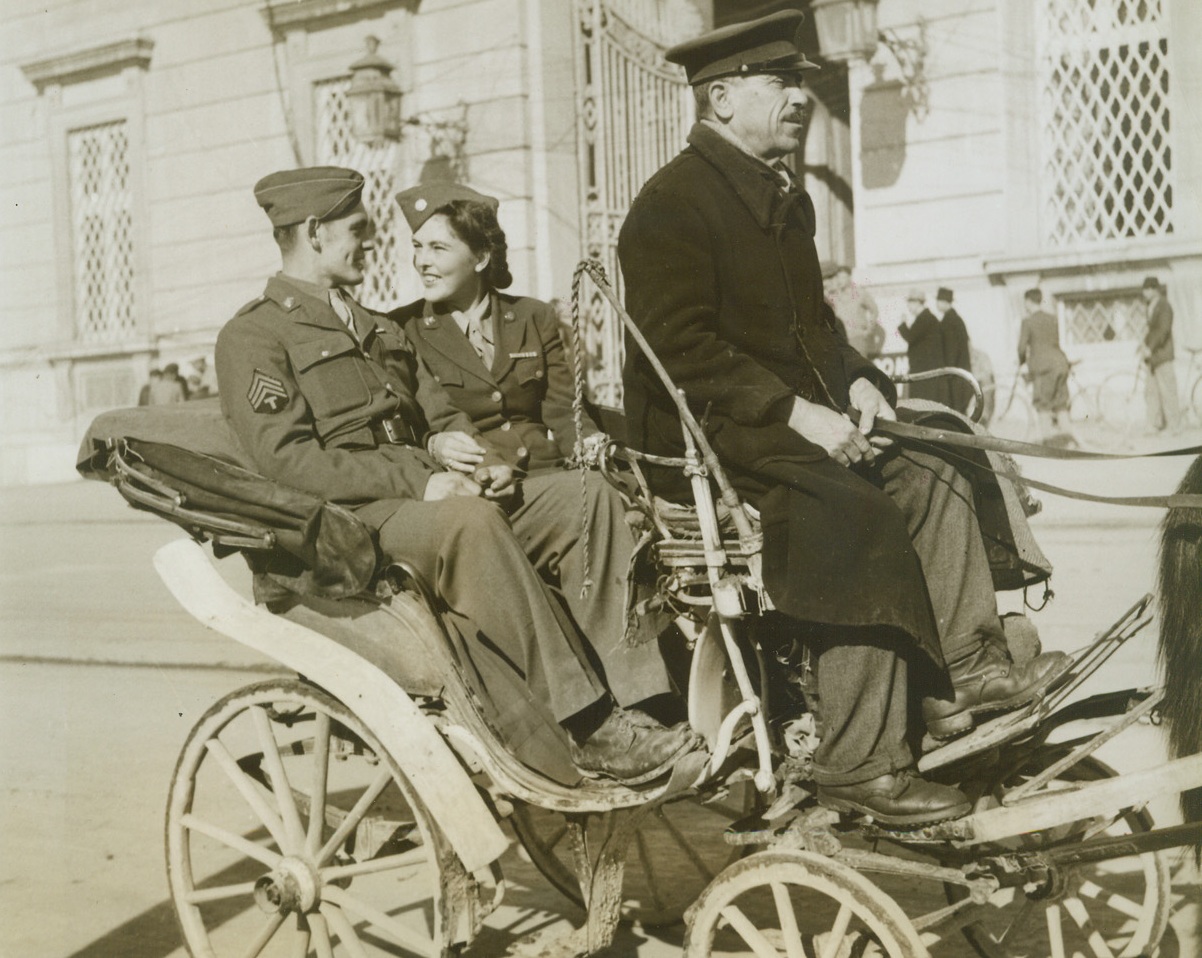
Gosh!, 12/15/1943. ITALY -- …is all that Sgt. Frank Friel, of Portland, Me., can say as pretty WAC Pvt. Rena Hicks, of Louisville, Ky., favors him as an escort for a drive in a picturesque carriage around Caserta, Italy. Credit (ACME Photo by Bert Brandt, War Pool Correspondent);
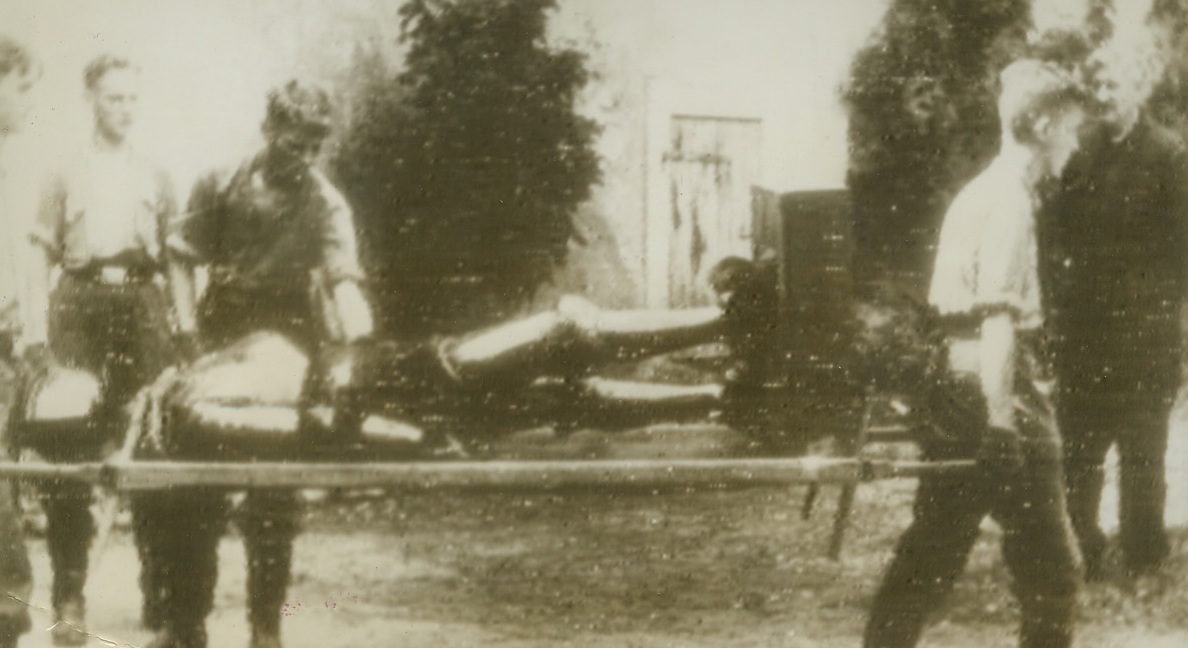
In the Nick of Time, 12/20/1943. BERLIN—Berliners had the right idea when they decided to remove the exhibits form the Zifghaus (Army Museum) last Wednesday because allied bombings hit the structure the next night. Here young boys remove one of the old suits of armour on a stretcher. Credit: ACME Radiophoto from Stockholm.;
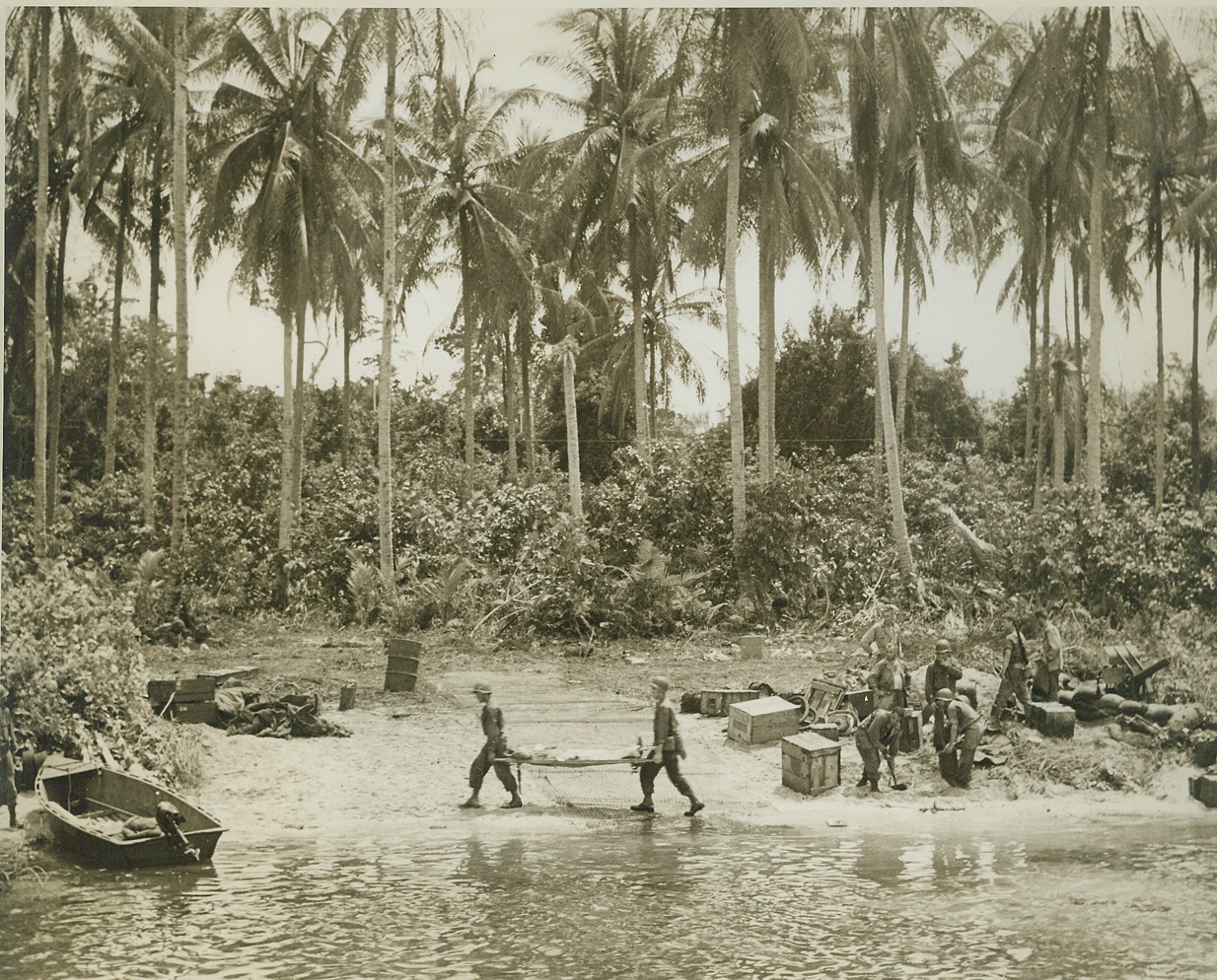
Wounded in Battle, 12/29/1943. Arawe, New Britain – Wounded in the fighting at Arawe, a stretcher-borne Yank is carried through the shallow water on the island’s shore. A group of Yanks work on the littered beach at right. Latest reports from New Britain indicate that our troops have pushed to within striking distance of the Cape Gloucester airstrips, 50 miles southeast of Arawe Credit: -WP-(Photo by Thomas L. Shafer, ACME Correspondent for War Pool);
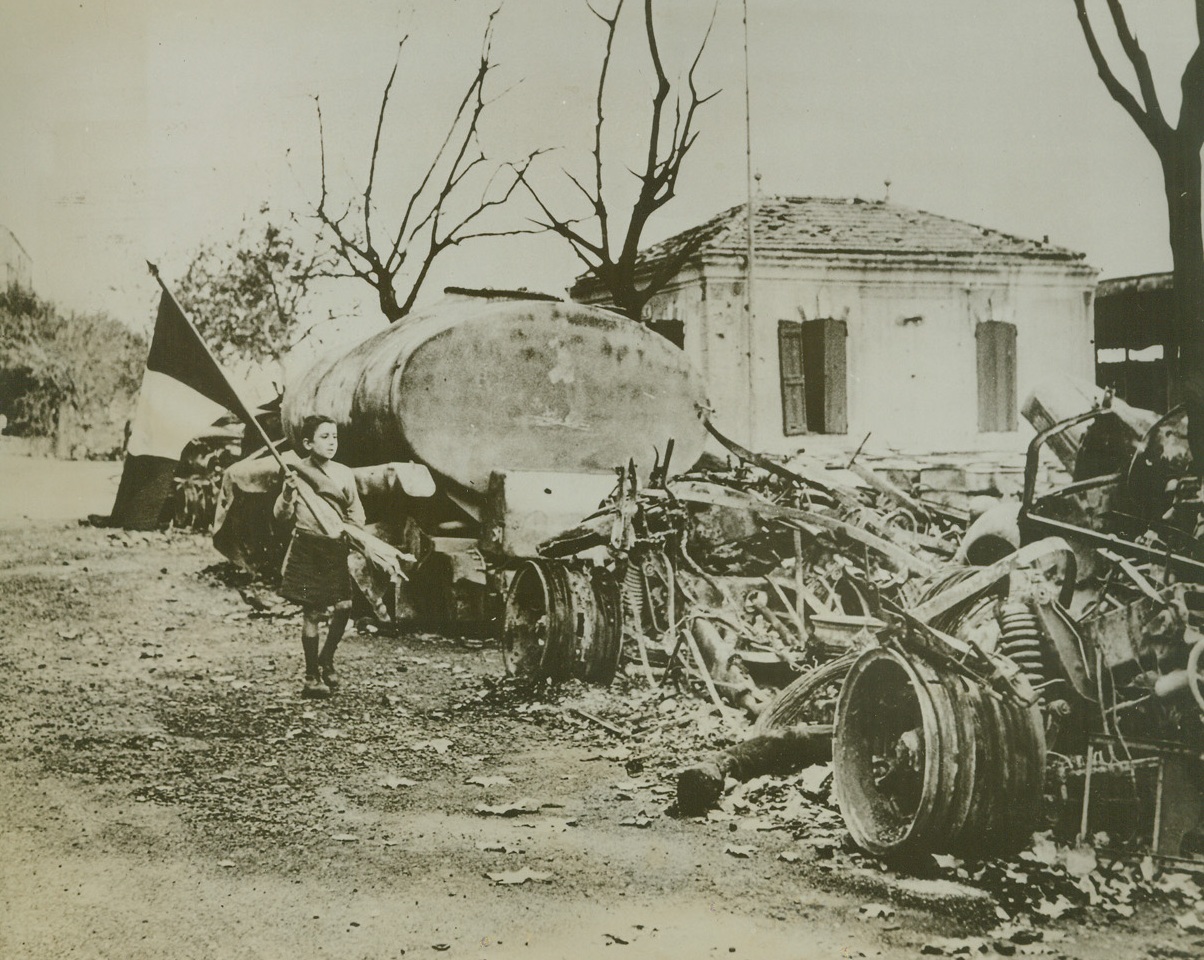
Even the Children Helped, 12/10/1943. CORSICA—Proudly bearing the tricolor of France which he rescued from a ruined building, a youngster of Bastia parades past a pile of wrecked German Machines on the quayside. Young and old helped to bout the Nazi invader from the island of Corsica, and the victory over the Germans was one of the people. Credit: OWI photo from ACME.;
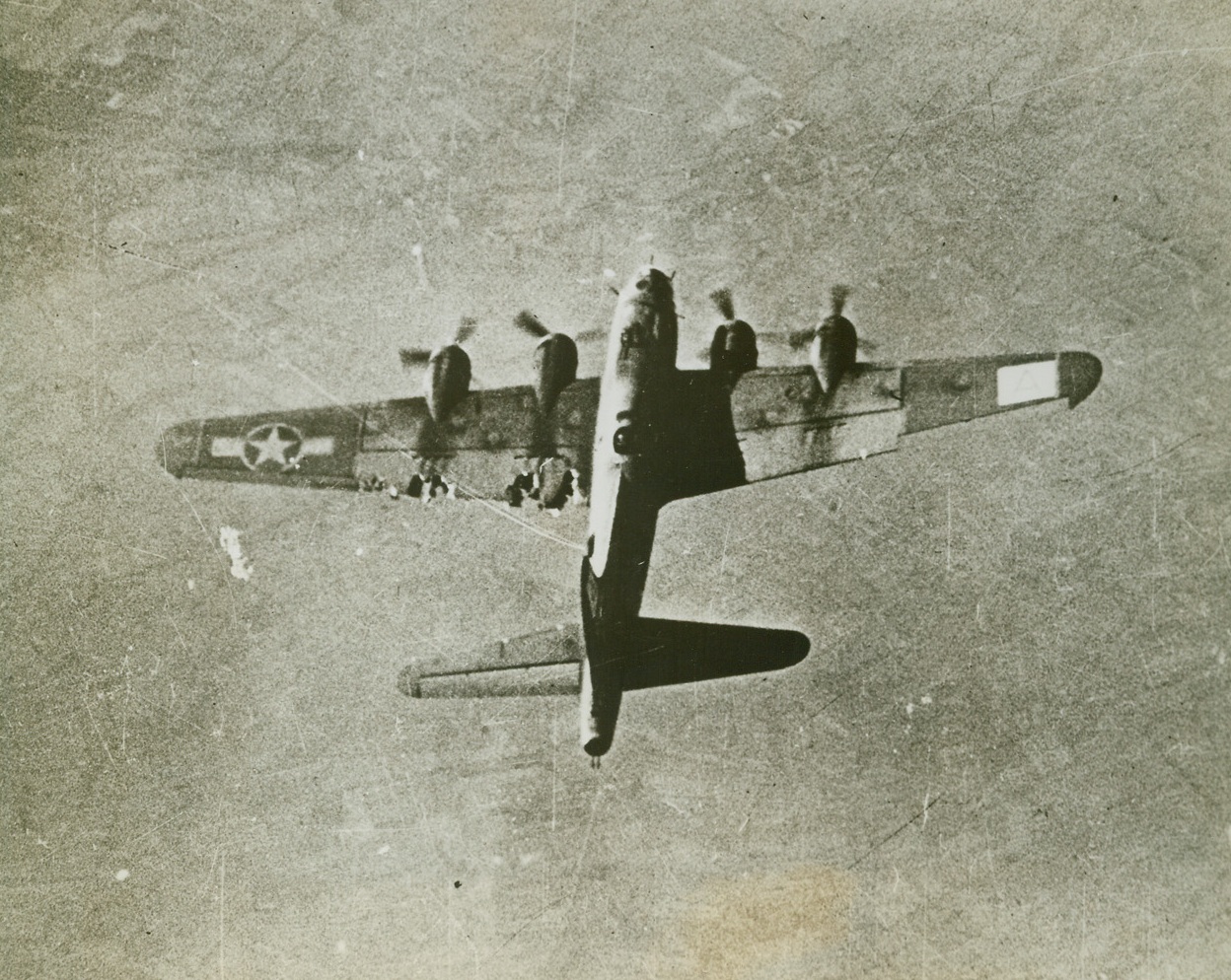
Heading for Gelsenkirchen, 12/31/1943. SOMEWHERE OVER GERMANY—Despite a badly shot up left wing, this flying fortress maintained its place in the formation on the way to bomb Gelsenkirchen, Germany, a vital communications center. This was one of several raids on Gelsenkirchen, which lies 27 miles west of Portmund, on the Duisburg-Hamm Railway. Credit: U.S. ARMY AIR FORCES PHOTO from ACME.;
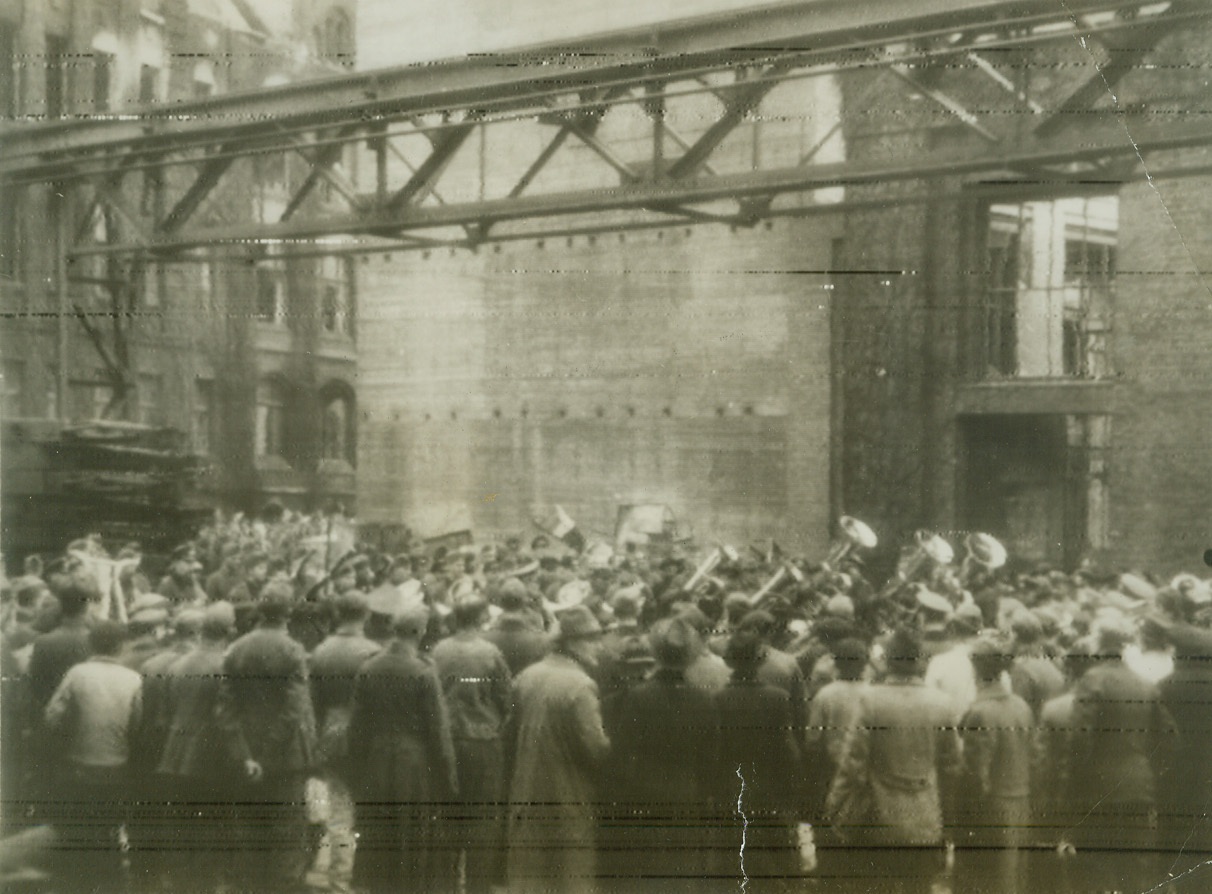
Blowing Up Morale, 12/11/1943.BERLIN—German workers stand around looking glum as a Nazi military band gives an impromptu, morale-boosting concert, outside a large factory that suffered serious damage in the recent bombings of Berlin. Photo, radioed to New York today (Dec. 11th), was obtained through a neutral source. Credit Line (ACME Radiophoto);
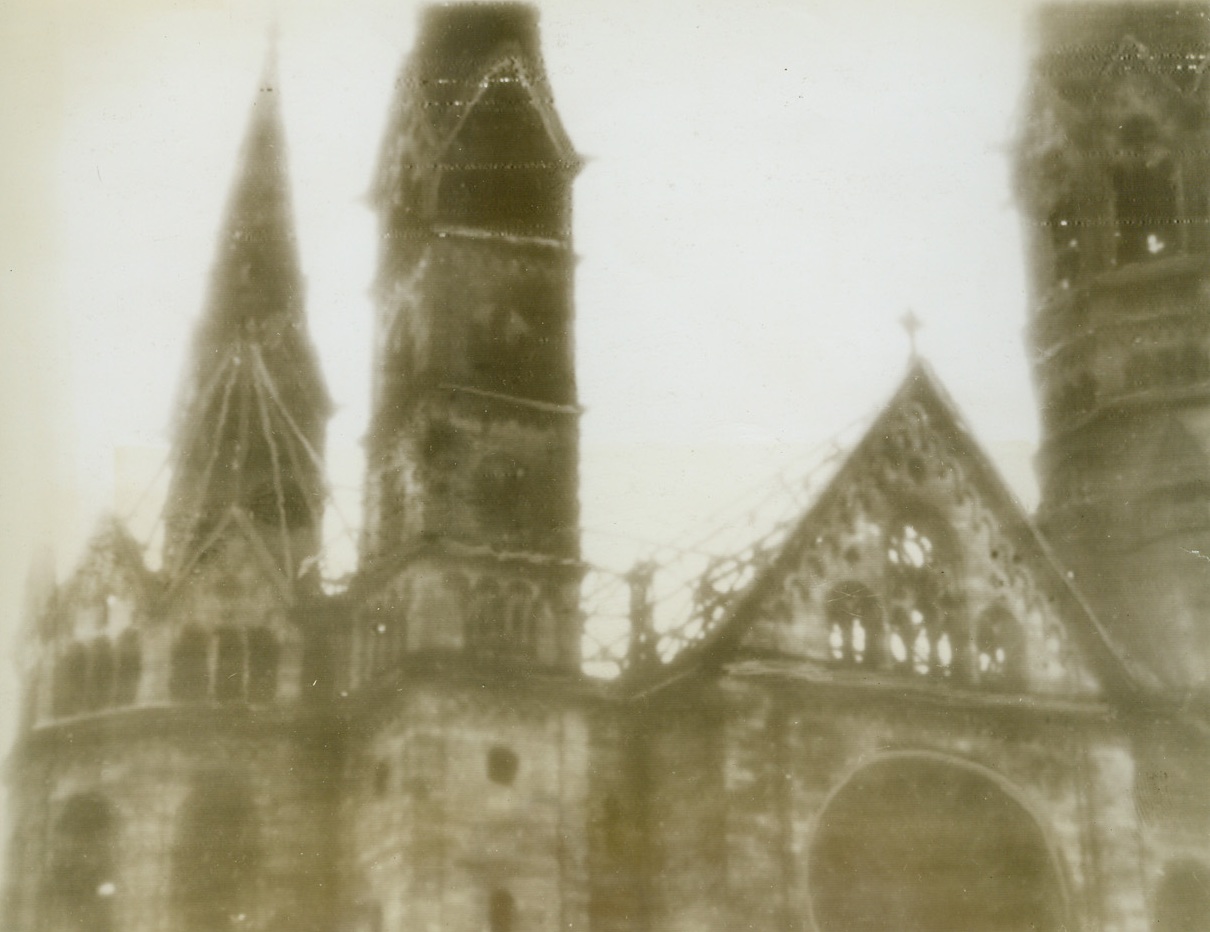
Famous Berlin Church Damaged, 12/13/1943. BERLIN—One of the unavoidable casualties in the all-out allied bombings of Berlin is the Kaiser Wilhelmgedaechtnis Kirche (memorial church), massive Gothic church, on the city’s famed Kurfirstendam, The tall Spires remain standing and most of the damage seems to have been done to the main roof and windows. Photo received by radio from Stockholm this morning. Credit Line (ACME Radiophoto);
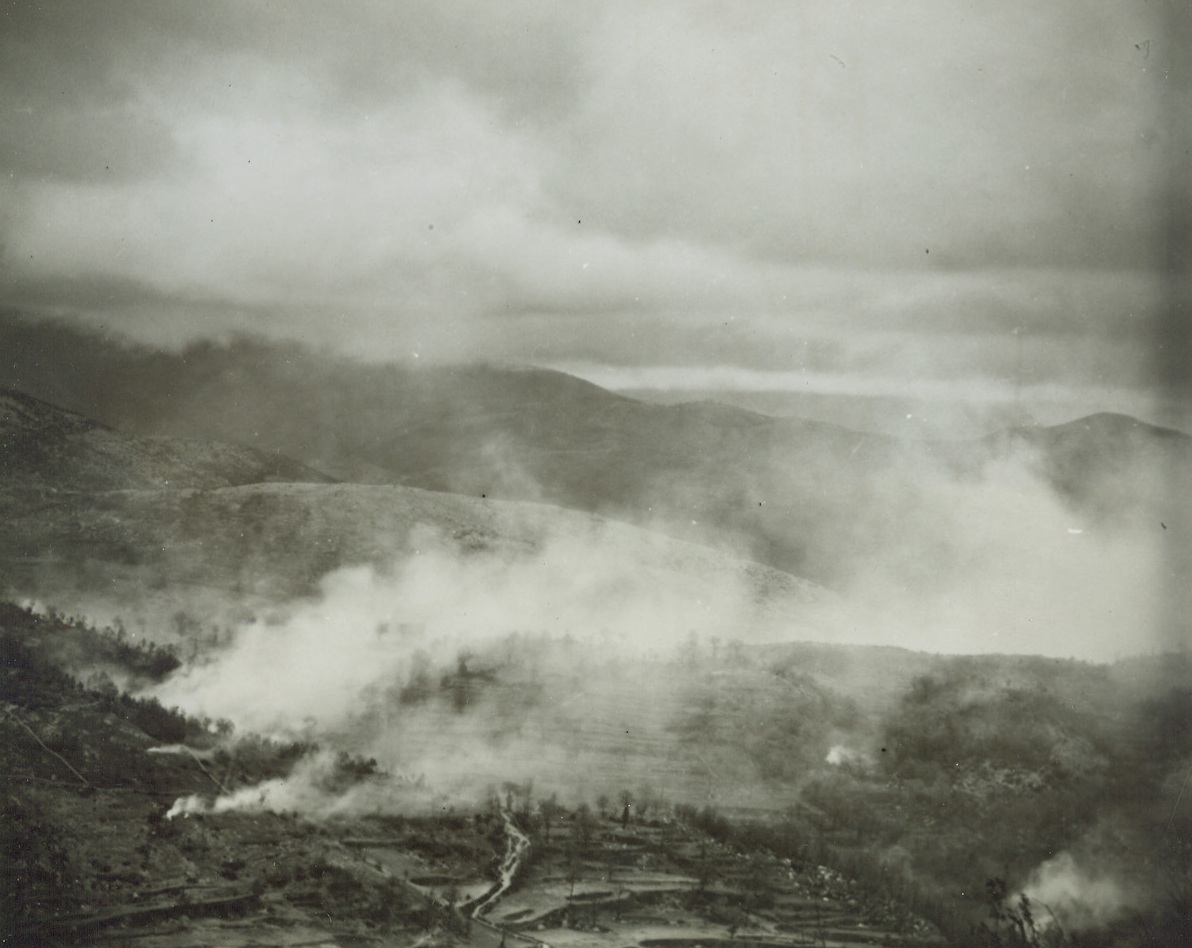
On the Winter Line, 12/30/1943. Artillery shells and mortar turn this Italian battlefield into a smoking inferno as American fighters push steadily ahead, determined to pierce Germany’s winter line of defense. Latest reports from the Italian front indicate that fighting is still fierce in the northern sector as French Moroccan troops bout the Nazis from the mountainous country. Credit: ACME photo by Bert Brandt, War Pool Correspondent.;
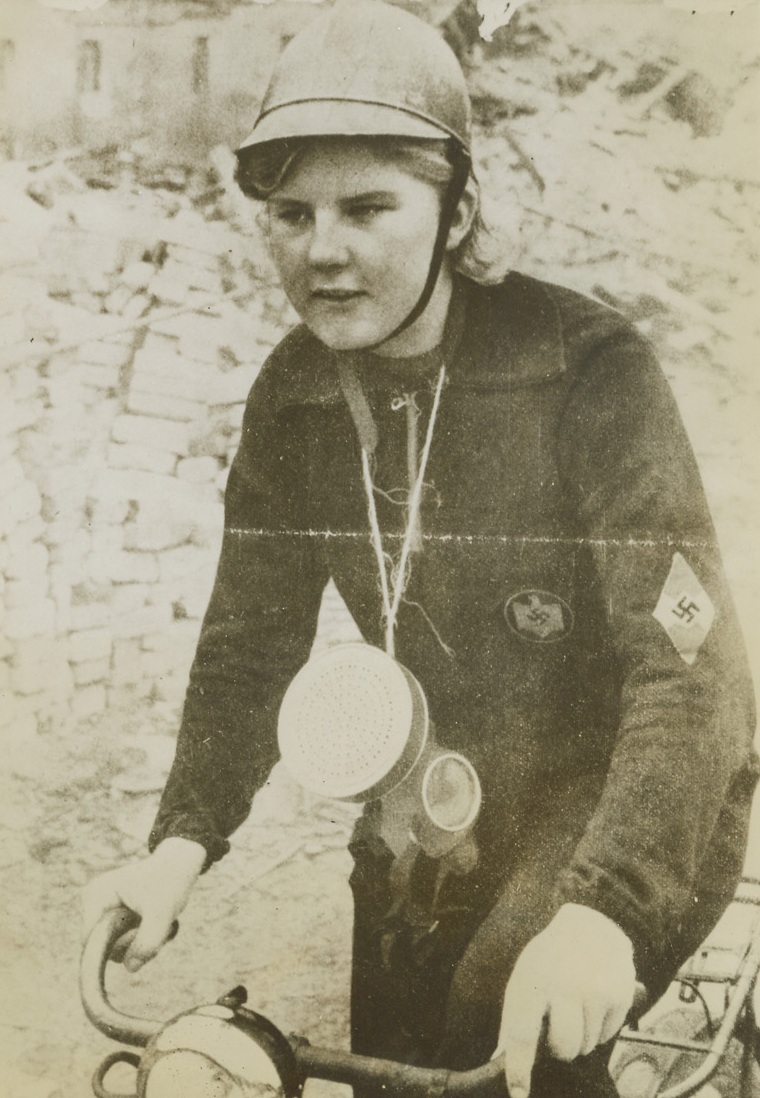
Berlin Air Raid Warden, 12/13/1943. BERLIN—A young girl, obviously still in her teens who is probably on of Berlin’s hastily enrolled air raid wardens, rides through the city’s blitzed streets on a bicycle the morning after an all-out Allied raid. She is equipped with a helment, gas mask and overalls. Note Swastika on her arm and pile of debris in the background. Photo received through a neutral source. Credit: ACME.;
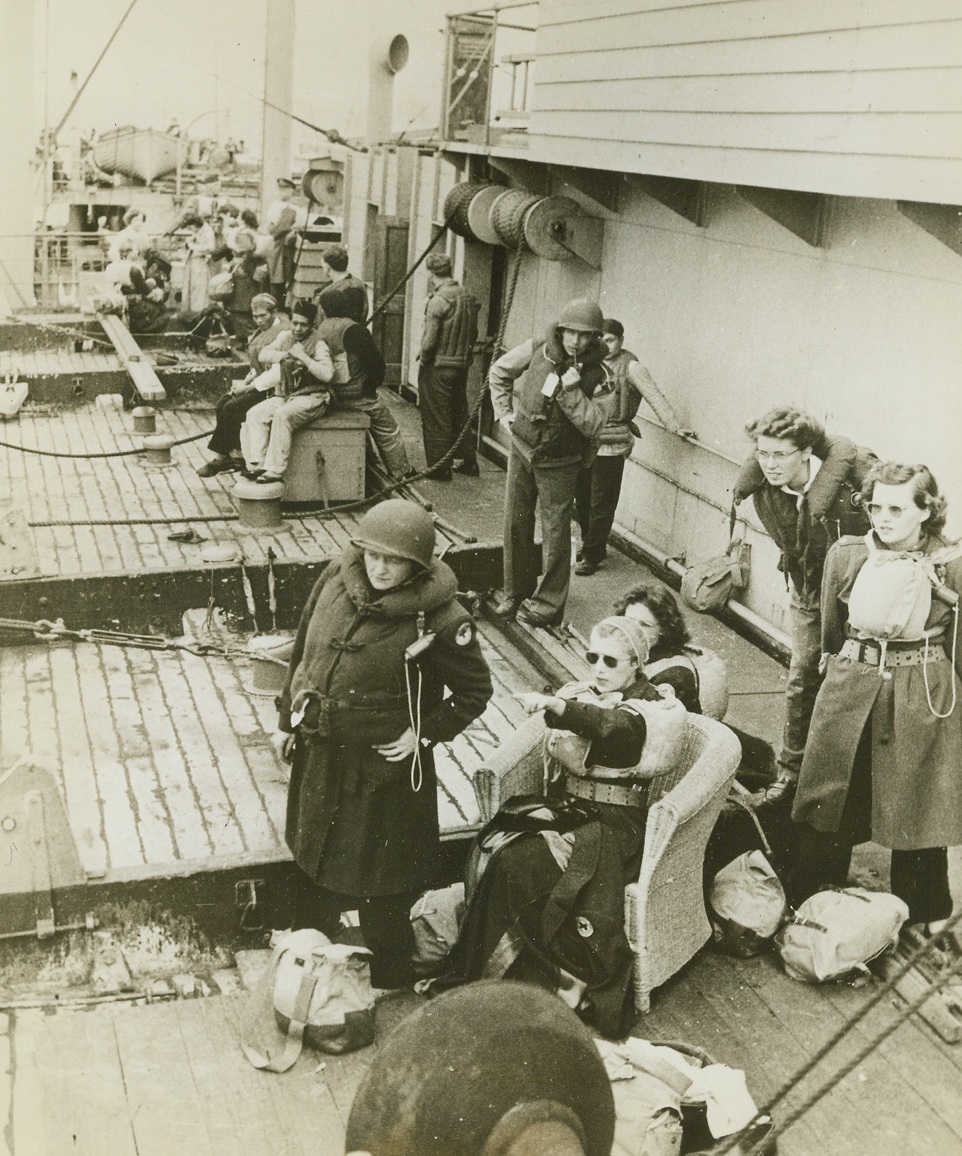
TENSE MOMENT ON SHIPBOARD, 12/28/1943. This photo, taken aboard a transport carrying U.S. troops and Red Cross girls to one of the battle fronts, was taken during a tense moment during an attack by an enemy submarine. The U-boat was sunk or driven off before it had a chance to do any damage.Credit: Red Cross Photo from Acme;
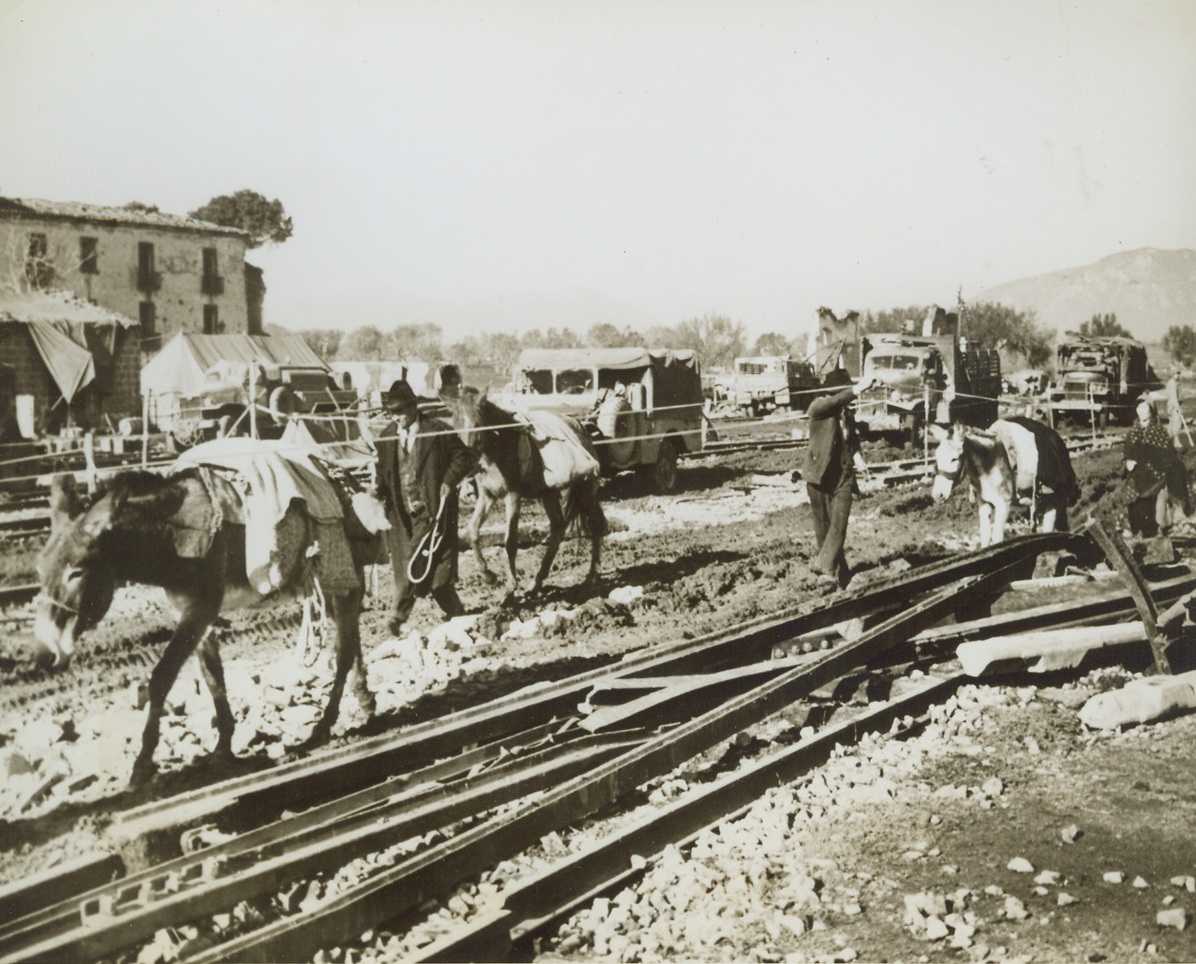
RAILROAD BED BECOMES HIGHWAY, 12/19/1943. SOMEWHERE IN ITALY—Their few possessions strapped to the backs of mules, Italian civilians lead the beasts along a railroad bed that now serves as a highway. Wrecked by the Germans, the rocky road bed was converted to a highway by the Allies as they made their way north, in pursuit of the Germans.Credit: Acme;
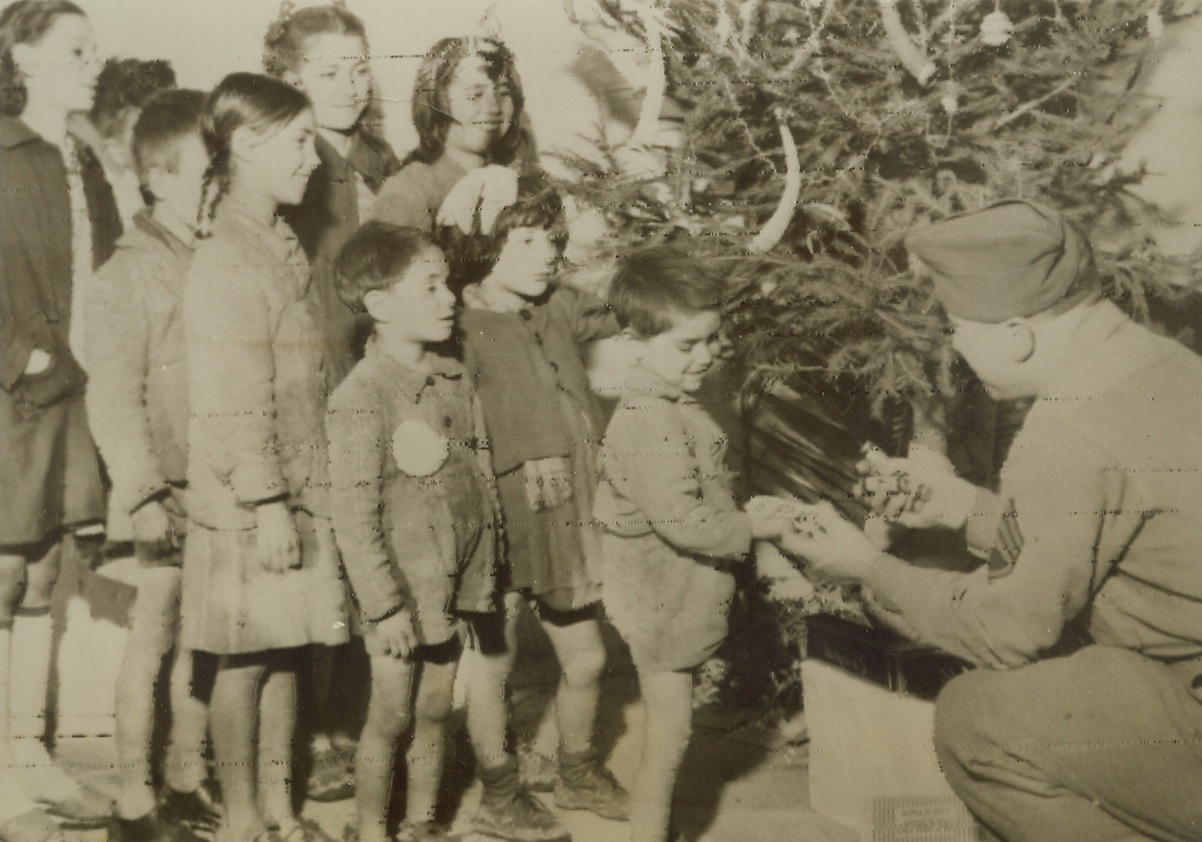
MERRY CHRISTMAS FROM THE YANKS, 12/26/1943.ITALY—The Christmas spirit is not swallowed up in war in Italy, either, where Sgt. Patsy Di Custanzo, of New York City gives candy to native youngsters in Caserta. Although goodies are scarce in their country, the Italian children patiently await their turn for the Yankee gifts.Credit: OWI Radiophoto from Acme;
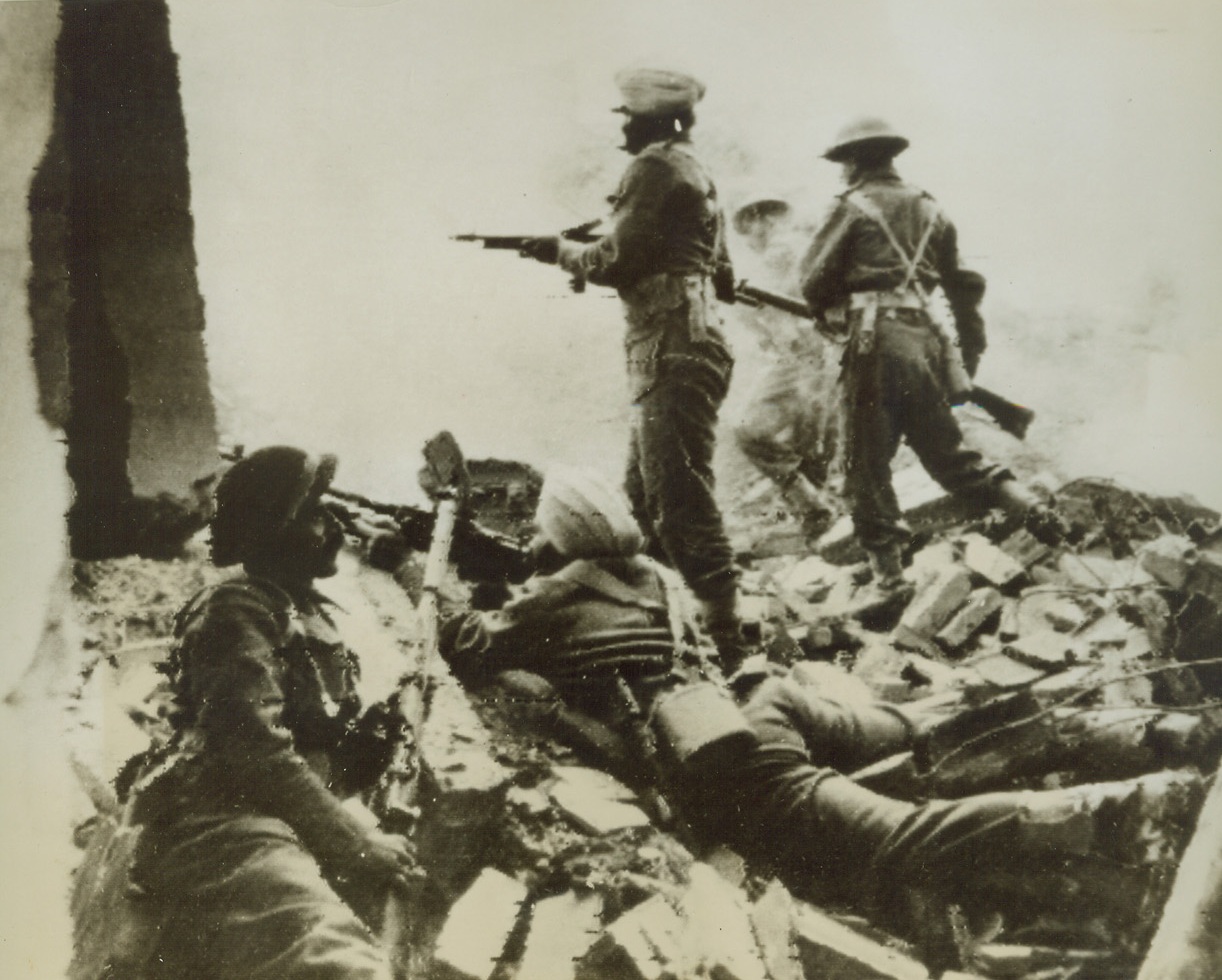
INDIAN TROOPS FIGHT WITH 8TH ARMY, 12/20/1943. ITALY—An Indian Bren gunner, (second from left), gives covering fire, as Indian and British troops of the 8th Army advance on the Italian Front. At the time this photo was taken, the town and this emplacement were under heavy German mortar fire. This photo flashed to New York by radio from Algiers, today.Credit: OWI Radiophoto from Acme;
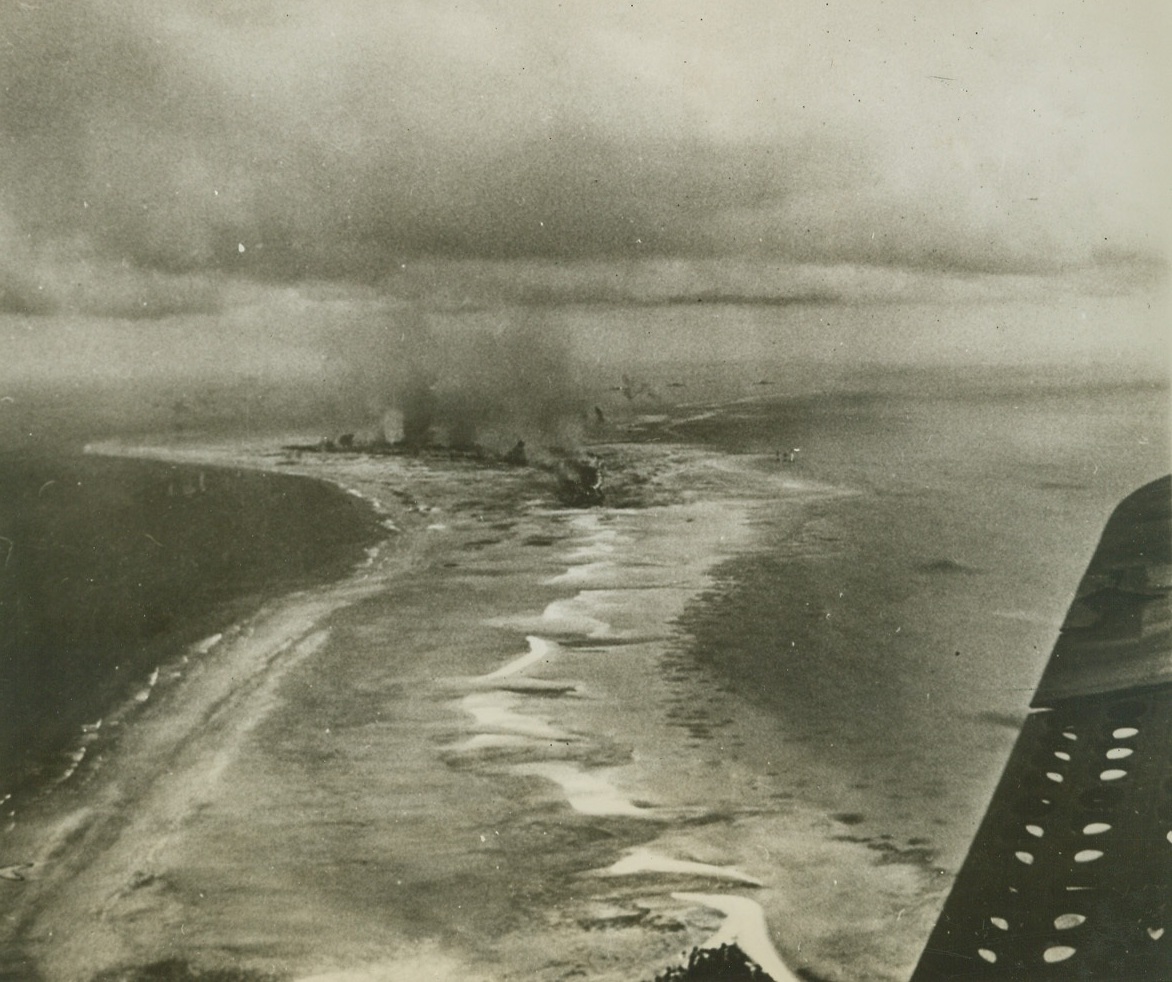
Allies Blast Tarawa, 12/16/1943. This photo, taken from the air as Allied air and sea forces bombarded the islands of the Tarawa group, shows Jap installations burning fiercely on one of the islands. In the battle, one of the bloodiest in history, U.S. Forces suffered many casualties. Credit: (ACME) (WP);
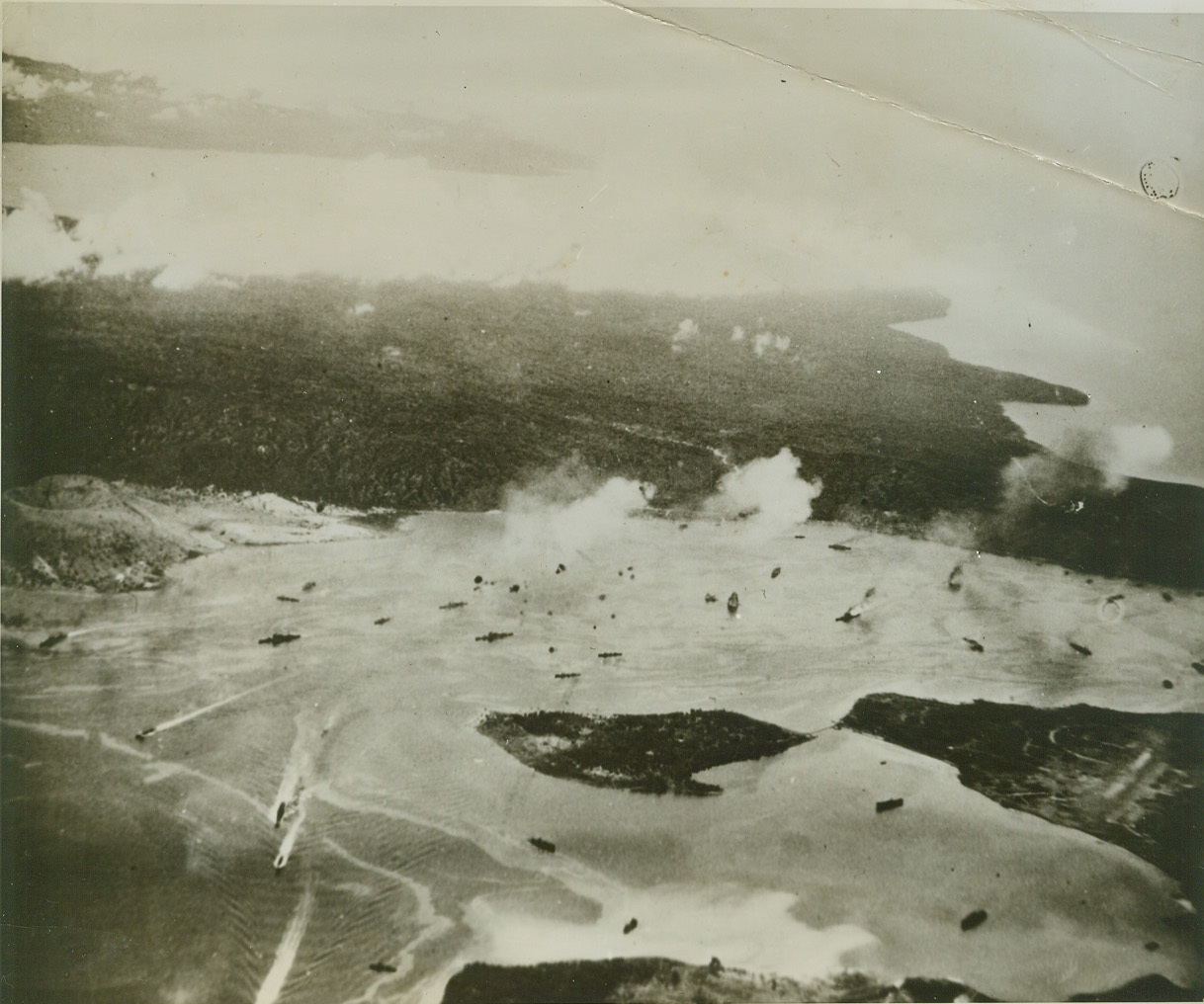
We Nab 20 Jap Warships, 12/6/1943. While smaller ships scuttle, beetle-like for the open sea, flames rise from what appears to be a Jap cruiser (right) and black smoke and fire billow from another ship, during one of November 5th or November 11th raids on Rabaul Harbor. Carrier-based planes staged the surprise attacks, sinking and damaging over 20 Jap warships. Credit (Official U.S. Navy Photo From ACME);
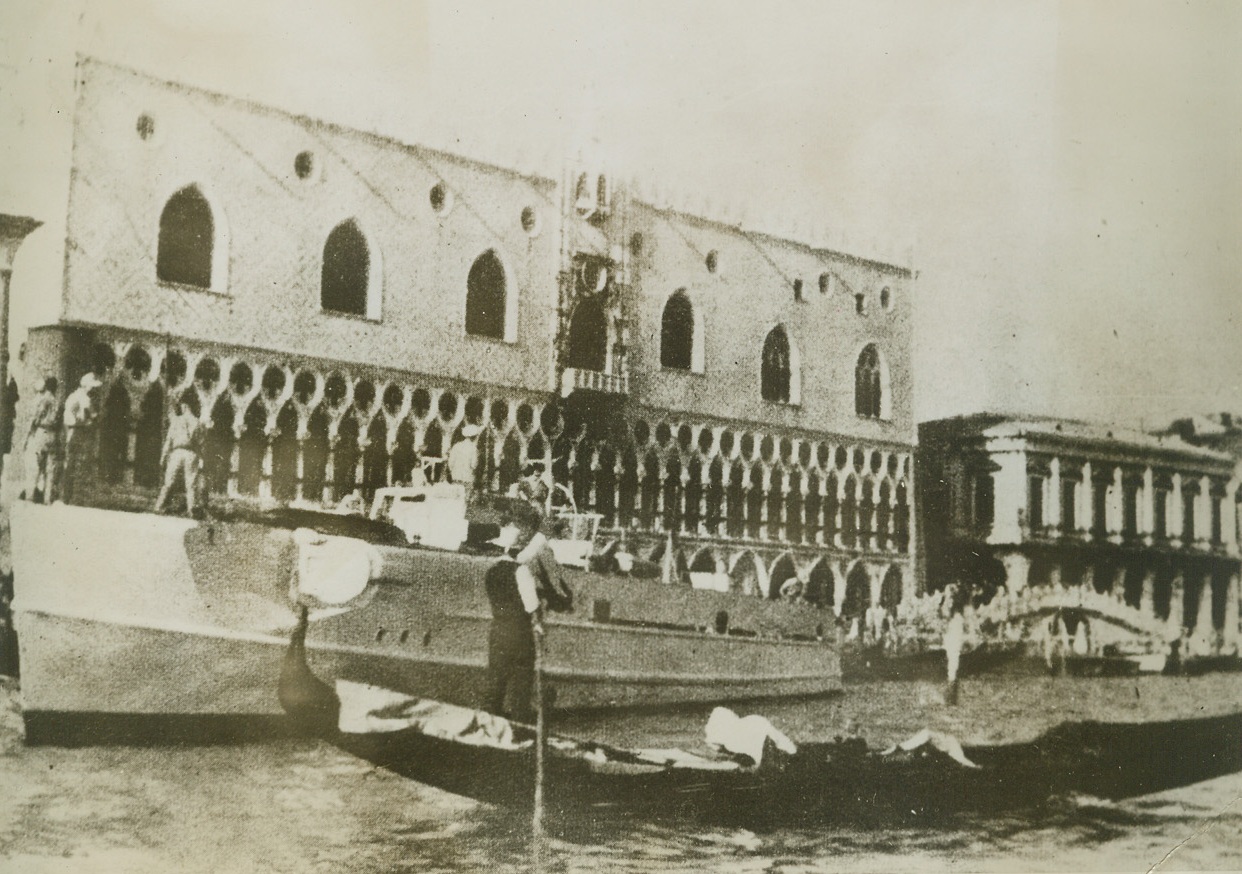
WARTIME “GONDOLA” IN VENICE, 12/13/1943. The historic beauty of Venice’s canals, had been marked by the grimness of war and here in this photo from a neutral source, a German gunboat can be seen anchored near the Doge’s Palace in Venice, alongside a gondola (right foreground) waiting for hire. Credit: Acme;
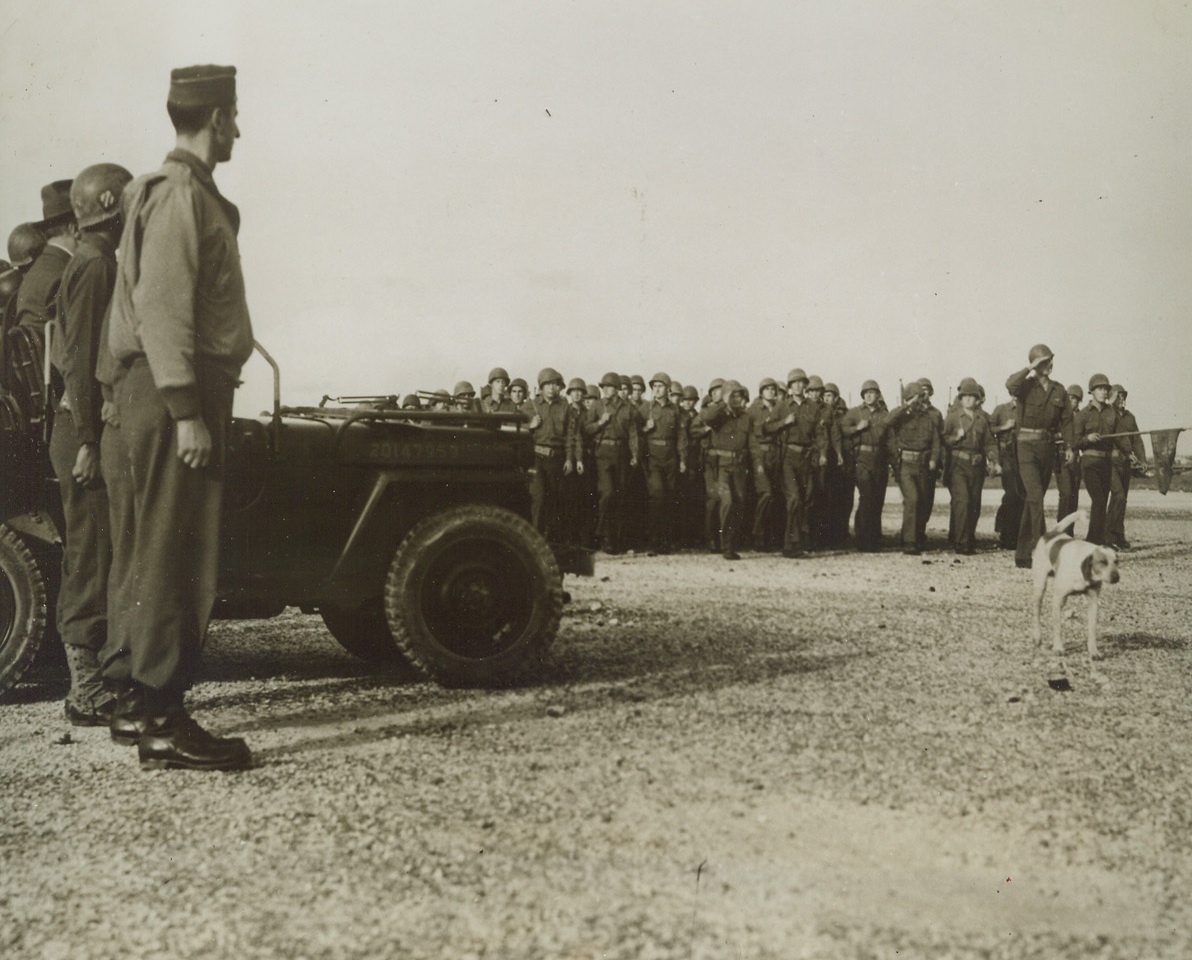
MASCOT PARADES, TOO, 12/15/1943. SICILY—Touching their battle-helmets as they march in review before their distinguished visitor, President Roosevelt, these veterans of the Sicilian campaign are led by their unconcerned mascot, who ambles along with…FDR a second glance. In left, fore-…Lt. Gen. Mark W. Clark.;
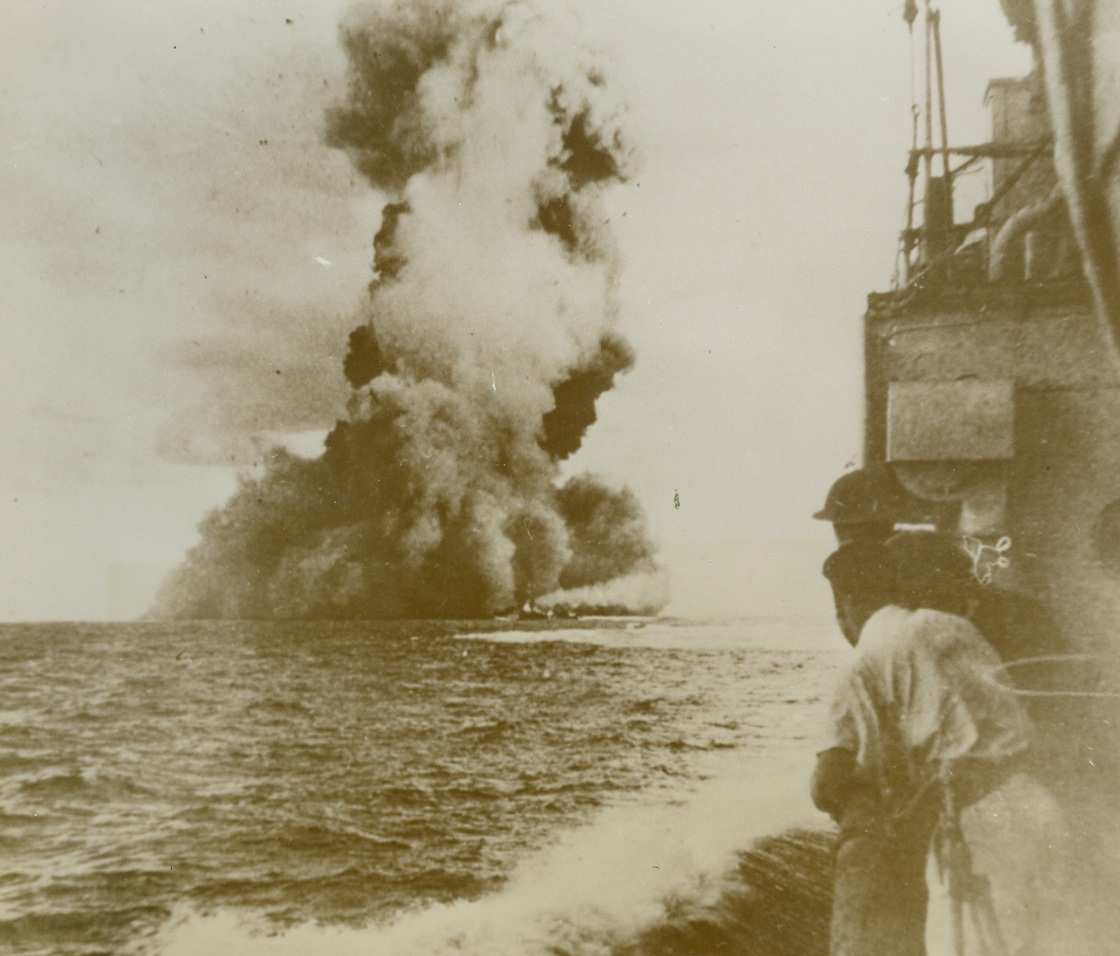
“BARHAM” GOES UP IN SMOKE, 12/13/1943. MEDITERRANEAN—Huge clouds of black smoke mark the watery grave of the 31,100-ton British battleship “Barham,” which blew up when hit by four enemy torpedoes off the Libyan coast on Nov. 25th, 1941. The vessel sank 4 minutes and 45 seconds after the first torpedo entered her side. Only 303 of her complement of 1172 men were saved. Photo, which was just released by the censor, was made from an Australian destroyer. Credit: Acme;
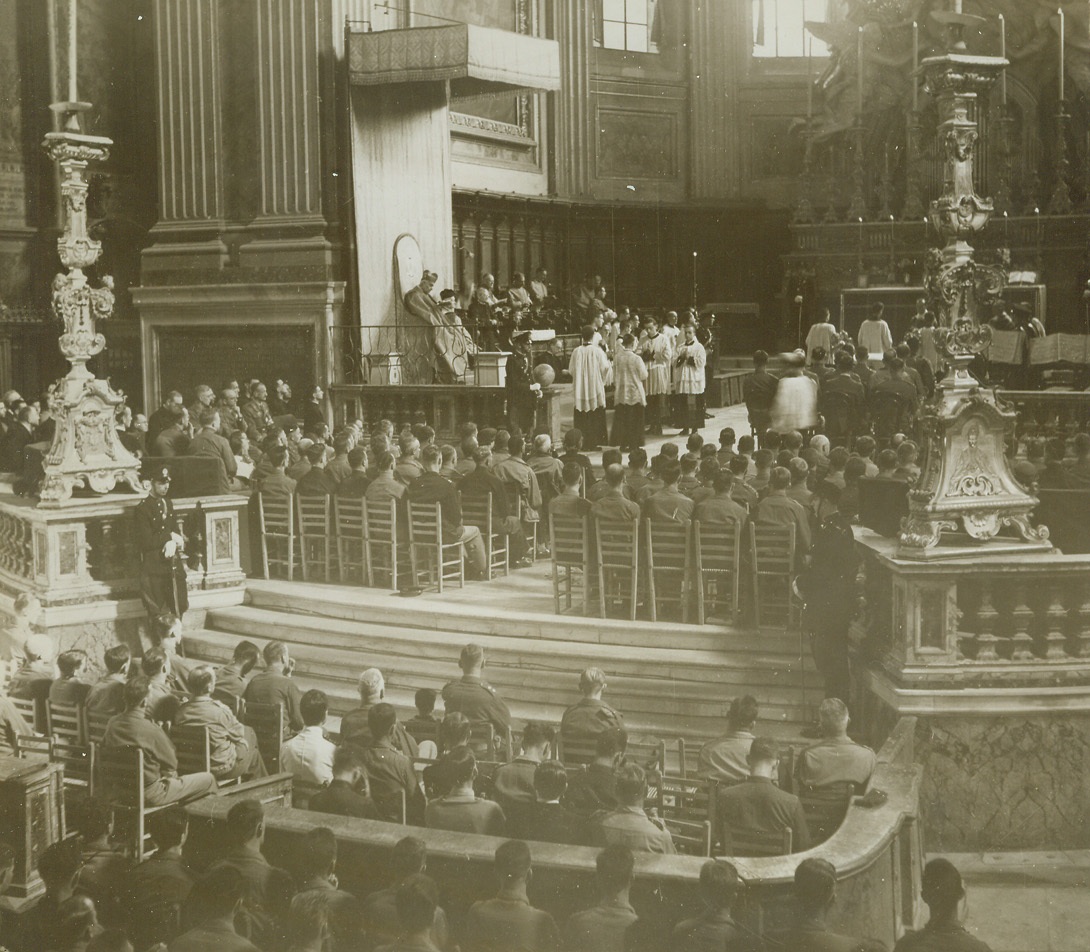
Offering Thanks for Deliverance of Naples, 12/27/1943. NAPLES, ITALY – The sanctuary in the Cathedral of Naples, October 17, when a solemn mass of thanksgiving for the deliverance of Naples was offered by Allied Chaplains of the Fifth Army. His Emminence, Alessio Cardinal Ascalesi, Archbishop of Naples, can be seen on the thrown at left in sanctuary. This is undoubtedly the most colorful ceremony that members of the Fifth Army will have occasion to attend in Naples. Credit (Photo by Charles Seawood, Acme Photographer for the War Pool;
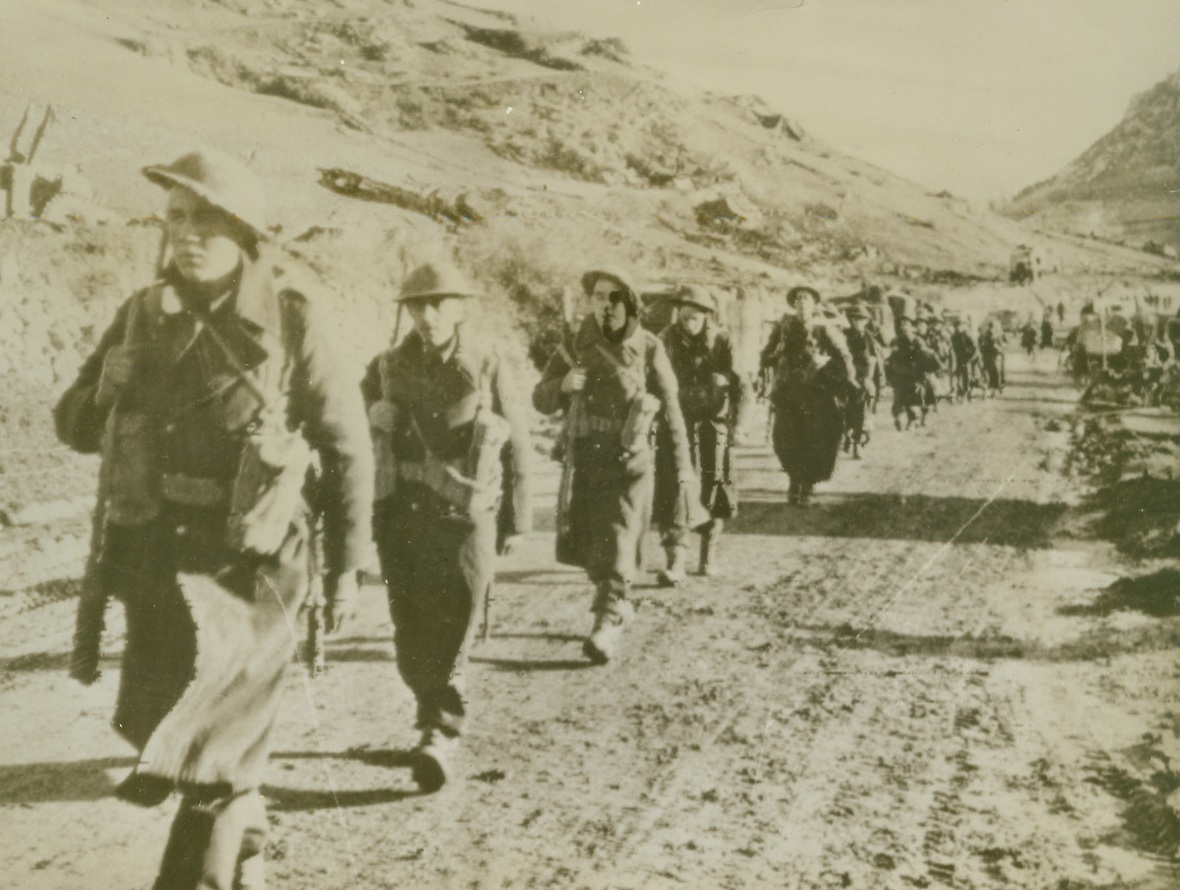
Tramping Through the Mountains, 12/2/1943. SOMEWHERE IN ITALY -- Moving up on the Italian front, a patrol of British infantrymen march on a mountain road north of Rionero. Photo radioed to New York today (Dec. 2nd) from Allied head quarters in Africa. Credit (British Army Photo via OWI from ACME);
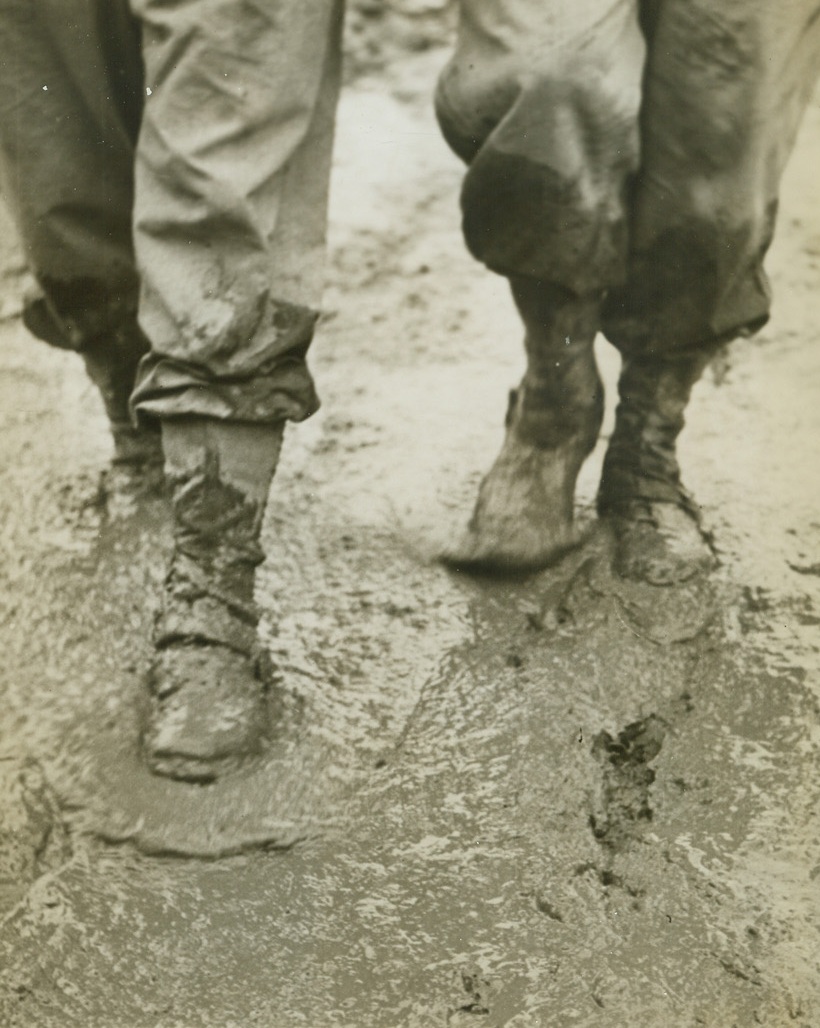
Shine Mister?, 12/2/1943. ITALY -- A pair of American GI boots slog along on "the road to Rome," where a careless step leads to a mud bath. A gooey mess is one way to describe the Fifth Army front near Venafro, and our offensive suffers. Credit (ACME Photo by Bert Brandt, War Pool Correspondent);
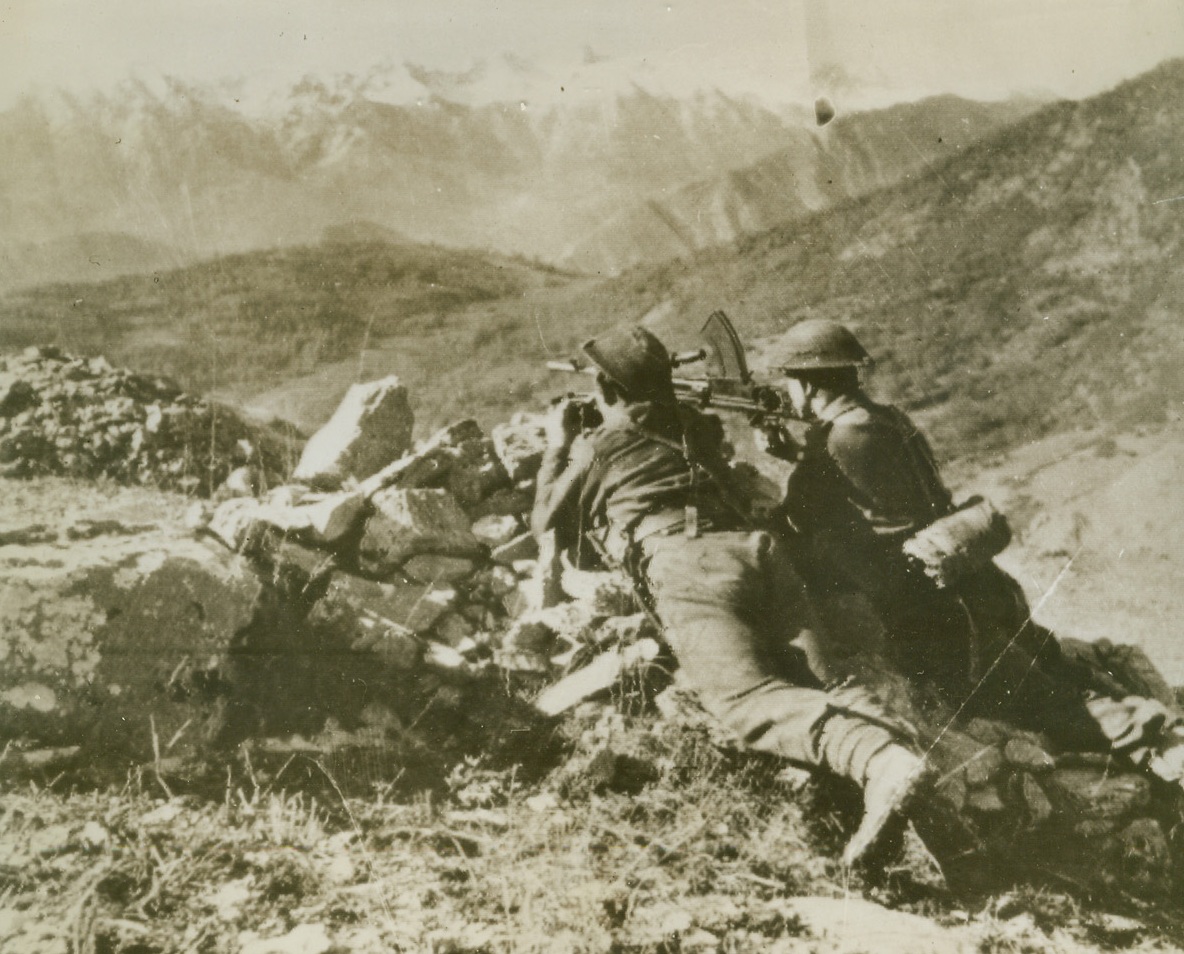
Alert Gunmen, 12/2/1943. SOMEWHERE IN ITALY -- Part of the Eighth Army's firing line on the Italian front, these British gunners lie flat on their bellies on a rocky knoll, keeping their eyes peeled for enemy action. Photo radioed to New York today (Dec. 2nd) from Algiers. Credit (British Army Photo Via OWI from Acme);
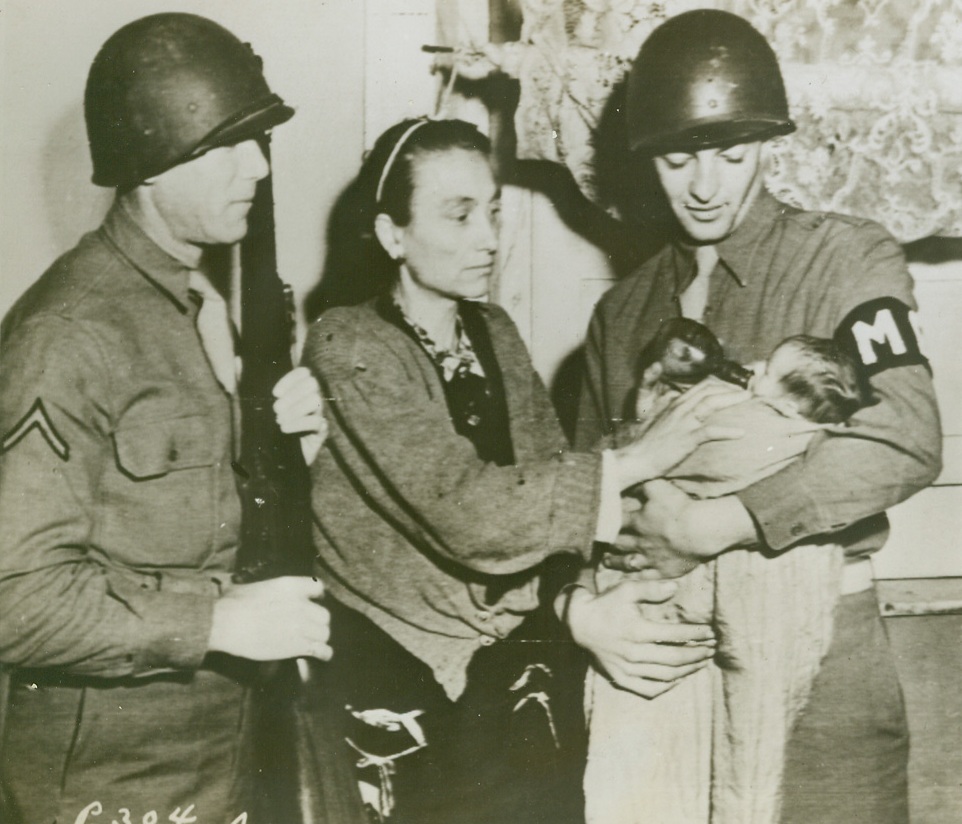
There's Nothing an MP Can't Do, 12/8/1943. ITALY -- Pfc Hyman Huberman, left, and Pfc Sidney Berchofsky, right, both of Brooklyn, N.Y., members of an MP battalion stationed in Italy, look on as this Italian mother feeds the baby they brought into the world in air-raid shelter in Naples. Credit Line (ACME);
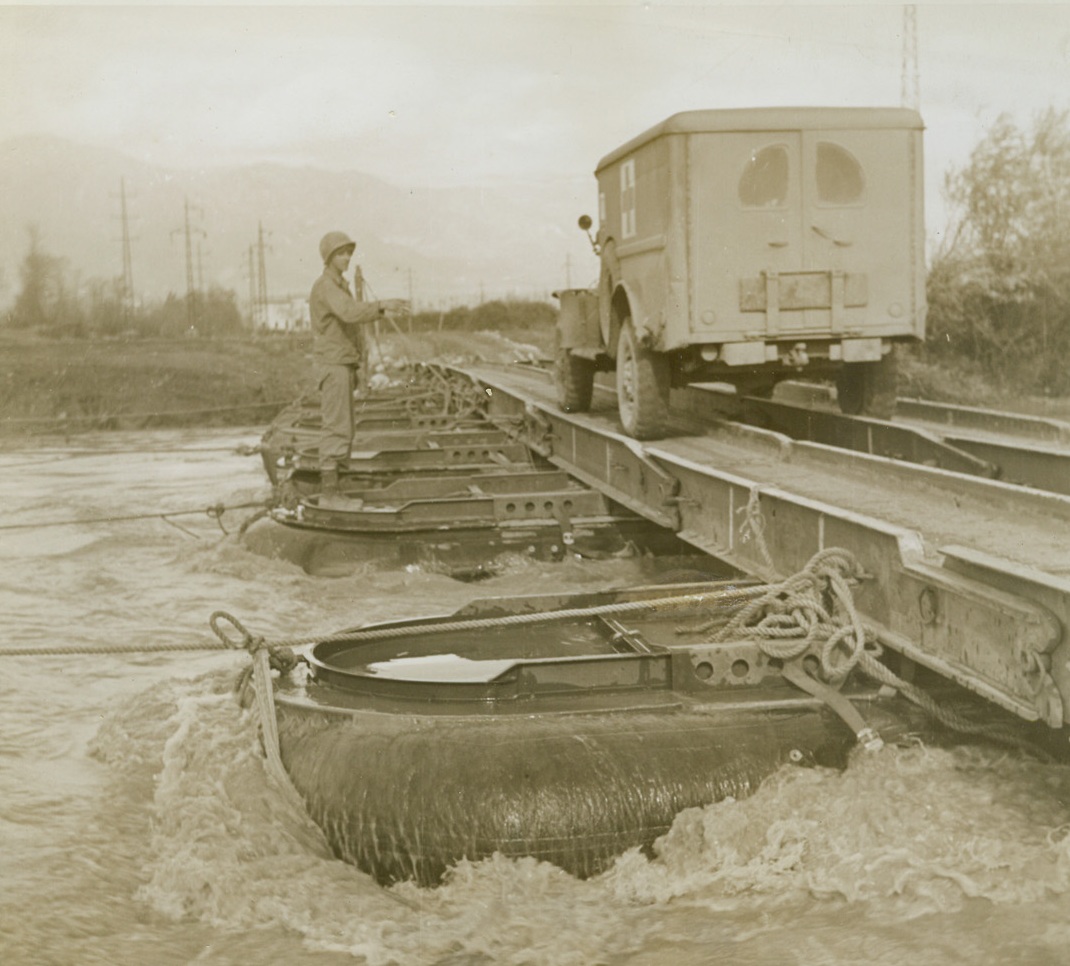
The Roaring Volturno, 12/8/1943. ITALY – High, rushing waters of the Volturno River, swollen by recent heavy rains, churn around pontoons of bridge set up by U.S. Army Engineers. Flood waters had wrecked a least one pontoon bridge. Pvt. Edwin Reidler, Reading, Pa., is giving the high sign to traffic. Note heavy ropes which keep pontoons in place. Credit Line – WP – (ACME);
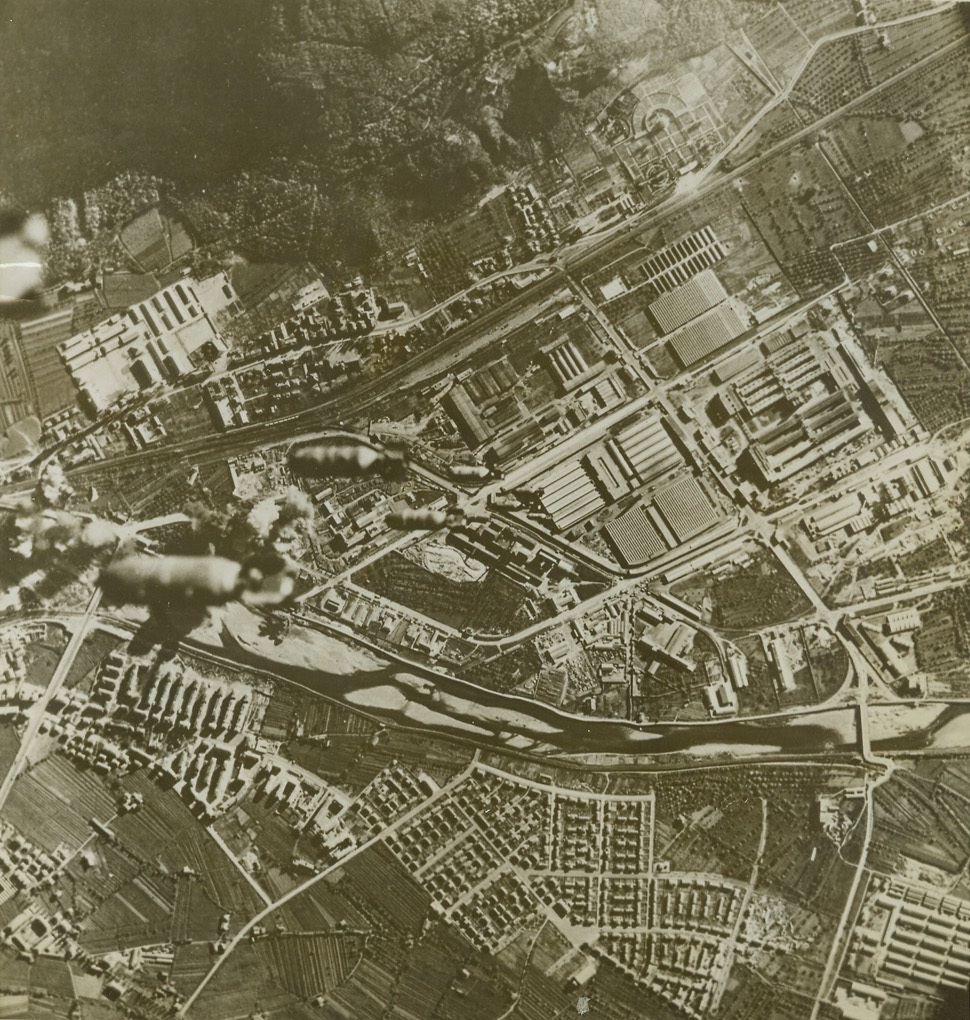
Bombs Fall on Northern Italy, 12/9/1943. Bombs, (lower center in photo), from Flying Fortresses of the U.S. Army Air Forces, fall toward the railway yards and bridges of Bolzano, Italy, during a recent raid on the city which is only 40 miles south of the famous Brenner Pass into Germany. Hits on transportation facilities impaired movement of troops and supplies from Germany to Italy. Credit: (U.S. Army Air Forces Photo from ACME);
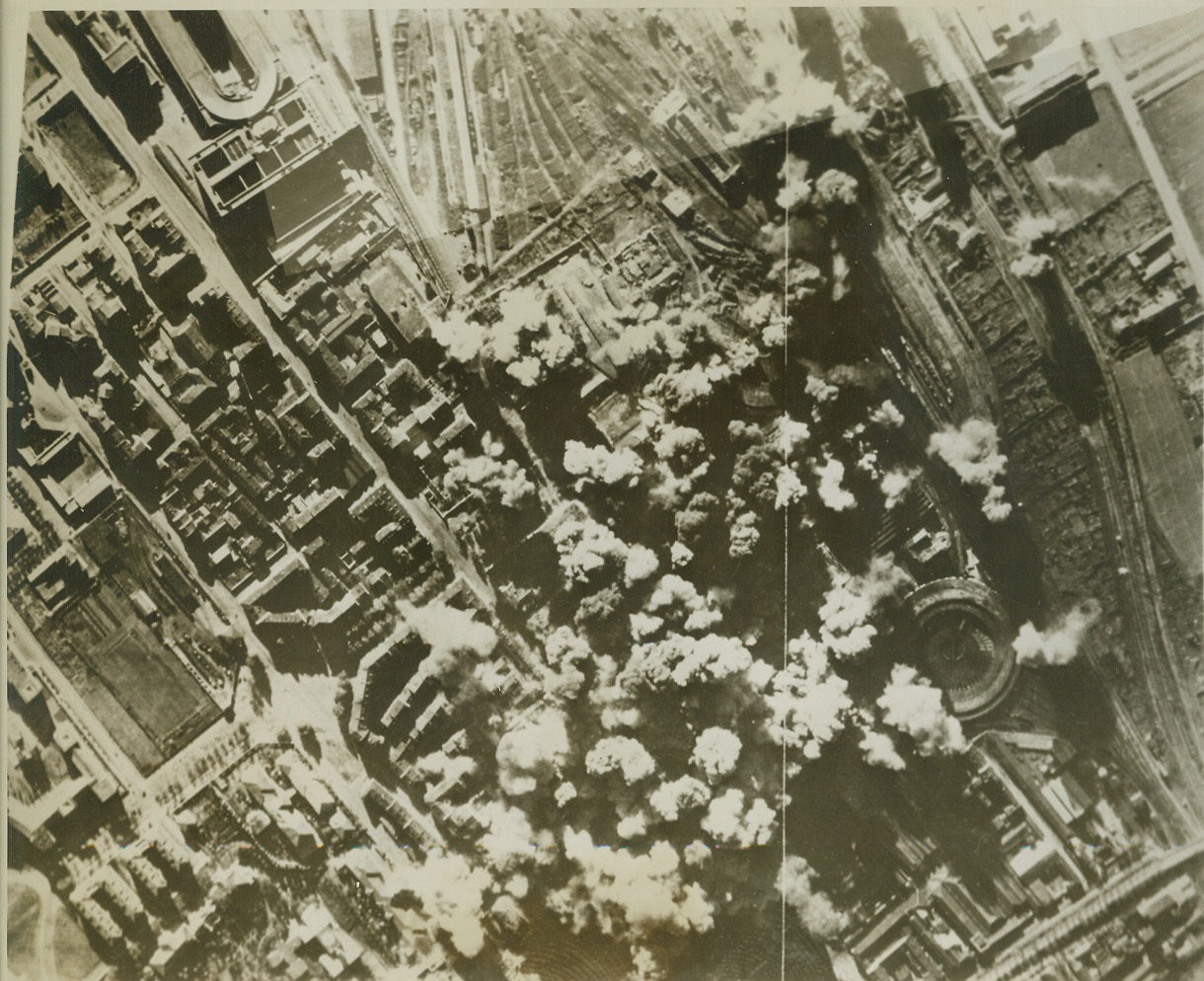
Another Crimp in Nazi Industry, 12/2/1943. This photo, just released in the United States, shows bombs from Flying Fortresses of the U.S. 15th Air Force, exploding on the important ball bearing plant and adjacent railway marshalling yard at Turin, Italy, during a raid last Nov. 8. This raid and the recent one on Schweinfurt, Germany, were aimed at cutting down the Reich's supply of ball bearings, so necessary in any form...(caption is torn)...warfare. Credit: (US Army Air Forces Photo from ACME);
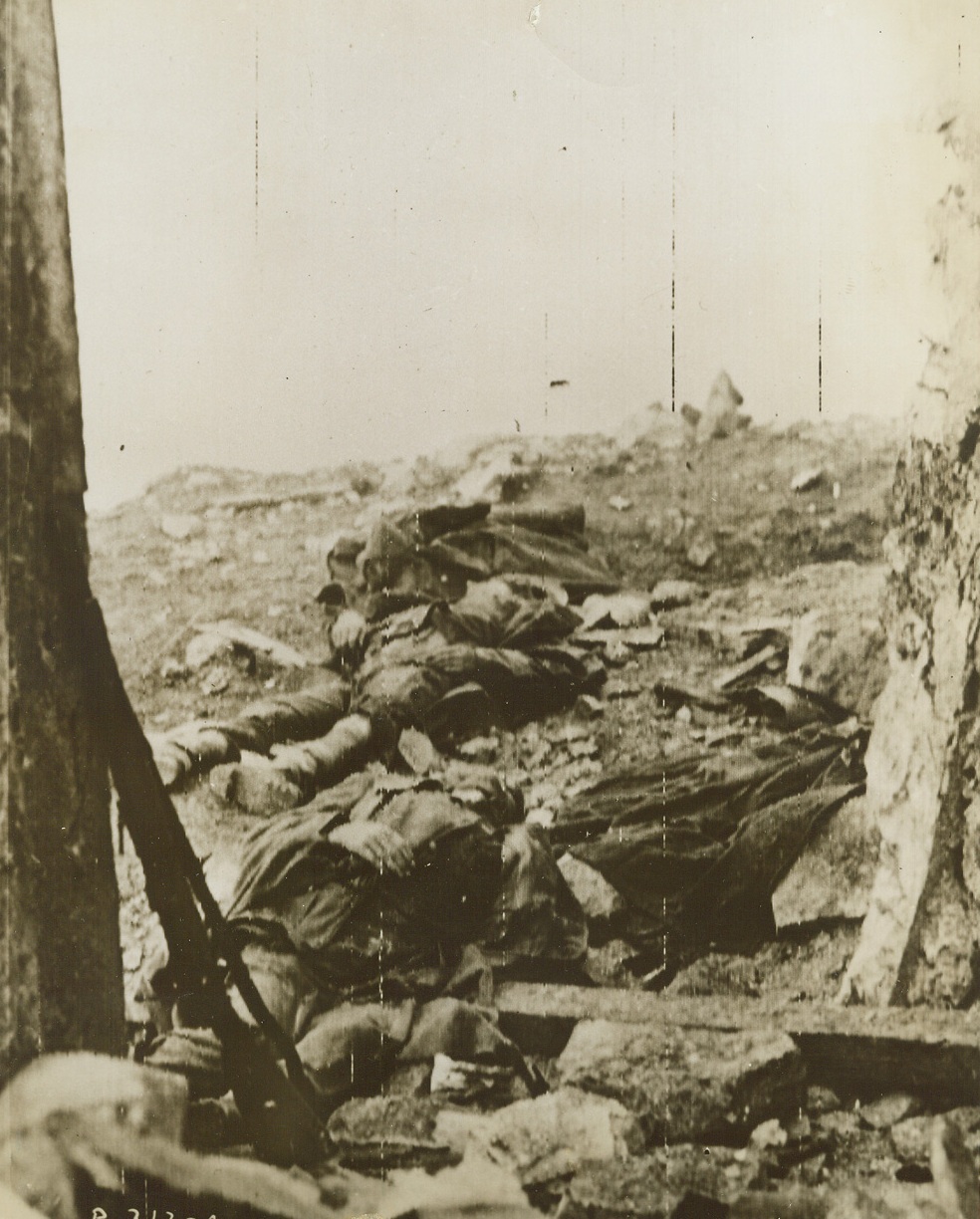
Death Plays No Favorites, 12/13/1943. ITALY – Death favors no side in this war. Dead British and German soldiers lay side by side before the jagged entrance to Monastery Hill, where in life they fought each other hand to hand, with ‘no quarter” hostilityCredit (Signal Corps Radiotelephoto from Acme);
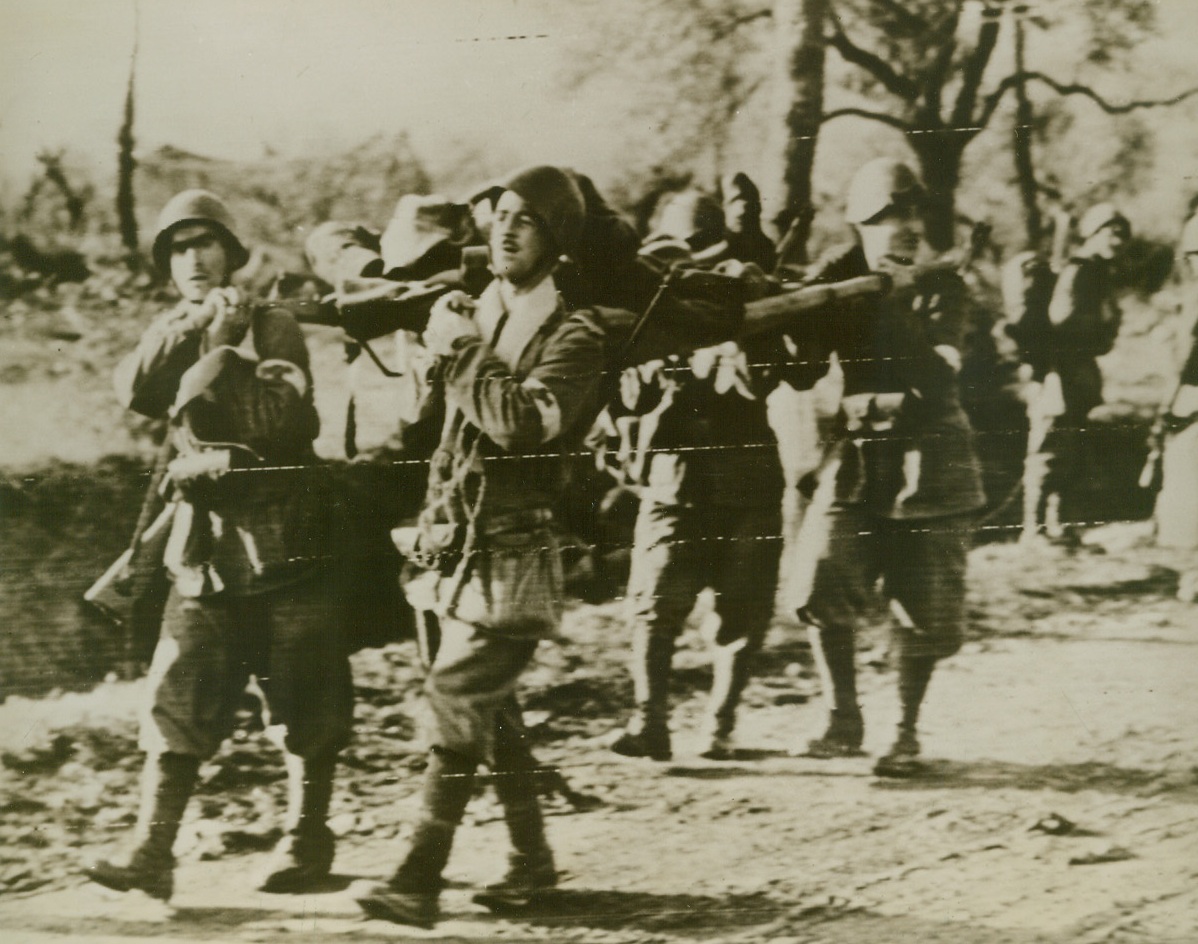
Wounded Italians Carried to Rear, 12/14/1943ITALY – Seriously wounded Italian soldier, injured in the first battle in which Italians went into action against their form Nazi allies, is carried to a rear dressing station by his comrades.Credit (Acme Photo by Sherman Montrose for the War Picture Pool, transmitted to the U.S. by Signal Corps Radiotelephoto);
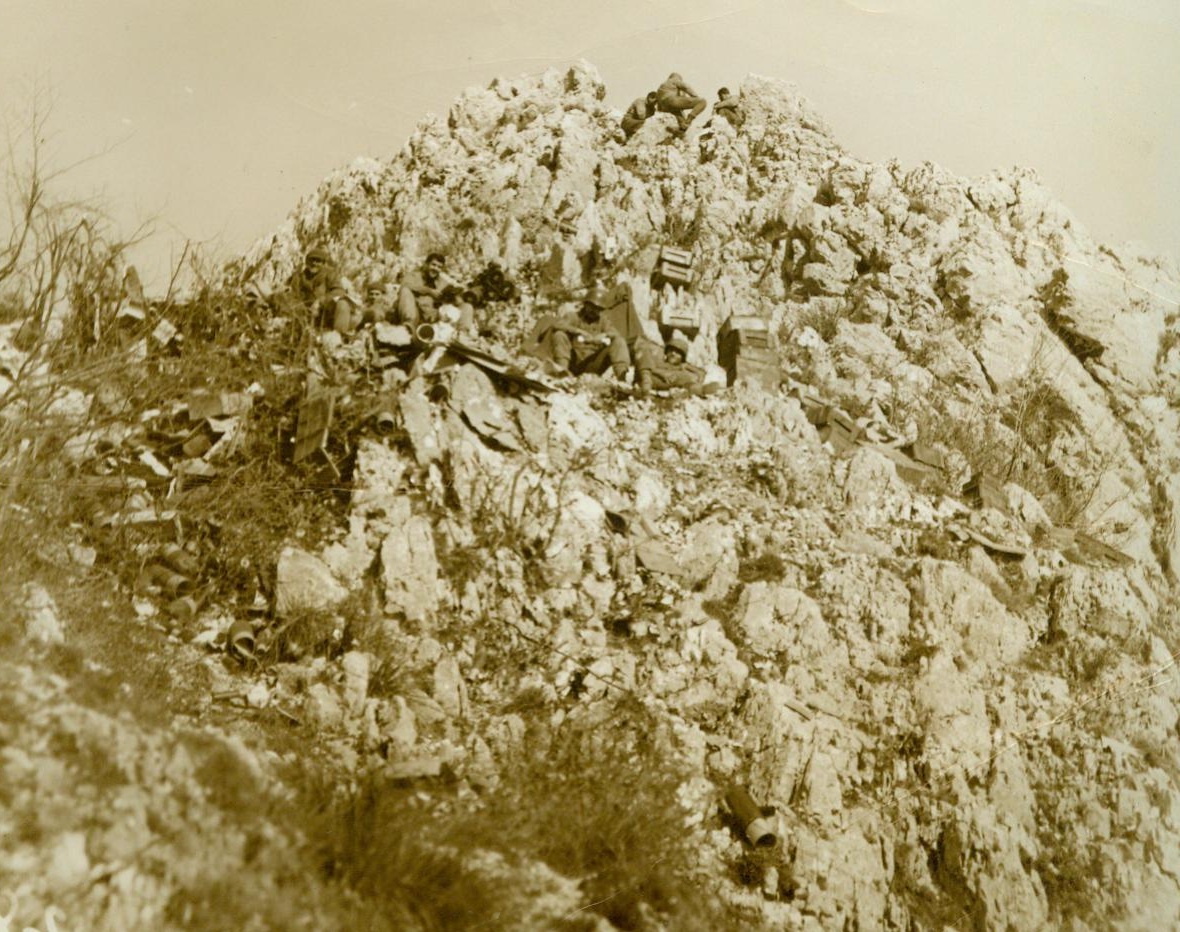
Italian Battlefield, 12/23/1943. Venafro, Italy – Here’s a sample of the rough, rugged terrain over which American doughboys are fighting in Southern Italy as they march toward Rome. A few Yanks squat for a rest on the rocky spot – An outpost on Venafro Ridge – As their buddies climb over the top. Credit Line (Photo By Bert Brandt, ACME Photographer for War Picture Pool). 12/23/43;
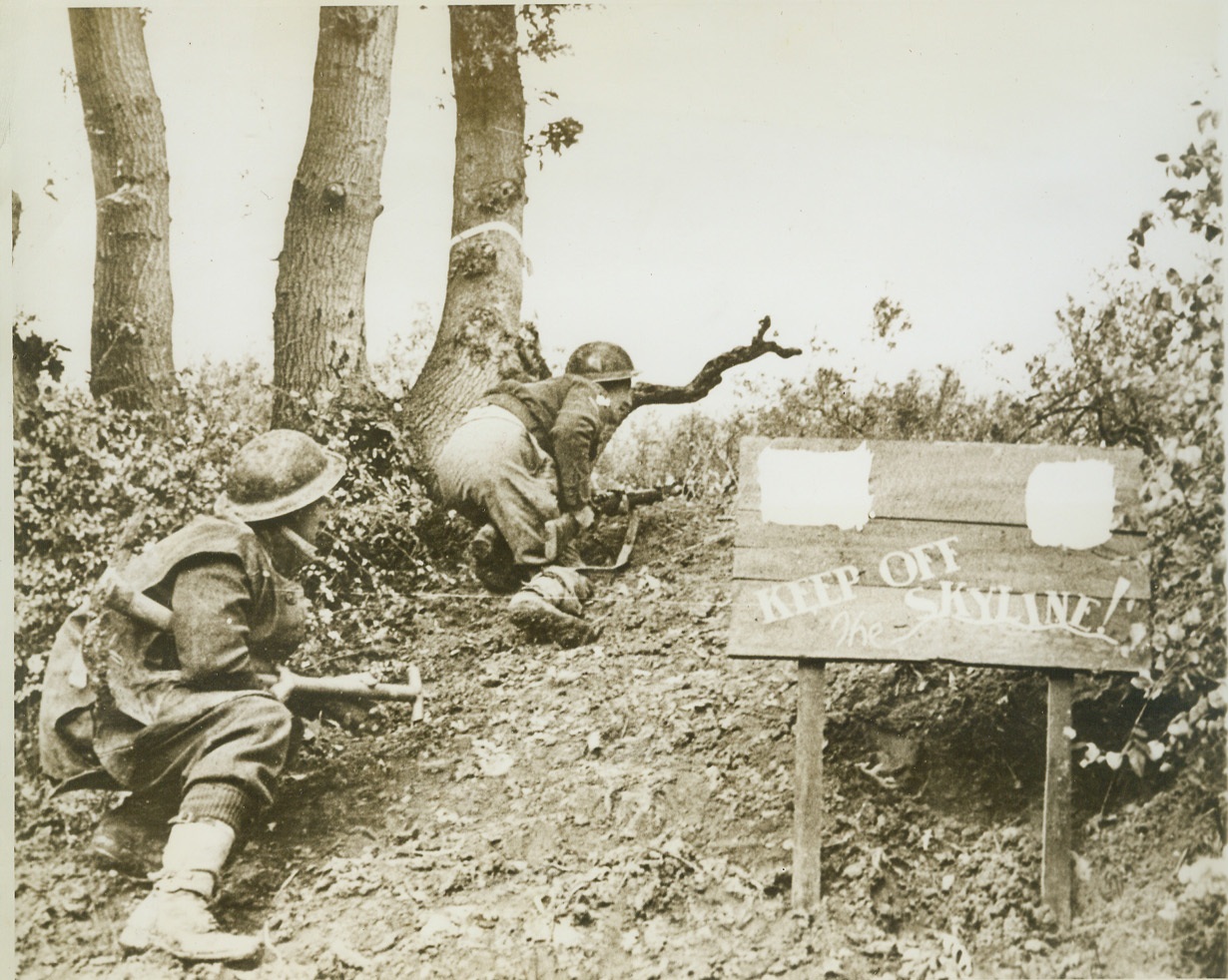
Don't Lose Your Head, 12/28/1943. ITALY -- If Allied soldiers forget to keep their heads about them mentally as they top this rise on the Sangro River firing line, they are apt to lose them physically. The "Keep off the Skyline" sign is religiously followed advice, and Gunner L.K. King, of London and Lance Bombardier T.R. Sleighholme, of Cumberland, two British 8th Army fighters, duck low to avoid Nazi shells. Credit: (ACME);
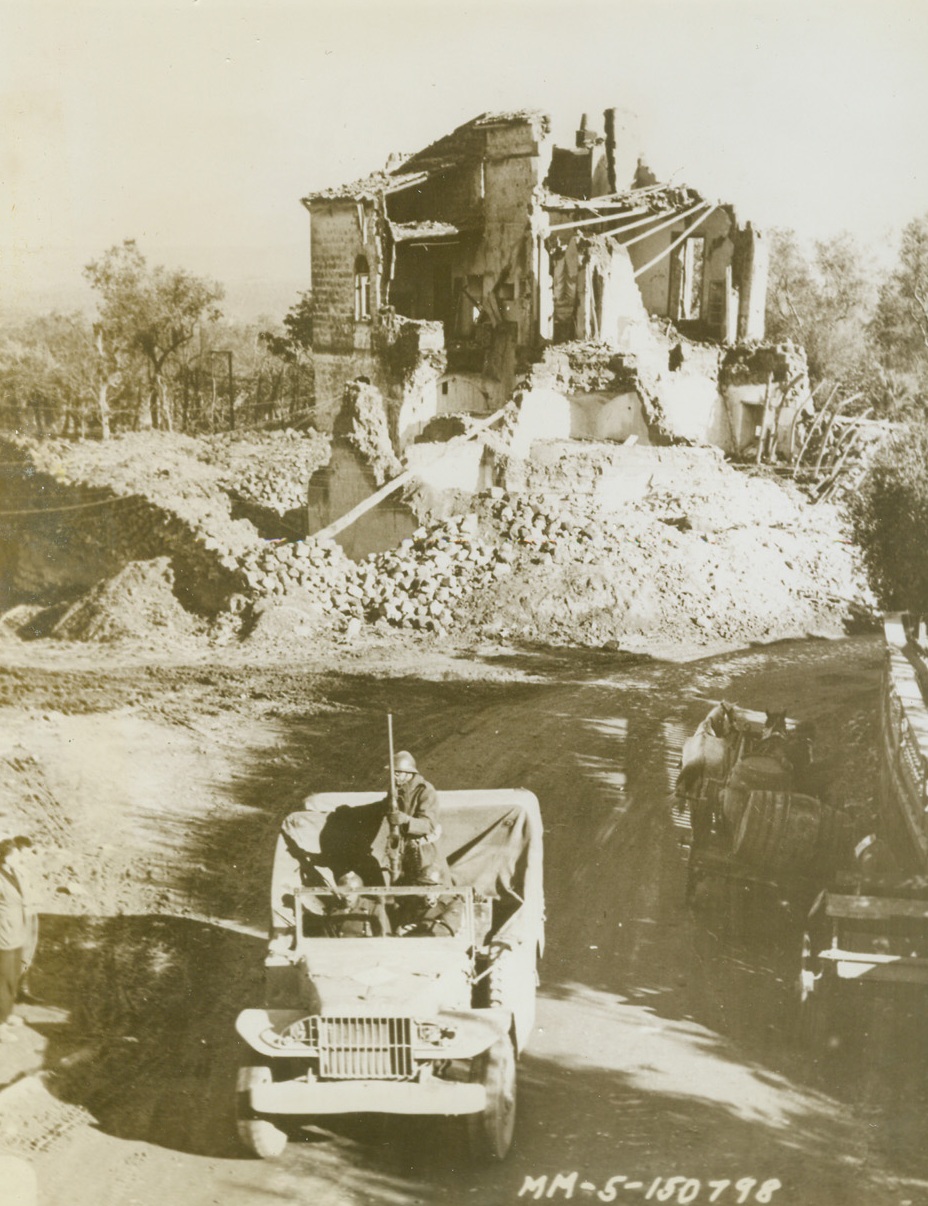
FREE FRENCH FIGHT AGAIN, 12/18/1943. SOMEWHERE IN ITALY—Rolling past the shattered wreck that was once a house, free French warriors of the Second Morocco Division speed through a war-torn Italian town on their way to the front lines. The Frenchmen are fighting, again, in Europe, for the first time since the capitulation of France in 1940, equipped with modern American weapons and clothing.;
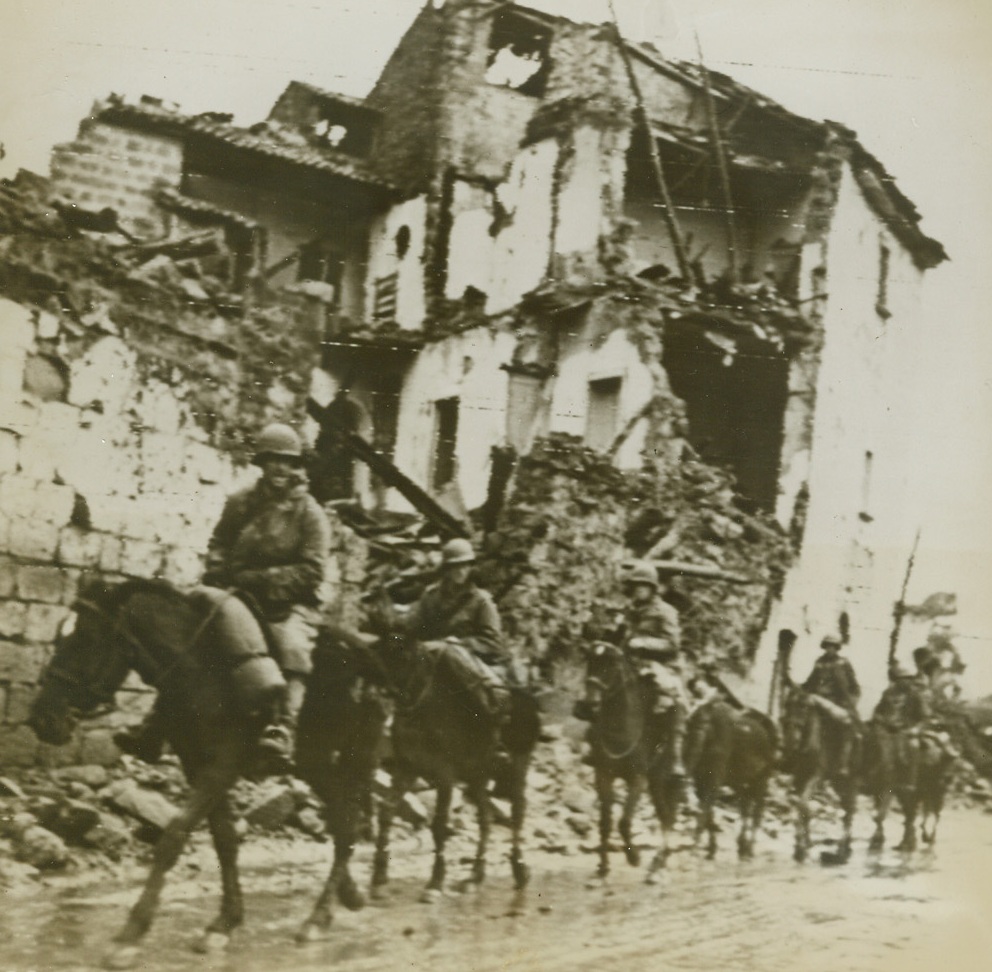
WHERE THE RAIN REIGNS, 12/22/1943. ITALY—In Italy, where the biggest enemy is bad weather, a soggy unit of U.S. cavalry rides past a shell-torn building on the Italian front. Allies have been borrowing Italian horses for reconnaissance missions over narrow, slippery lanes impassable to mechanized vehicles. Credit: Acme photo by Bert Brandt, for the War Pool via Army radiotelephoto;
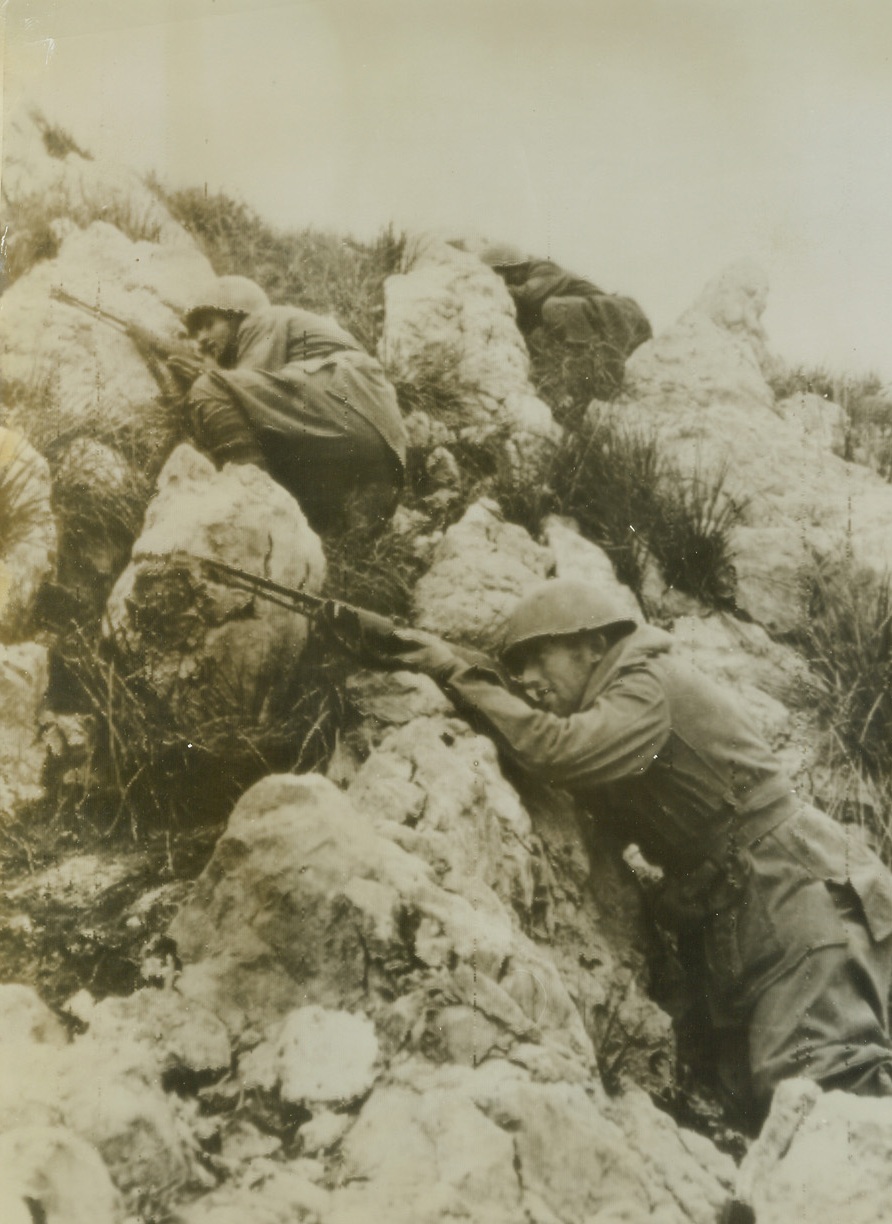
ITALIAN INFANTRYMEN, 12/17/1943. MONT LUNGO, ITALY—Crouching in firing positions behind the rocks that dot Mount Lungo, these Italian infantrymen are battling the Axis, fighting side by side with Americans and Britons of the Fifth Army. Photo radioed to New York today (Dec. 17th) from Algiers. Credit: Acme radiophoto;
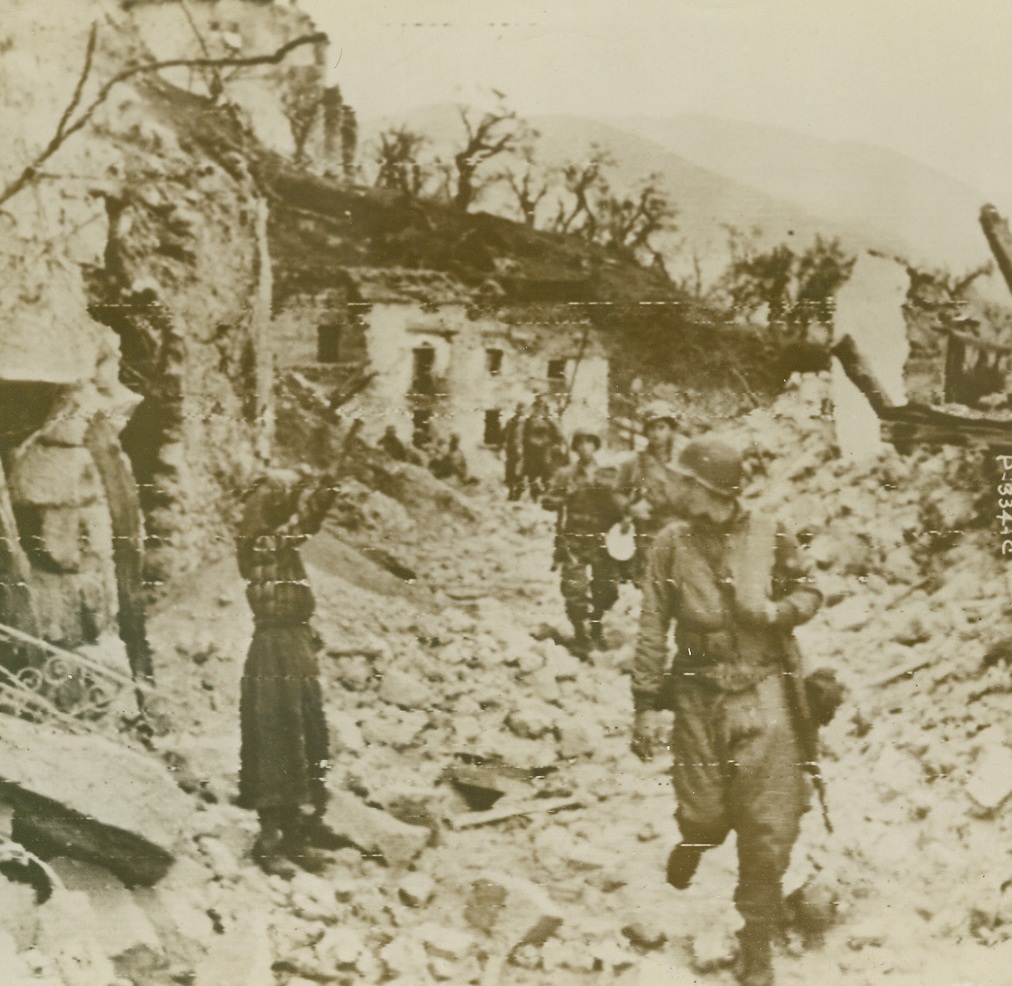
HAIL THE CONQUERORS!!!, 12/21/1943. SAN PIETRO, ITALY—Advancing Yanks receive first greeting from a native woman standing amid a debris-covered street outside her cellar shelter as they enter San Pietro. Credit: Signal Corps radiotelephoto from Acme;
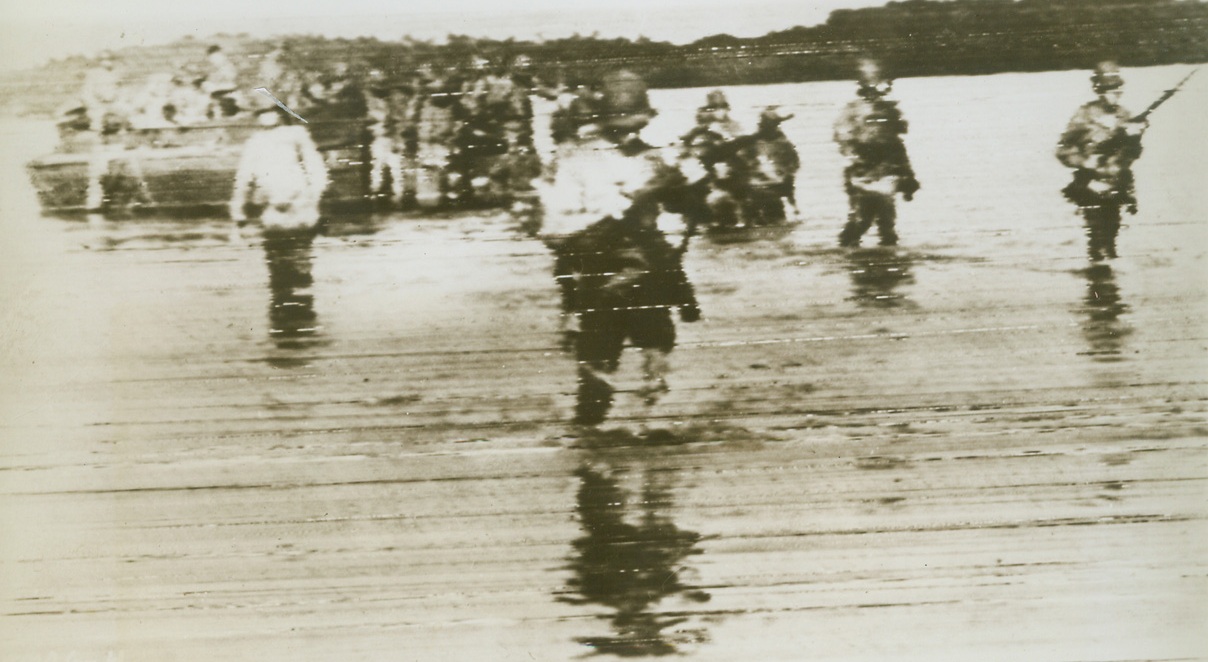
INVADERS WADE ASHORE, 12/18/1943. ARAWE, NEW BRITAIN—Streaming from their landing barge, American troops wade through the shallow waters off the shore of Arawe to complete the Allied invasion of New Britain. Although the invaders were bombed and strafed by the enemy as t hey landed, casualties were extremely light. Credit: Photo by Tom Shafer, Acme photographer for War Picture Pool;
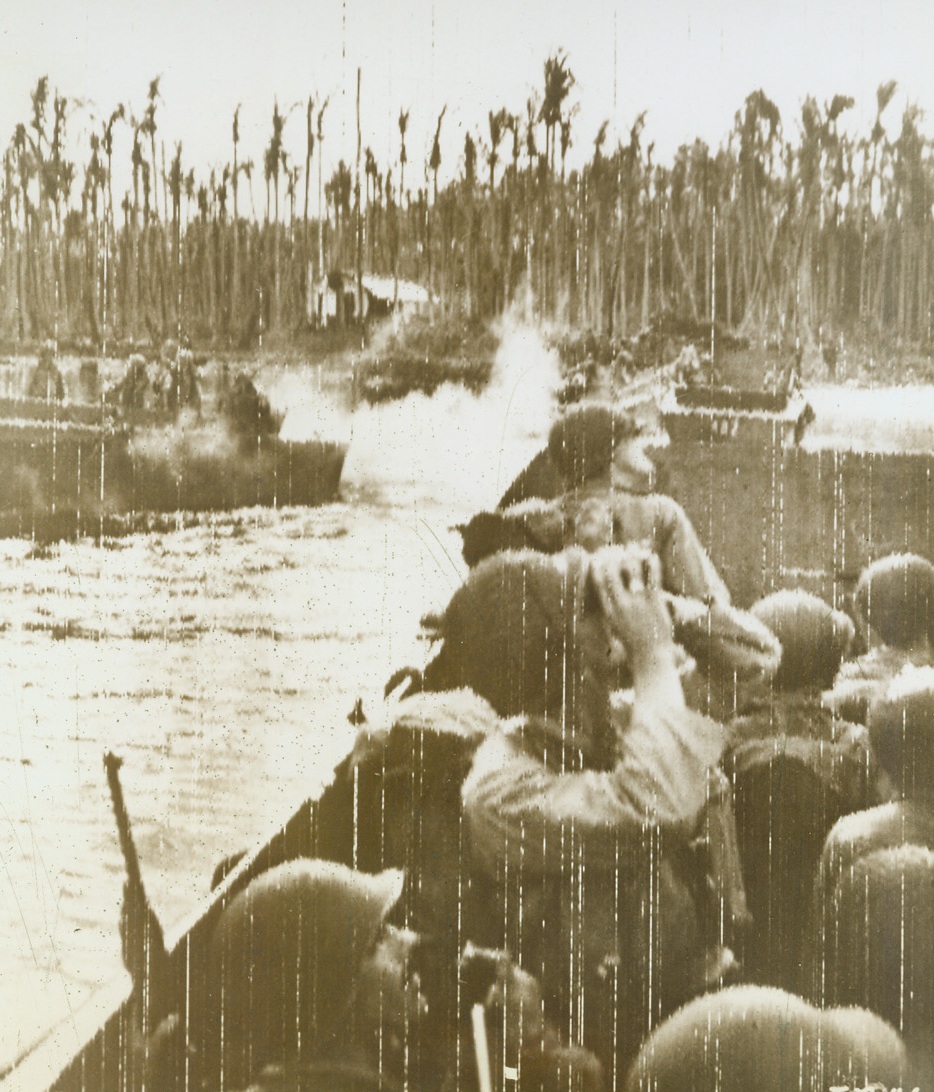
YANKS LAND ON NEW BRITAIN, 12/18/1943. ARAWE, NEW BRITAIN—As their LCV skims over Pacific waters toward the shore of Arawe, Yanks anxiously scan the skies, watching the approach of enemy planes. Invading New Britain under heavy bombing and staffing from Japanese planes, our troops escaped with light casualties, losing only two LCV’s in the important operation. Credit: U.S. Signal Corps radio from Acme;
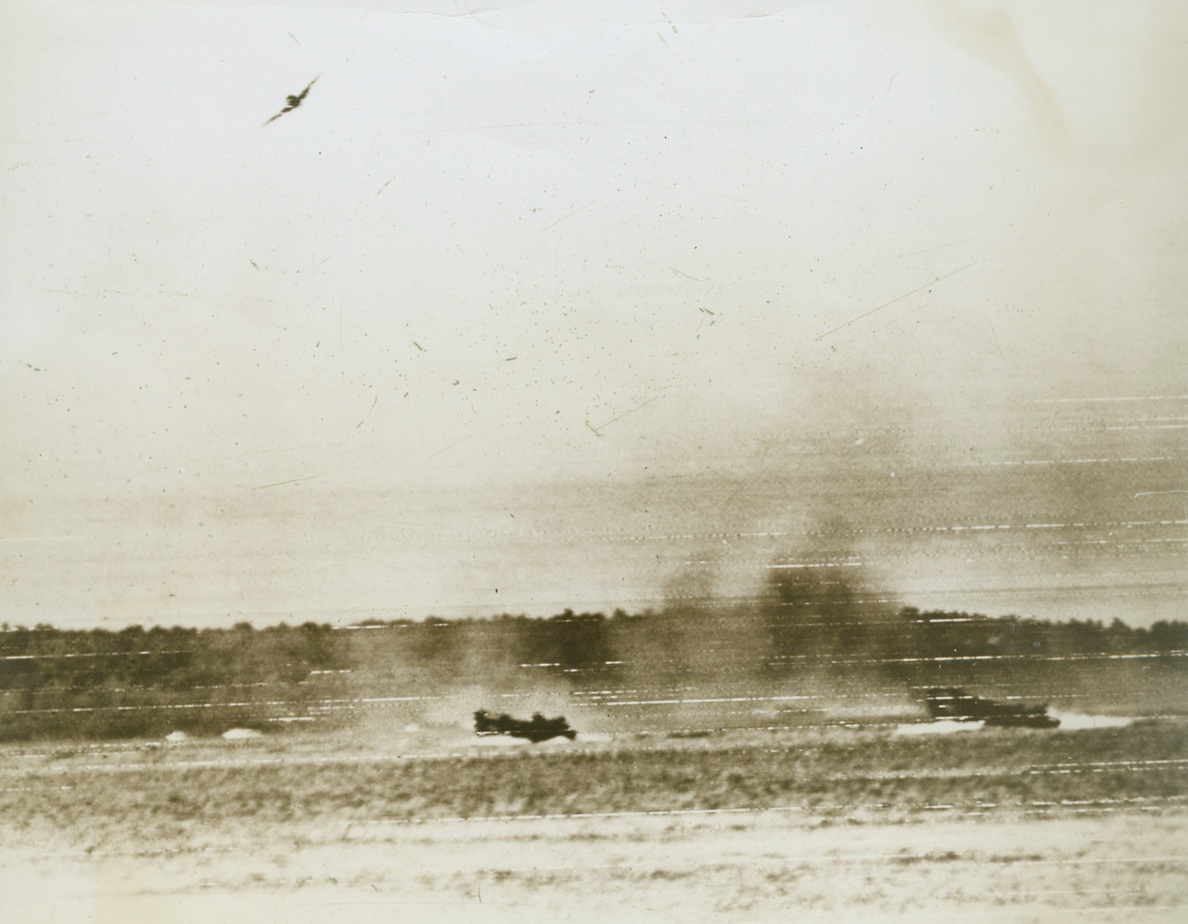
JAP PLANES COULDN’T STOP ‘EM, 12/18/1943. ARAWE, NEW BRITAIN—Winging through New Britain skies, a Jap plane pulls out of its bombing and strafing dive on American invasion craft, heading for the shores of New Britain. The enemy tried, in vain, to halt the advance of our troops, who escaped with the loss of only two LCV’s when they landed at Arawe. Credit: U.S. Signal Corps radiotelephoto from Acme;
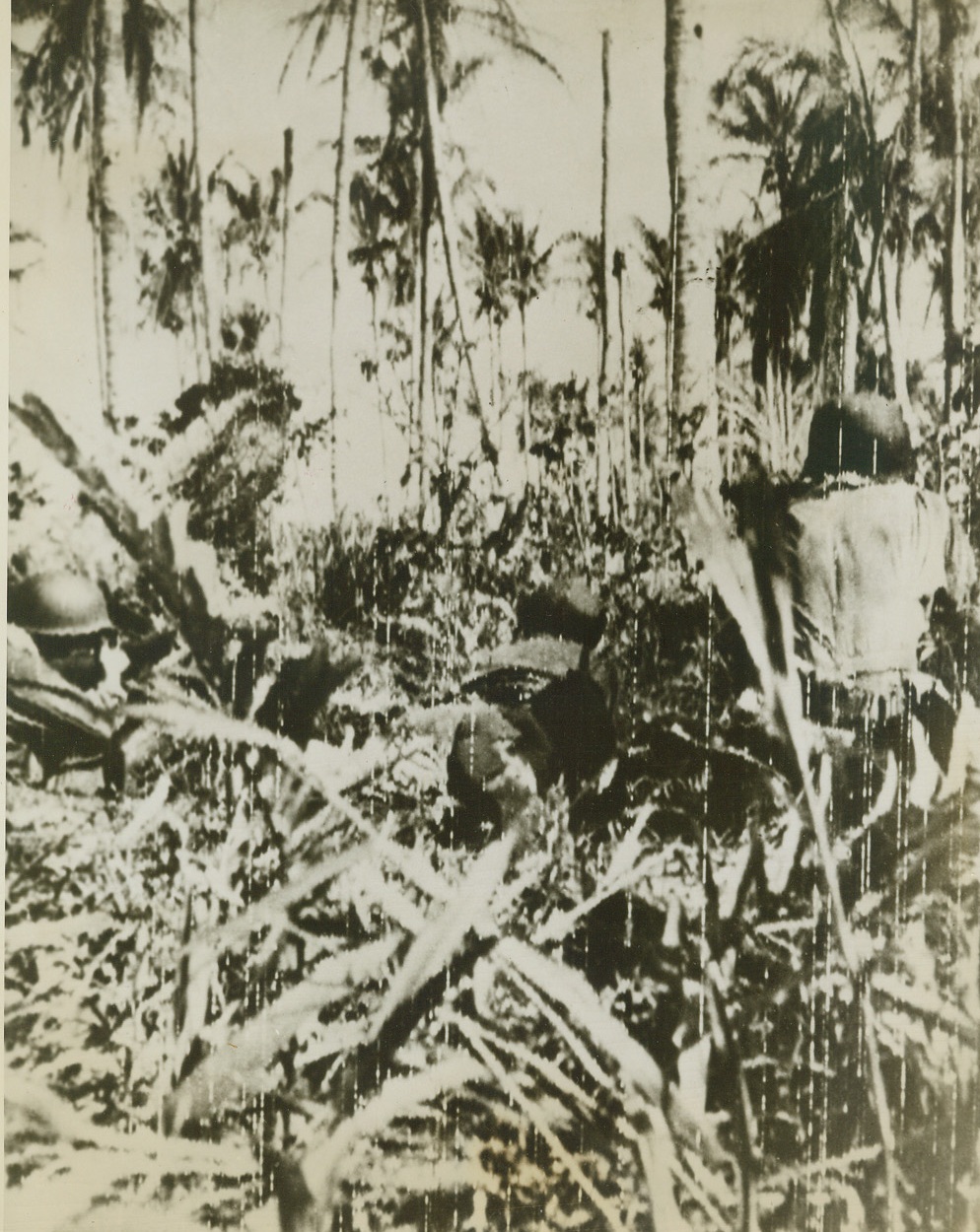
JUNGLE ADVANCE, 12/18/1943. NEW BRITAIN ISLAND—Their eyes glued to their sun sights, trigger fingers ready to go into action at a moment’s notice, these Yanks move stealthily through the thick foliage that covers New Britain Island. Taking all precautions to protect themselves as well as other troops, the American boys advance soon after their landing at Arawe. Credit: U.S. Signal Corps radiotelephoto from Acme;
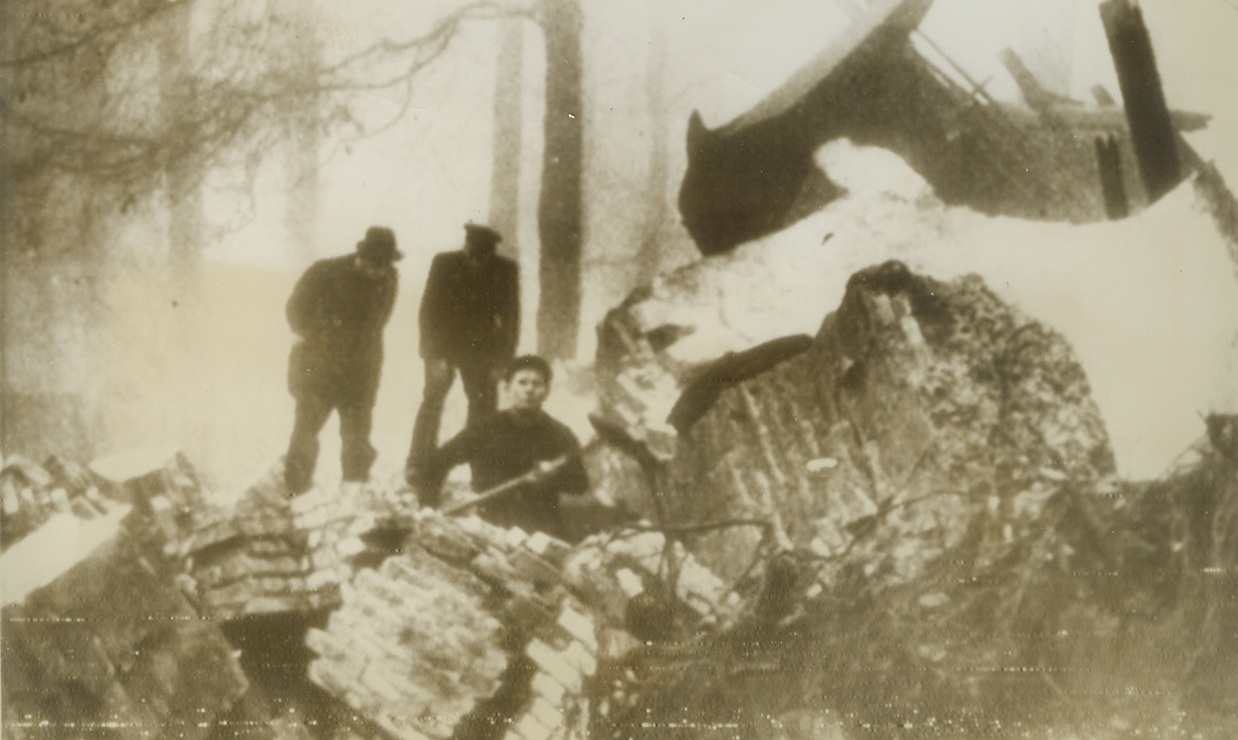
THOROUGH SABOTAGE, 12/20/1943. COPENHAGEN—Here is one of the very few pictures showing sabotage in occupied territory that has been permitted to go through Nazi censorship to Sweden. Workmen are clearing away ruins on a Copenhagen water tower that was blown up by saboteurs on Wednesday at 4 AM. They seem to have done a very thorough job. Photo radioed from Stockholm today. Credit Line (ACME Radiophoto);
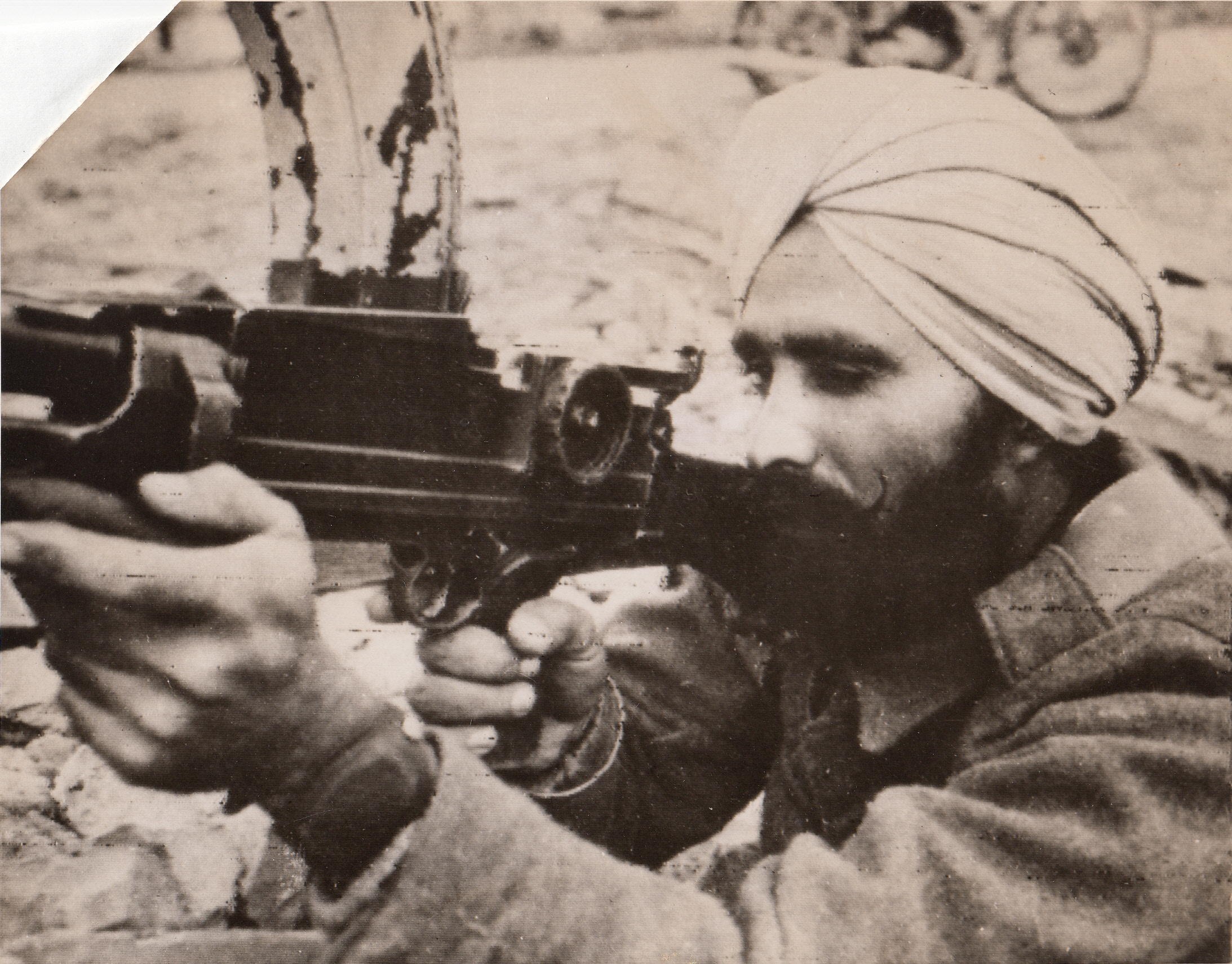
NO “TIN HAT” FOR THIS SOLDIER, 12/20/1943. ITALY—Cpl. Chain Singh (CQ), a Sikh Bren Gunner in action on the British 8th Army Front, wears no helmet but only his customary turban. The Sikhs are the only soldiers of India fighting with the Allies, who are permitted to dispense with steel head covering.;
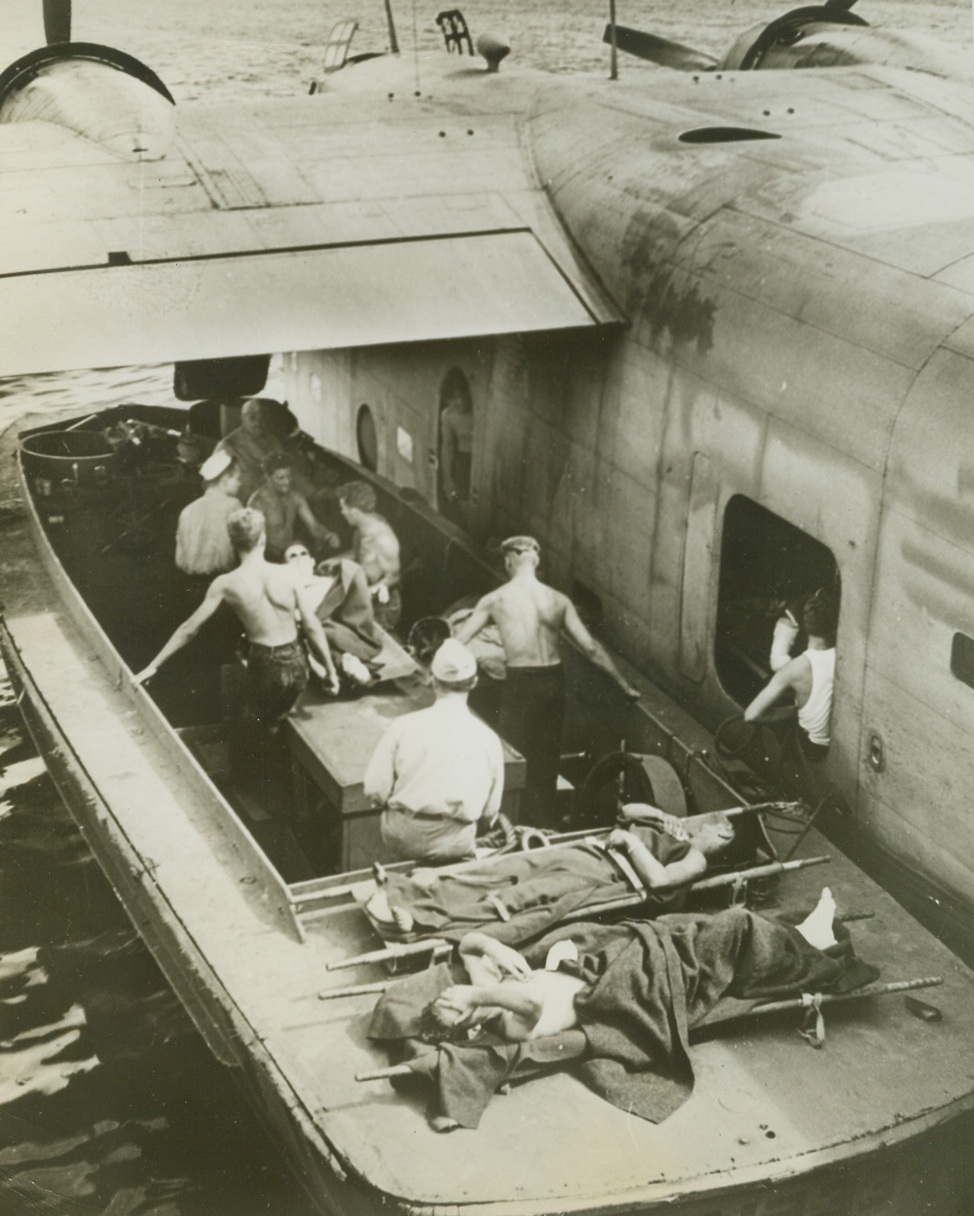
Back from Makin, 12/31/1943. Just off Makin Island, U.S. Coast Guardsmen carefully transfer wounded Marines from a landing barge to a Navy plane which will speed them to hospital bases located in safer territory. A first aid station was set aboard a Coast Guard transport which operated as a unit in the Navy Task Force. Credit: U.S. Coast Guard photo from ACME;
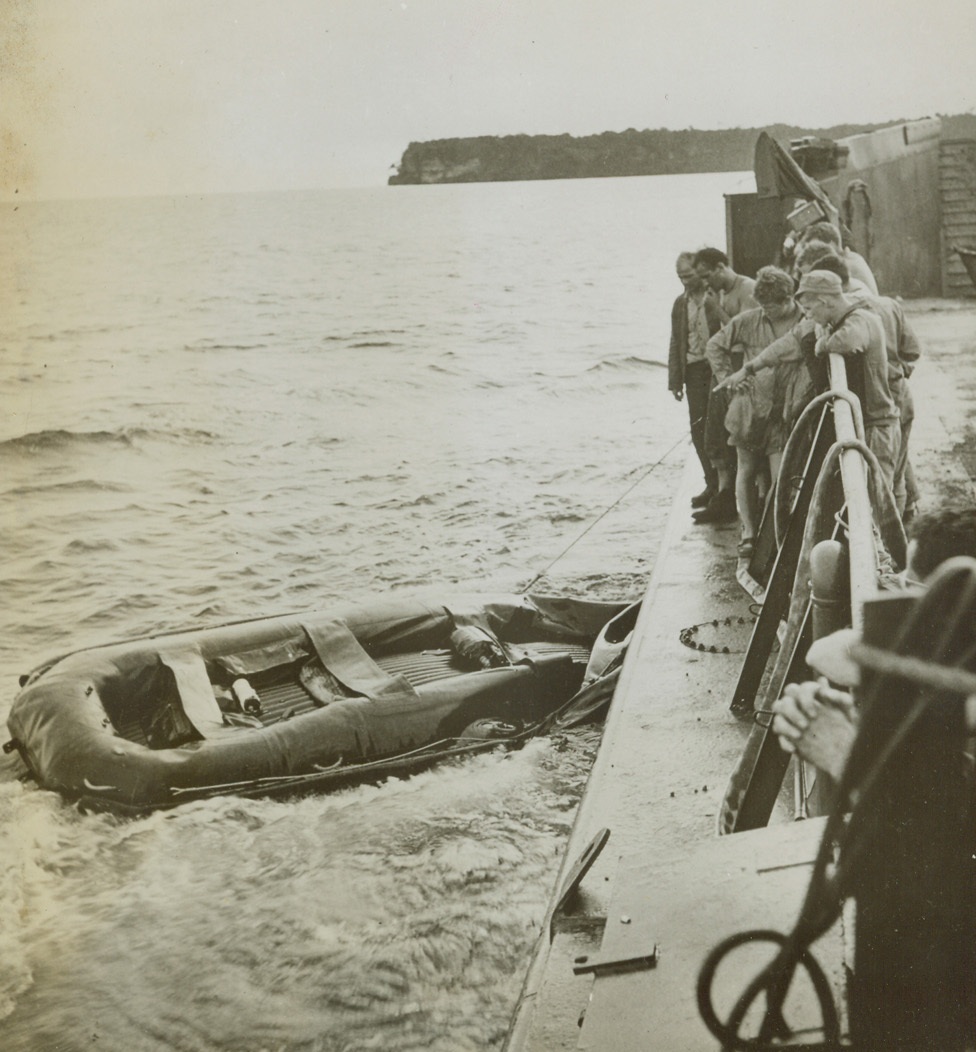
One of Few, 12/31/1943. Arawe, New Britain – One of the few rubber rafts left afloat after the landing at Arawe, New Britain, is pulled in by members of the crew of an LCT. Most of the rafts used in landing operations were sunk by Japanese machine gun fire. Credit: ACME;
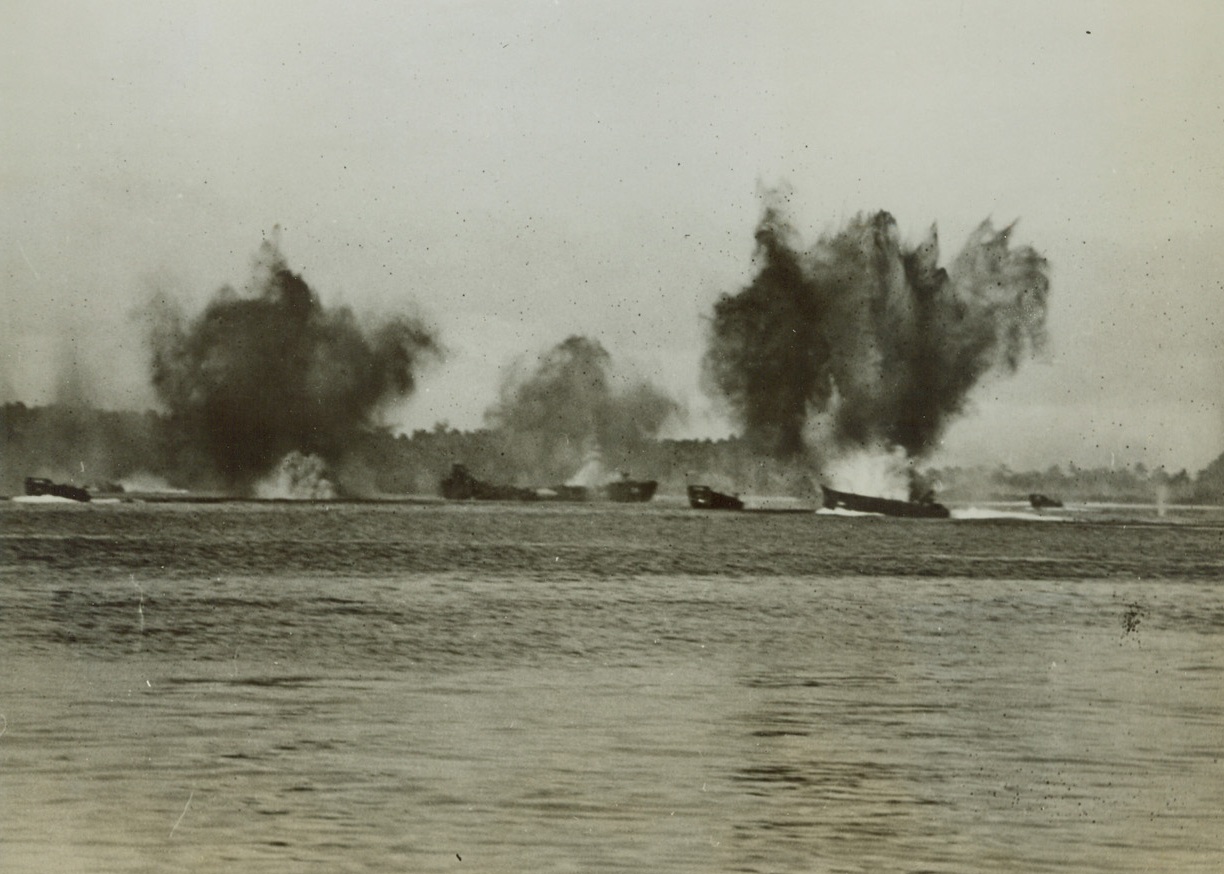
Japs Bomb Arawe Invaders, 12/31/1943. Arawe, New Britain – Great geysers of black smoke and spray rise from the water around a group of LCT’s as Japanese bombs rain down upon the invaders at Arawe, New Britain. Photo was made at the height of the Allied invasion on that Jap stronghold. Credit: ACME;
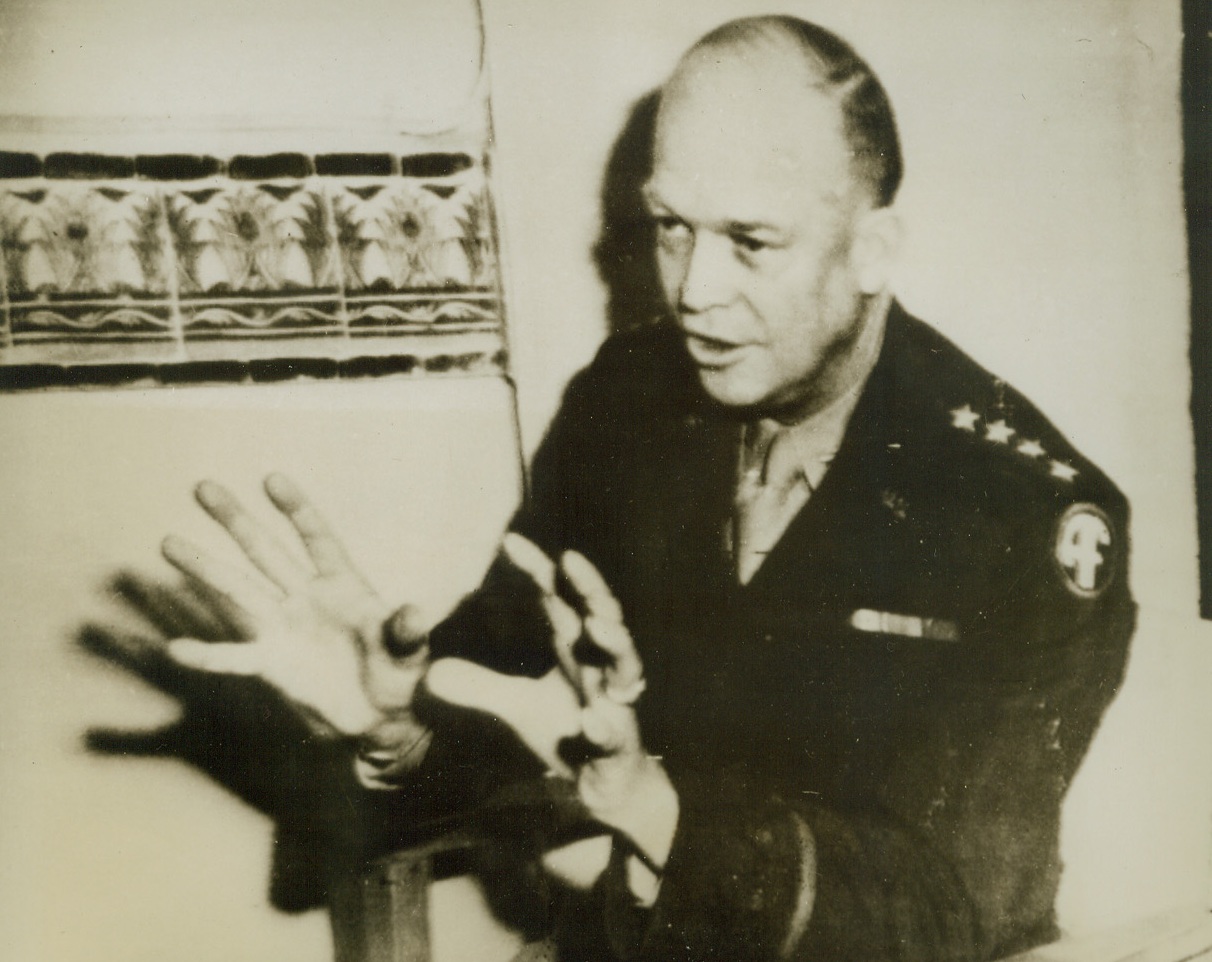
Forecasts Victory in 1944, 12/27/1943. Algiers – Gen. Dwight D. Eisenhower, recently named to command the main Allied invasion of Europe, is shown here in this photo flashed to New York by radio today, as he spoke before members of the Allied press at the Allied Forces Headquarters today. Gen. Eisenhower flatly predicted that “we will win the European war in 1944,” at the press conference. He indicated that he would soon leave Algiers for Britain to take over his new duties. Credit: OWI Radiophoto from ACME;
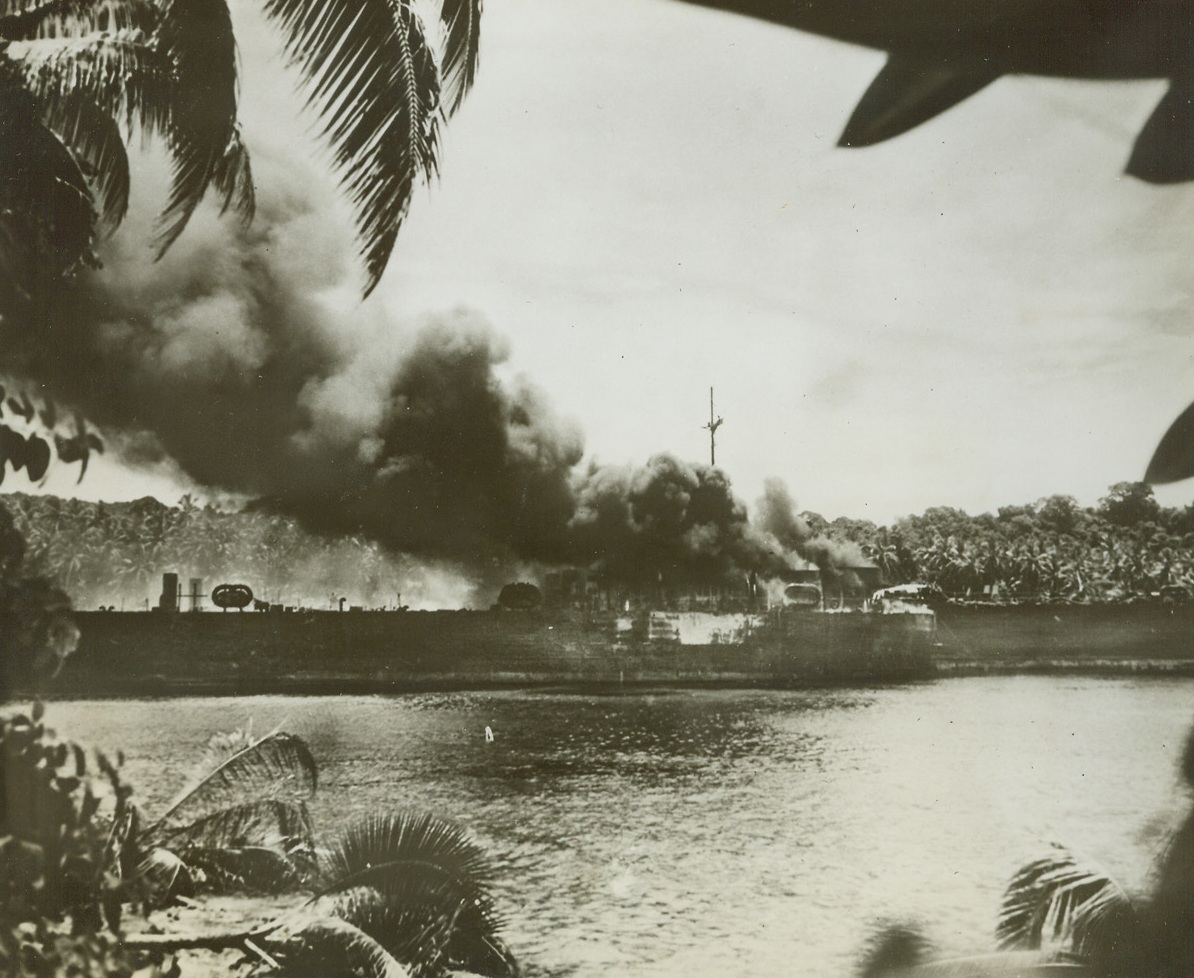
One for the Nips, 12/29/1943. South Pacific – Smoke pours from the blistered stern of an Allied LST (Landing Ship-Tanks), after a Japanese plane scored a hit during an attack on a South Pacific island in the combat zone where the LST was unloading its cargo. A sister ship (right background) stands by as its crew plays a stream of water on the burning vessel. Credit: U.S. Marines Corps photo from ACME;
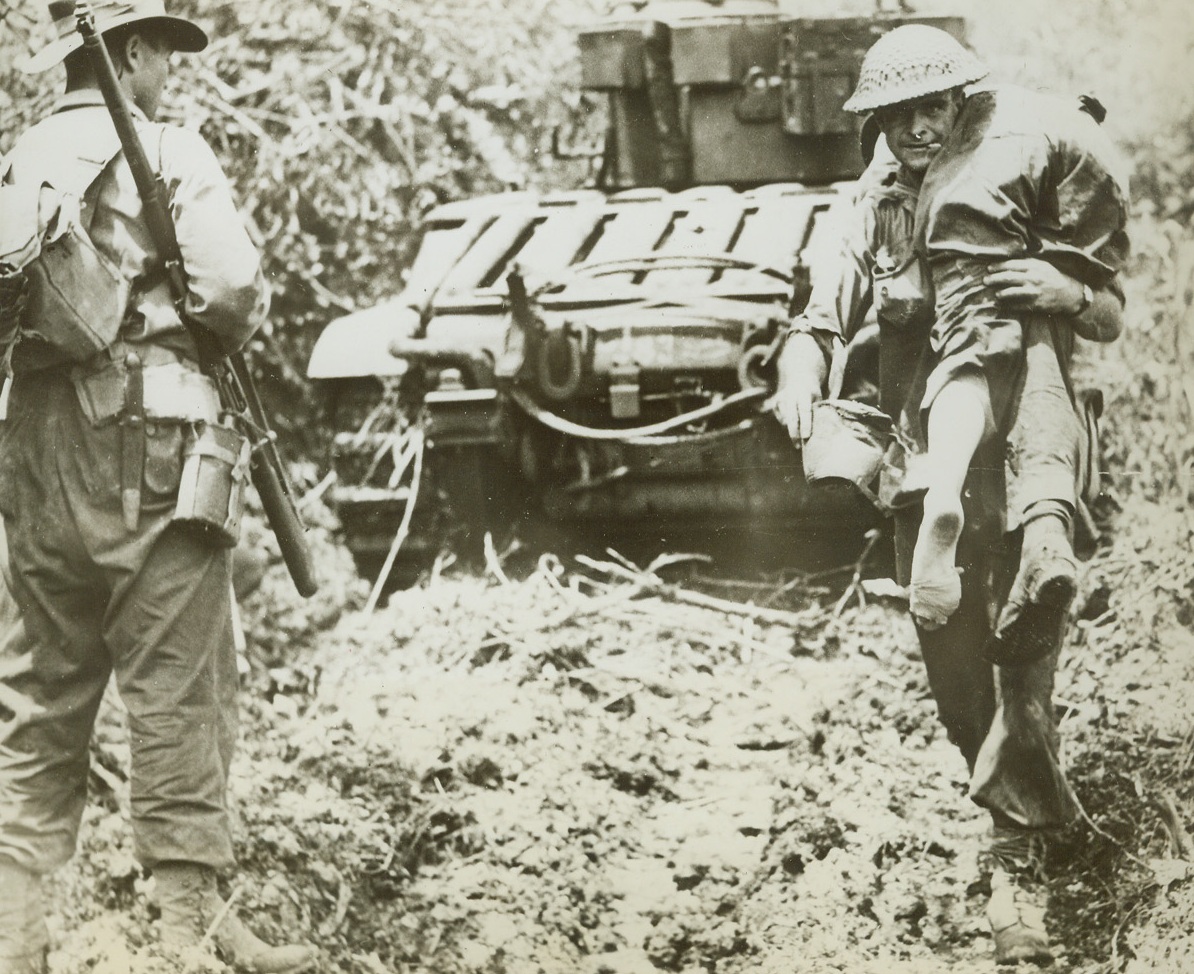
Wounded Aussie Comes Back, 12/29/1943. Satelberg, New Guinea – Slung over the shoulder of one of his buddies, a wounded Australian fighting man is carried back from the front lines. The rescuer passes a tank that continues in the attack on Satelberg. Credit: ACME;
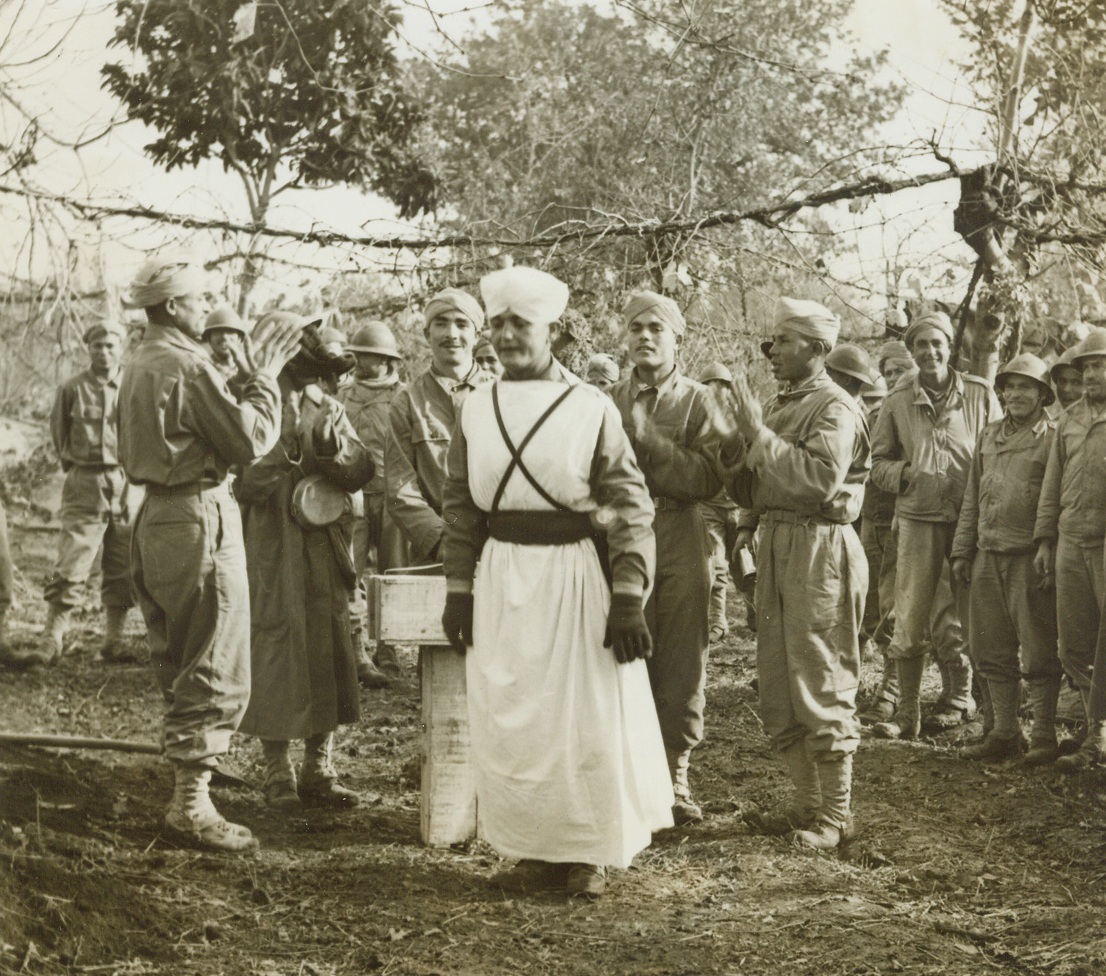
As Moroccans Prepared to Battle Germans, 12/28/1943. Italy – It has now been revealed that Mohammedan troops from French Morocco have entered the Allied Fifth Army lines and are actively engaging the Germans in the mountains northwest of Venafro, with excellent results. Before these troops moved into battle, and while they were encamped in the plains to the rear of the Fifth Army lines, the Mohammedan soldiers observed their Ait Kebir, or Great Feast, a solemn religious ceremony which marks the arrival of the new year (it is now the year 1364 on their calendar.) With preparations for ballet under way, uniforms were substituted for the usual colorful costumes, and the usually violent tribal dancing was dispensed with. Instead one of the solders performed a brief token dance. In Morocco it is the custom during the feast that every married man kill a sheep, which is then roasted whole and eaten with a sort of bread cake made of coarsely ground wheat and streamed above a caldron of boiling vegetable stew. In spite of wartime scarcity of the animals in Italy, the soldiers had plenty on hand for the feast, getting them in various mysterious ways about which officials were a bit vague when asked. In this series of photos, taken by Acme photographer Bert Brandt, various parts of the Ait Kebir are shown. (Passed by Censors). After the roast sheep and other food for the feast has been approved by the regiment’s officers, this token dance was performed. Here, (photo above) a soldier dressed in a bright costume of white belted in red, does a dance while the troops beat time on their mess kits with their knives. Another dancer, (not shown) is dressed in a sheep’s skin with a sheep head mask. After the dances, officers place money in the hats or mouth of dancers to show their appreciation, and the feast goes on, with everyone “digging in” to the food. Credit: Acme photo by Bert Brandt for the War Picture Po;
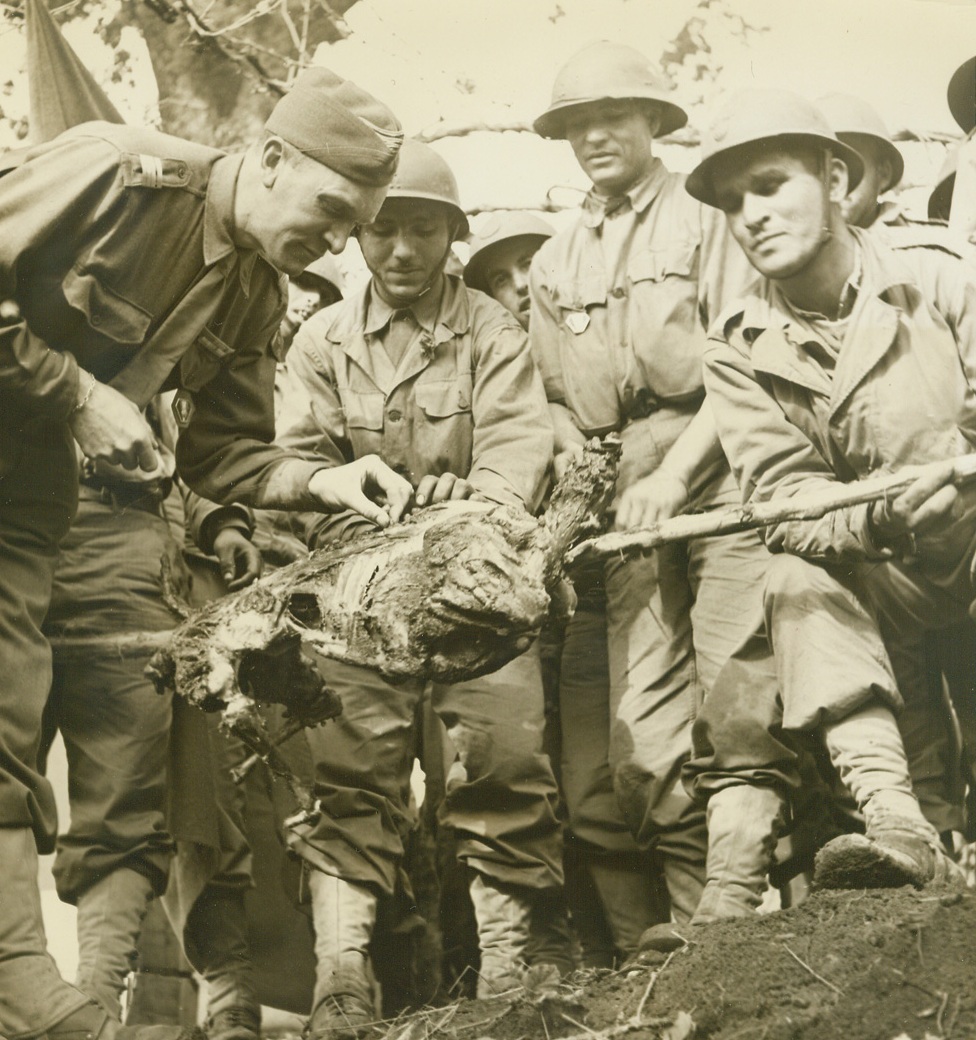
As Moroccans Prepared to Battle Germans, 12/28/1943. Italy – It has now been revealed that Mohammedan troops from French Morocco have entered the Allied Fifth Army lines and are actively engaging the Germans in the mountains northwest of Venafro, with excellent results. Before these troops moved into battle, and while they were encamped in the plains to the rear of the Fifth Army lines, the Mohammedan soldiers observed their Ait Kebir, or Great Feast, a solemn religious ceremony which marks the arrival of the new year (it is now the year 1364 on their calendar.) With preparations for ballet under way, uniforms were substituted for the usual colorful costumes, and the usually violent tribal dancing was dispensed with. Instead one of the solders performed a brief token dance. In Morocco it is the custom during the feast that every married man kill a sheep, which is then roasted whole and eaten with a sort of bread cake made of coarsely ground wheat and streamed above a caldron of boiling vegetable stew. In spite of wartime scarcity of the animals in Italy, the soldiers had plenty on hand for the feast, getting them in various mysterious ways about which officials were a bit vague when asked. In this series of photos, taken by Acme photographer Bert Brandt, various parts of the Ait Kebir are shown. (Passed by Censors). Major Jacques Allard, (left), Commandant of the French Regiment, puts his “seal of approval” on the feast by tasting a bit from one of the roasted sheep. Credit: ACME photo by Bert Brandt for the War Picture Po;
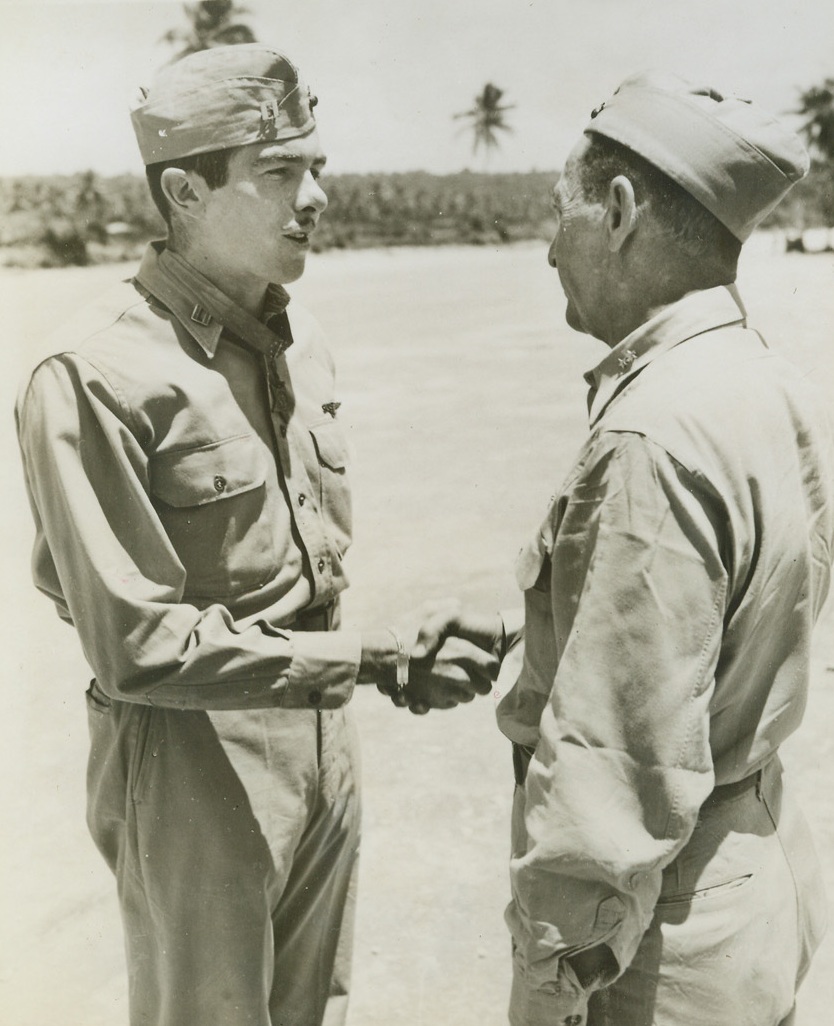
HE SHOT A NATURAL, 12/27/1943. SOUTH PACIFIC BASE—Capt. James E. Swett (left) of San Mateo, Calif., is congratulated by Maj. Gen. Ralph J. Mitchell, commanding general of Marine Air Units in the South Pacific, after being awarded the Congressional Medal of Honor at his South Pacific base. Capt. Swett received the high honor for shooting down seven Jap planes in one engagement on April 7th this year. This believed to be one of the greatest demonstrations of aerial marksmanship in World War II. Since then, Capt. Swett has added five more Jap planes to his score. Credit Line (US Marine Corp Photo from ACME);
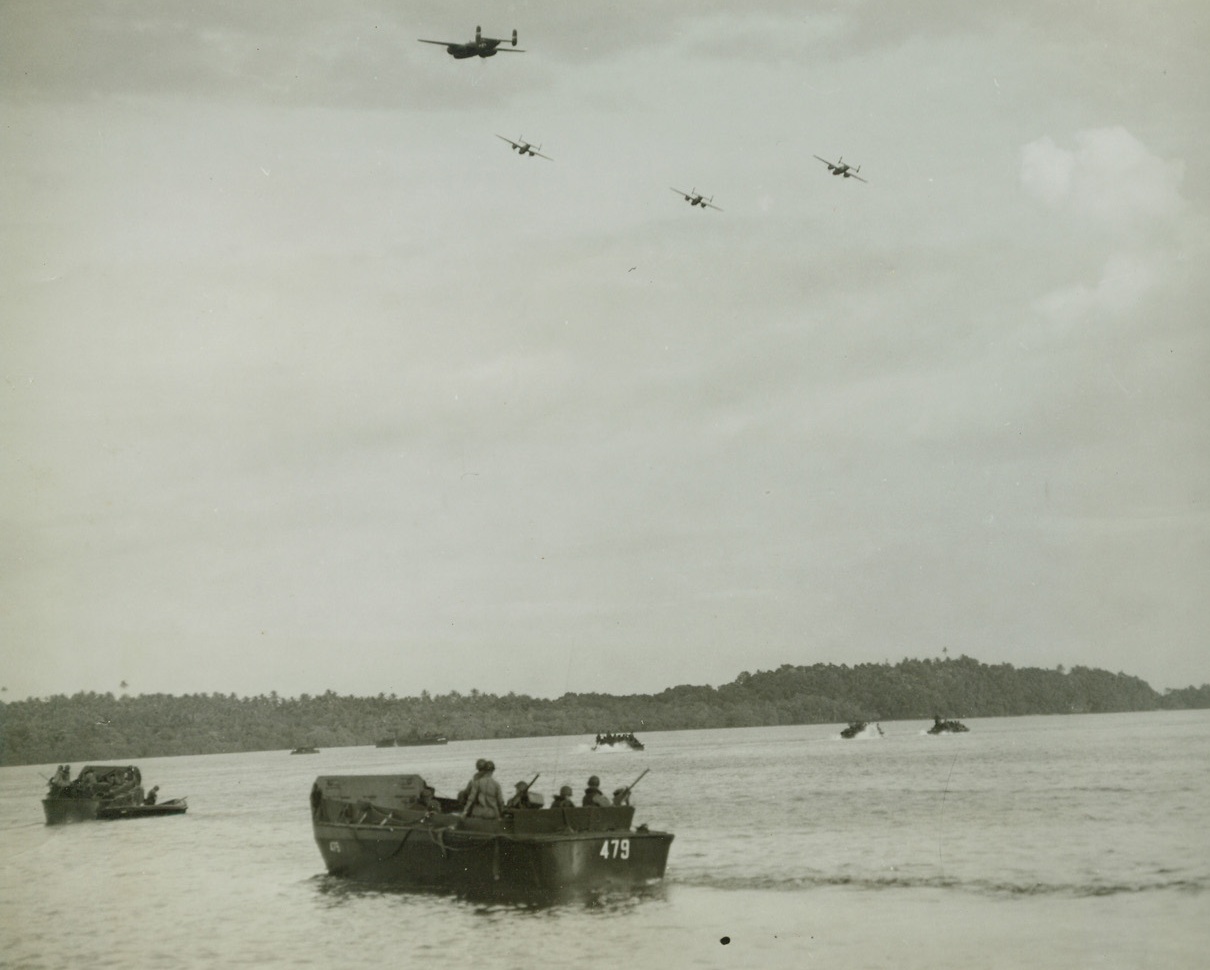
Bombers Protect U.S. Troops Landing on Arawe, 12/28/1943. Covered by B-25s of the U.S. Fifth Air Force, a group of landing craft head for beach at Arawe, New Britain, on southwestern coast. Landing was made and beachheads established in drive to clear the island of Japanese. Credit: ACME photo by Tom Shafer for War Pool;
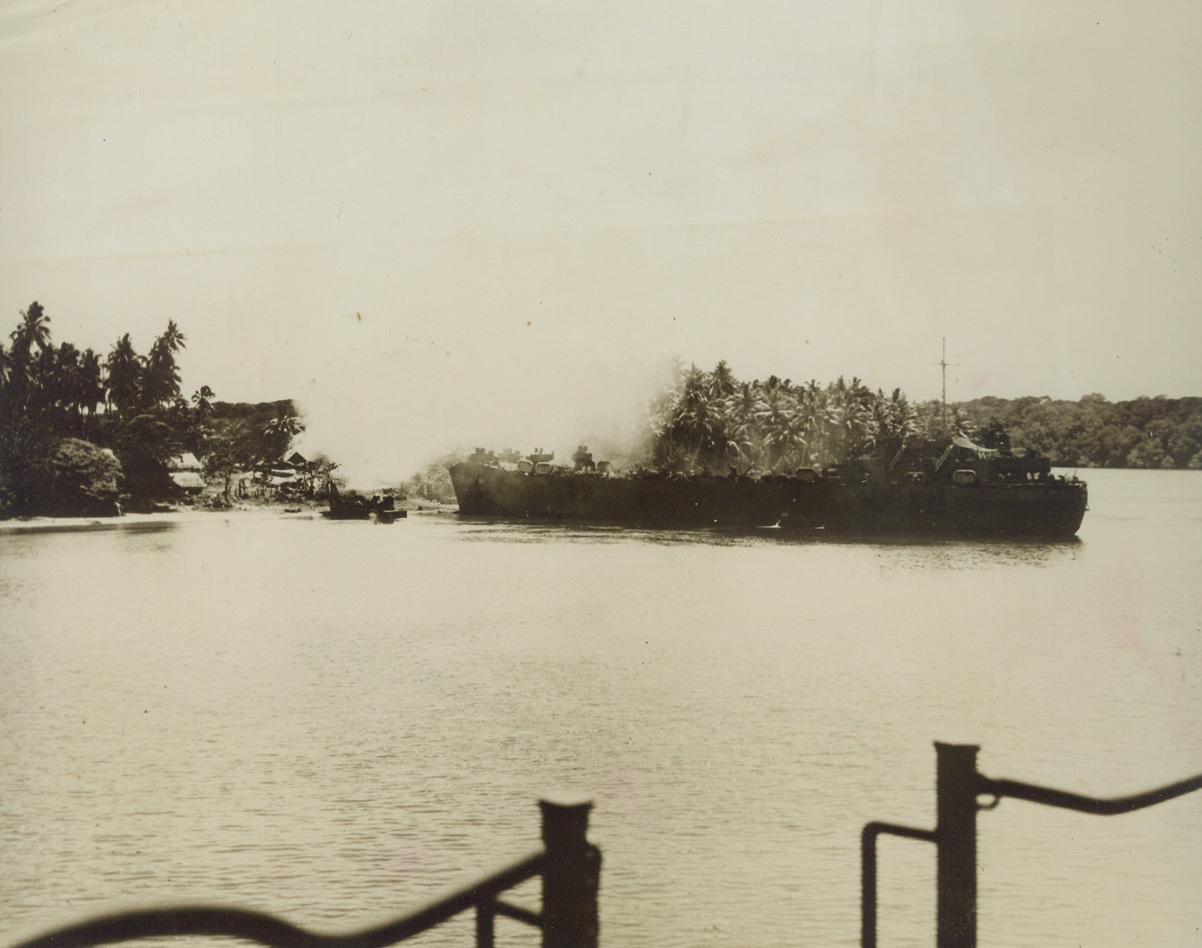
Small in Size but Big in Importance, 12/24/1943. South Pacific – A direct hit by a Jap gun on our beachhead shrouds the bow of an American LST in smoke as we seize Mono Island in the Treasury Group, October 27. Backed by long planning, the quick capture of the Central Solomons Island demonstrated that when Jap forces are small and ill-prepared, we can move with the same terrorizing speed that the Nipponese enemy once did. After a terrific bombardment by U.S. Destroyers, American and New Zealanders killed or captured the majority of the 200 to 300 Japs within 14 hours. Credit: Official U.S. Navy photo from ACME;
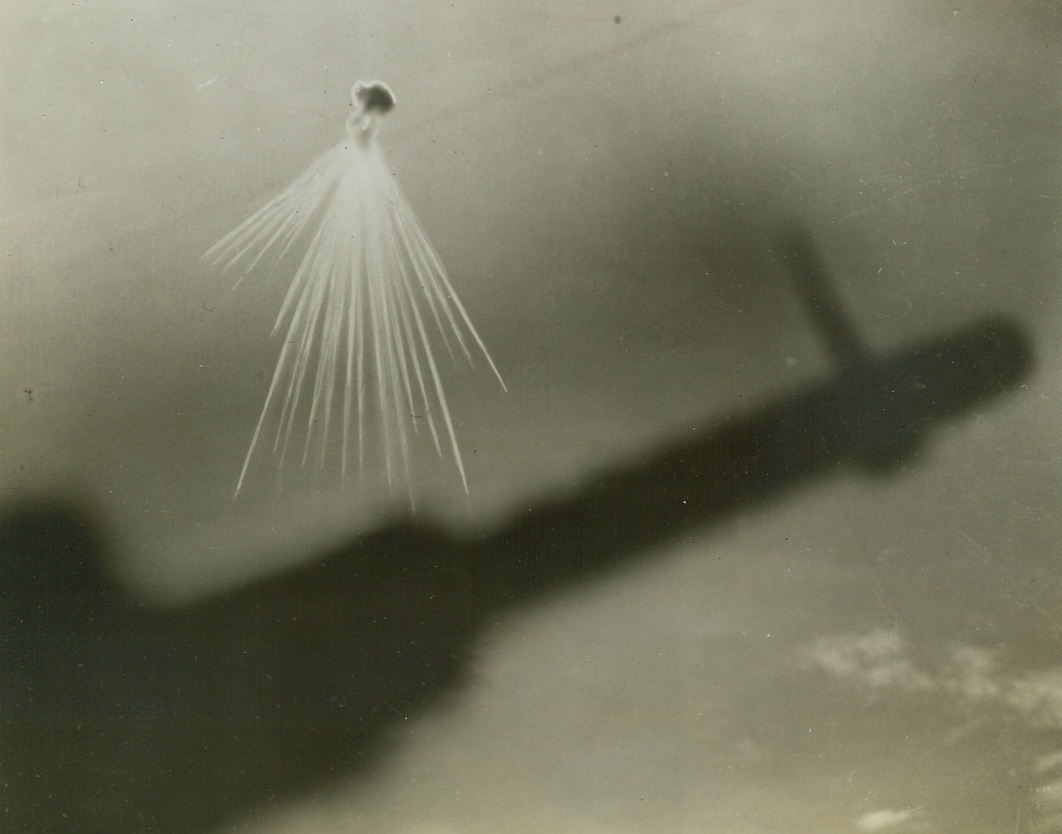
Jap Aerial Incendiary Bomb, 12/24/1943. Marshall Islands – The incendiary fingers of an aerial phosphorous bomb spray out as the Japs attempt to break up formations of 7th Air Force Liberator Bombers, which are striking daily at Jap bases in the Marshalls. The bomb burst was photographed from the waist window of a Liberator, with the silhouette of the bomber’s .50-calibre waist gun in foreground. Credit: 7th Army Air Force photo from ACME;
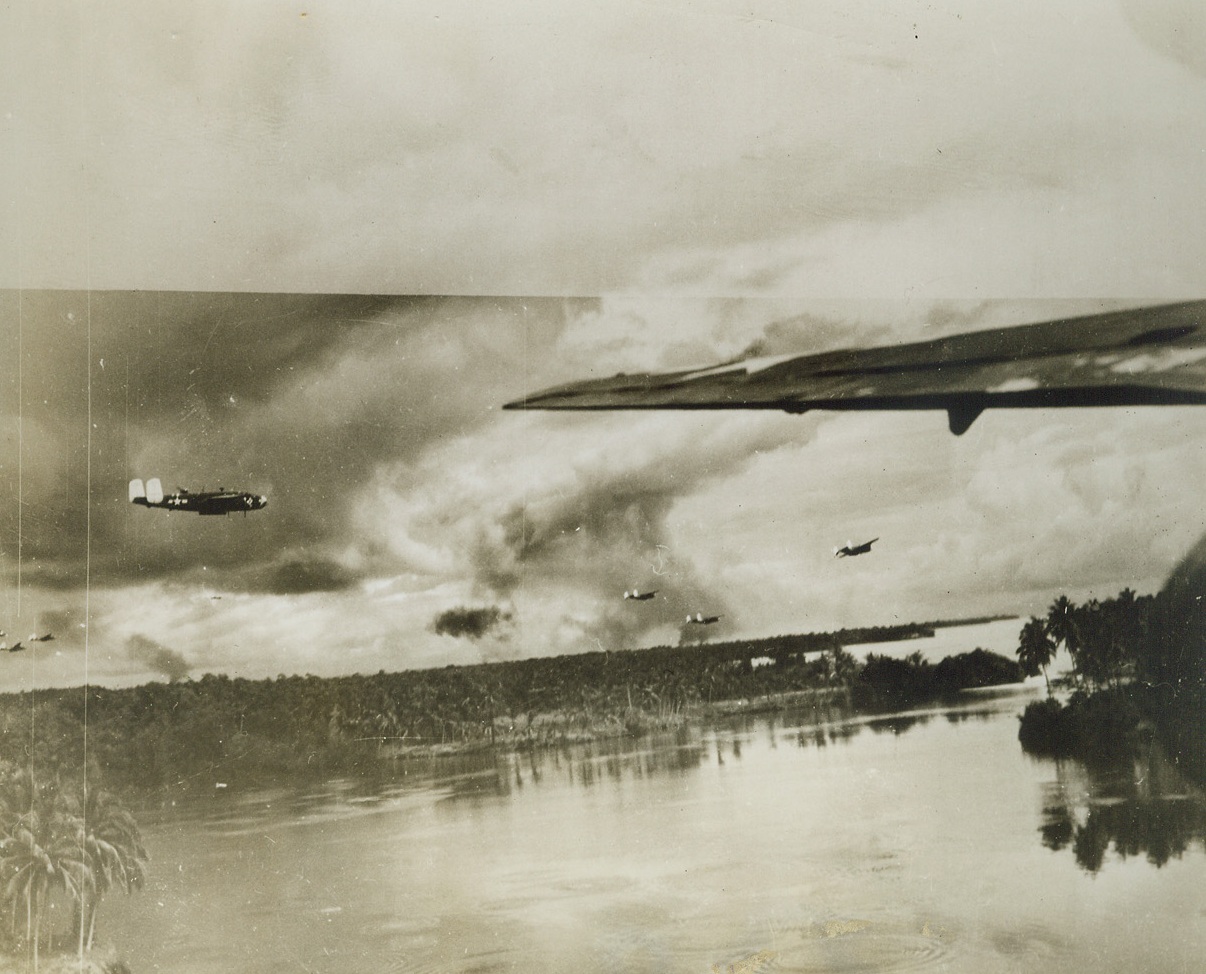
Yanks Blast Madang, 12/10/1943. New Guinea – Low-flying B-25s run over the target and fairly skim the water of the bay at Madang, New Guinea, where columns of black smoke in the background mark destruction caused by American B-24s on Alexishafen. The black puff of smoke in the center of the photo is from enemy ack-ack. Credit: ACME;
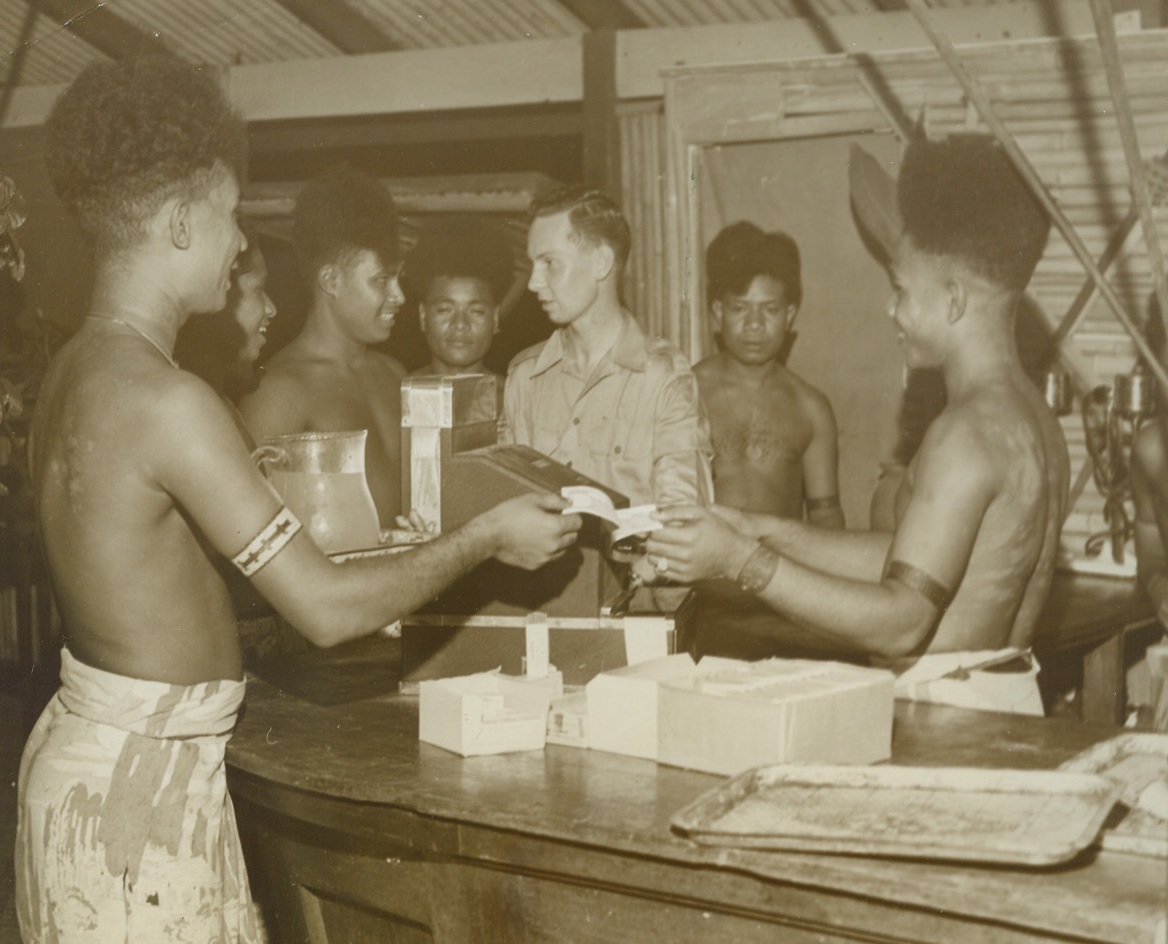
New Guinea Counter Man, 12/13/1943. New Guinea – Easily taking to the complexities of modern life, Fuzzy-Wuzzies, natives of New Guinea, handle the jobs of cashier and waiters with ease. Gudu Udau works the cash register while other natives wait for change. The picturesque Fuzzy-Wuzzies also help carry supplies, wounded and ammunition through the jungle. Credit: ACME;
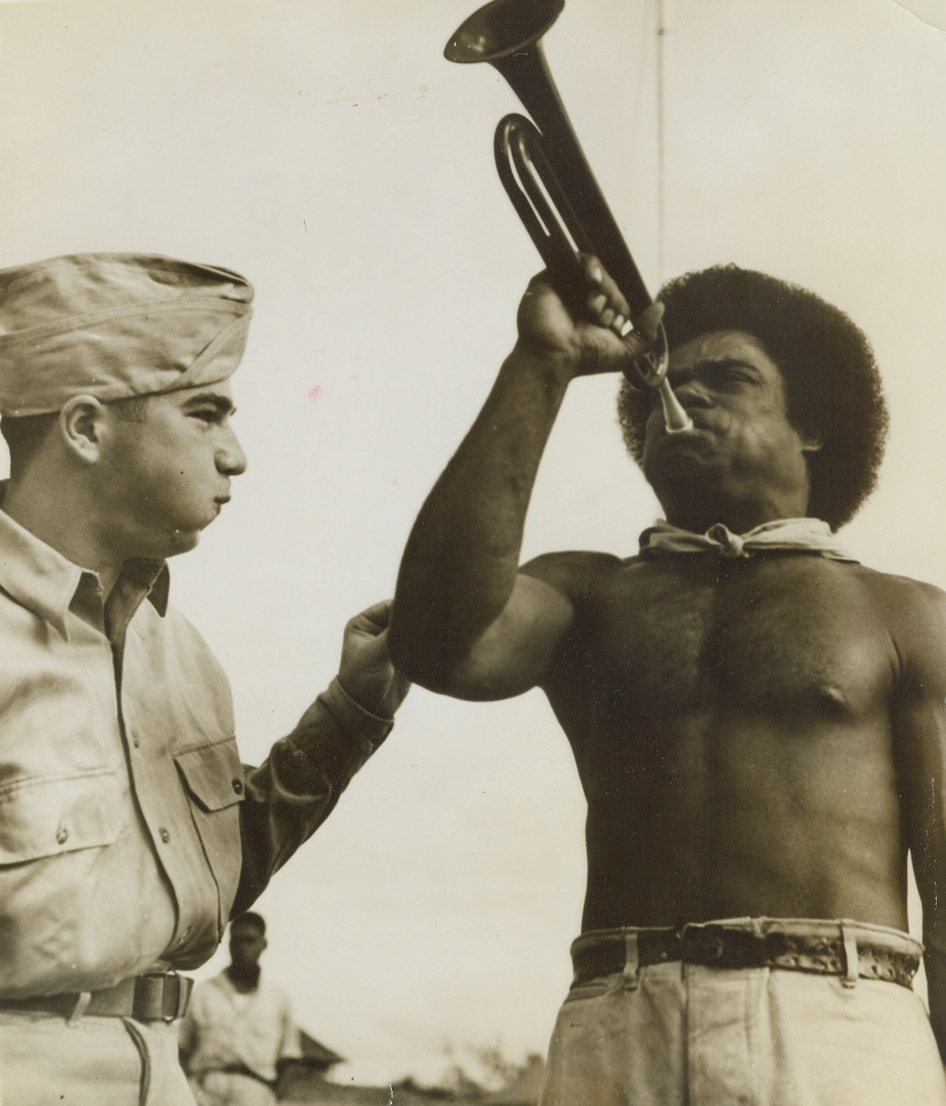
Simple When You Know How, 12/10/1943. Pacific – A Fiji islander, who is determined to blow in the New Year for the Yanks, huffs and puffs but gets only a squawk from the bugle, in spite of the expert tutelage of an American bugler. Credit: Yank photo from ACME;
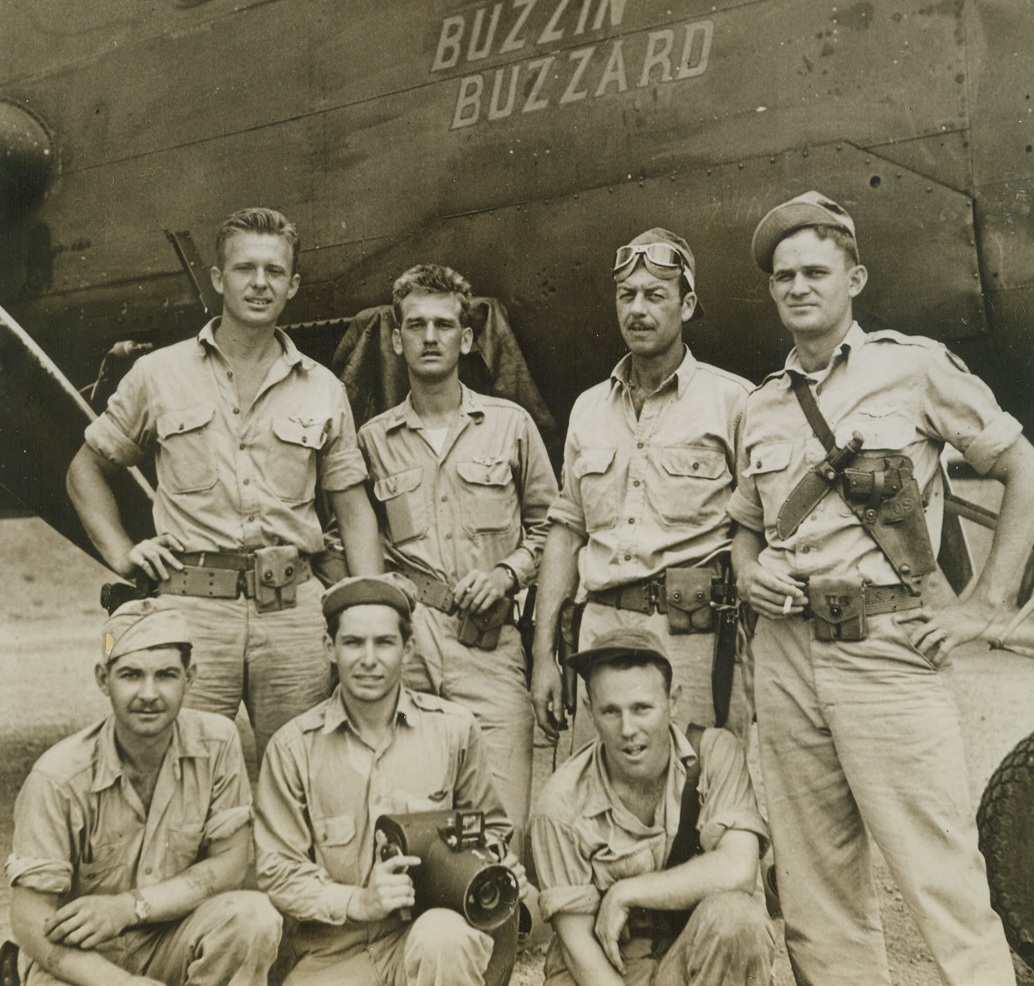
Back from Madang, 12/10/1943. South Pacific – After taking part in an American raid on Madang, New Guinea, in the Bomber “Buzzin Buzzard,” the crew lines up at the nose of their plane. (Top row, left to right): Pilot, Lt. George L. Barnaskey, of Tuckahoe, N.Y.; Co-pilot, Flight Officer Edward V. Stefanowsky, of Superior, Wisc.; Top Gunner Sgt. Harold C. Bridges, of Seattle, Wash.; Navigator-Bombardier Lt. Jack D. Moon, of Lubbock, Texas. (Kneeling, left to right) Radio Operator and Tail Gunner Staff Sgt. Wayland R. Anderson, of Pontiac, Mich.; Myron H. Davies, Life Correspondent, and Waist Gunner Sgt. William T. Strickland, of Richmond, Calif. Credit: ACME;
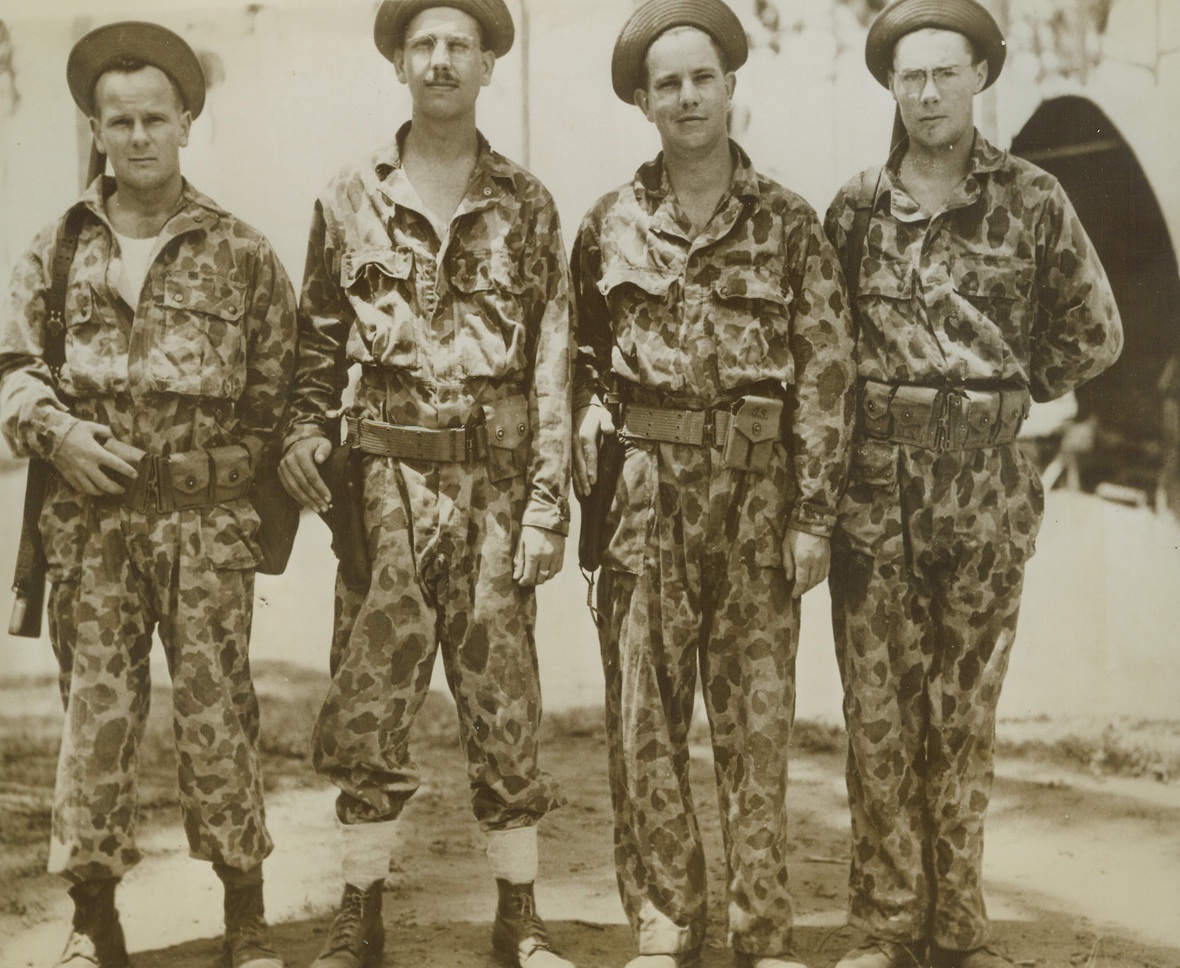
Mapped Jap Territory, 12/9/1943. South Pacific – These four U.S. Army Engineers, wear the camouflage suits in which they recently landed on a Jap-held island in the South Pacific, made a 200-mile trip through the island’s jungles, and escaped with material for vital maps and charts. Left to right, are: T/4 John Cahill, of Whitefish Bay, Wis.; T/Sgt. Harold H. Hulseberg, Chicago, Ill.; T/4 Joseph G. Barbre, New Roads, LA.; and T/5 Robert D. Miller, of Weldon, Iowa. (Passed by Censors) Credit: ACME;
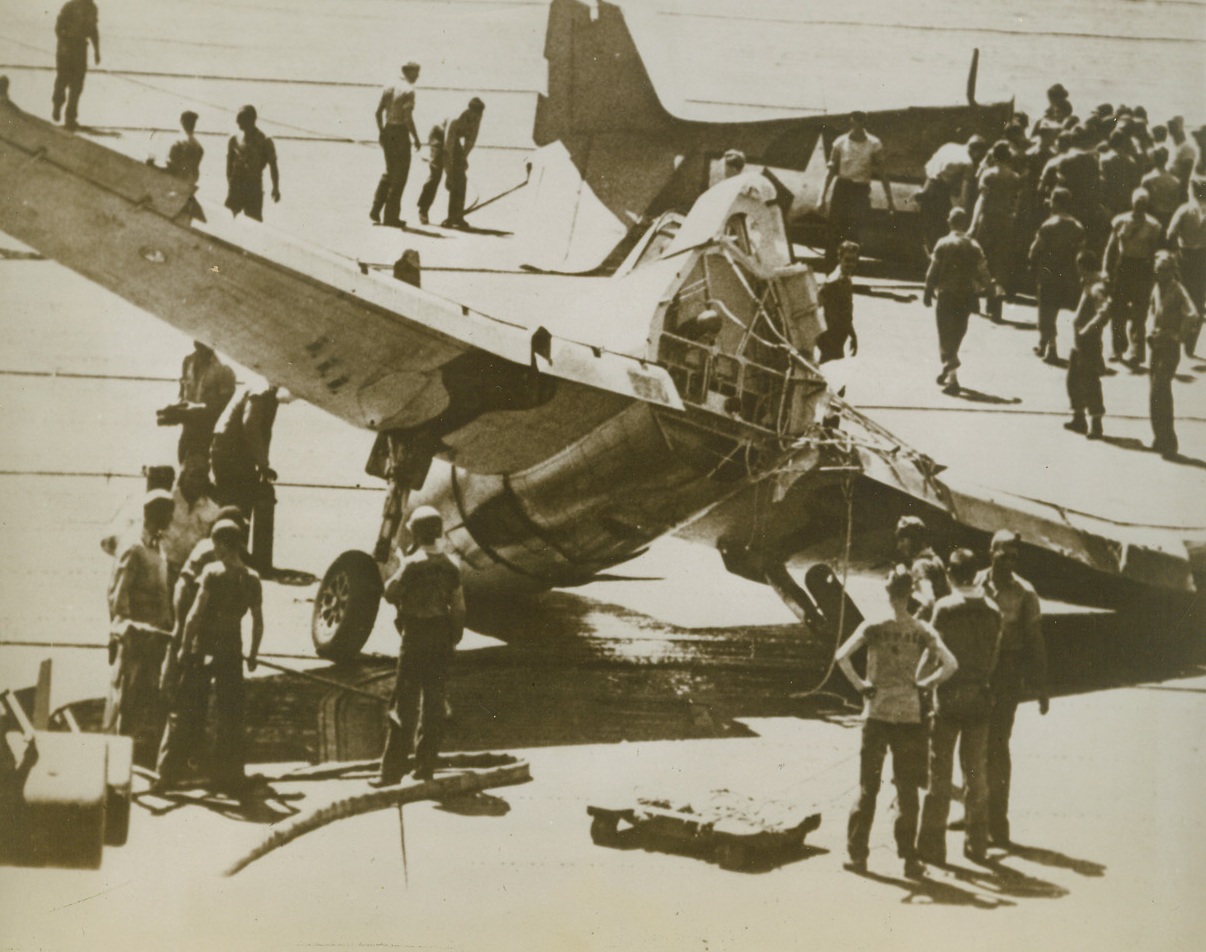
Fighter Plane Breaks in Two, 12/8/1943. Somewhere in the Pacific – Lt. Charles L. Mountenot, of Edgewater, N.J., tried to land his fighter plane on this carrier, with his hydraulic system shot up and with one wheel facing the wrong way. The plane snapped in two when it was caught by the hook. Mountenot had been at Tarawa the day before the Marines landed there. Credit: ACME;
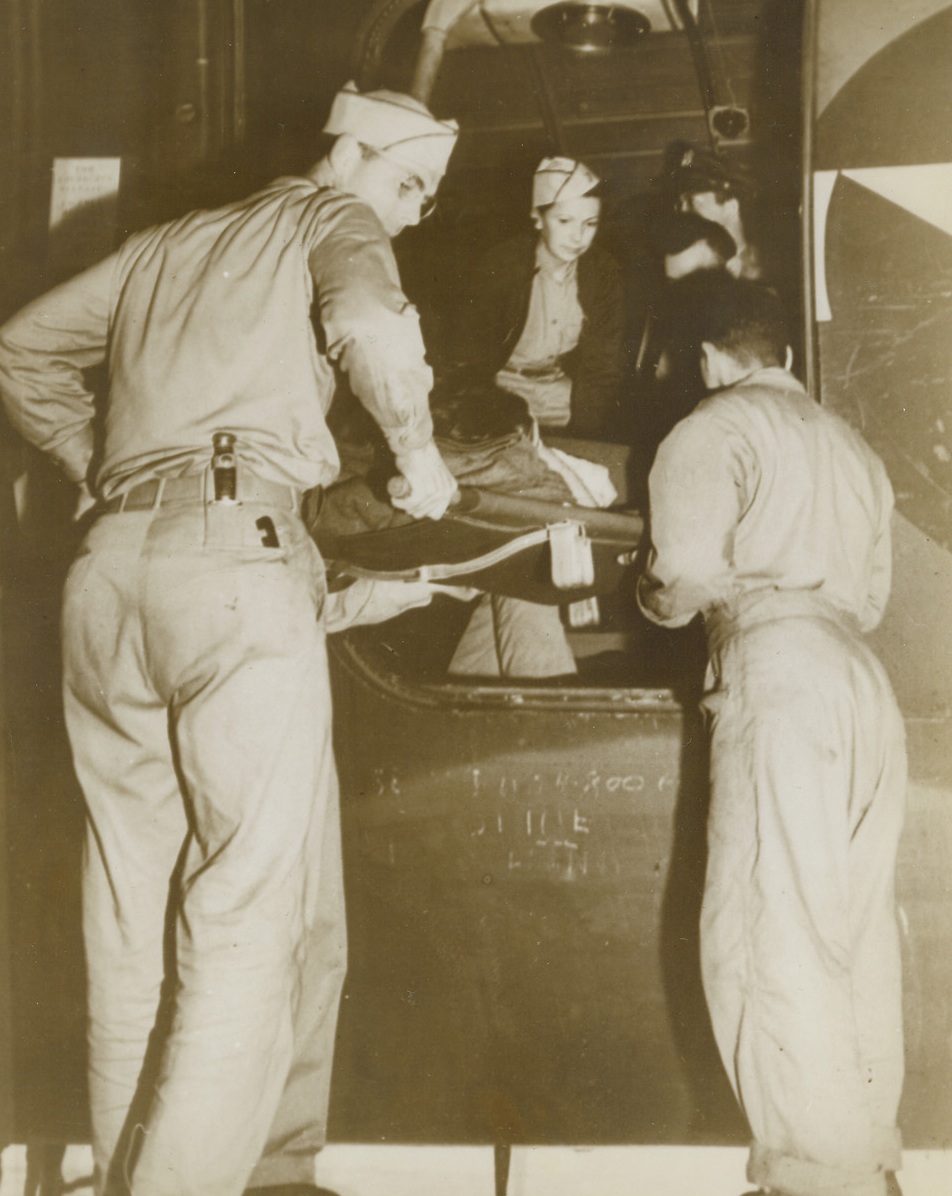
Swift Medical Care for Wounded, 12/8/1943. Hawaii: An ATC C-54 Hospital Plane takes aboard the first American casualties from the Makin Island invasion, who have just arrived from the newly-won Central Pacific base. Credit: ACME;
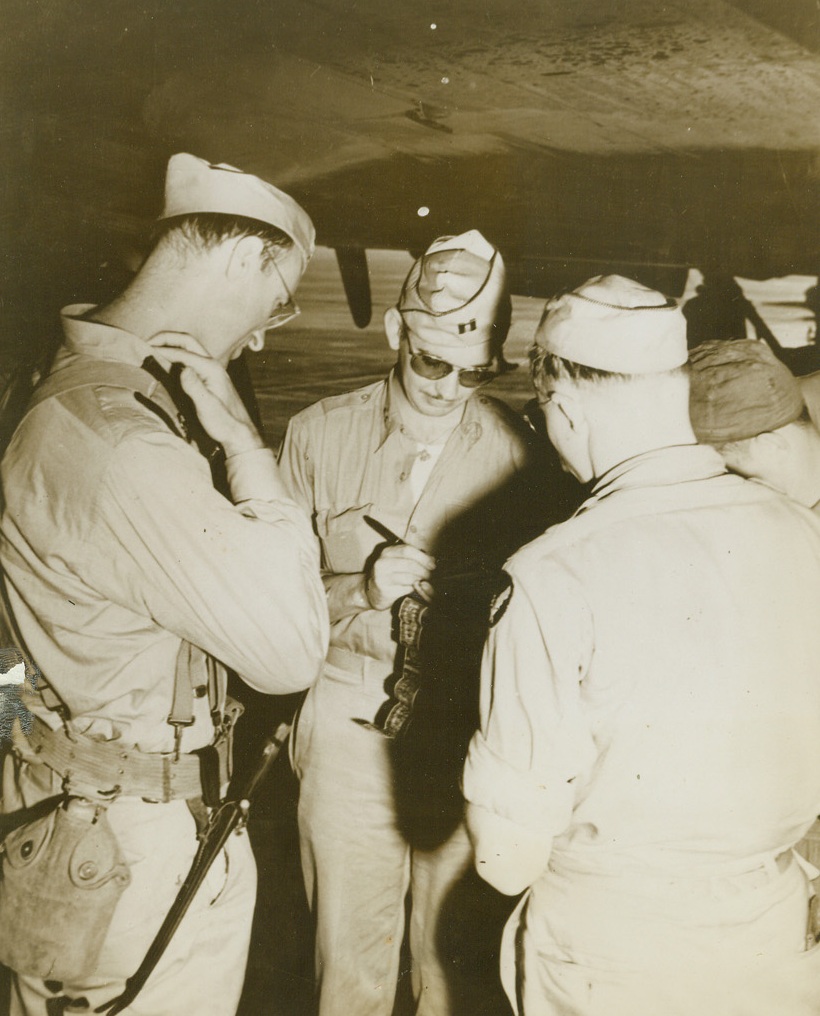
An Old Airways Custom, 12/8/1943. Hawaii: Lt. Col. James Roosevelt, left, observer in the Makin Campaign, watches his “Short-Snorter” Bill being signed, after arriving on ATC Hospital Plane at Hickam Field, T.H. Credit: ACME;
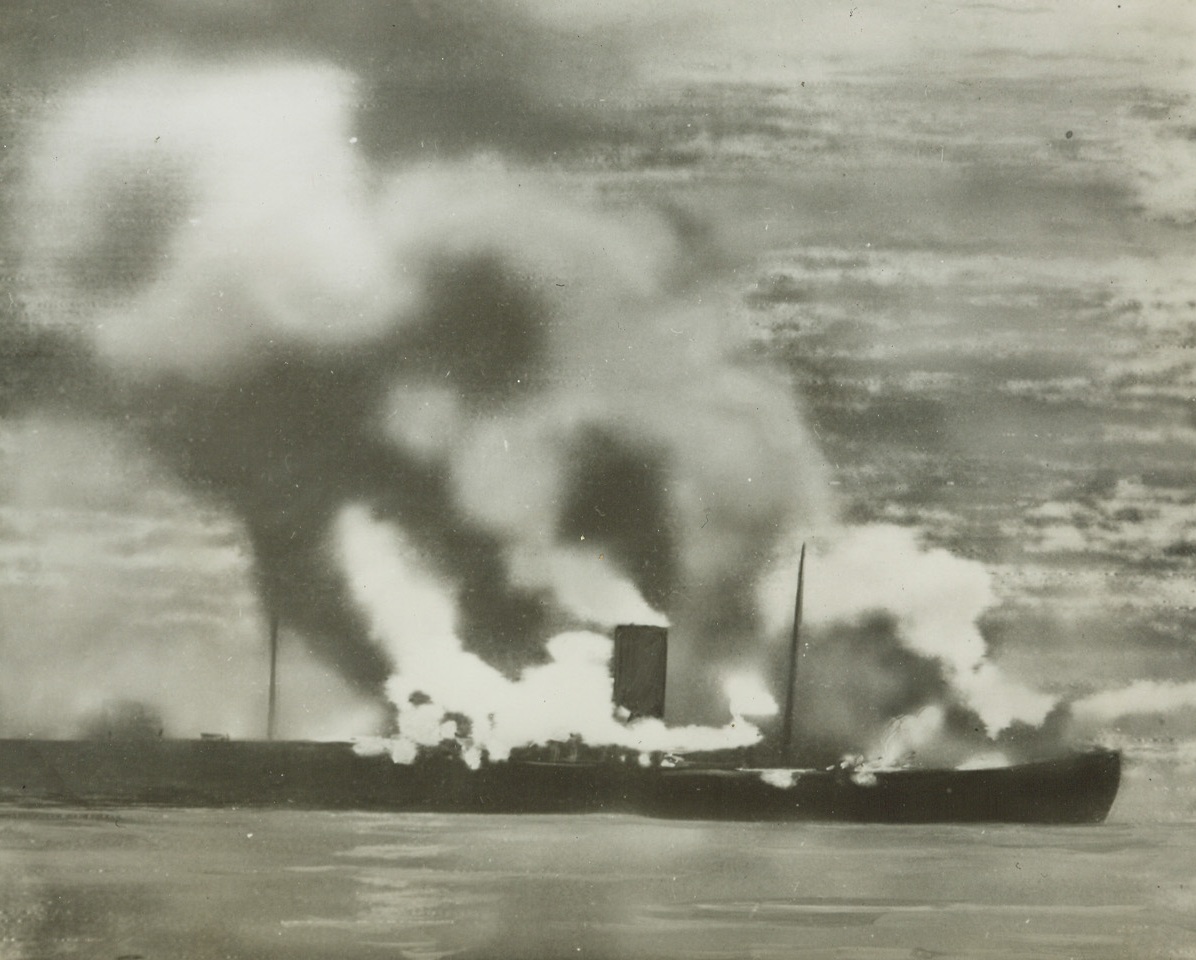
Blockade Runner Ablaze, 12/30/1943. Bay of Biscay – Attacked and sent to the bottom by aircraft of the British Coastal Command, this fast Nazi Blockade Runner was believed to have been nearing the end of its long journey from Japan when it was spotted. British Airmen also sunk three of a force of eleven enemy Destroyers in the battle. Photo radioed to New York from London today (12-30-43). Credit: ACME Radiophoto;
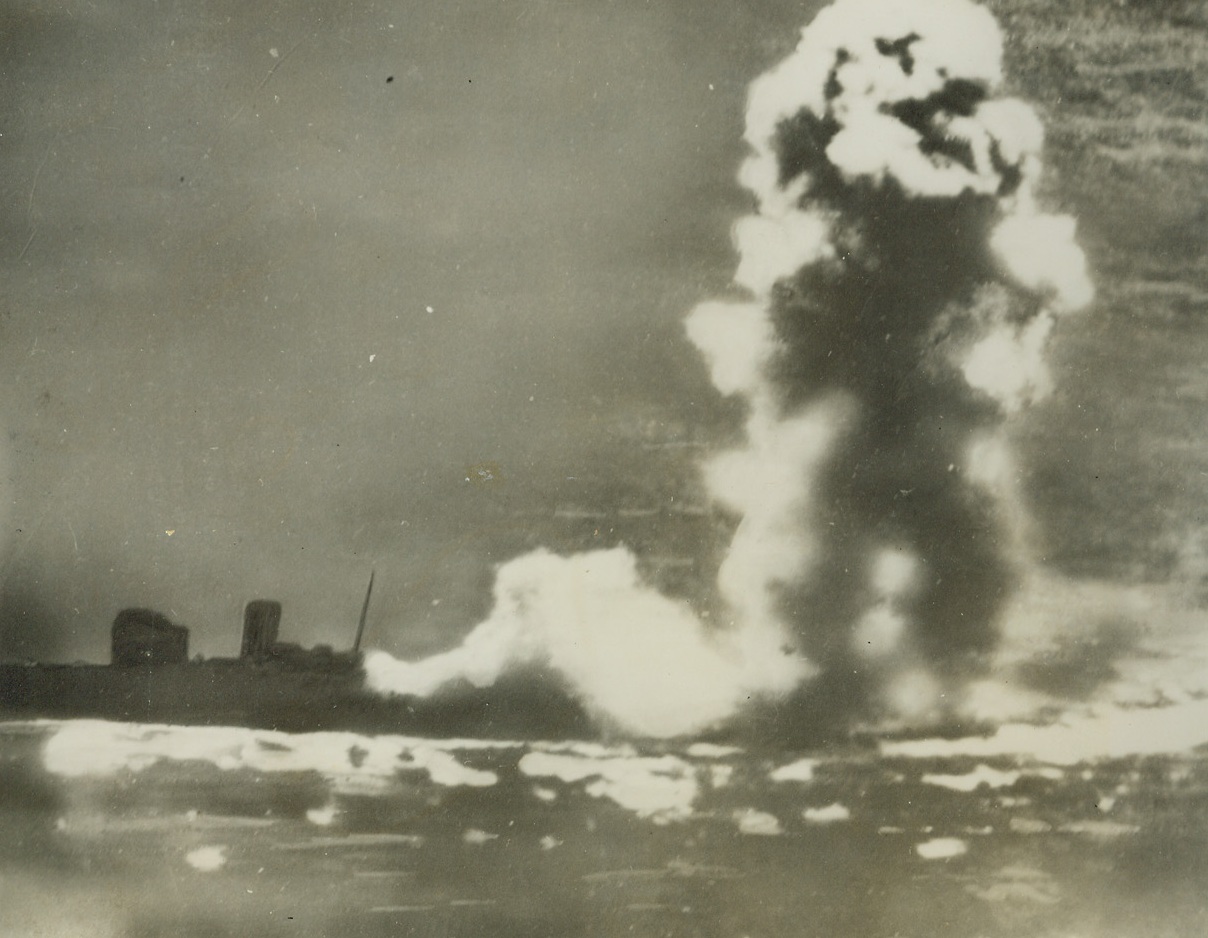
Direct Hit on Nazi Vessel, 12/30/1943. Bay of Biscay – Spotted by American Navy Airmen and sent to the bottom by aircraft of the British Coastal Command, this Nazi Blockade Runner is shown as it suffered a direct hit in the Bay of Biscay. Three of a force of eleven enemy Destroyers accompanied the ship to Davey Jones Locker in the same battle on December 28th. Photo radioed to New York from London today (Dec. 30th). Credit: ACME Radiophoto;
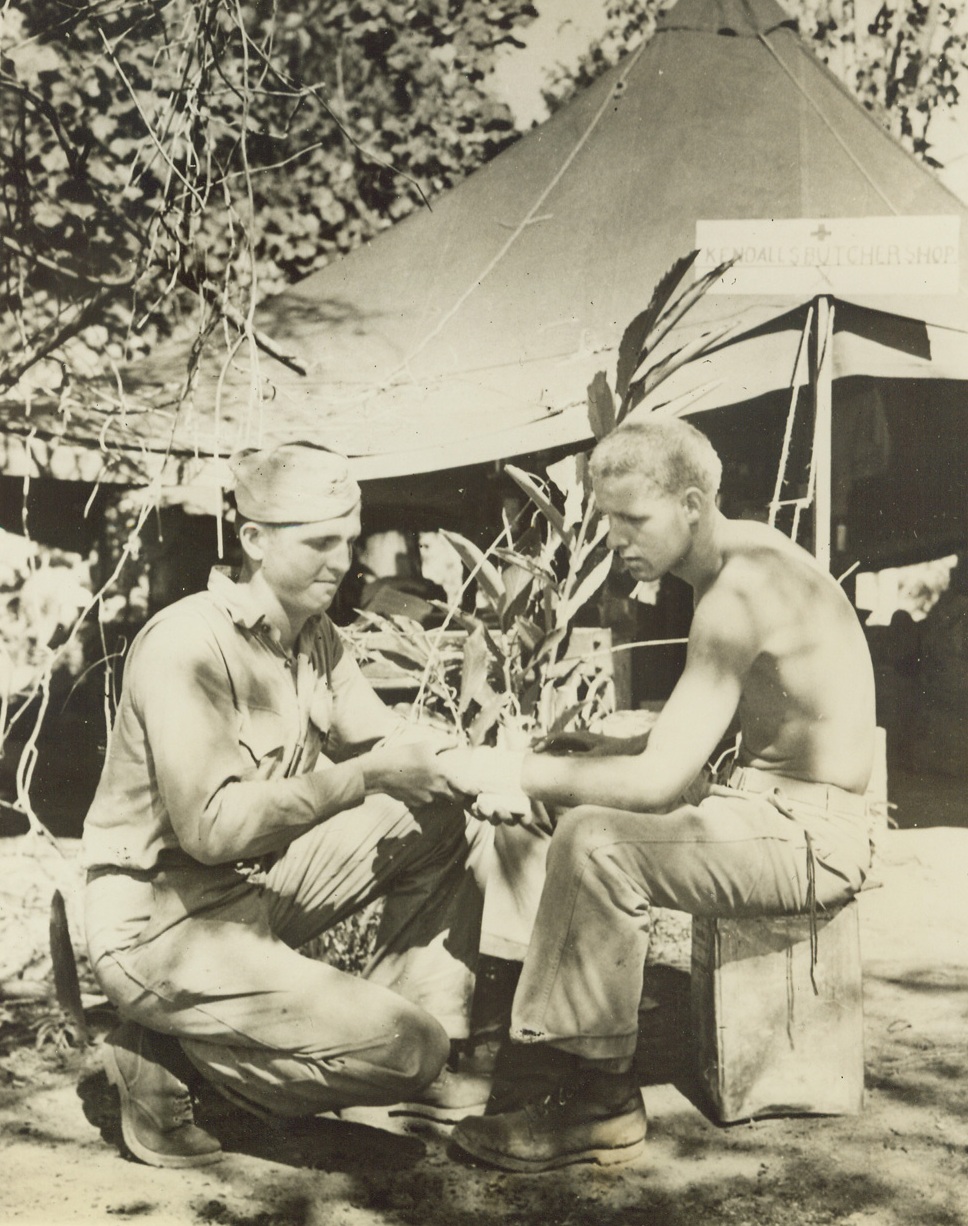
Hero Carries On, 12/30/1943. Vella Lavella, S. I. – Pharmacist’s Mate 2/c Rex H. Gregor, 21, of Rochester, Minn. (left), recently performed one of the most heroic acts of the war when he climbed aboard a blazing Landing Barge on which ignited ammunition was exploding, helped remove the wounded and then performed a leg amputation on one of the casualties – although Gregor had never seen such an operation. The action occurred during a Japanese air raid on Marine forces on Vella Lavella, in the Central Solomons. Here, Gregor bandages the wrist of Cpl. Kenneth A. McIntyre, USMC, of Minneapolis, Minn., who also helped rescue wounded from the blazing barge. Note sign over tent, (top right), reading, “Kendall’s Butcher Shop.” Credit: Official Marine Corps photo from ACME;
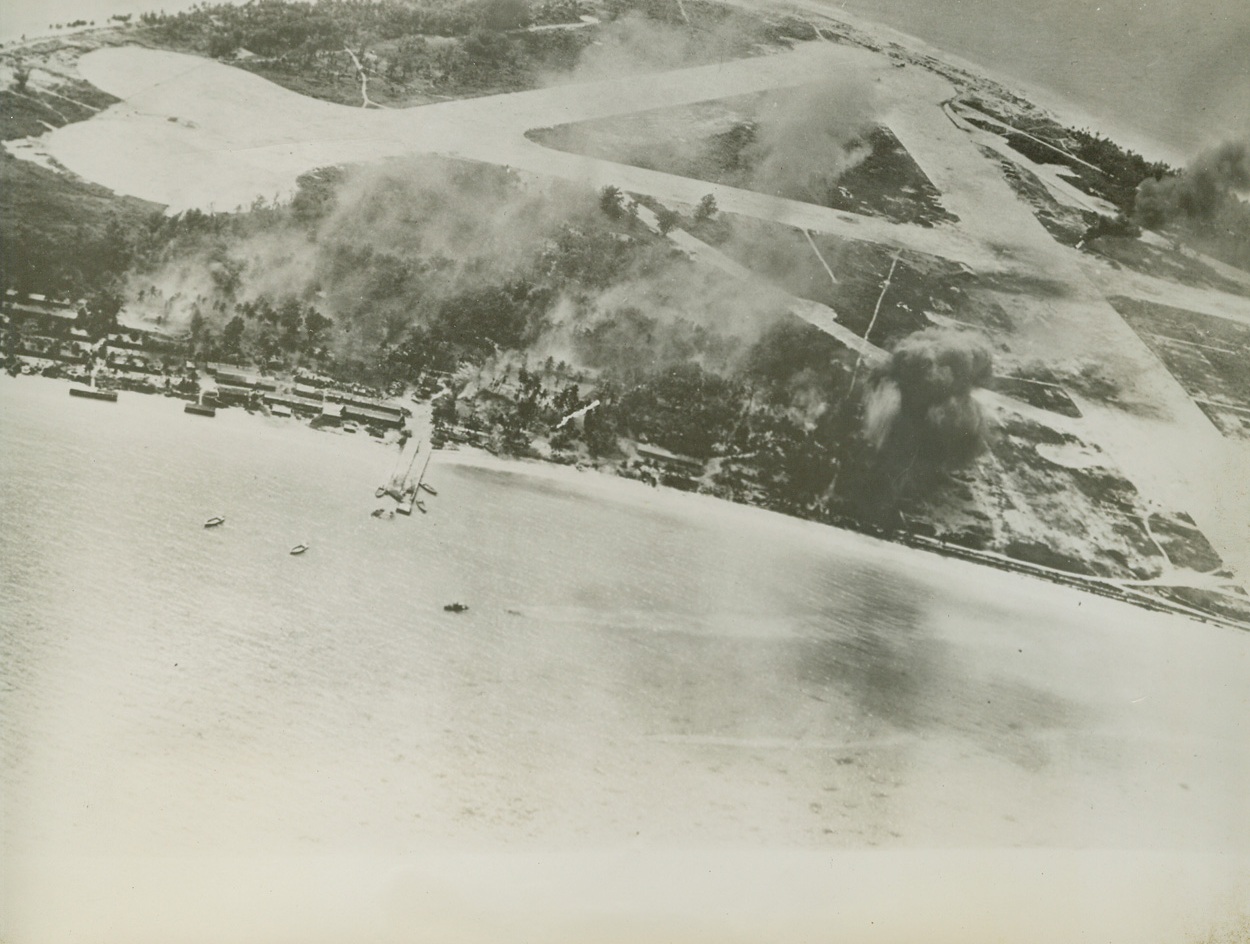
U.S. Bombs Hitting Marshall Islands in Regular Raids, 12/31/1943. Mille Atoll, M. I. – On the regular “milk run” pre-invasion air raids of later, American bombs have been – like here – hitting the air strip and camp area of Mille Atoll in the Marshall Islands. This closeup airview was made during a November raid by Yank fliers. Credit: Official U.S. Navy photo from ACME;
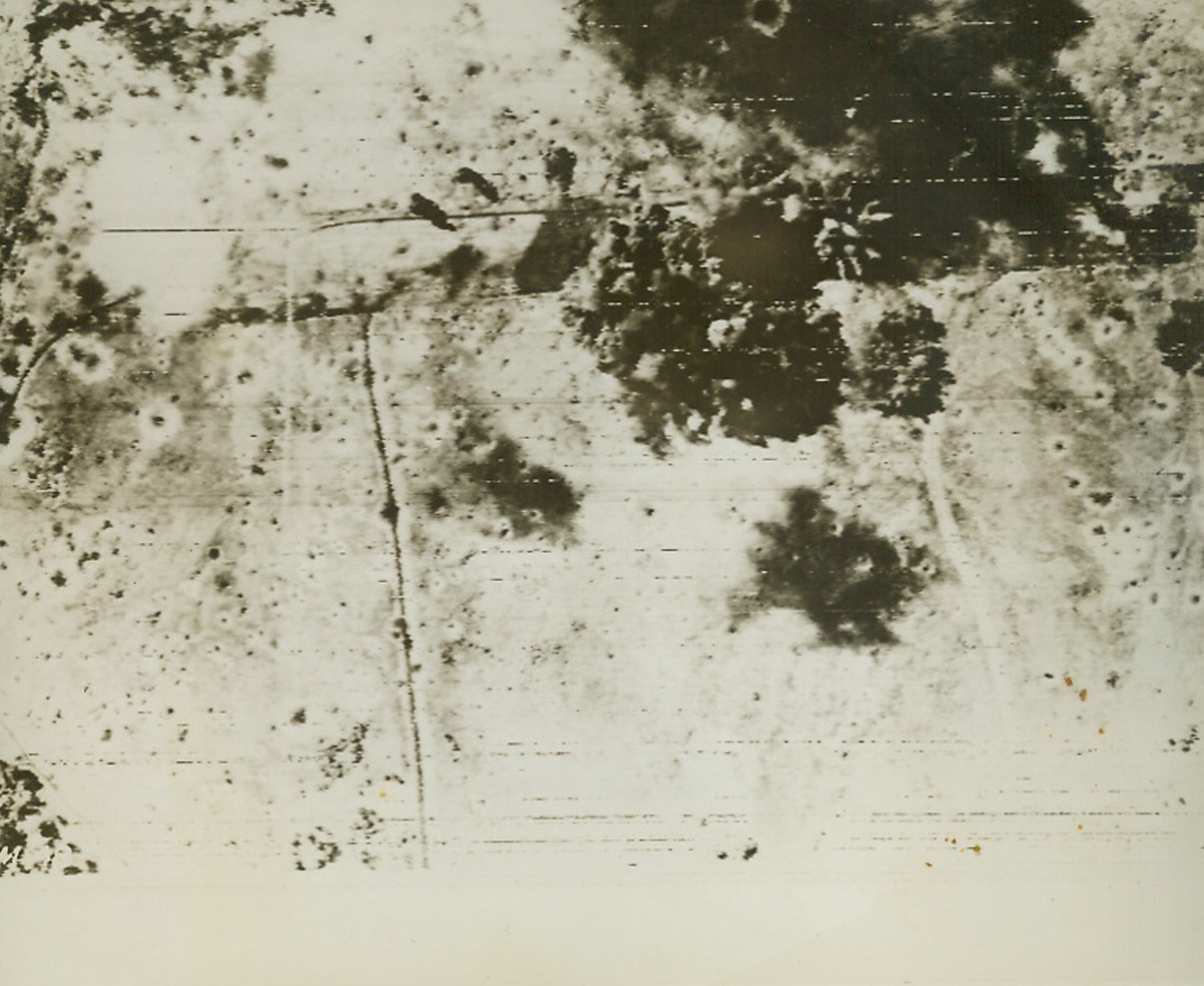
Yanks Wreck Cape Gloucester Field, 12/28/1943. This photo, flashed to the United States by radiotelephoto, shows bombs from U.S. B-24 Liberator and B-25 Mitchell Bombers, exploding on the Jap airfield at Cape Gloucester. The field is shown pitted with shell craters from almost daily bombing by Allied planes since Dec. 1st. In upper right, bombs burst on Nip planes which were trapped on the ground. These raids were in preparation for landings by American Marines who, it was announced today, had made their second landing in the Cape Gloucester area. Credit: U.S. Signal Corps Radiotelephoto from ACME;
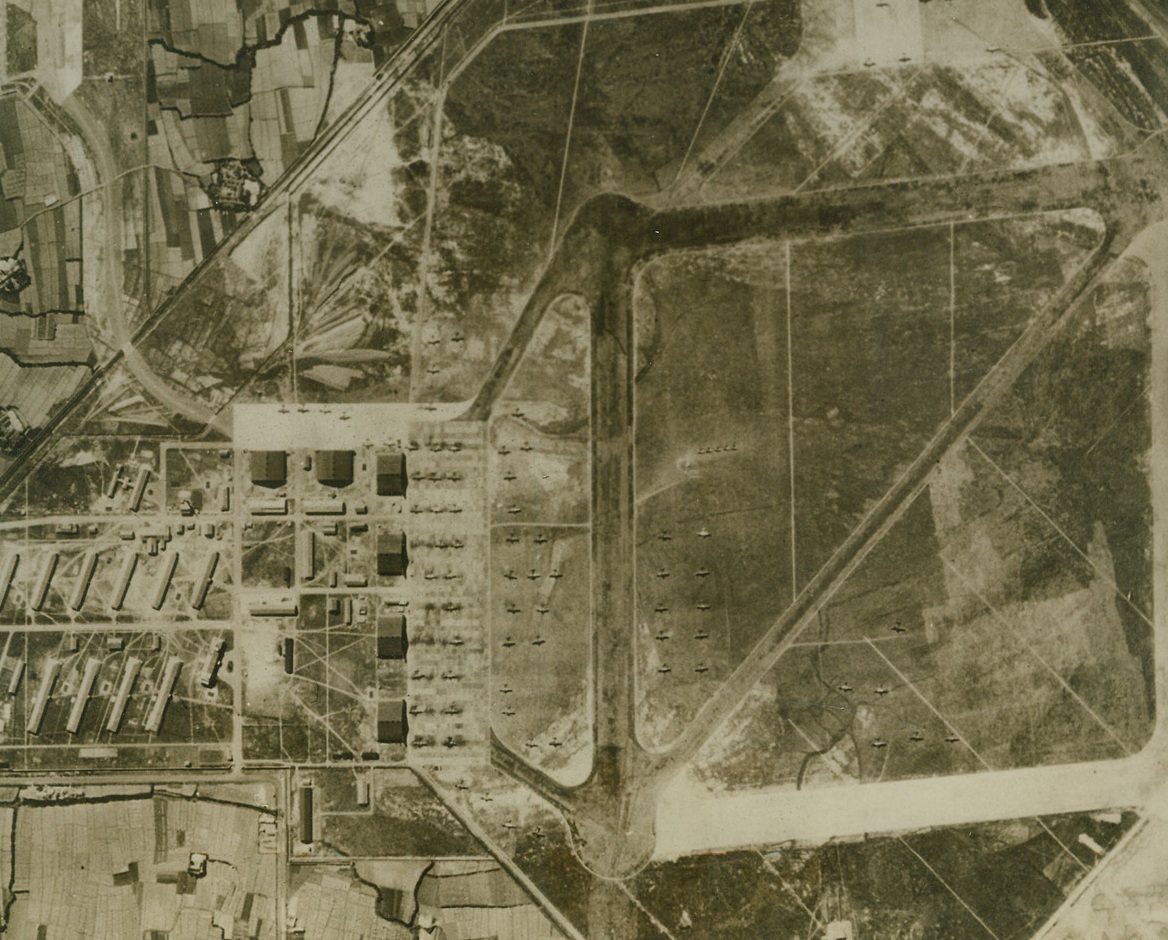
Yanks Hit Japs at Home – (#1), 12/16/1943. Washington, D.C. – This photo, just released in Washington, shows the Japanese Shinchiku Airdrome on the island of Formosa, before it was blasted by fighters and bombers of the U.S. Army 14th Air Force, during a raid on Thanksgiving Day, 1943. This marks the first time Japanese island bases have been struck from China proper, where the Allies now have bases. (Also see Acme photo #W707378). Credit: U.S. Army Air Forces photo from ACME;
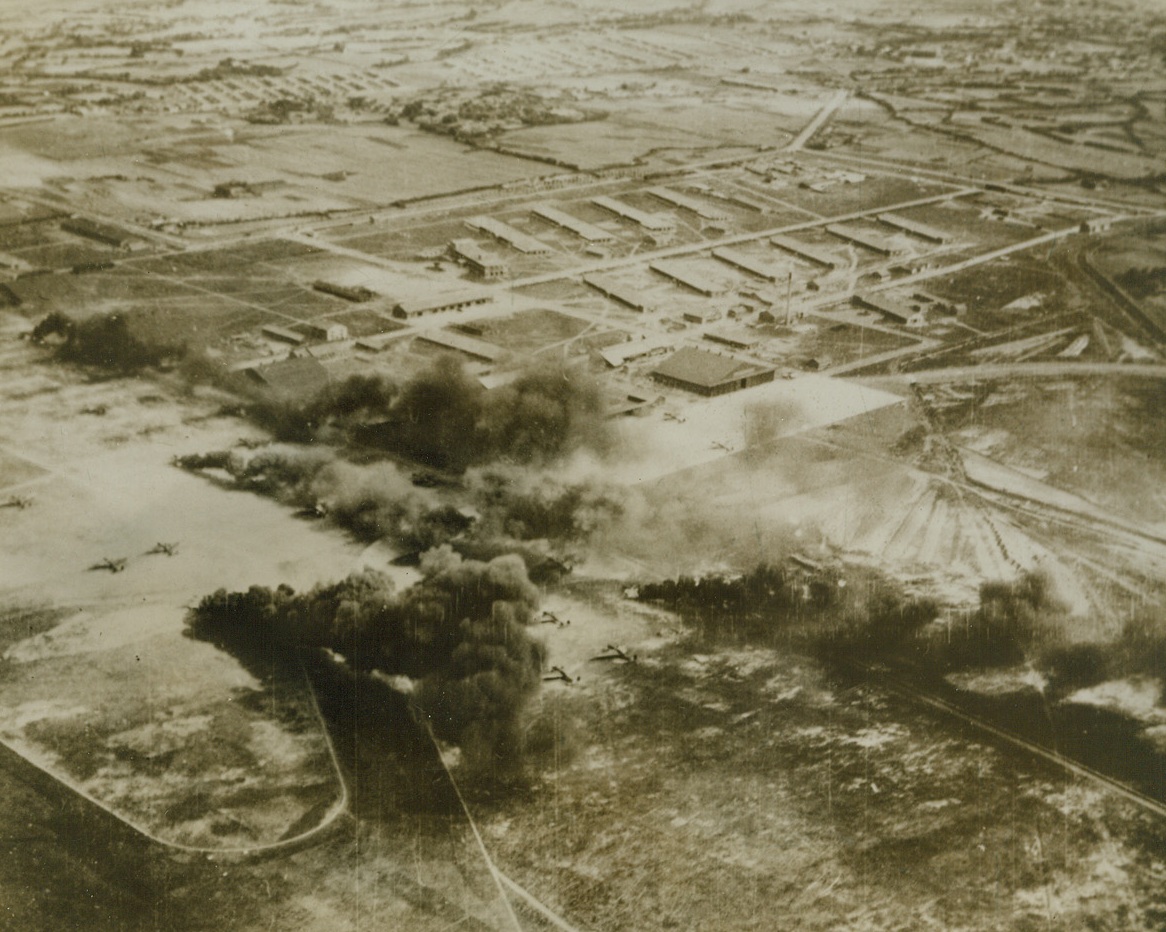
Yanks Hit Japs at Home – (#2), 12/16/1943. Washington, D.C. – This photo, just released in Washington, shows Jap aircraft burning on the Shinchiku Aerodrome on Formosa, during an attack last Thanksgiving Day (1943), by fighters and bombers of the U.S. 14th Army Air Force, which took off from bases in China proper. This photo was taken just after fighter planes swept the target in a low-level strafing attack, which set fire to the Nip aircraft. A short time later, American bombers blasted the airfield and installations with heavy bombs.;
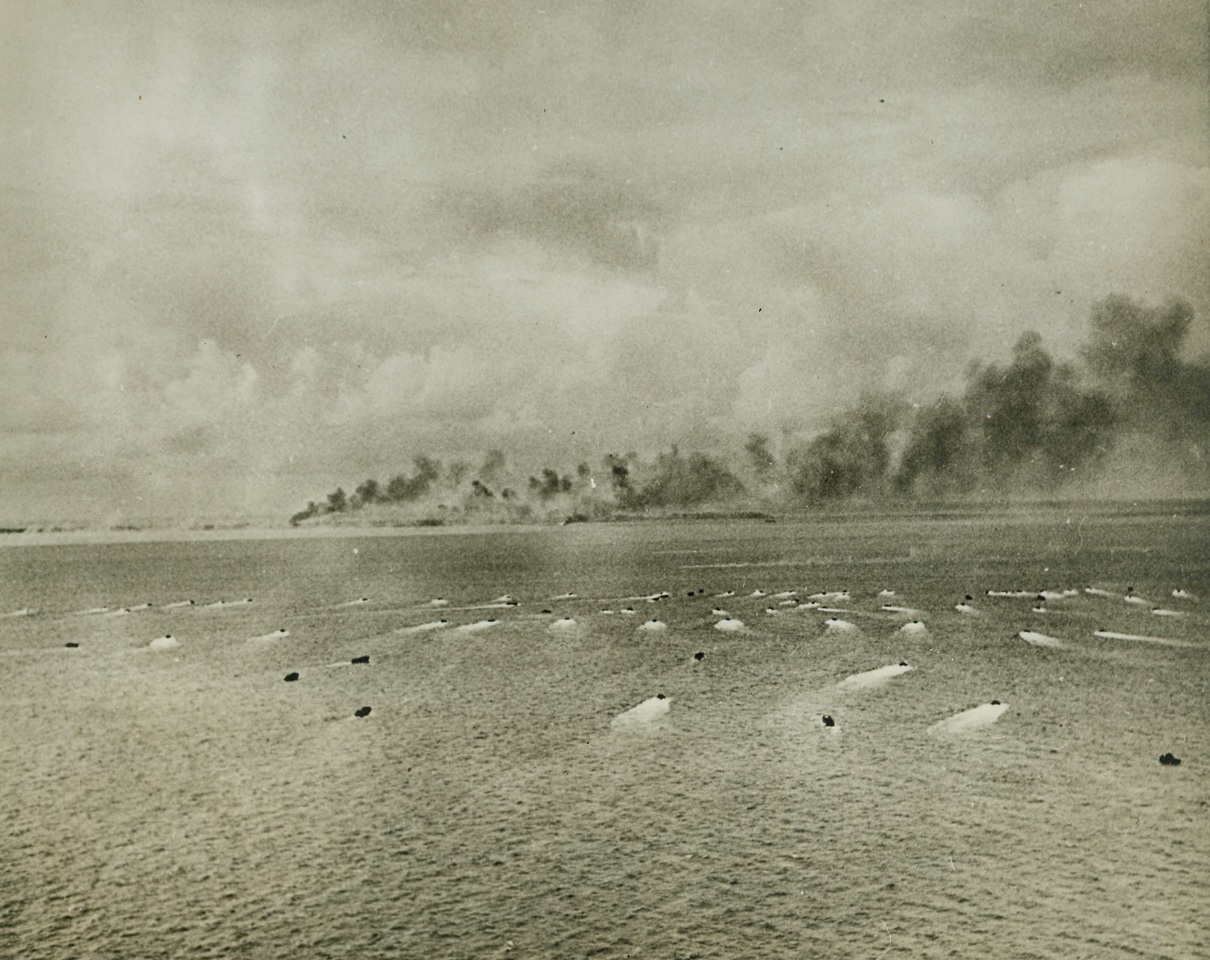
During Battle at Tarawa, 12/16/1943. This photo, taken from the air during the battle for Tarawa, shows landing craft streaking for the shore loaded with U.S. troops, while in the background columns of smoke mark an island of the Tarawa group under heavy bombardment by Allied Air and Sea Forces. The battle was the bloodiest in the history of the U.S. Marine Corps, and both Japs and Americans lost heavily. (Passed by Censors) Credit: ACME
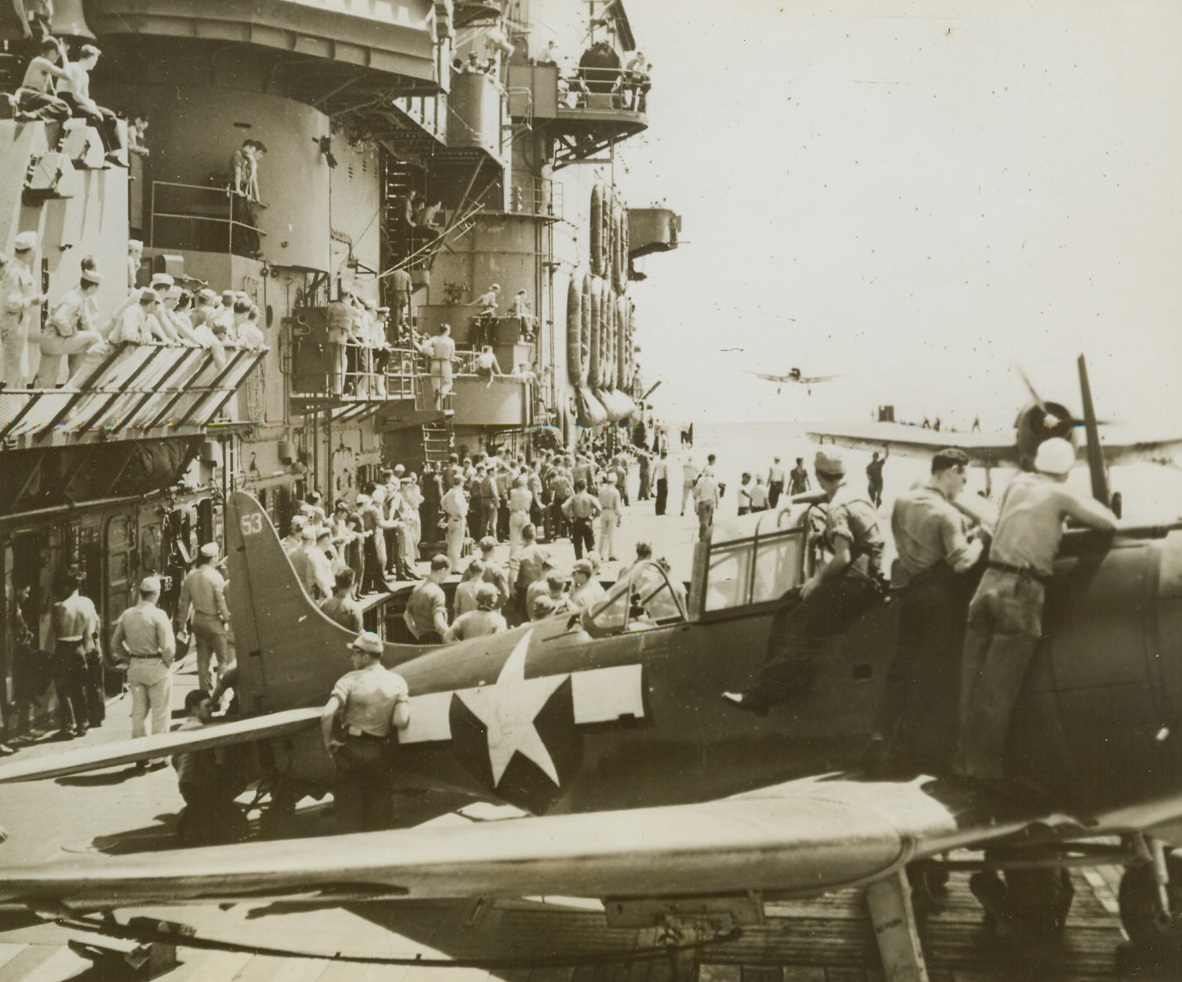
Checking in After Rabaul Raid, 12/16/1943. South Pacific – The flight deck of the Aircraft Carrier USS Saratoga, represents a neat problem in handling traffic, as planes come in after the raid on the Jap base at Rabaul, New Britain, last Nov. 5. The raid was credited with severely crippling the Nip stronghold, and it was reported abandoned after a subsequent raid. Here, a Douglas Dauntless (SBD) Dive Bomber, (foreground), is checked in while, beyond, another taxies up after landing, its prop still spinning. In the background, a third SBD comes in for a landing. Credit: U.S. Navy Official photo from ACME;
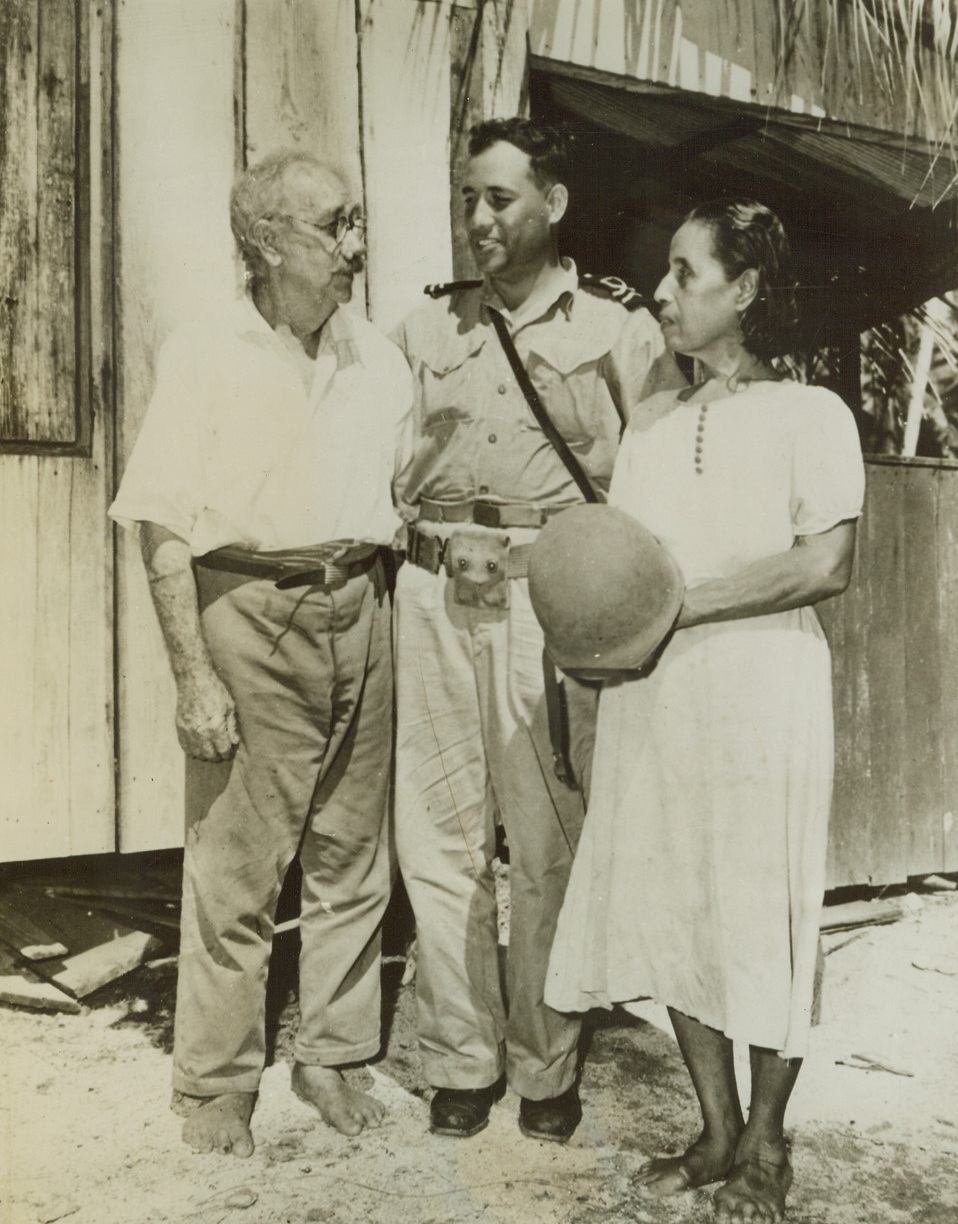
Reunion on Makin, 12/17/1943. Makin, Gilbert Islands – After nine years of separation, Lt. Bruno Raymond, Royal Australian Naval Volunteer Reserve, meets his father, Moritz (left), and his half-native mother, Maria, after going ashore on newly-captured Makin Island. Lt. Raymond, who is attached to the U.S. Navy as a pilot, was born in the Gilbert Islands. His parents lived on Makin all during the Jap period of occupation. Credit: ACME;
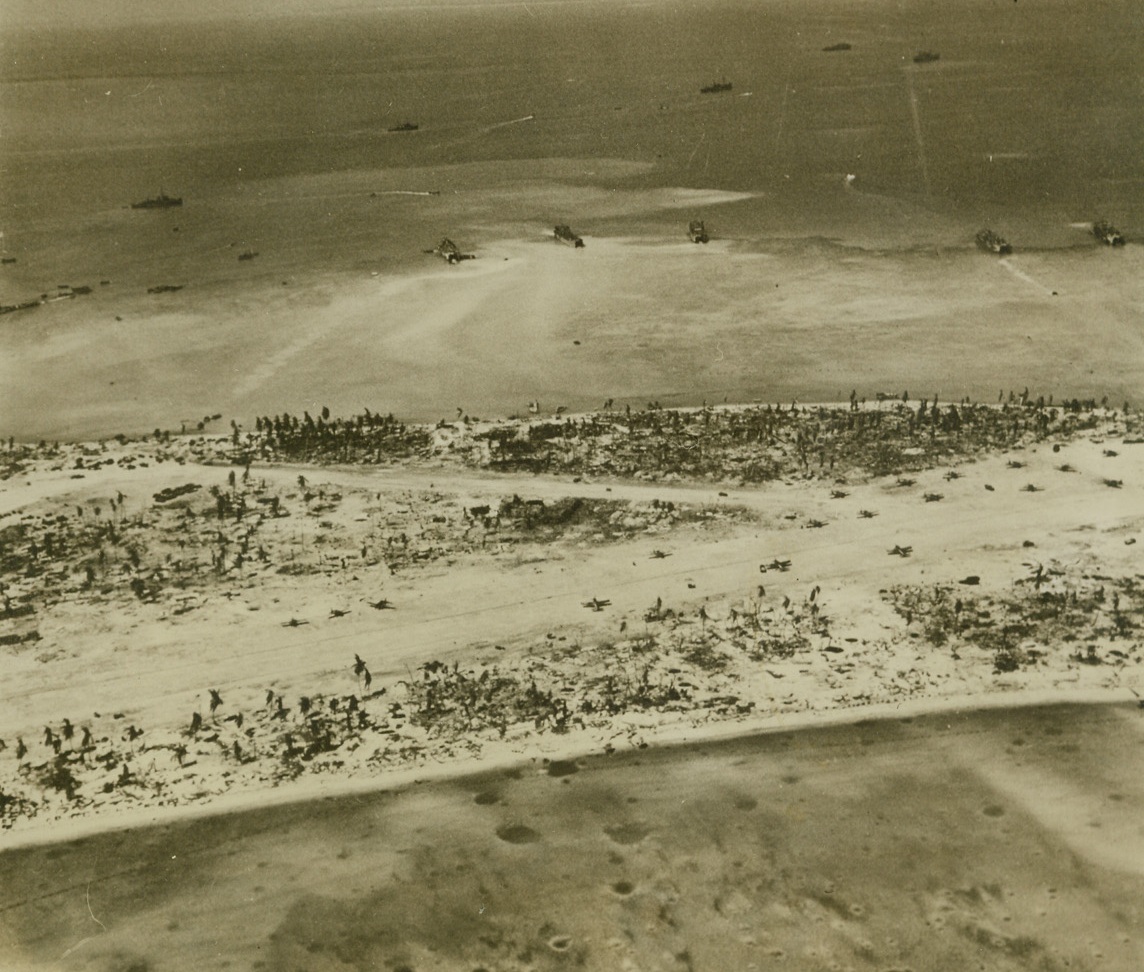
After the Battle at Tarawa, 12/16/1943. CME; Betio Island, part of the Tarawa group, shows considerable evidence of the terrific fire concentrated on it during the battle for Tarawa, by Allied Sea and Air Forces. Shell craters pock the tiny strip of land and the shallow water near it, and palm trees have been stripped of their foliage by the fury of the battle. Planes along the air strip are American planes Credit;
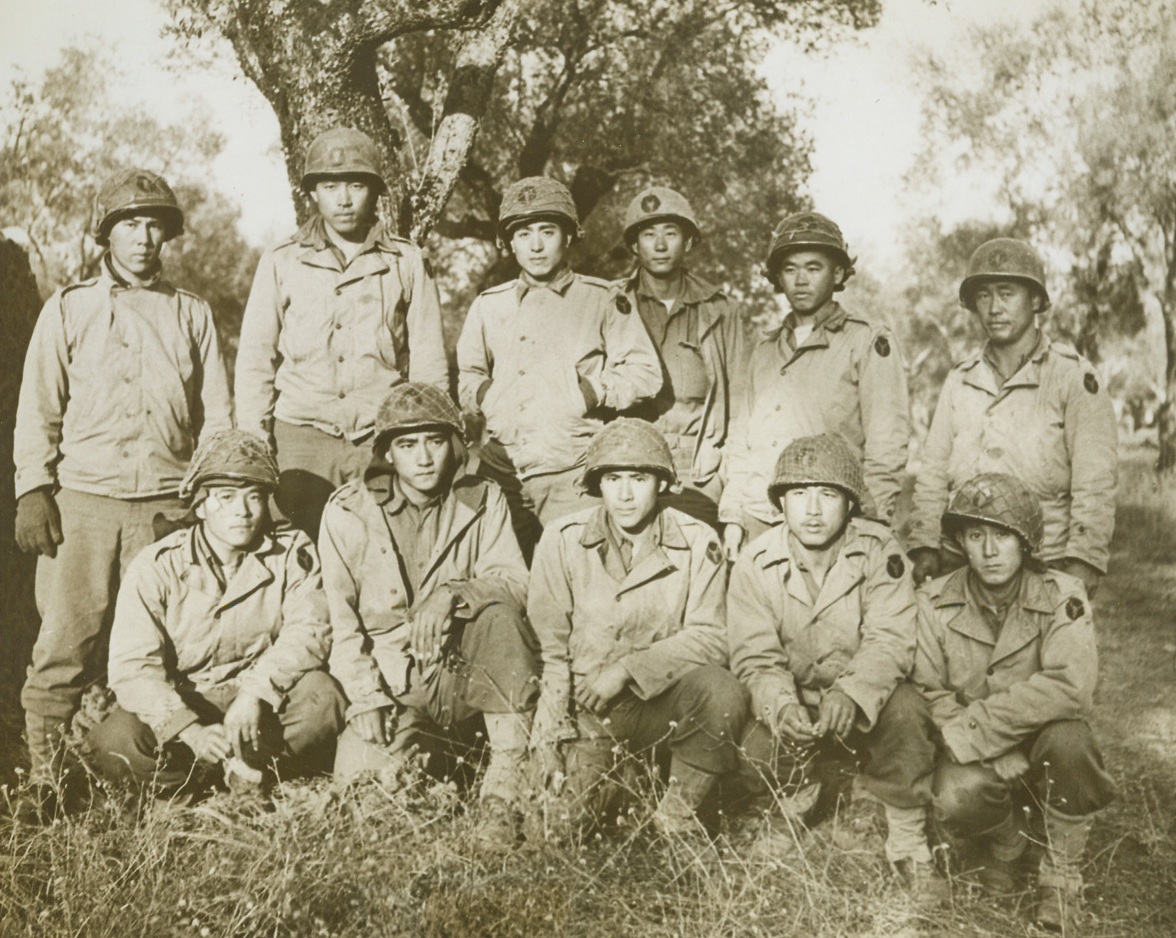
Only Hate For Hirohito, 12/10/1943. JAPAN—These few U.S. Army Japanese are all that remain of a platoon that accomplished its mission of securing an Italian road junction ably defended by enemy machine guns. After successfully flanking their objective, they were attacked by an enemy tank and the platoon leader was the first man killed. Continuing the attack under their sergeant, the fighters knocked out the tank with a bazooka and shot the escaping crew. Then, under heavy fire, they attacked the machine gun positions, killing the German gunners and securing the position with a heavy loss of their own. Credit: ACME;
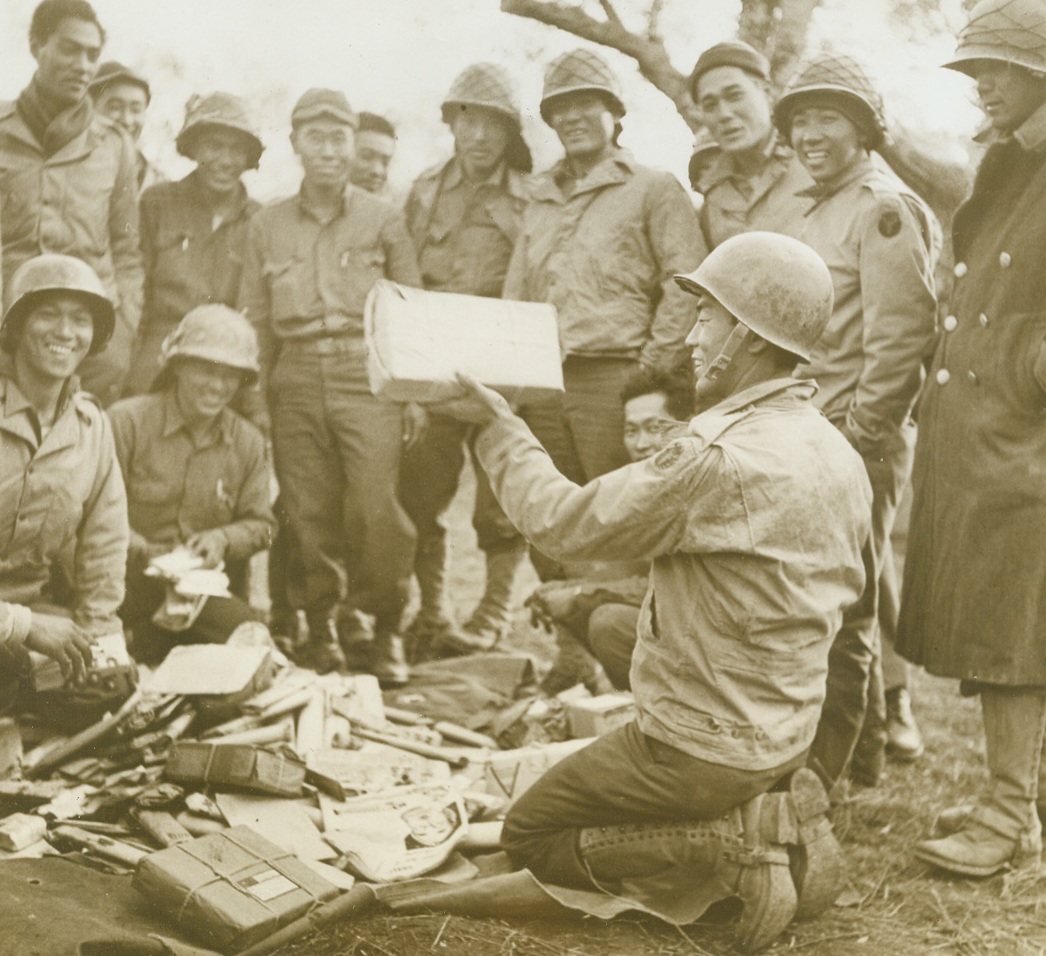
Only Hate For Hirohito, 12/4/1943. JAPAN—A package of rice sent all the way from Honolulu draws amazed cheers from the U.S. Army Japs in their bivouac as mail arrives. Credit: ACME;
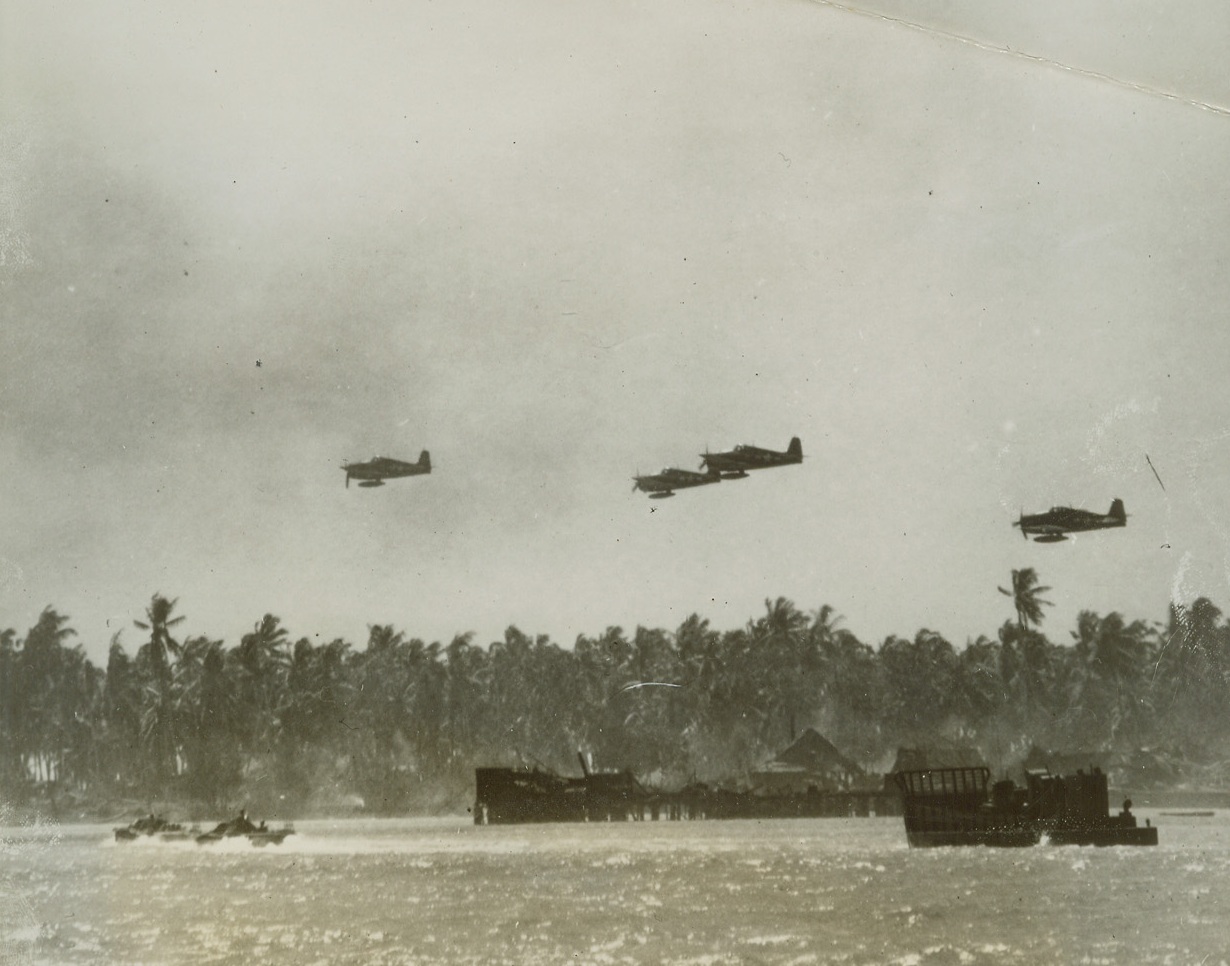
Air, Sea Assault Spearheads Yank Invasion of Makin, 12/3/1943. CME; MAKIN, G.I.—In one of the first Makin Island action pictures to reach the United States, American planes come in low over their own invasion craft to strafe Japanese machine gun nests on the enemy-held Gilbert base. This photo was made as the first wave of our assault troops moved in on the Japs on November 21. Credit;
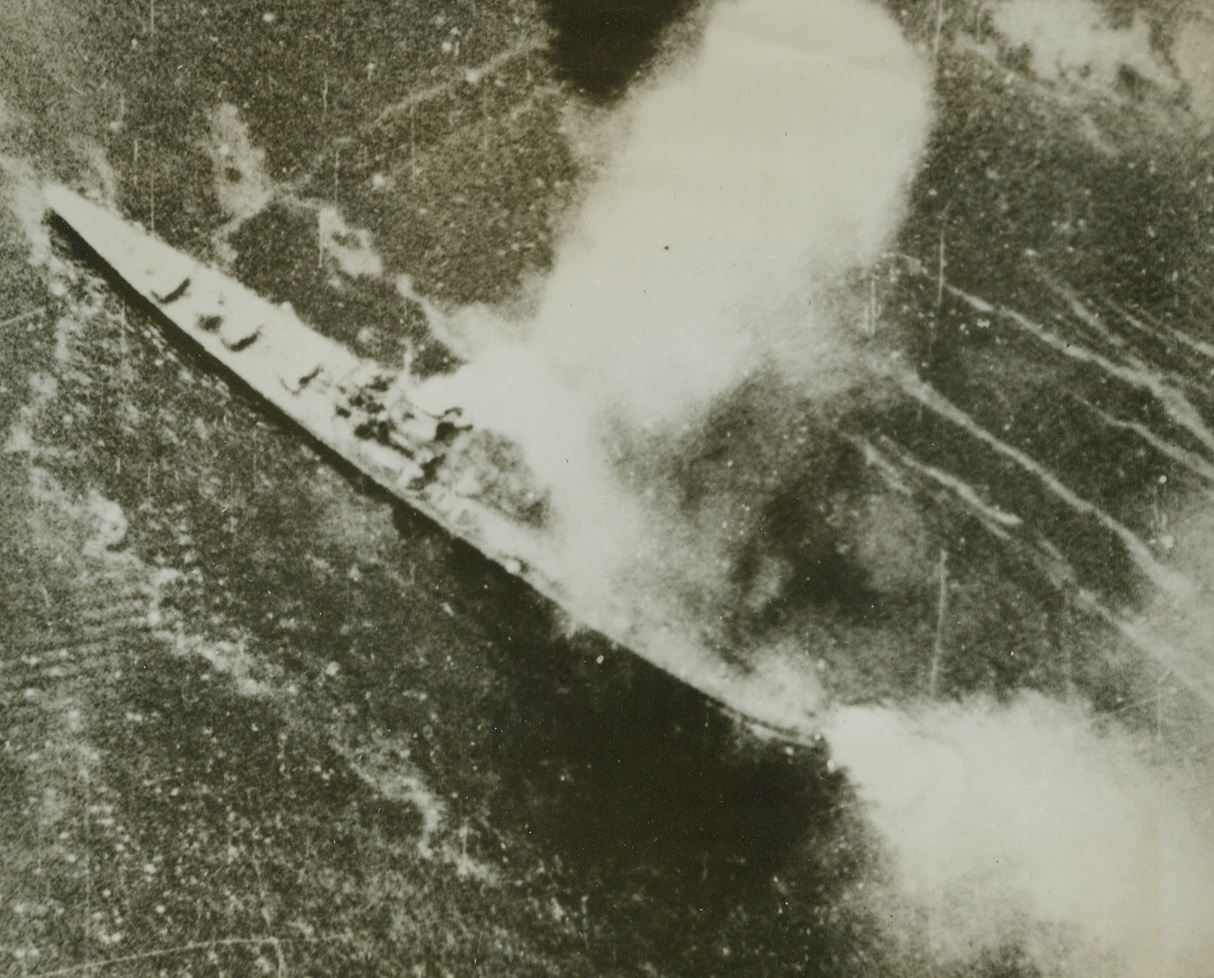
One Less Ship to Go, 12/6/1943. WASHINGTON, D.C.—A direct hit amidship rock a Jap heavy cruiser, as U.S. Navy dive-bombers and torpedo planes smash the enemy base at Rabaul Harbor. In two raids on the big Japanese island base, November 5th and November 11th, our Navy planes sank or damaged over 20 warships. Credit: Official U.S. Navy photo from ACME;
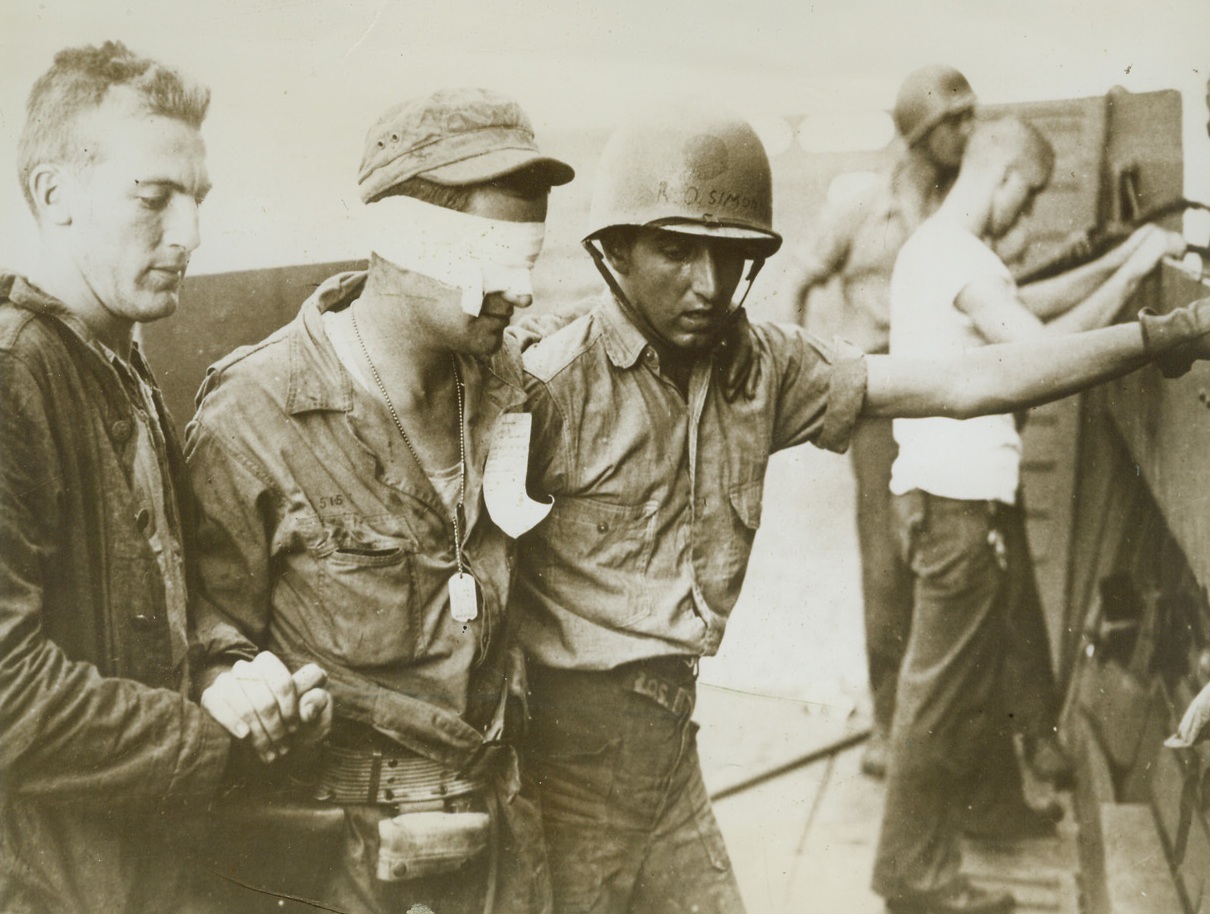
A Yank Leaves Makin, 12/5/1943. MAKIN—Flying enemy shrapnel found the eyes of this U.S. Army private, who wears bandages as he leaves Makin Island. Two medical corpsmen assist the Yank, who helped our forces gain possession of the central Pacific atoll, to board a transport. Credit: ACME;
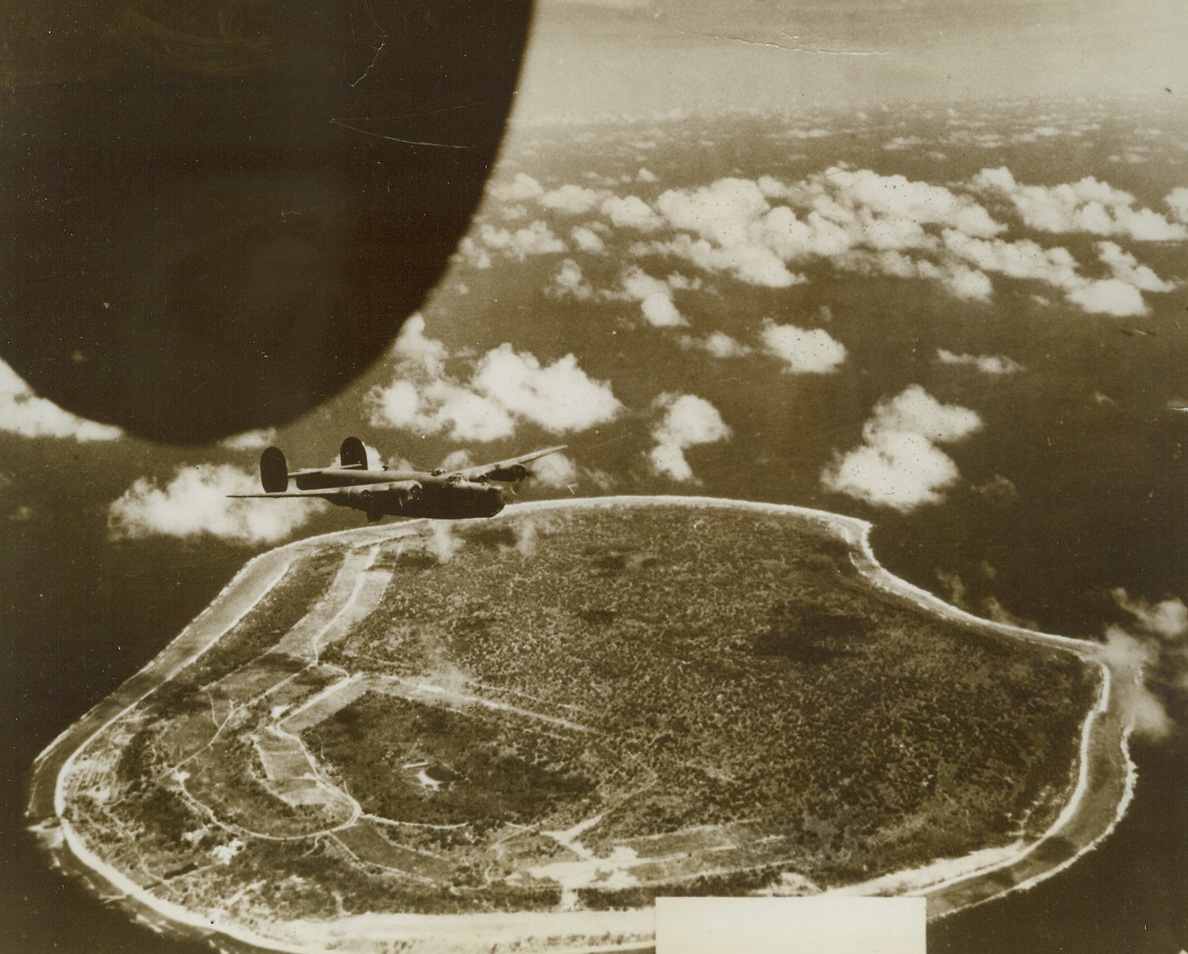
Army Bombers Raid Nauru, 12/5/1943. NAURU—As Yank forces battled for possession of Gilbert Island bases, our airmen winged over Jap-held Nauru Island, carrying out our new offensive in the central Pacific. Here, an American Liberator flies above Nauru in the raid of November 21st. Credit: USAAF photo—ACME;
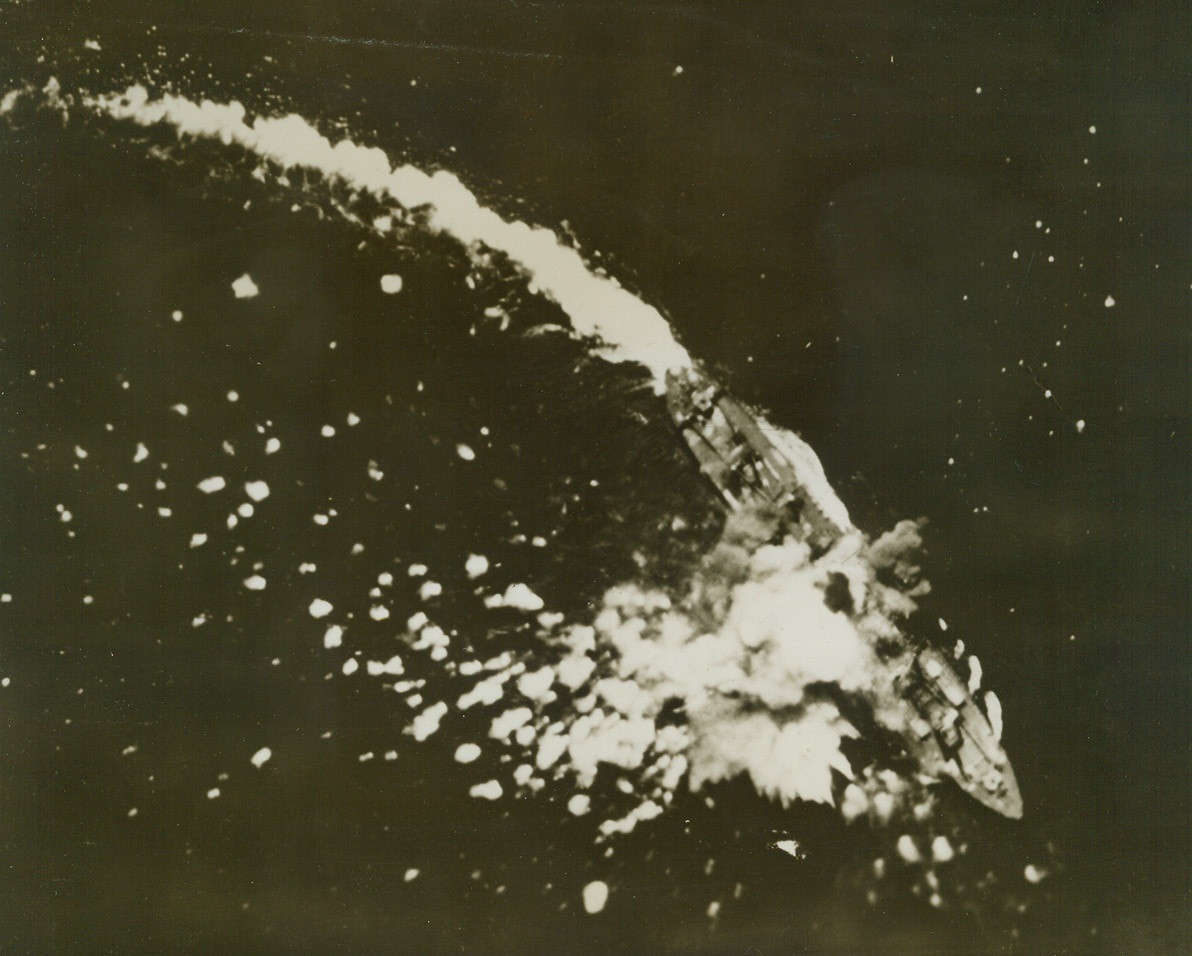
Gotcha!, 12/7/1943. The direct hit of a 1000-pound bomb blasts this 8000-ton Jap transport to smithereens. Lt. Don Scurlock of Butler, Alabama, one of the U.S. Fifth Air Force’s crack bombardiers, is credited with this bombing, off the coast of Kavieng, New Britain Island, on November 21st. This is an original of the radiophoto sent recently from the southwest Pacific. Credit: U.S. Army Air Forces photo from ACME;
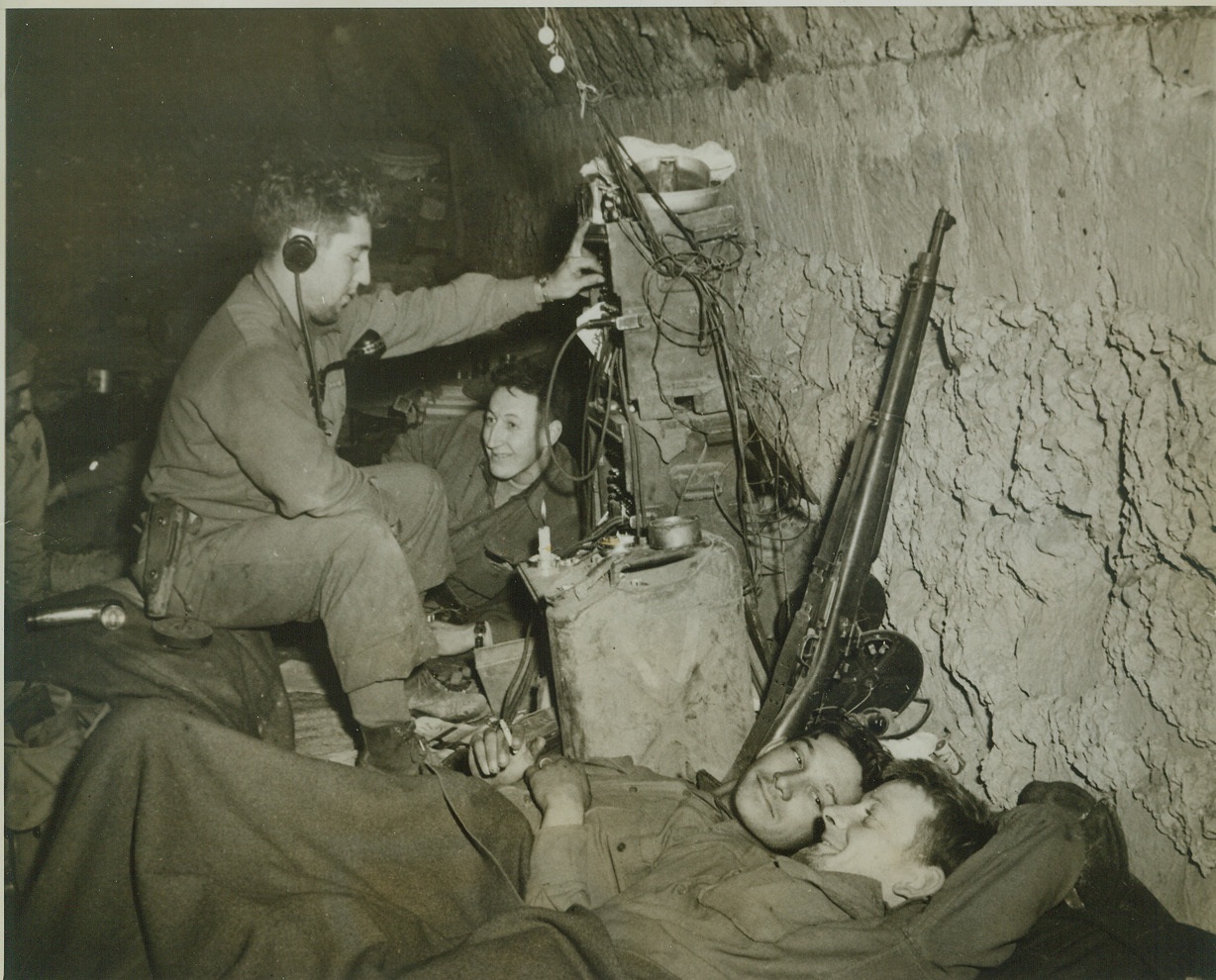
Entertainment Courtesy A. Hitler, 12/19/1943. MIGNANO, ITALY -- A German radio, found on a battlefield, provides entertainment for these American soldiers as they "bivouac" in an old wine cellar (minus the wine) in Mignano, after their battle for the Italian town. At the switchboard is Pfc. Howard L. Saddler of Canton, Ohio. Pvt. Theodore Zembuiski of Albany, NY, lounges in background, while (left to right) Pvt. Thomas G. Cross of Buffalo Gap, Texas, and Pfc. Norman S. Roy of Baltimore, MD., lie in foreground. Credit: (ACME);
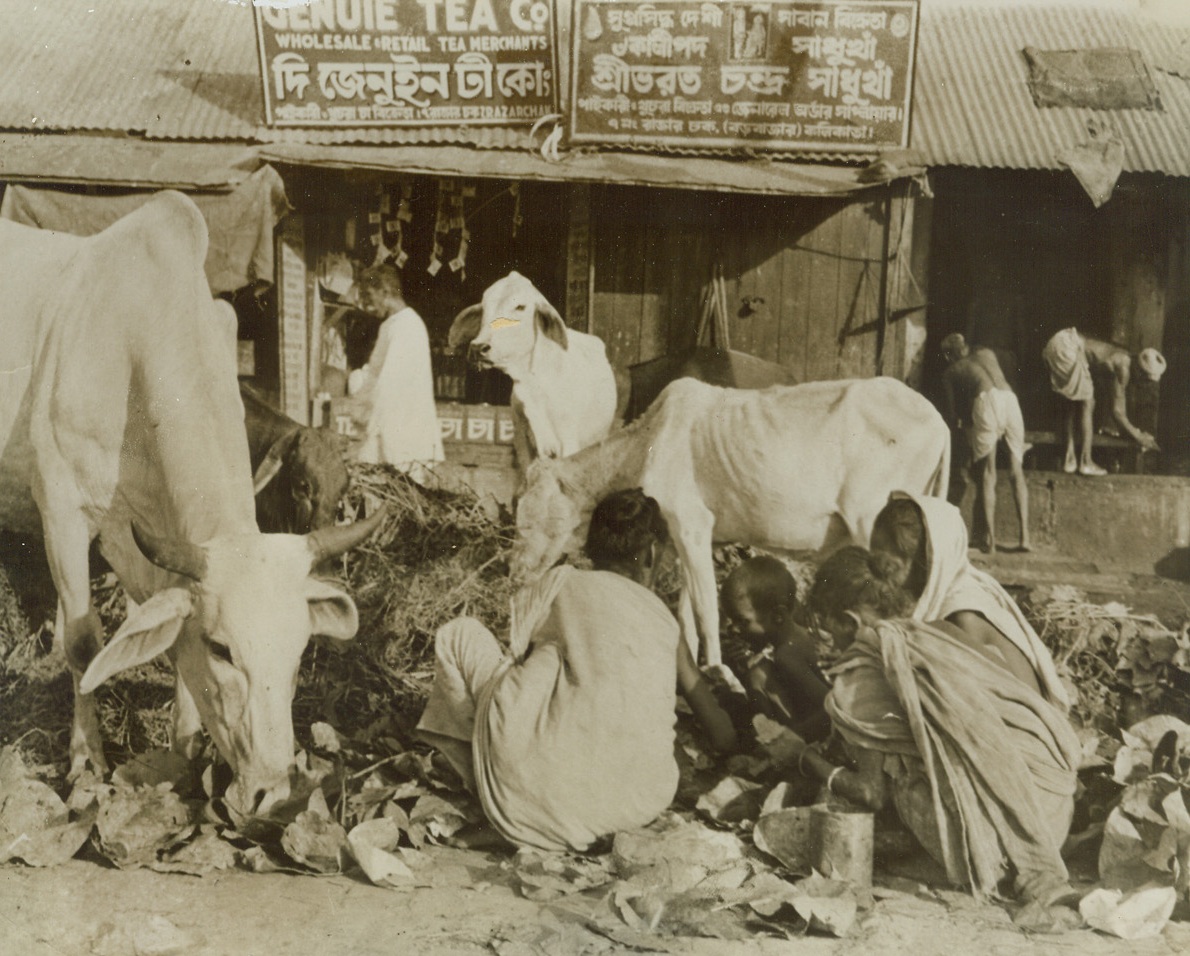
Famine In India, 12/17/1943. By last week, an estimated 1,000,000 persons had died of starvation in India and, although the British Government reportedly has the situation under control, that number will undoubtedly be raised before the final, tragic count is taken. Just released, these startling pictures were taken in Calcutta at the peak of India’s famine in late October when a homeless army of 100,000 roamed the city, dying in the streets.Sacred cows and dusky-skinned human beings rummage in the same Calcutta garbage pile for scraps of food. Even when death from starvation seems a certainty, no Indian would ever think of touching the Holy Meat.Credit: ACME;
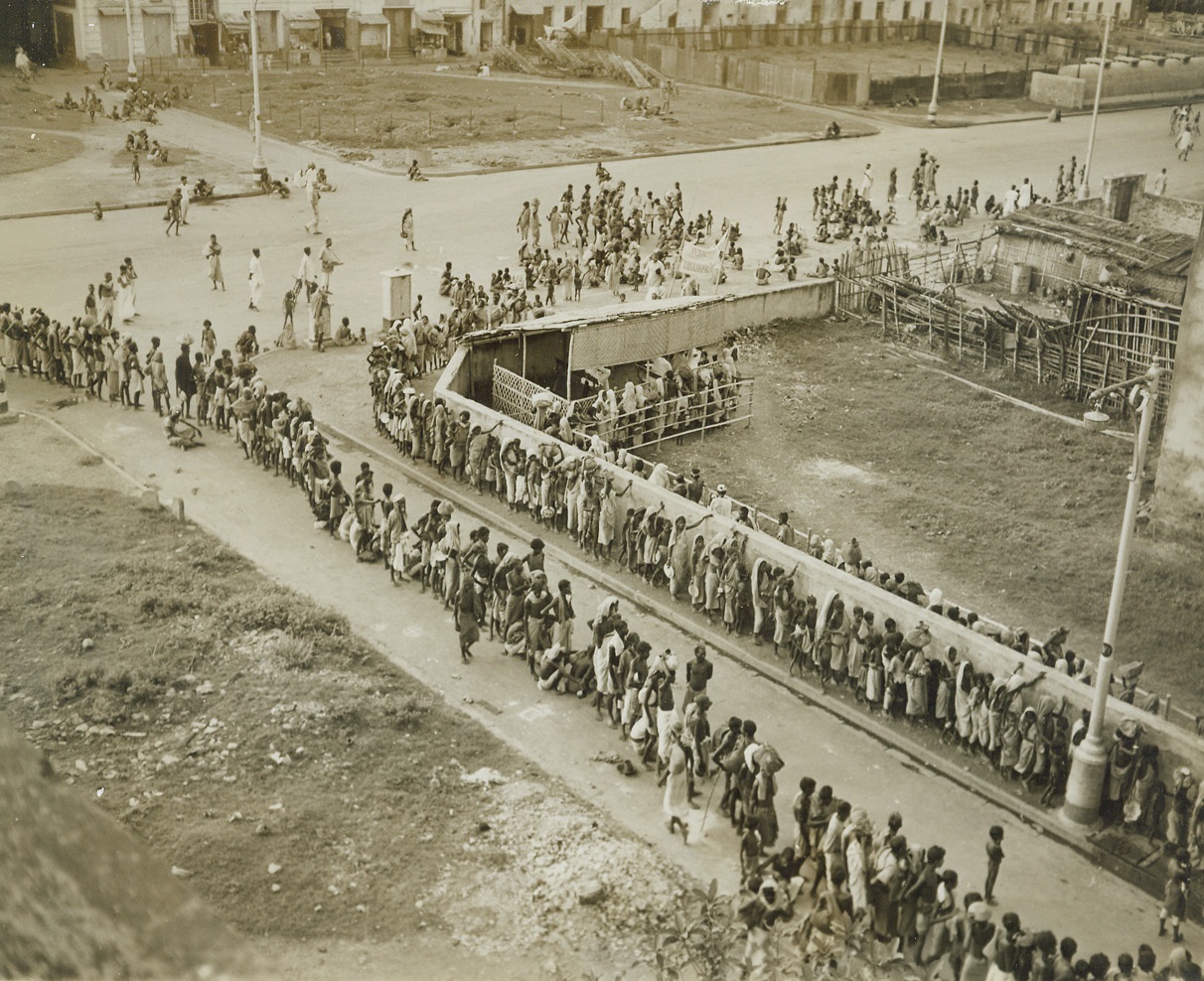
Famine in India, 12/17/1943. By last week, an estimated 1,000,000 persons had died of starvation in India and, although the British Government reportedly has the situation under control, that number will undoubtedly be raised before the final, tragic count is taken. Just released, these startling pictures were taken in Calcutta at the peak of India’s famine in late October when a homeless army of 100,000 roamed the city, dying in the streets.A triple line of starving Indians drags toward a “soup kitchen” in Calcutta. Often, natives fell dead before reaching the food.Credit: ACME;
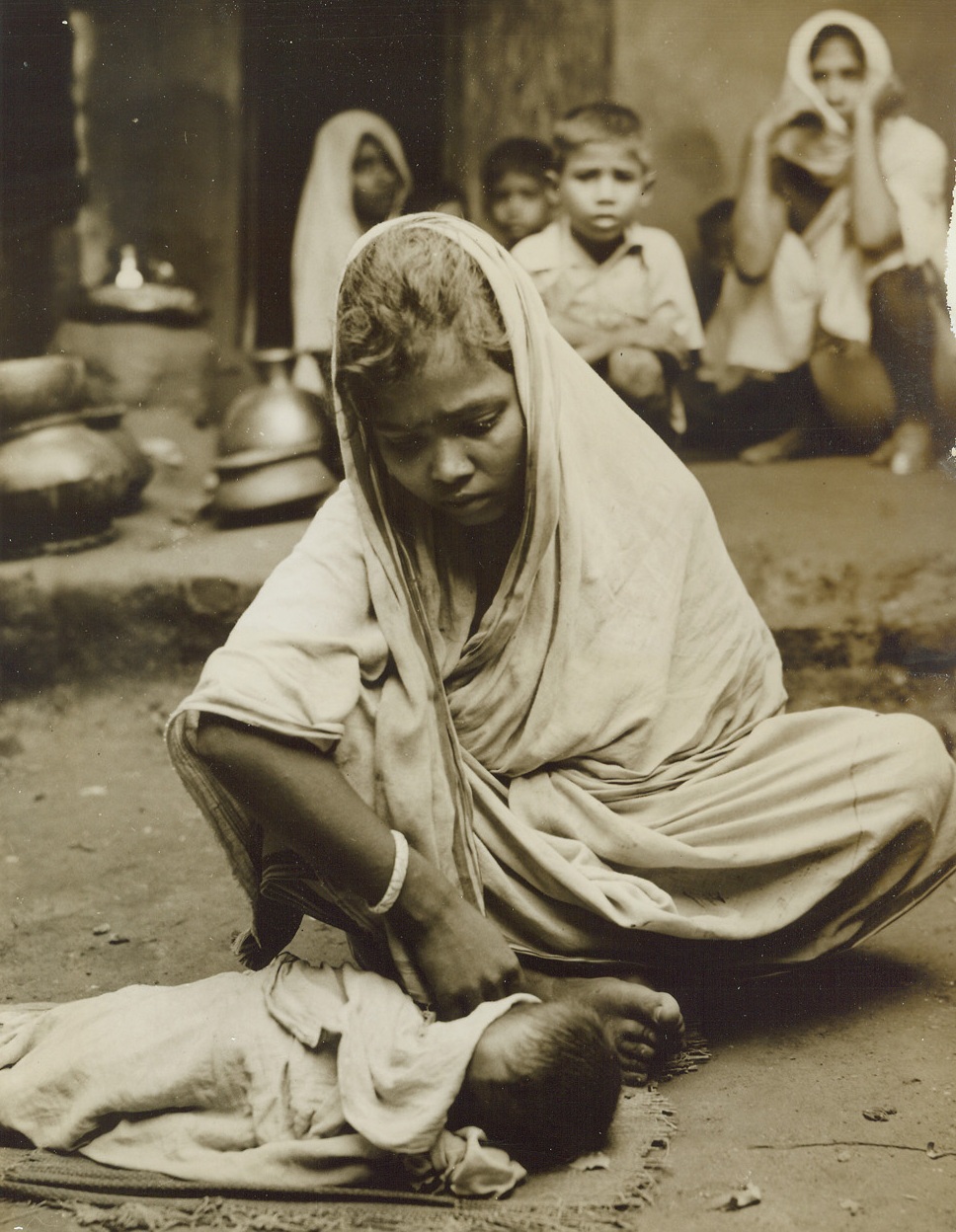
Famine in India, 12/17/1943. By last week, an estimated 1,000,000 persons had died of starvation in India and, although the British government reportedly has the situation under control, that number will undoubtedly be raised before the final, tragic count is taken. Just released, these startling pictures were taken in Calcutta at the peak of India’s famine in late October when a homeless army of 100,000 roamed the city, dying in the streets. New York BureauA young Indian mother covers the body of her baby who has just drawn a last weak breath. Now the homeless woman must wait for the corpse removal squad that picks up the bodies of children who starved to death. Credit Line (ACME);
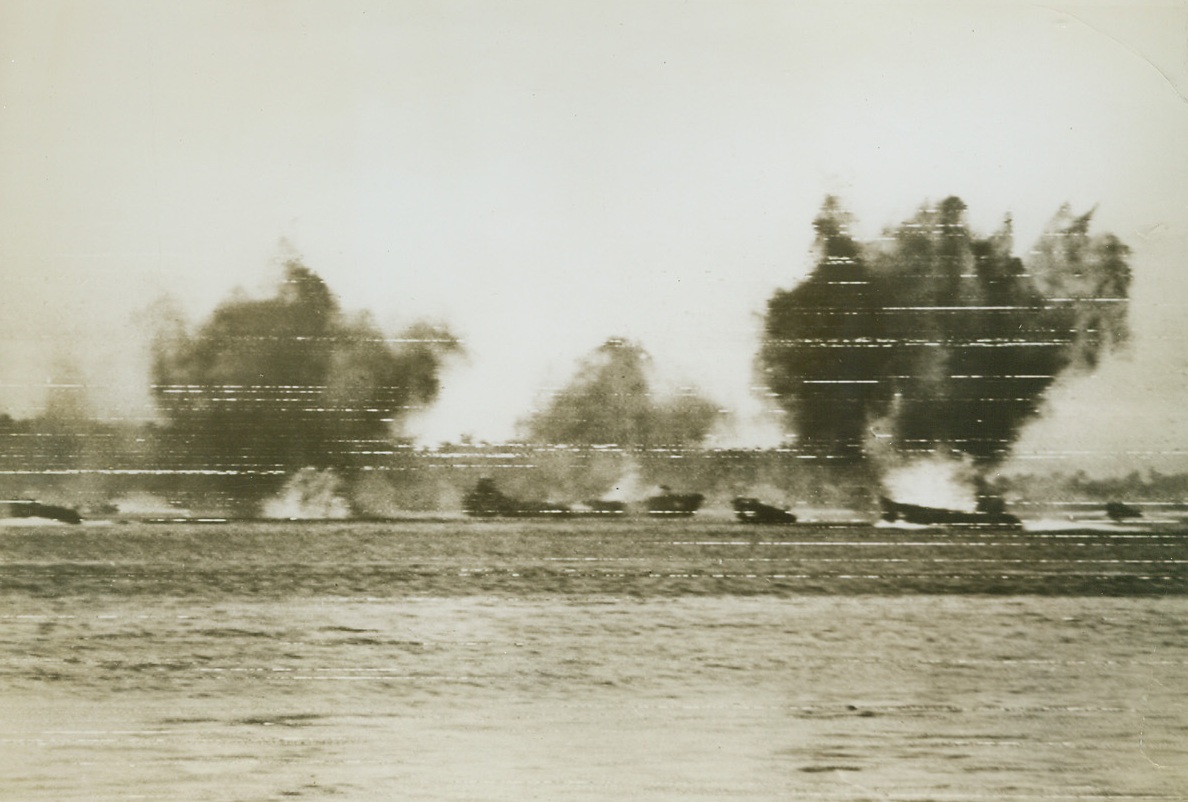
Bombs Fall on the Invaders, 12/18/1943. Arawe, New Britain - Clouds of thick, black smoke rise from the water as Japanese planes bomb and strafe American landing craft during the yank invasion of New Britain, at Arawe. Miraculously, no ships were hit during the bombing. Only two LCV’s were lost in the entire operation. Credit (U.S. Signal Corps Telephoto - ACME);
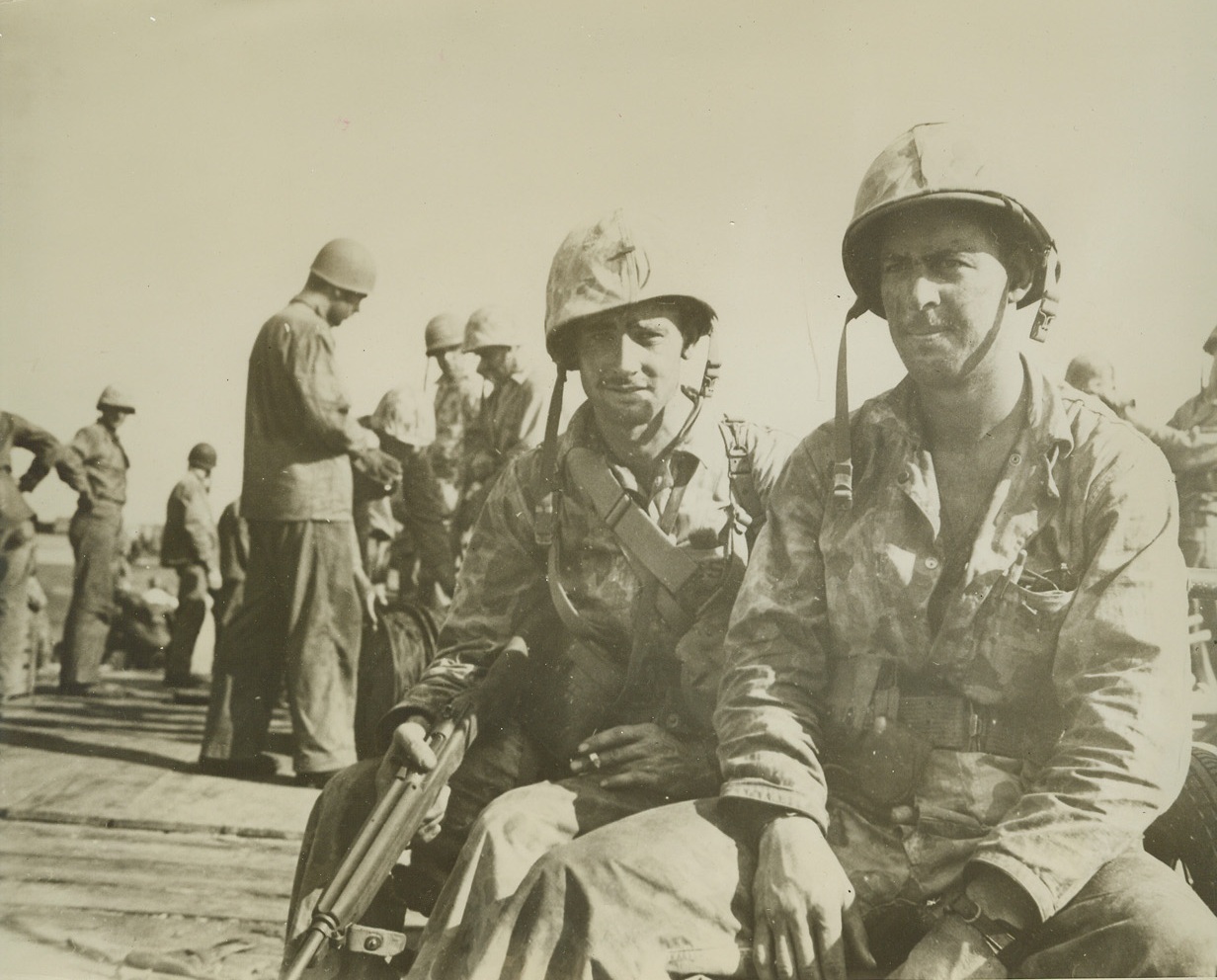
Southerners in Fray, 12/1/1943. Tarawa, G.I. - - Both Southerners, both Marines, Lt. Cecil Brown (L), 27, of Tallassee, Alabama, and Lt. Roy H. Elrod, 24, of Muleshier (??- - - postal guide lists no such town, but does list Muleshoe), Texas, rest on a pier after successful assault against Japanese of Tarawa. Even while resting Lt. Brown keeps his rifle at the ready.Credit (ACME);
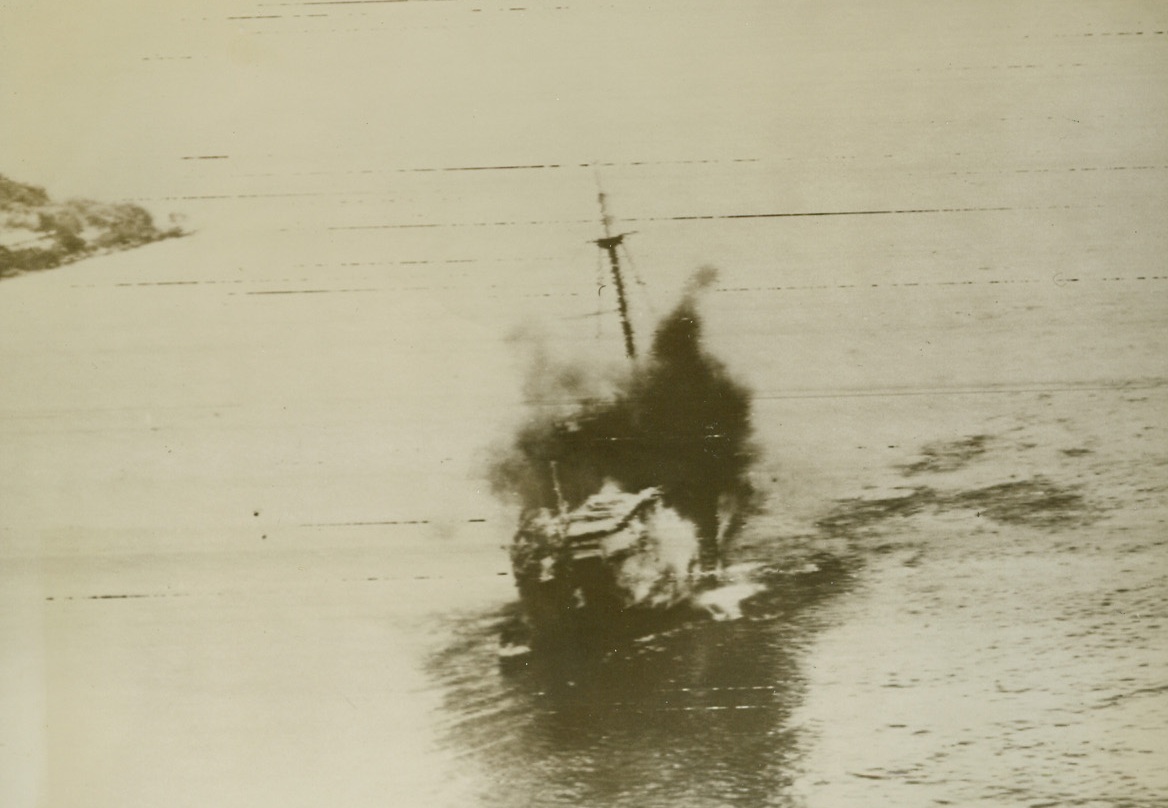
Jap Transport Hit by “Flying Bertha”, 12/2/1943. A Japanese freighter-transport burns fiercely after being raked with 75 mm, shellfire from a U.S. “Flying Bertha” – B-25 Mitchell bomber mounting a 75 mm. Gun – near the powerful Jap base at Wewak in the Southwest Pacific. The Fifth U.S. Air Force has just announced that it has been using Mitchells mounting the heavy cannon for some time.Credit Line (U.S. Signal Corps radio telephoto from ACME);
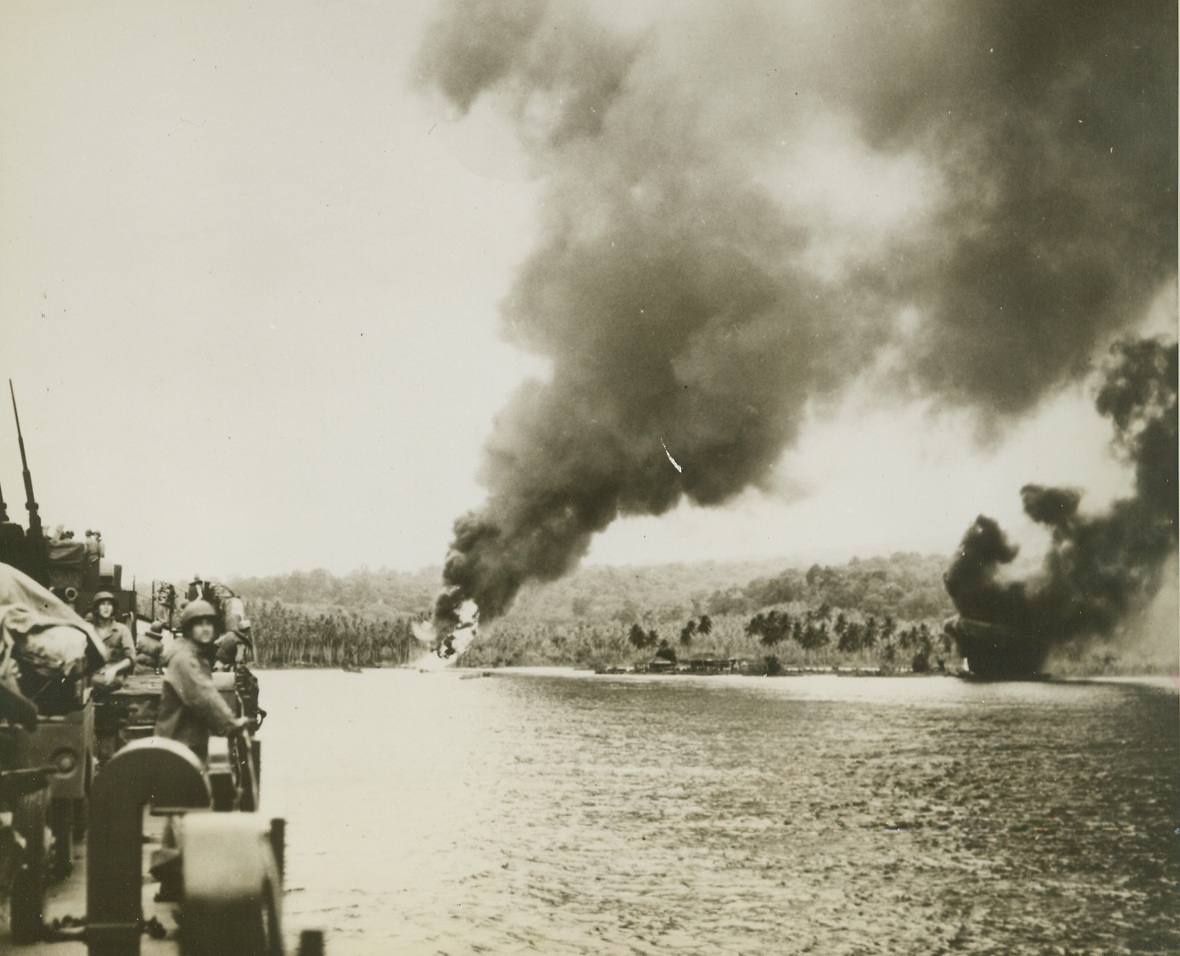
Enemy Inning, 12/28/1943. Guadalcanal, S.I. - - Jap bombers provided this sobering welcome for a U.S. Navy warship sailing into port at Guadalcanal. Flames still burn brightly from hits registered by the enemy who left a short while before the ship entered the port. Gun crews aboard ship stand by at their posts, ready to greet the - - - Japanese, when and if they return.Credit (U.S. Navy photo from ACME);
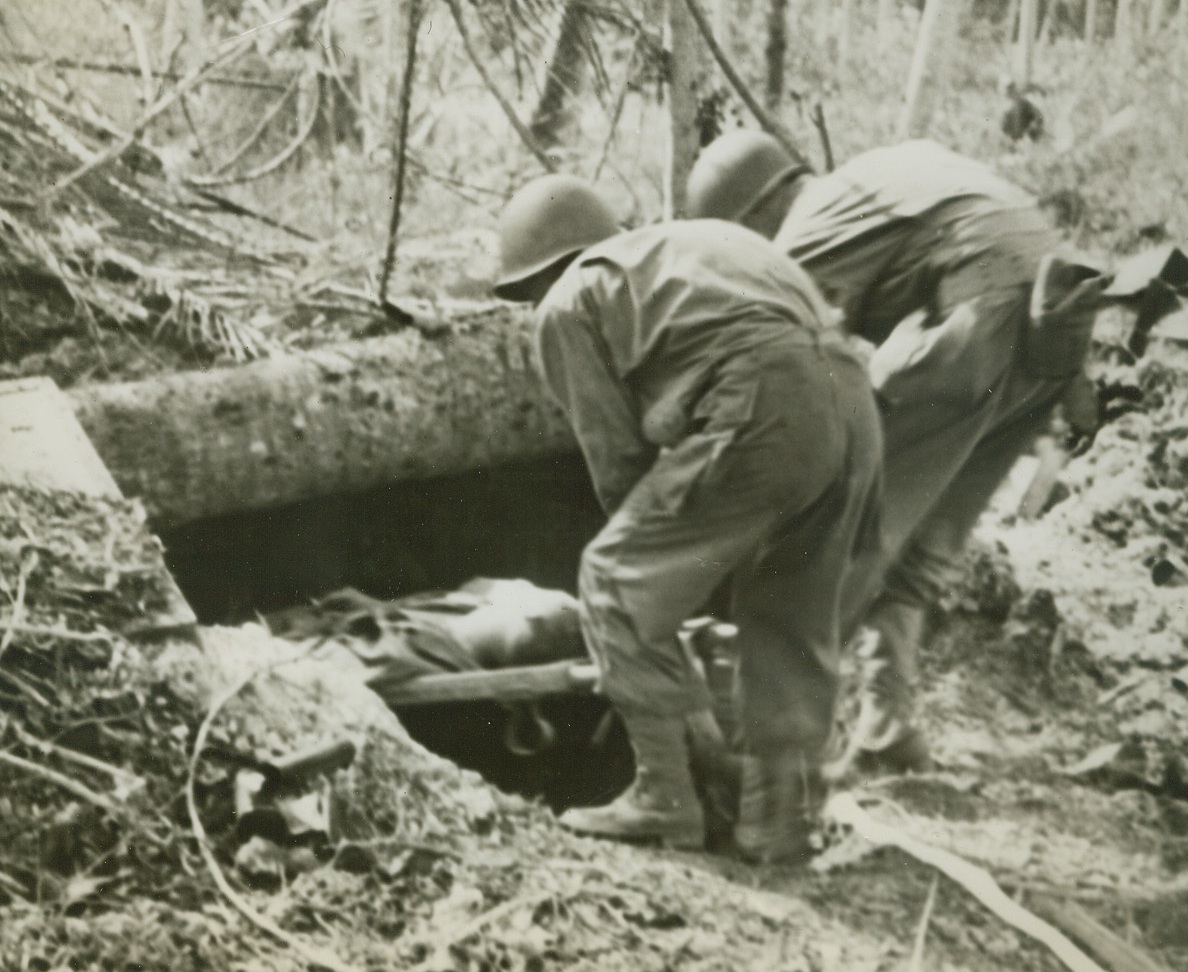
Shelter for Wounded, 12/28/1943. Arawe, N.B. – An American soldier, wounded in the invasion of New Britain, is lowered on a stretcher into a Japanese dougout for protection against the possible return of Nipponese planes. Credit (ACME);
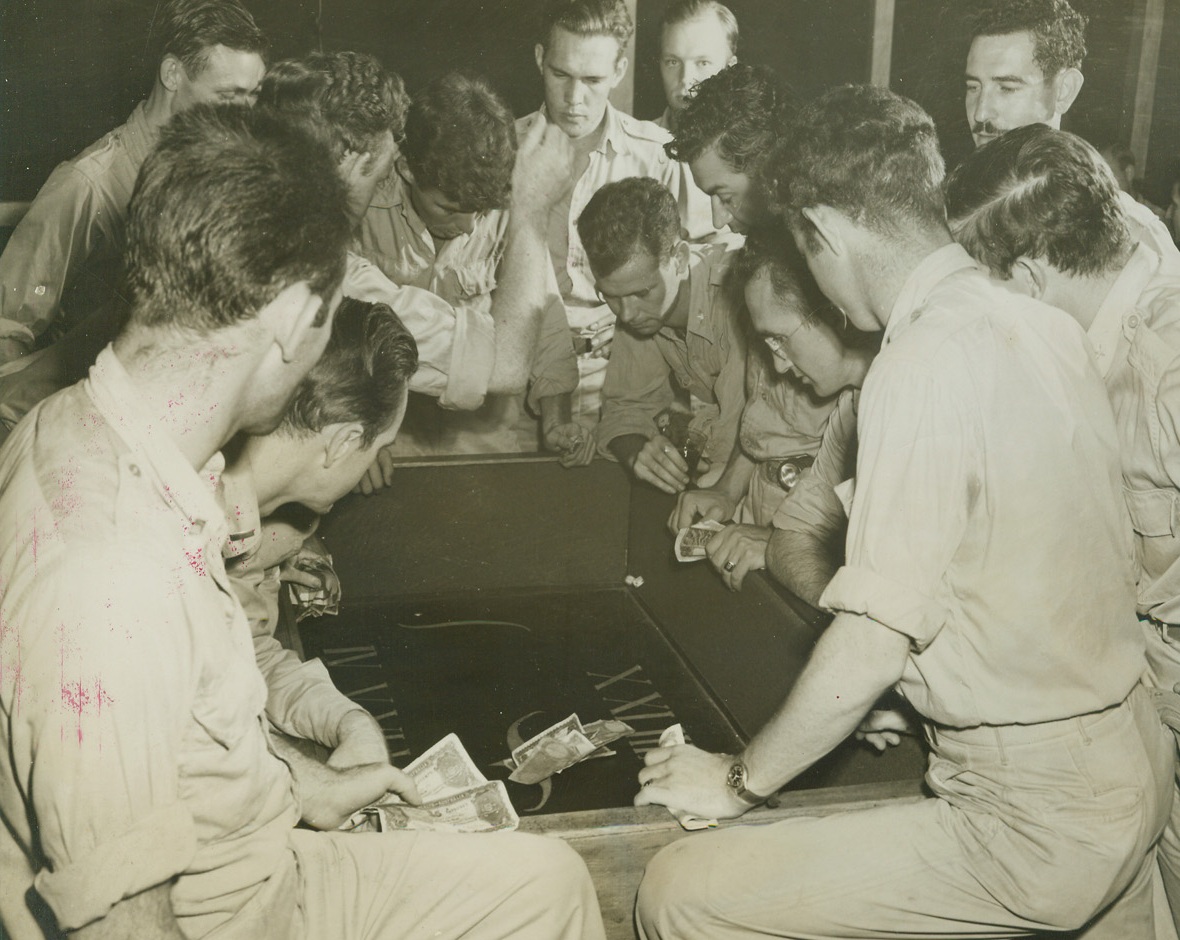
FUN FOR THEIR MONEY, 12/10/1943. NEW GUINEA—Gambling is most definitely “legal” on New Guinea, and Club Six Four, elegant officers’ club belonging to members of an advanced 5th. Air Force bombing unit even has its own gambling room. Soldiers crowd close around the dice table. Ready to win—or lose—some of their Army pay. Credit: ACME PHOTO BY THOMAS L. SHAFER, WAR POOL CORRESPONDENT.;
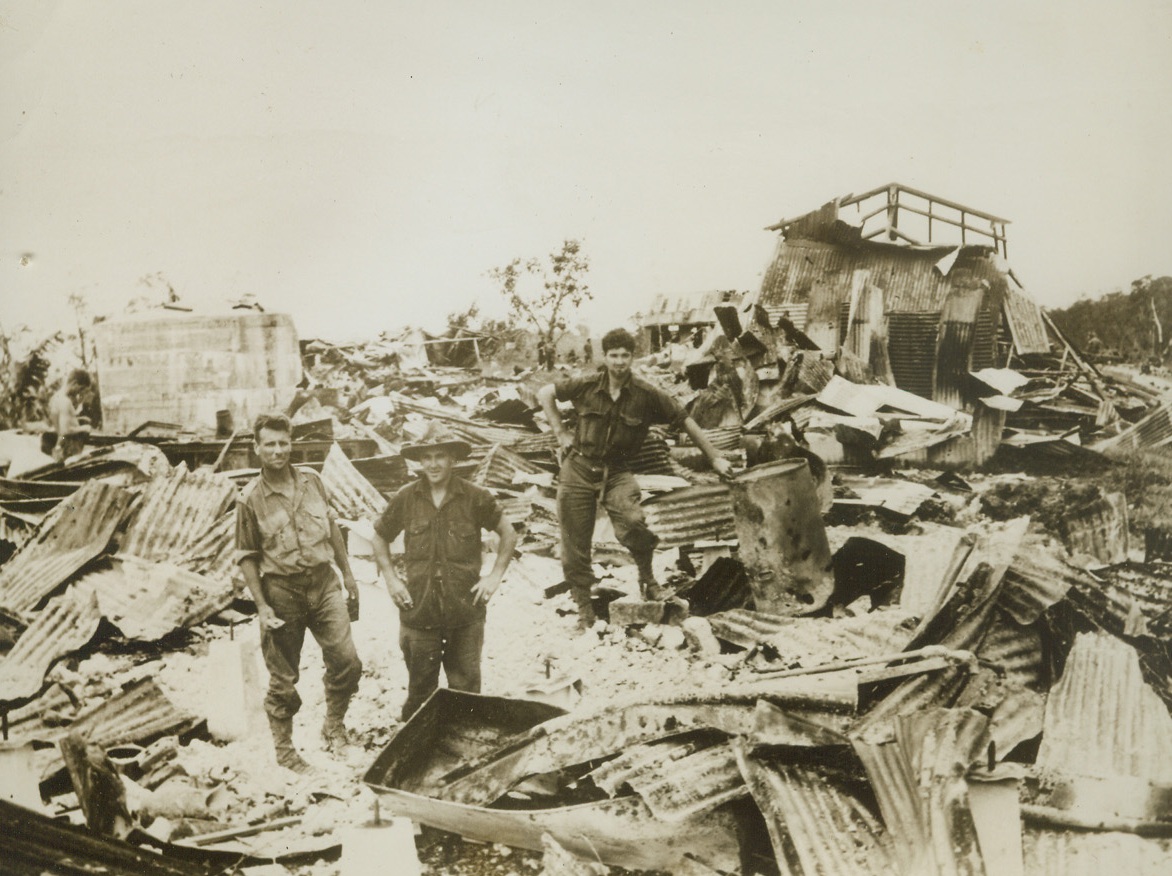
BIG GUN SHARP-SHOOTERS, 12/23/1943. NEW GUINEA—Australian fighters get eye-witness proof of their artillery and bombing accuracy, as they inspect Satelberg, village on New Guinea recently wrested from the Japs. Before seizing the enemy base, the Aussies subjected it to a terrific pounding from air and land.Credit: ACME.;
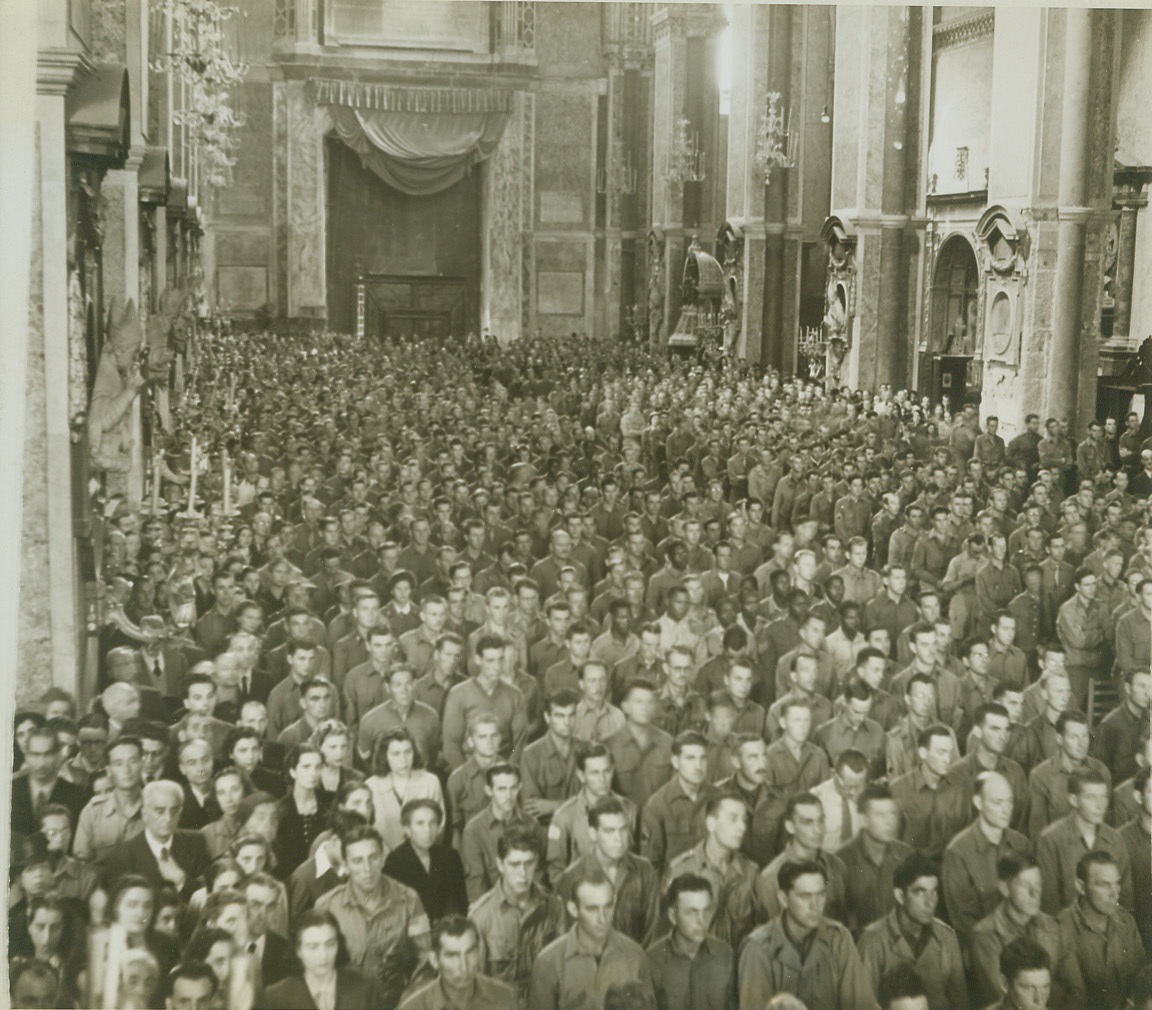
Celebrate Mass of Thanksgiving, 12/27/1943. NAPLES, ITALY -- Every inch of room in the Cathedral of Naples is occupied by a thankful populace and soldiers of liberation during a solemn mass of thanksgiving for the deliverance of Naples, celebrated October 17, by Allied chaplains of the Fifth Army. In attendance, too, was Alessio Cardinal Ascalesi, Archbishop of Naples. Credit (Photo by Charles Seawood, ACME Photographer for the War Picture Pool);
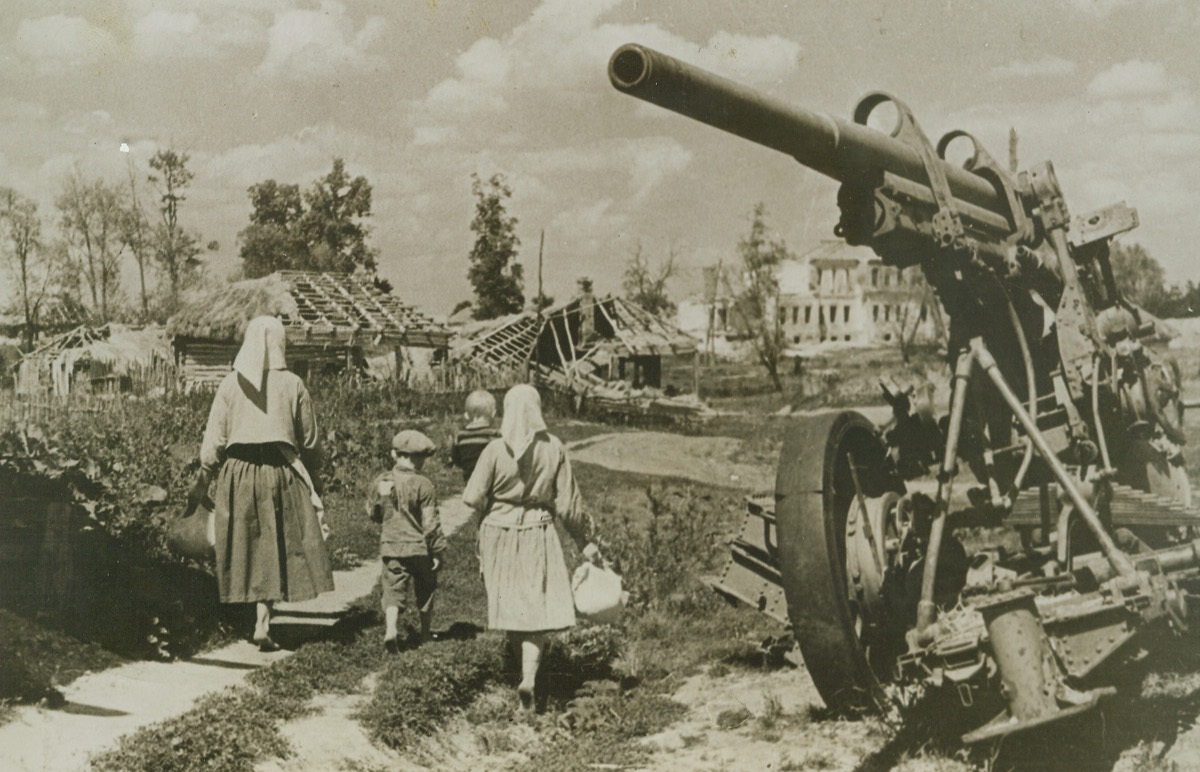
But It’s Still Home, 12/30/1943. Russia – They may find their homes reduced to a mound of bomb rubble, but these Russians walk with eager steps toward their town which was liberated by the Red Army on the Bryansk Front. The sound of the approaching Russian Army is a signal for Soviet civilians to crawl out of their huts and caves and return to their home towns which usually have been systematically destroyed by the Germans.Credit: ACME;
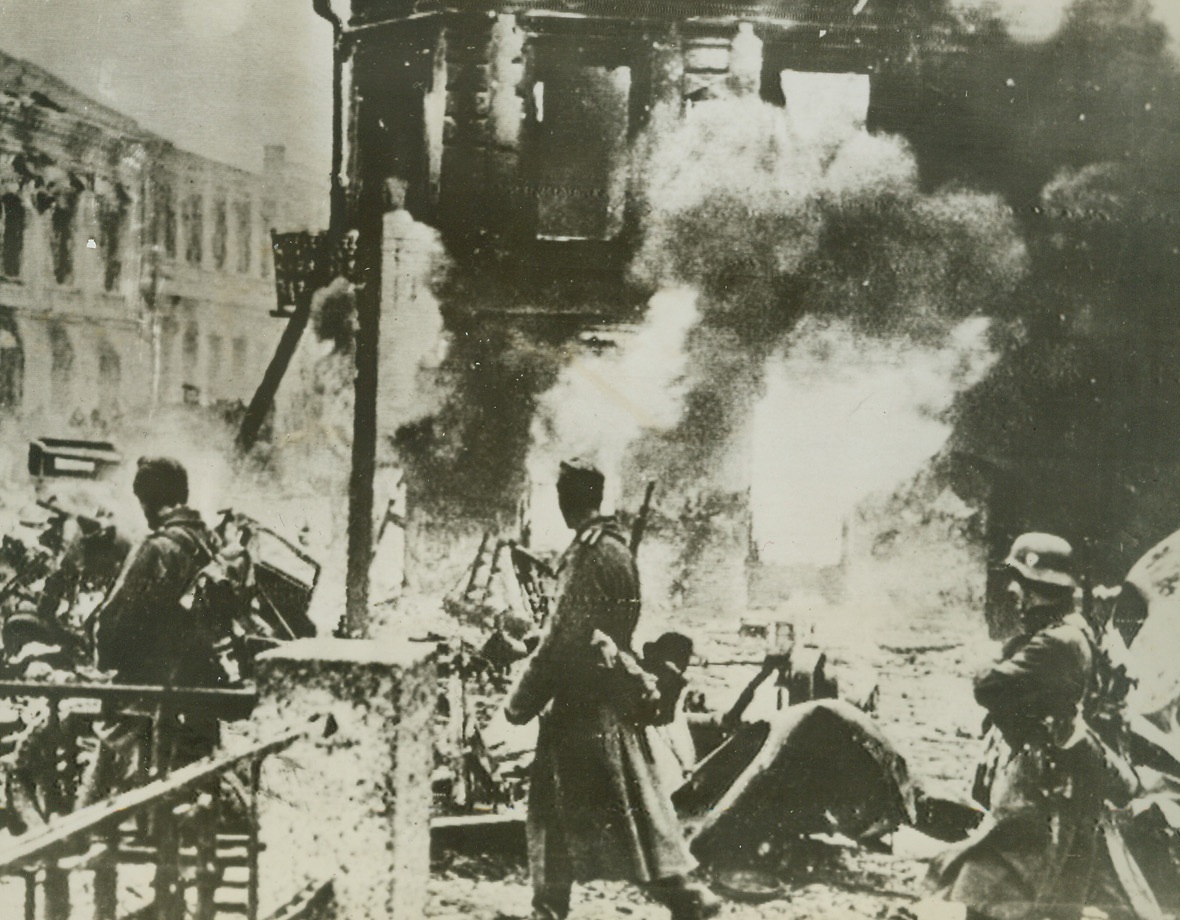
Nazis on the Run, 12/30/1943. Somewhere in the U.S.S.R. – Retreating, on the double, through a Russian town in the Kiev sector, these Nazi soldiers watch the village burn as they walk past. The entire town was systematically destroyed by the beaten Germans. Photo was radioed to London from a neutral source.Credit: ACME;
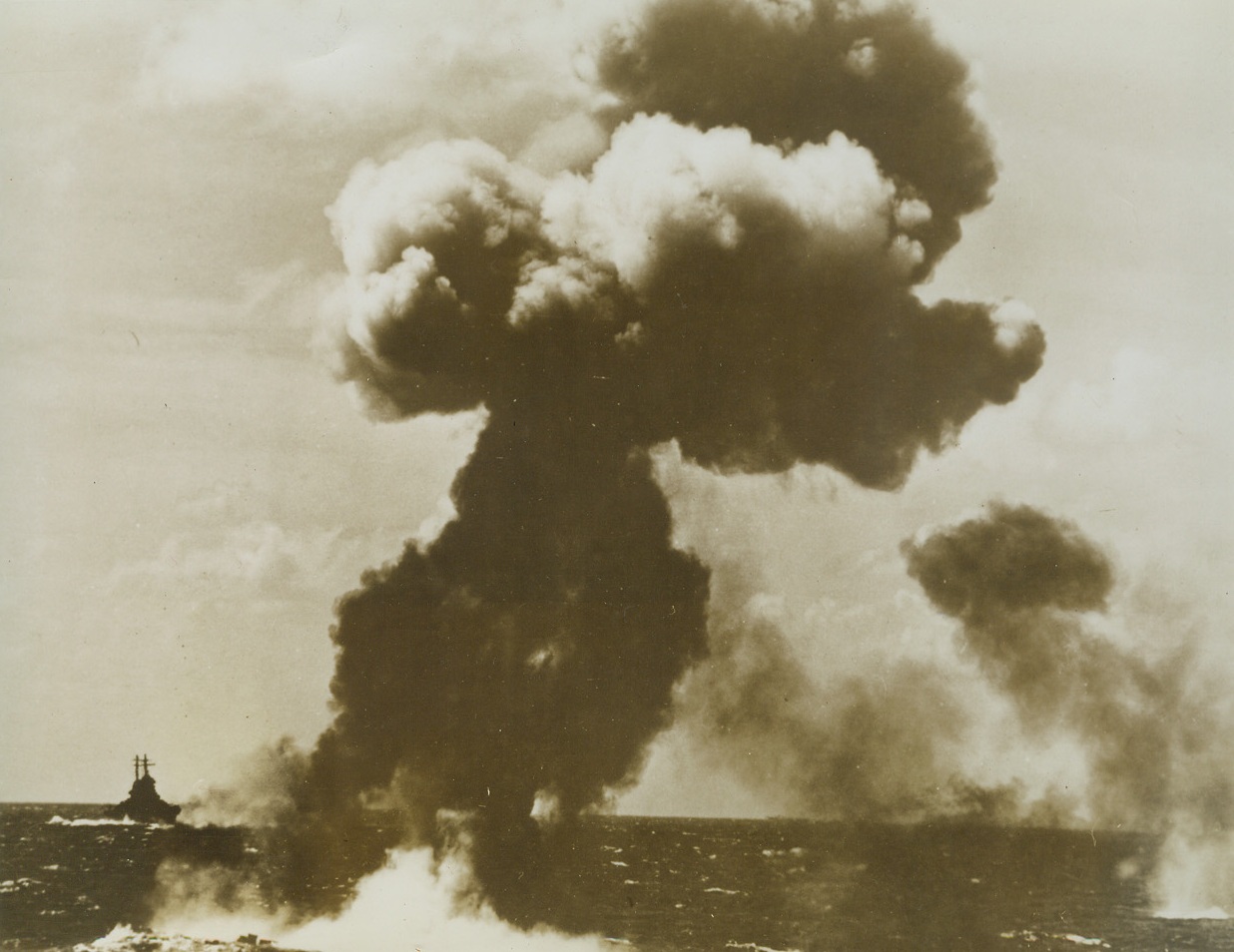
#3 – Pillar of Smoke Marks Grave of Jap Plane, 12/13/1943. All that was left of one of 72 enemy planes shot down in the December 4 U.S. aircraft carrier task force raid on the Marshall Islands was this tall column of smoke and a little debris where the Jap torpedo bomber hit the water after being blasted by an aircraft carrier’s anti-aircraft guns. At left is a U.S. destroyer which was escorting the carrier. Credit: Official U.S. Navy photo from ACME;
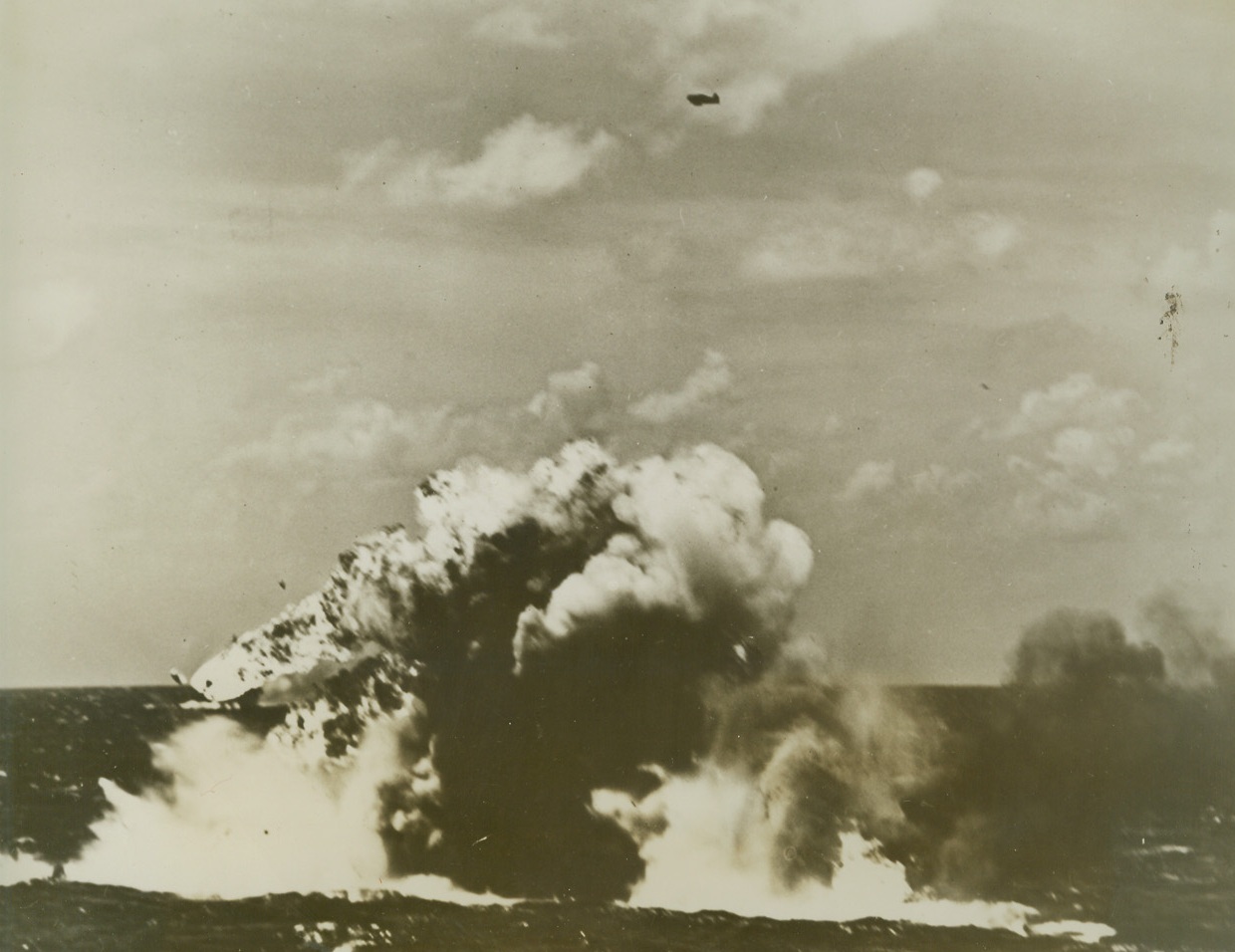
#2 – Splash and Roar as Jap Plane Hits Water, 12/13/1943. What was one of 72 enemy planes shot down in the December 4 U.S. aircraft carrier task force raid on the Marshall Islands, a Jap torpedo, explodes with a mighty roar of flame and smoke and water as hit hits the sea after being bagged by anti-aircraft fire. The bomber was one of six which tried to hit an American carrier. All were knocked down. Credit: Official U.S. Navy photo from ACME;
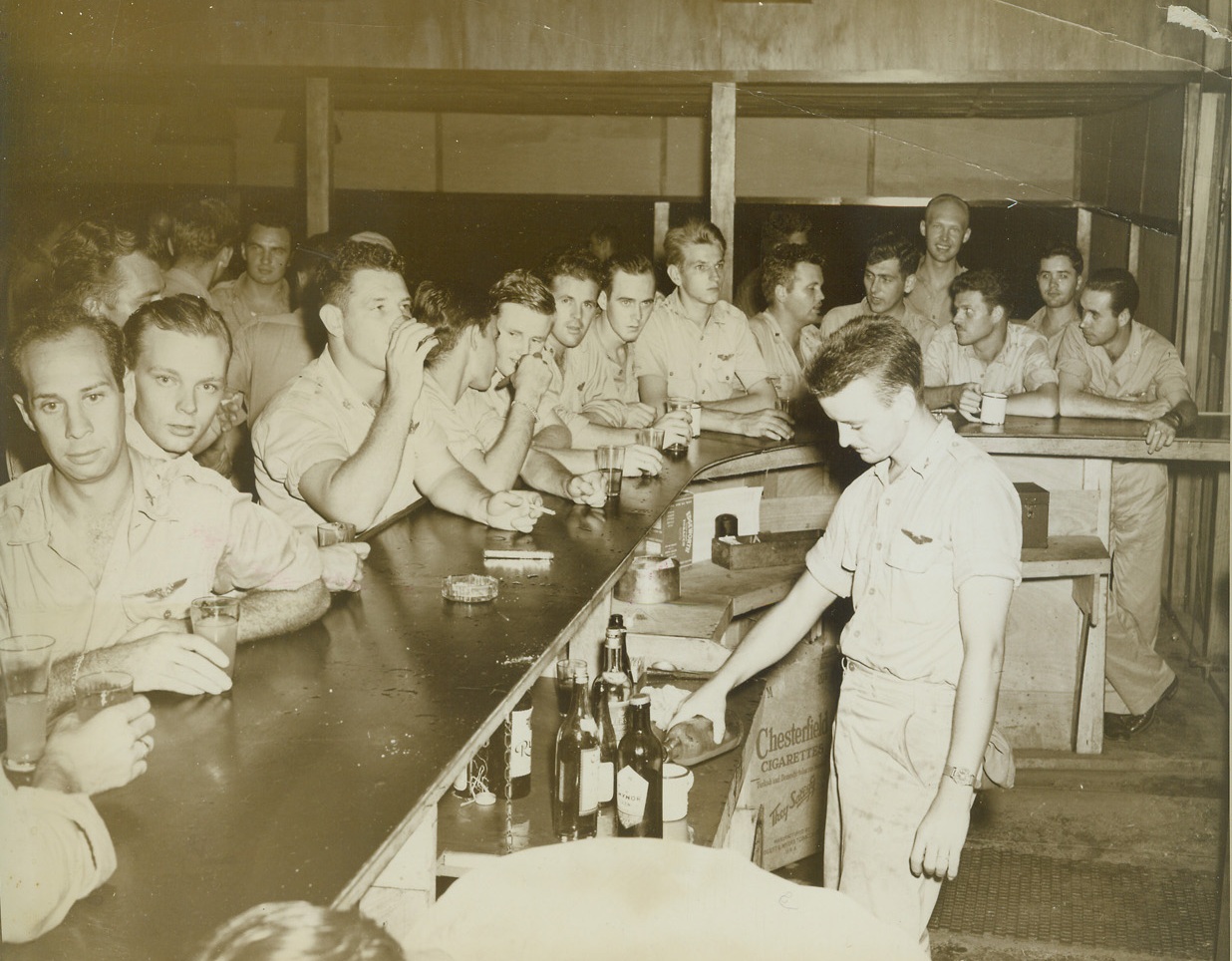
A Dream Come True, 12/20/1943. New Guinea – Officers of an advanced bombing unit of the 5th Air Force labored hard in their spare time, and out of salvaged materials constructed the most elegant club on New Guinea which boasts this long bar. They surpassed their goal of creating a club worthy of the good old U.S. Credit (ACME photo by Thomas L. Shafer, War Pool correspondent);
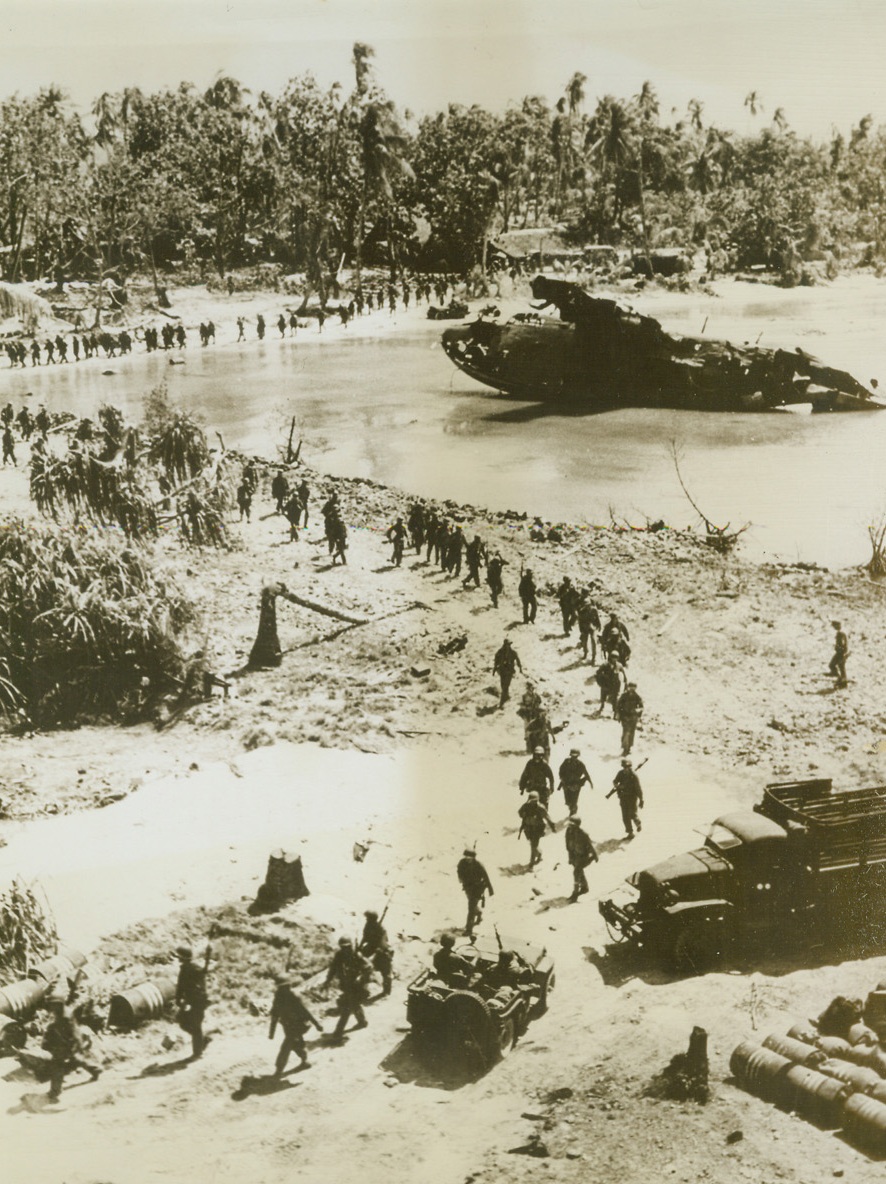
Out to Get What’s Left, 12/18/1943. Makin Island – Out to get what’s left of the Jap force pushed back to one end of Makin Atoll, a column of American fighters tramps around a lagoon in which a Japanese seaplane is partially submerged after strafing by Yank planes. In the right foreground are stacks of Jap fuel barrels. Credit (U.S. Coast Guard photo from ACME);
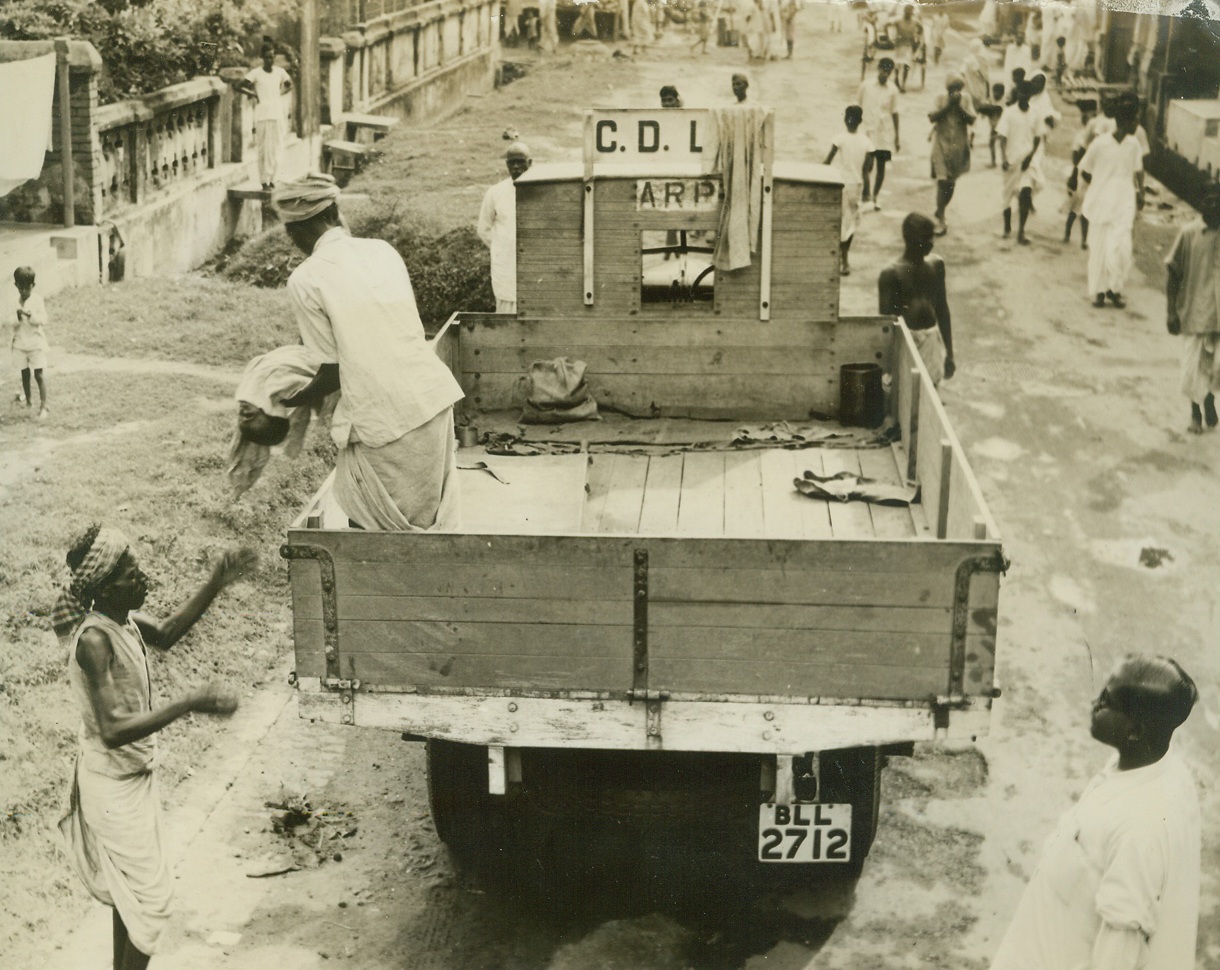
Famine in India, 12/17/1943. By last week, an estimated 1,000,000 persons had died of starvation in India and, although the British government reportedly has the situation under control that number will undoubtedly be raised before the final, tragic count is taken. Just released, these startling pictures were taken in Calcutta at the peak of India’s famine in late October when a homeless army of 100,000 roamed the city, dying in the streets. New York Bureau Regular corpse removal squads were on call in the streets of Calcutta. This wagon bears the letters A.R.P., but death in India came not from the skies but from within. Often, the shriveled dead had to wait for hours to be removed from the street, checked in at the police station, then taken to the ghats for burning. Credit line (ACME);
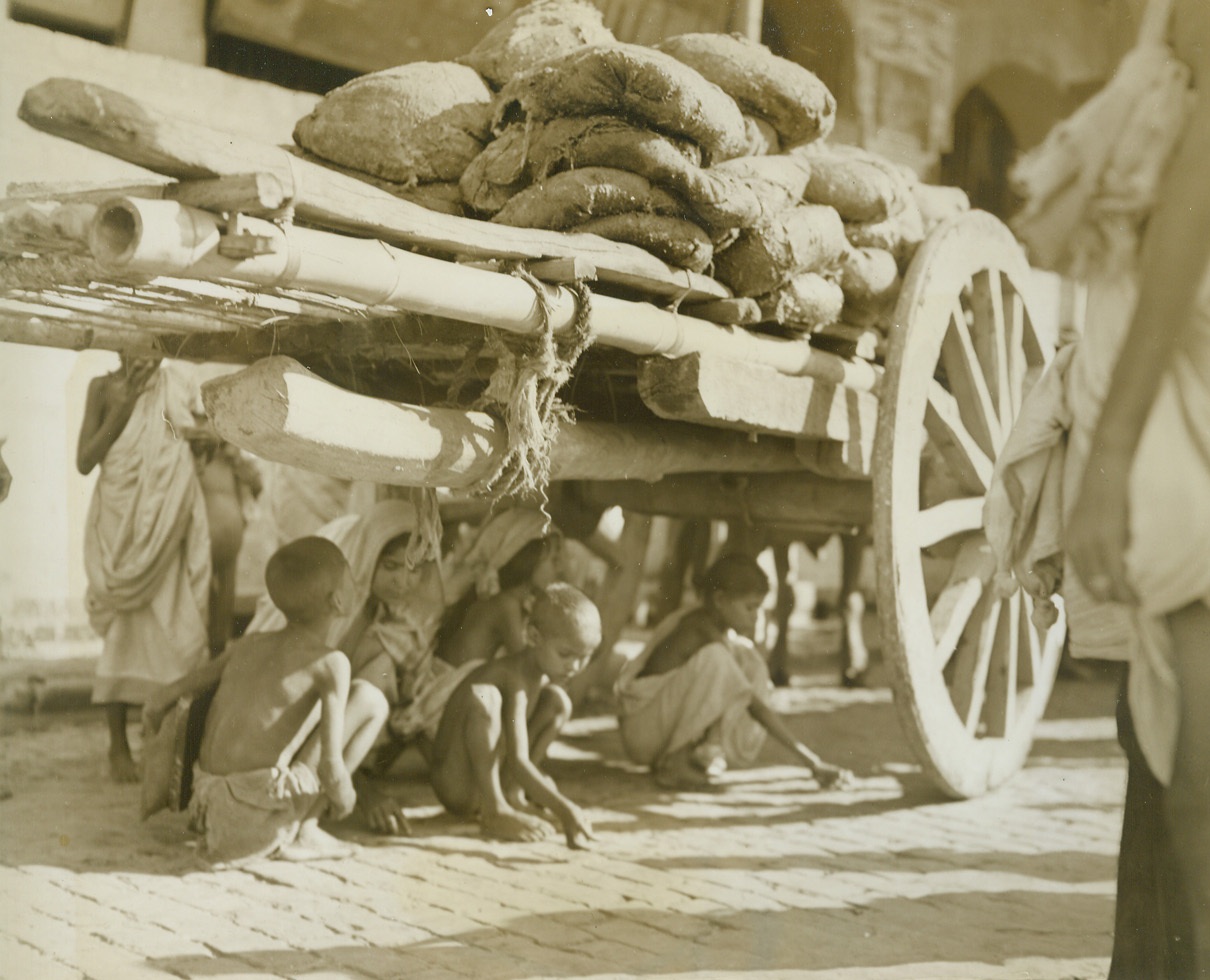
Famine in India, 12/17/1943. By last week, an estimated 1,000,000 persons had died of starvation in India and, although the British government reportedly has the situation under control that number will undoubtedly be raised before the final, tragic count is taken. Just released, these startling pictures were taken in Calcutta at the peak of India’s famine in late October when a homeless army of 100,000 roamed the city, dying in the streets. New York Bureau It doesn’t take long for word to get around that grain is spilling from these sacks on a wagon parked in Calcutta. Children, who dare not rip open the bags, grub in the dirt for kernels that sift down. Credit line (ACME);
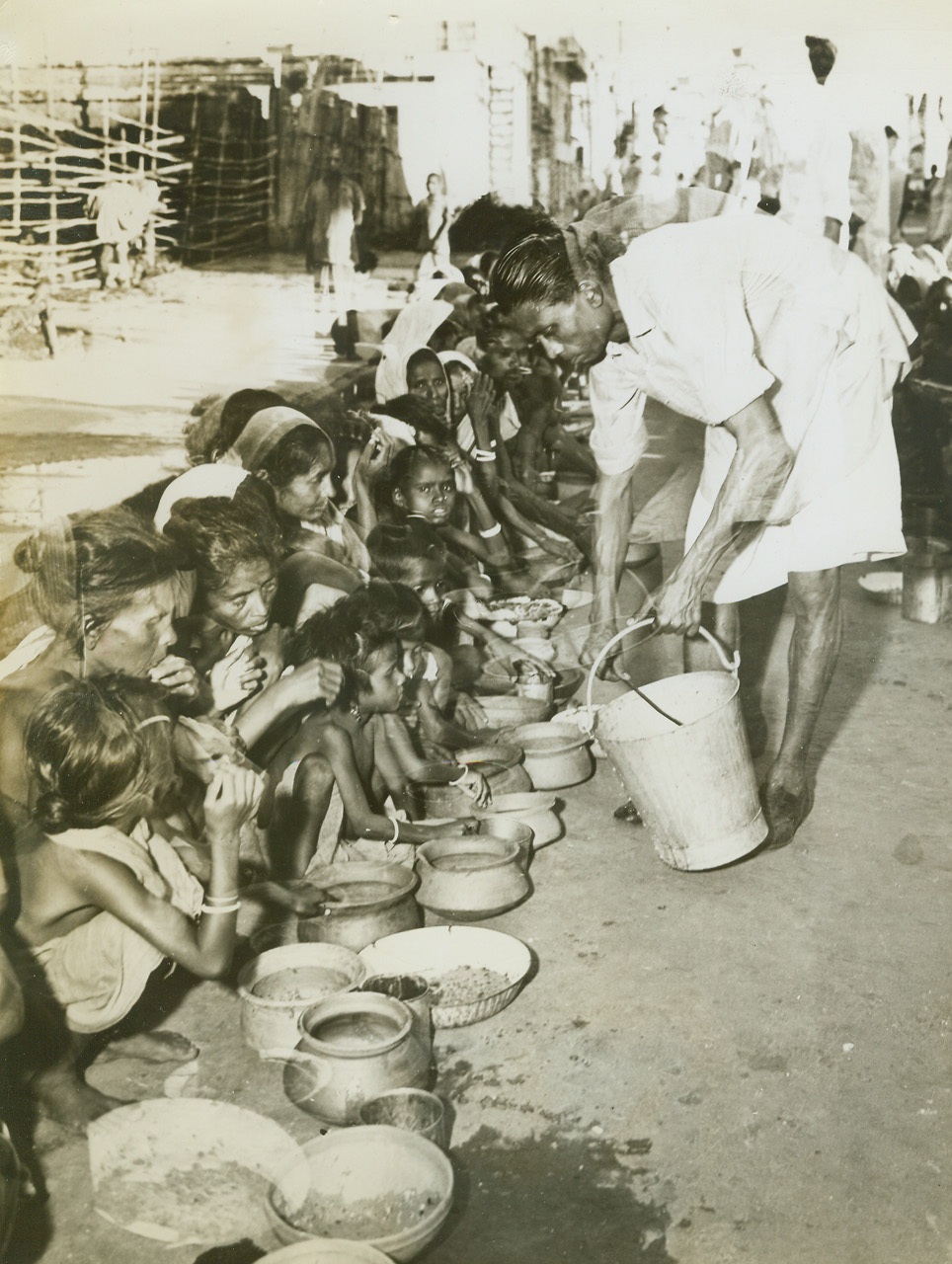
12/17/1943. By last week, an estimated 1,000,000 persons had died of starvation in India and, although the British government reportedly has the situation under control that number will undoubtedly be raised before the final, tragic count is taken. Just released, these startling pictures were taken in Calcutta at the peak of India’s famine in late October when a homeless army of 100,000 roamed the city, dying in the streets. New York Bureau Squalid eating conditions mean nothing to India’s starving who stuff the free cereal in their mouths with their hands. The food won’t be enough to bring their deformed bodies back to normalcy. Credit line (ACME);
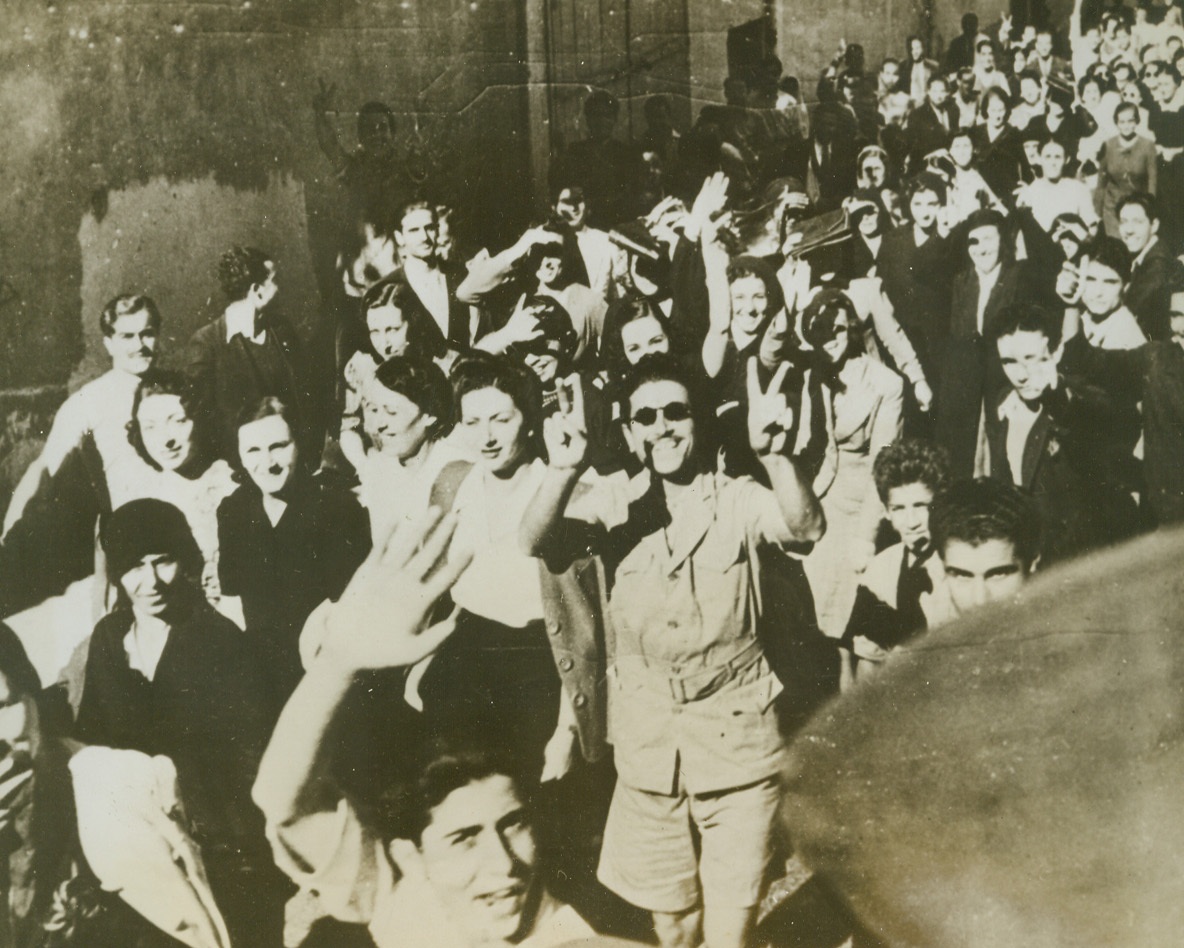
Lebanese Protest March, 12/1/1943. Beirut, Lebanon: French authorities of the French committee of National Liberation arrested the President, Premier, some Ministers and members of the Lebanese Chamber of Deputies, on Nov. 11th, who had voted immediate independence of French mandate. Shown here, are deputation of Lebanese on the way to the British and American legations to protest against the infringement of their freedom. The French released the arrested officials on Nov. 21st, after several violent outbreaks between French troops and Lebanese, both Christian and Moslem.Credit line (ACME);
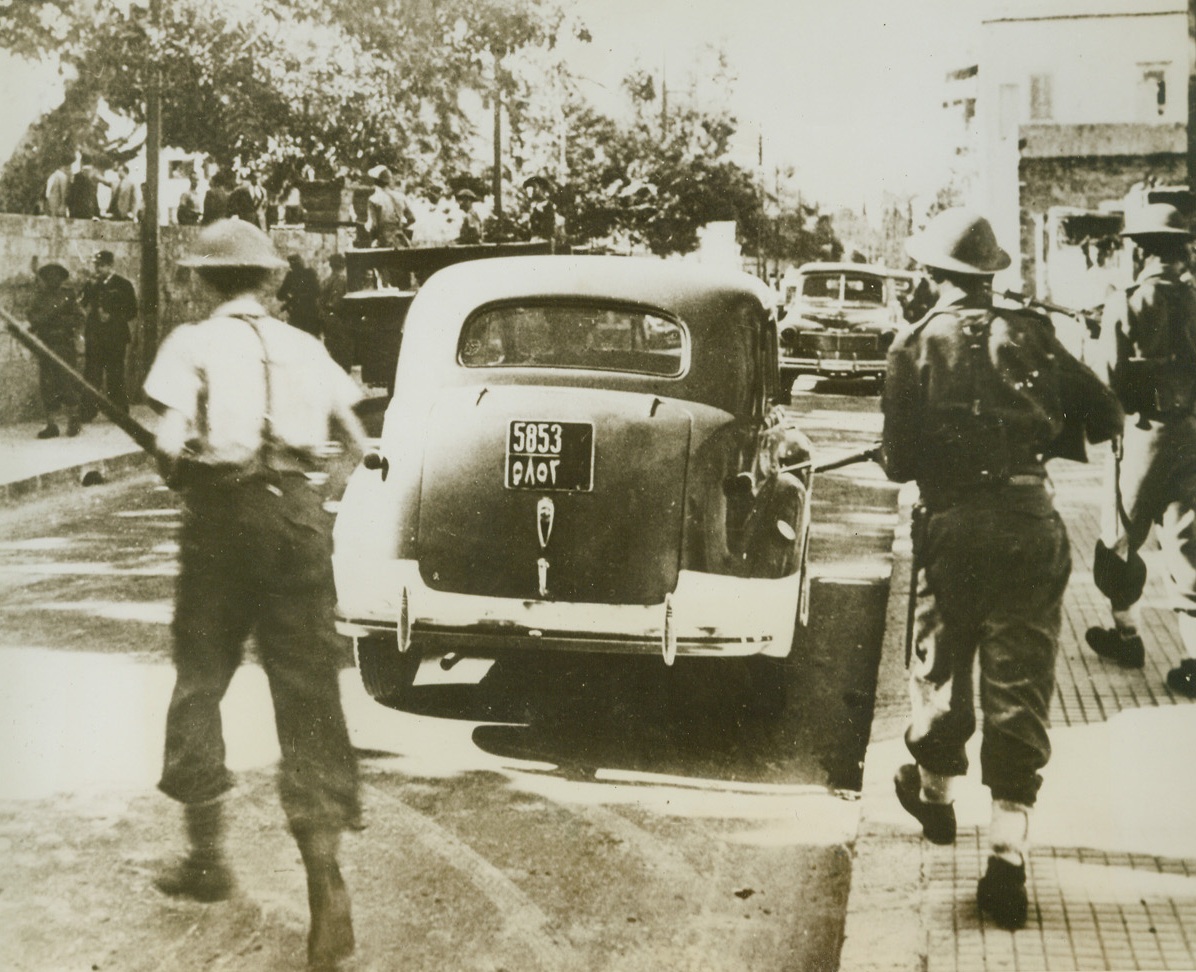
Ready For Trouble, 12/4/1943. Beirut, Lebanon: French troops of the French committee of National liberation easily handle, as shown here, demonstrators who had assembled in protest against the arrest of the President, Premier, some Ministers and some members of the Chamber. Officials were arrested due to their vote of immediate freedom from French mandate. Since day of arrest, November 11th, French released them to resolve the crisis.Credit line (ACME);
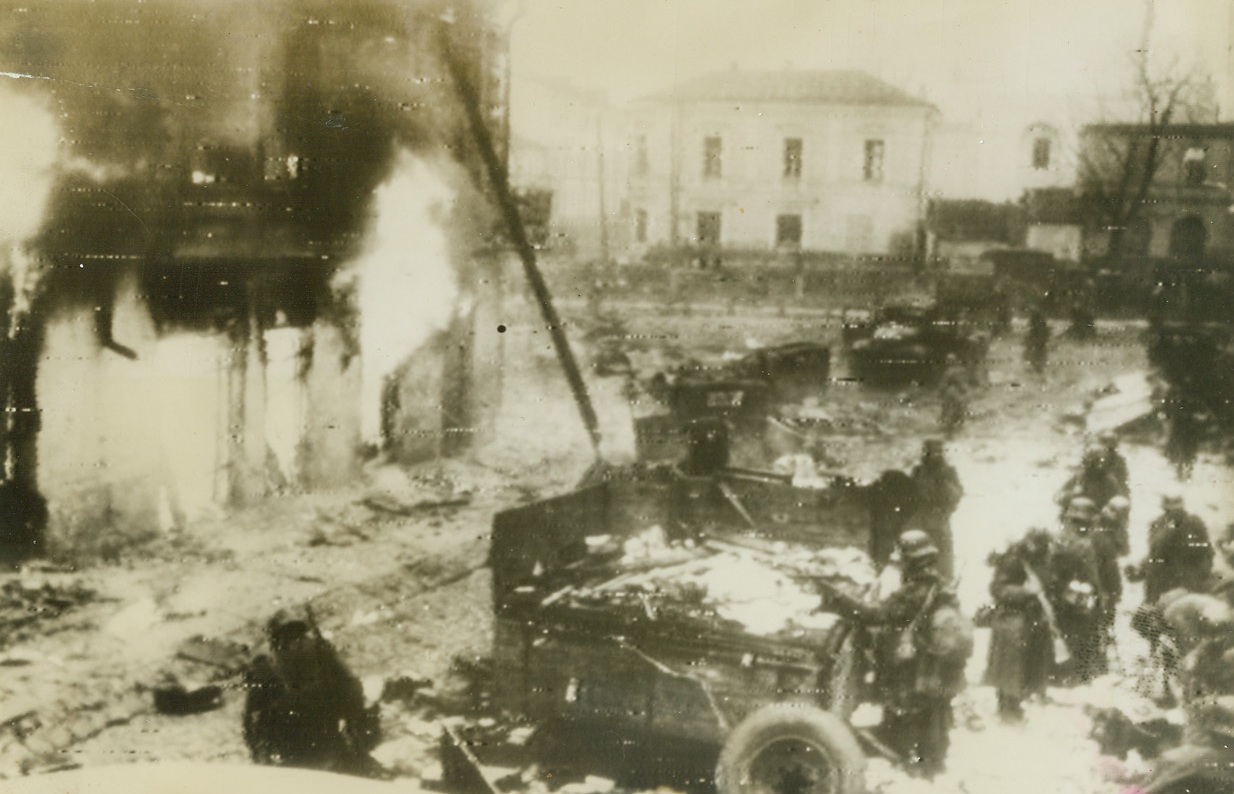
Meager Victory, 12/20/1943. Russia—After a year of almost steady retreat before the powerful Red Army, German troops managed to retake a few towns on the central Russian front. Here, according to German caption accompanying photo, are Nazi troops as they reentered Zhitomir. Truck in foreground is supposedly a mobile Red Army office. Radioed from Stockholm this morning. Credit: ACME radiophoto.;
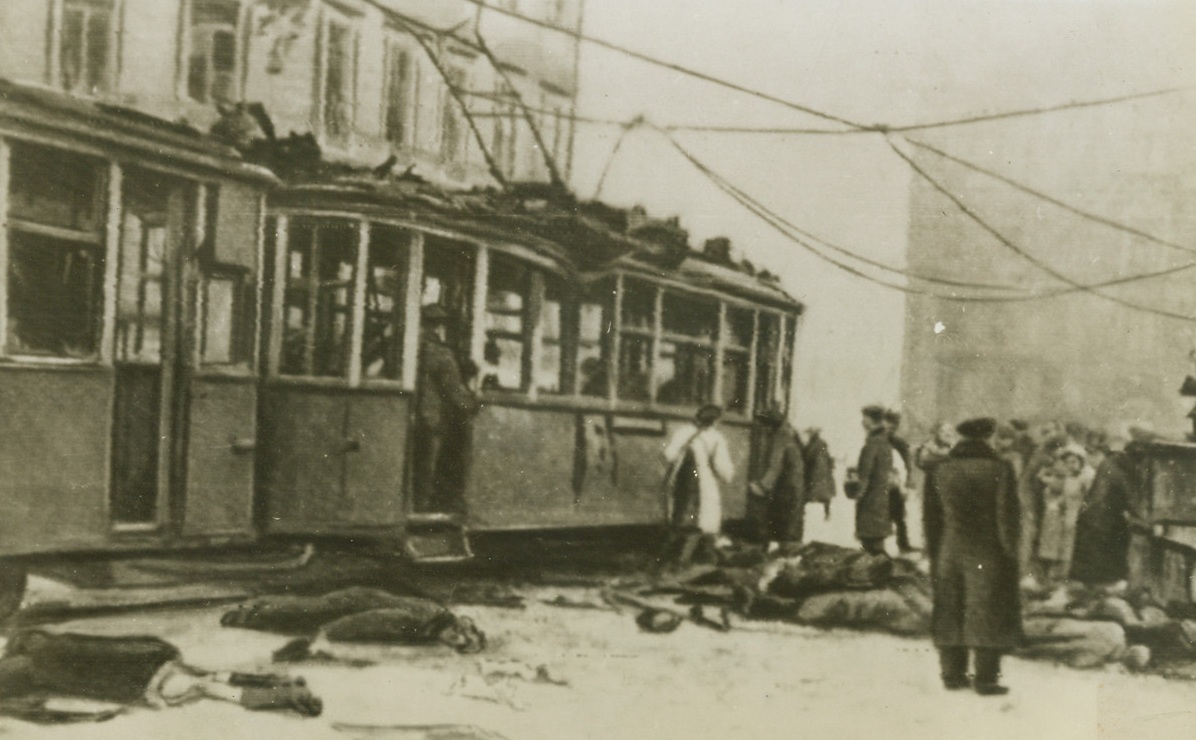
Streetcar Riders Killed by Shells, 12/15/1943. Leningrad—Bodies of citizens of Leningrad, killed when German and Finnnish guns bombarded the city recently, are piled on the street as rescue workers go through the wrecked trolley cars looking for other victims. This photo was flashed to New York by radio today. (Passed by censors). Credit: ACME radiophoto.;
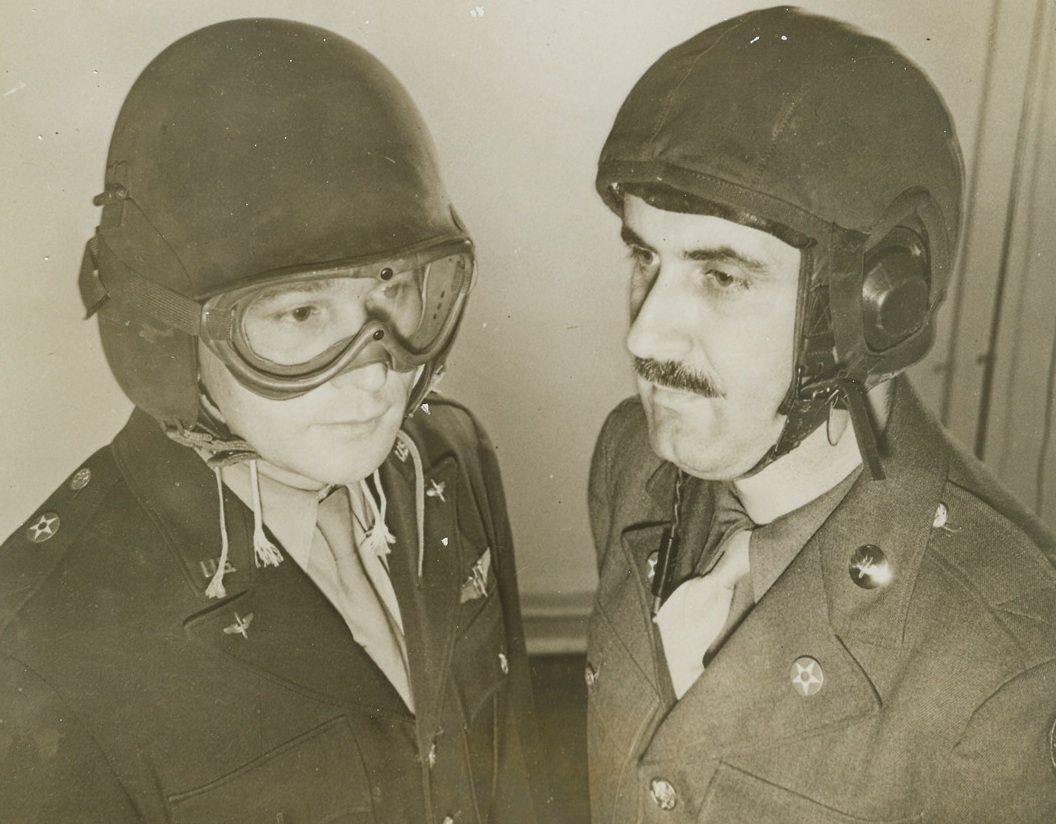
Helmets For Protection, 12/31/1943. Major Edward F. Sustrick (left) of Denver, Colo., and Sgt. William Lyon of Los Angeles, Calif., wear the M3 and M4, helmets designed to protect airmen from low-velocity fragments of anti-aircraft shells. The M3 (left) is of a one-piece type, with hinged flaps, that can be worn by most airmen. The M4 was developed for gunners, who have only limited space in their turrets.;
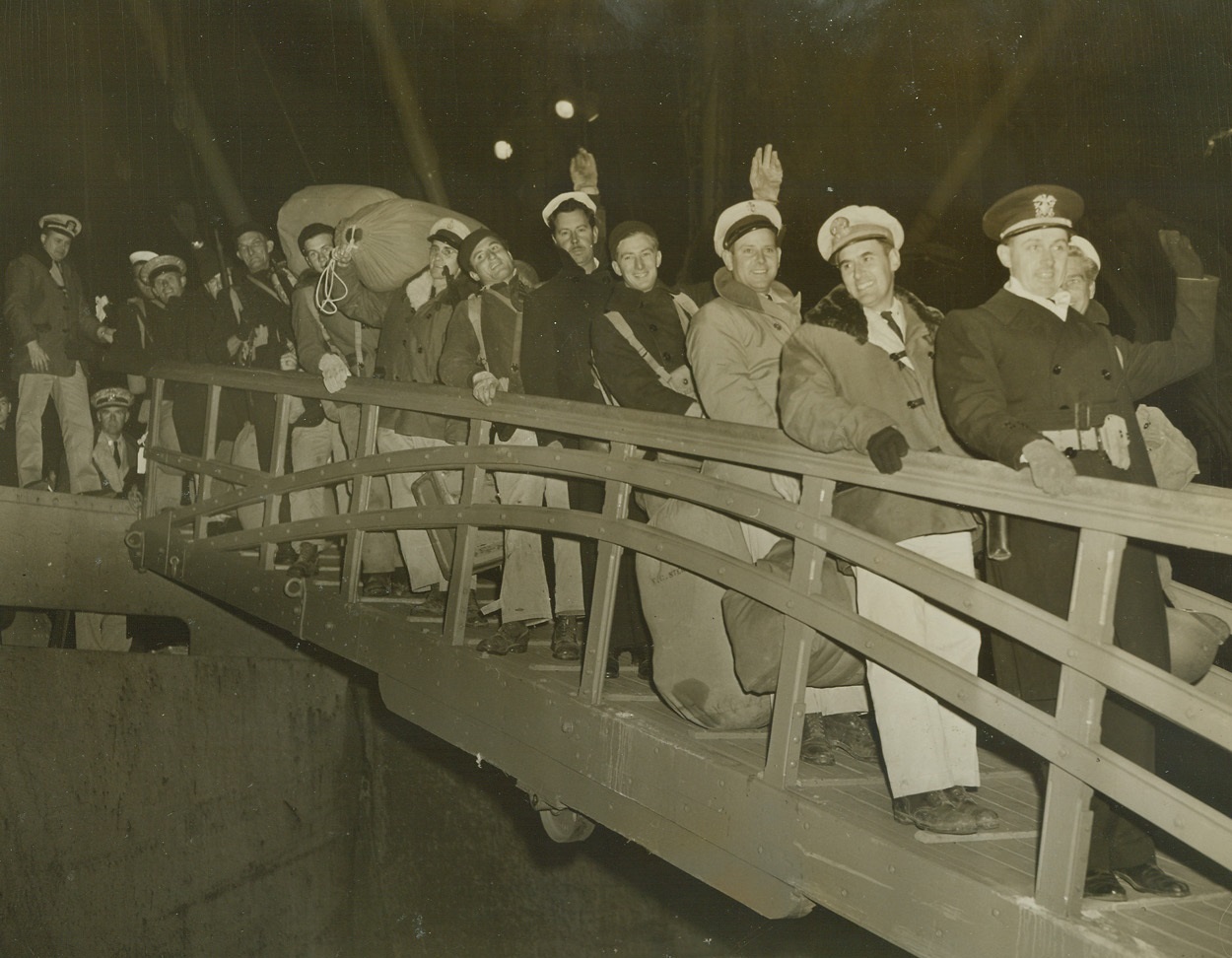
Back On American Soil, 12/17/1943. New York City – Commander Wallace L. Rinehart of St. Louis, MO., Commander of the 54th U.S. Navy Construction Battalion leads a gang of jubilant Seabees down the Gangplank of a Navy transport to set foot on American soil for the first time in ten months. With an excellent record of service in the Mediterranean behind them, the Seabees returned to the States today (Dec. 17th). The boys went directly to Camp Endicott, R.I., where every CB man will be granted Christmas leave.;
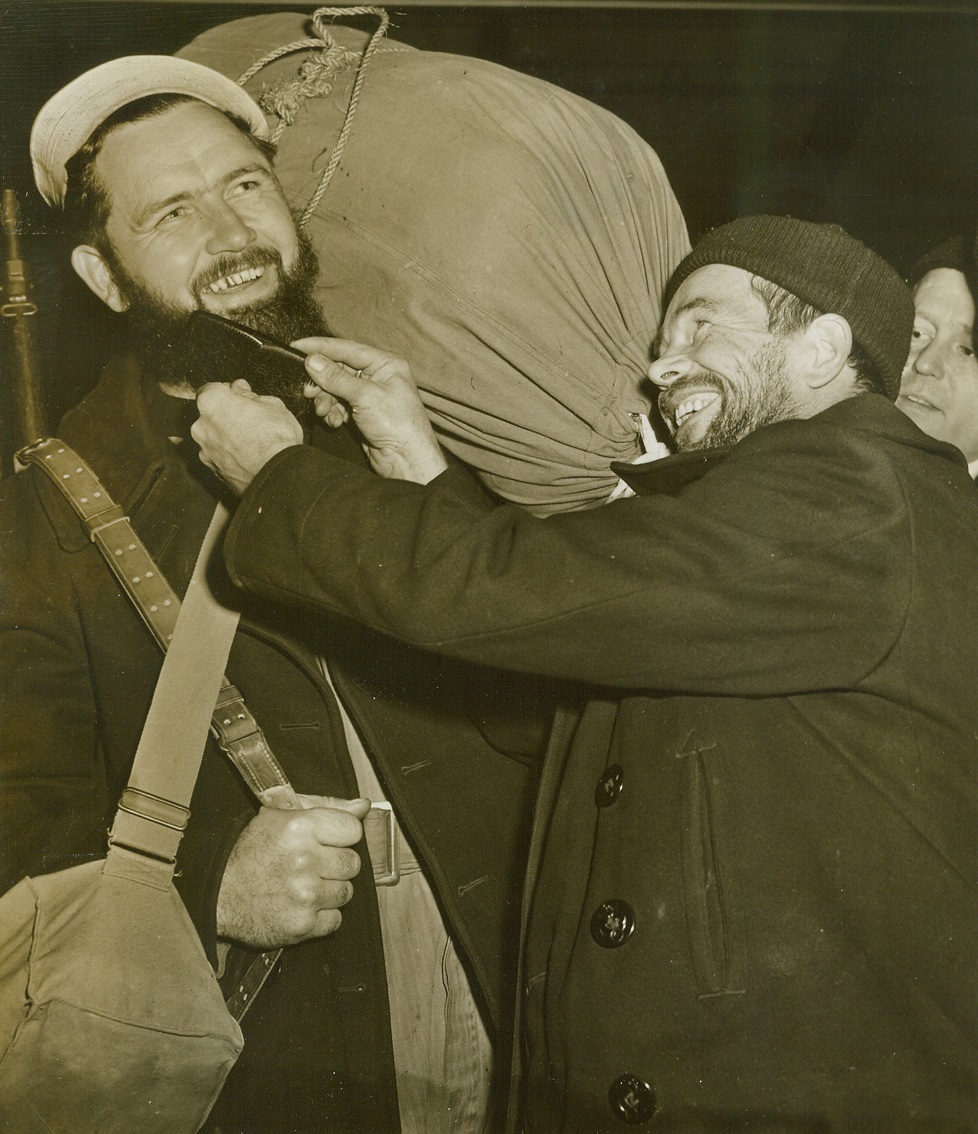
Ten-Month-Growth, 12/17/1943. New York City – Returning to the States for the first time in ten months, Carpenter’s Mate Milbert F. Baker brought a thick beard back with him. Carpenter’s Mate 3/C Edgar A. Dollar of Vancouver, Wash., Combs the face foliage of his Salem, Ore., buddy, as the two arrive in New York with the 54th Naval Construction Battalion. 12/17/43 Credit Line (ACME);
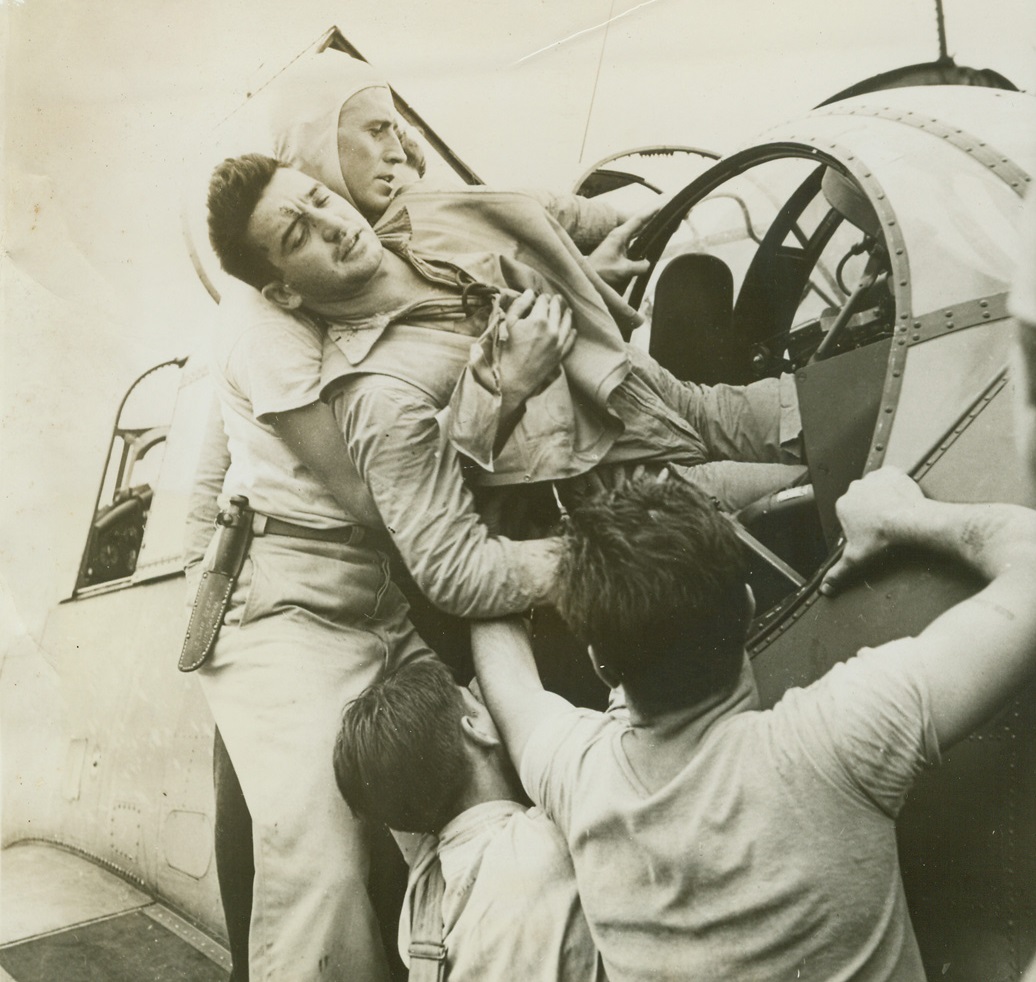
Raiders’ Return, 12/16/1943. At Sea – Returning to the flight deck of the USS Saratoga after the terrific, November 5th raid on Rabaul, wounded rear gunner AOM Kenneth Bratton, of Mississippi, winces as he is lifted from the turret of the Avenger in which he fought. Applying a tourniquet to his shattered knee, Bratton managed to retain consciousness until he was carried from his post by Lt. Julie Bescoes, USNR, formerly a University of California coach and All-American grid star. 12/16/43 Credit Line (Official U.S. Navy Photo From ACME);
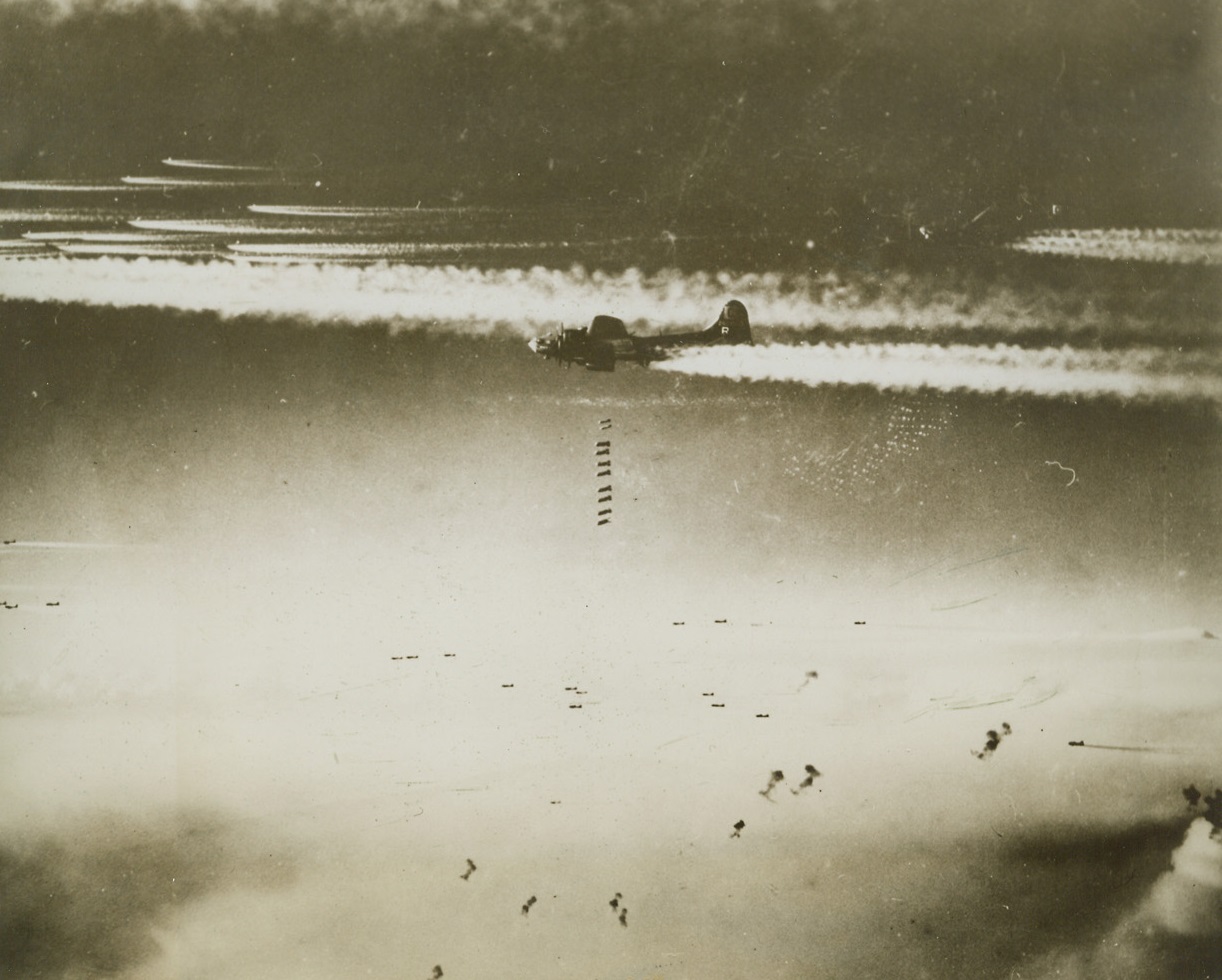
Yank “Calling Cards” For Bremen, 12/15/1943. Washington, D.C. – A stick of ten heavy bombs drops from a Flying Fortress of the U.S. Army Air Forces, in the center of this photo, just released in Washington. Exploding anti-aircraft shells, (bottom, center), and vapor trails, (top) can be seen in the photo which was taken during the heavy all-American 1,000 plane raid on Bremen, Germany, last Nov. 26, during the week when Allied Bombers were blasting Berlin to bits. Credit: U.S. Army Air Forces photo from ACME;
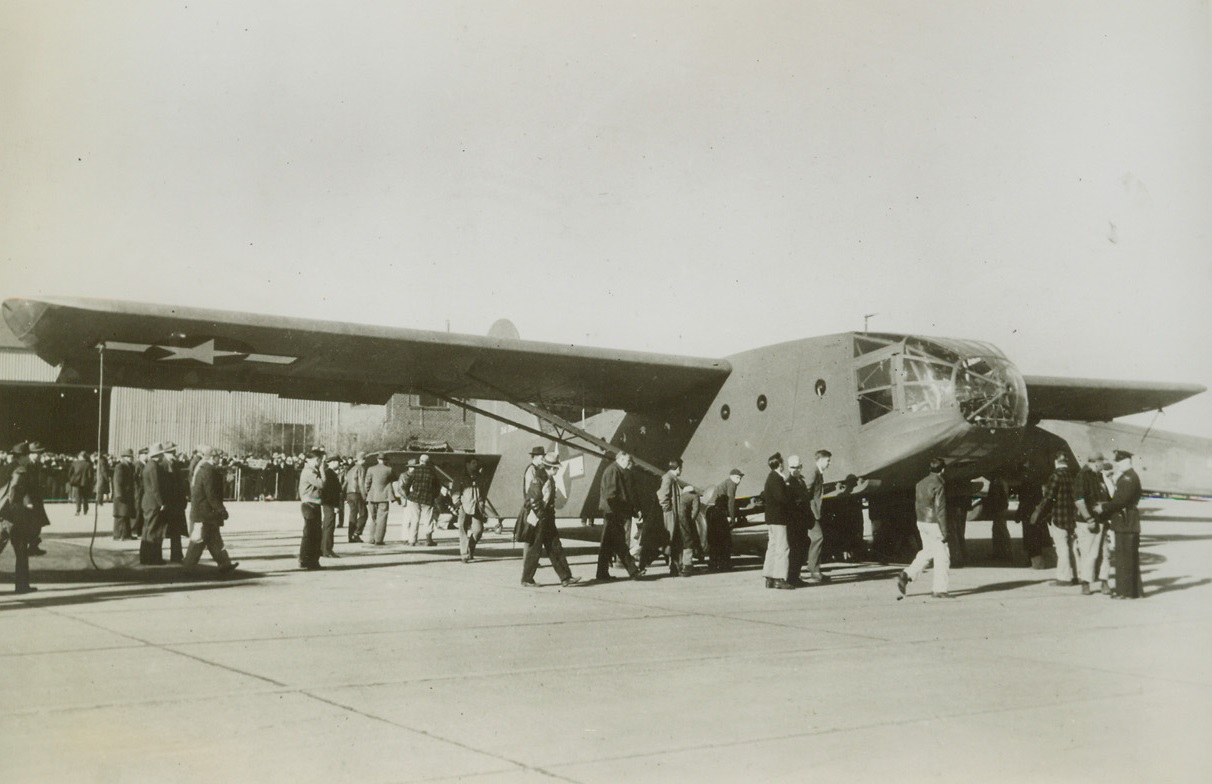
Largest Glider Tested, 12/2/1943.Minneapolis, Minn.—Largest glider ship ever built for Army Air Forces ready for its first test flight at Wold-Chamberlain Field, Minneapolis, Minn. Lt. Col. Bruce B. Price of Wright Field was at the controls of the giant craft with Capt. Ben West as co-pilot. The new ship, under construction since Sept. 24 at the Midway Plant of the Northwestern Aeronautical Corporation, has a load capacity greater than a two-motor Douglas Plane of the type used by commercial lines, factory representative said. Credit: ACME.;
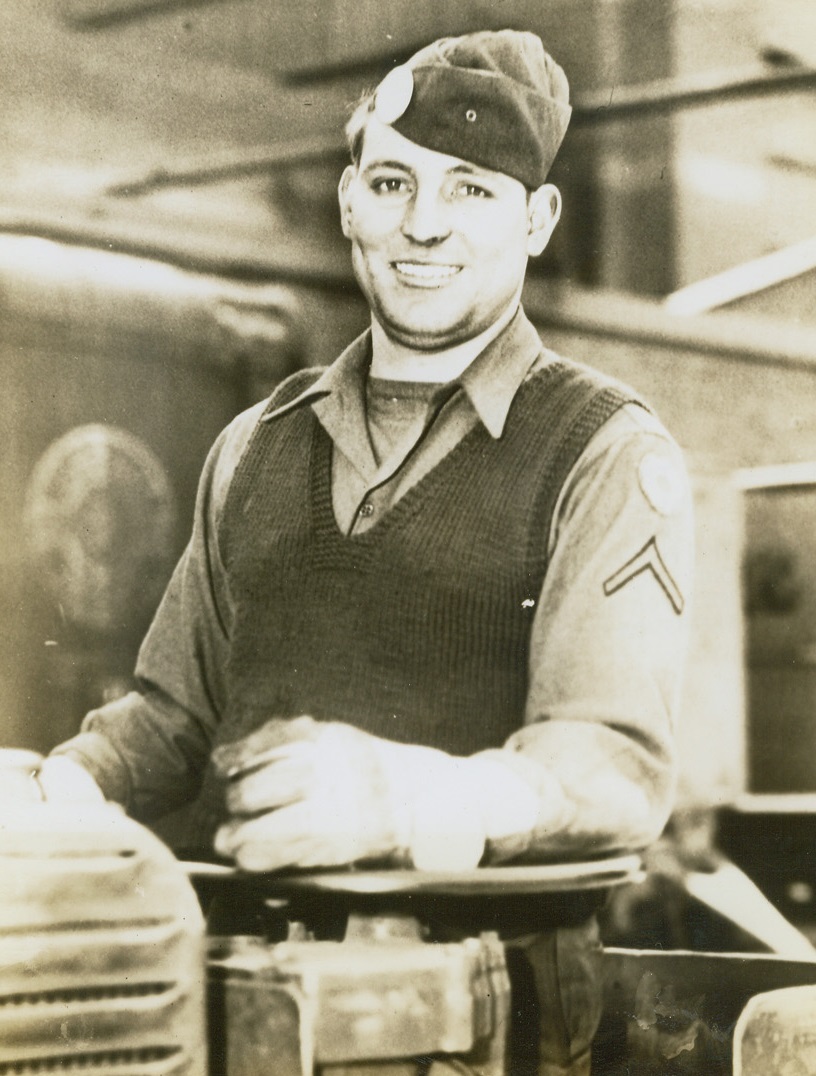
Soldier Works on Furlough, 12/23/1943. Muskegon, Michigan -- Home from the Aleutians on furlough, his first in 18 months, Pfc. William Beckley of Muskegon Heights, Michigan, is spending it working 16 hours a day at his old job of operating a lift truck in a foundry. To him, all-out war effort means just that. Credit: ACME;
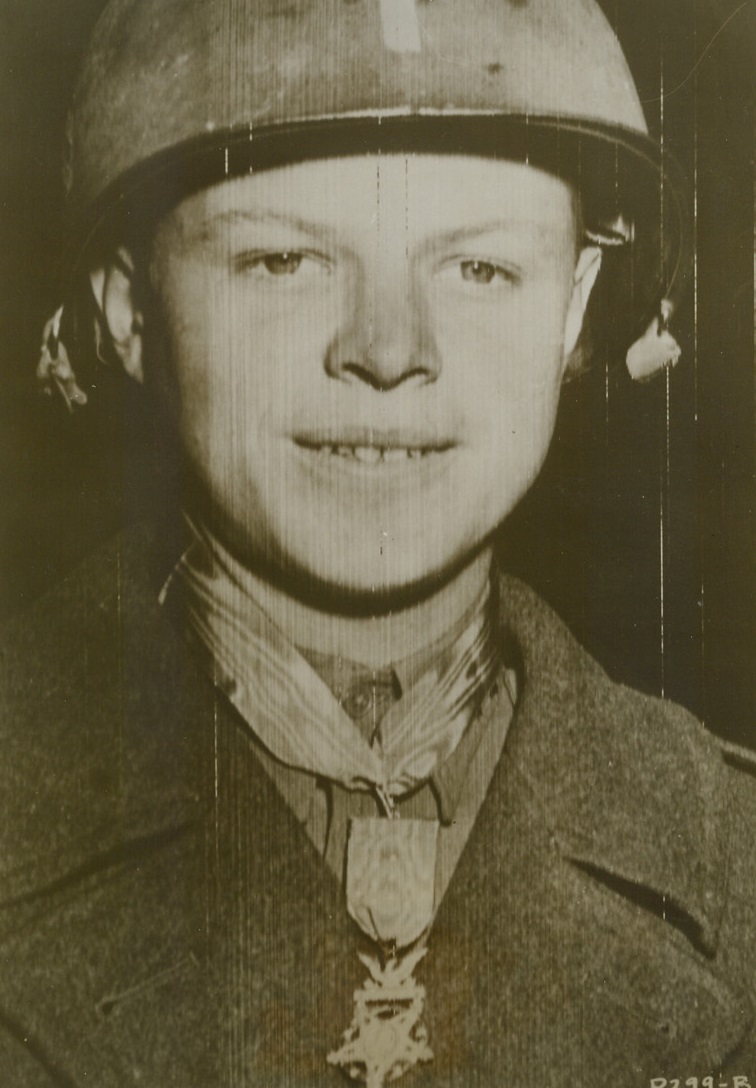
AWARDED CONGRESSIONAL MEDAL OF HONOR, 12/2/1943. 1st. Lieut. David C. Waybur, Piedmont, Calif., wearing the Congressional Medal of Honor awarded him for heroism under enemy fire. After three of his men were hit and himself seriously injured by enemy fire, Lt. Waybur, commanding a reconnaissance platoon, engaged four enemy tanks, personally accounting for one of them, and dispersing the remainder. The youthful appearing officer beat the tank by wiping out the vehicle’s crew with his .45 caliber Thompson machine gun. Credit (Signal Corps Radio-Telephoto from ACME);
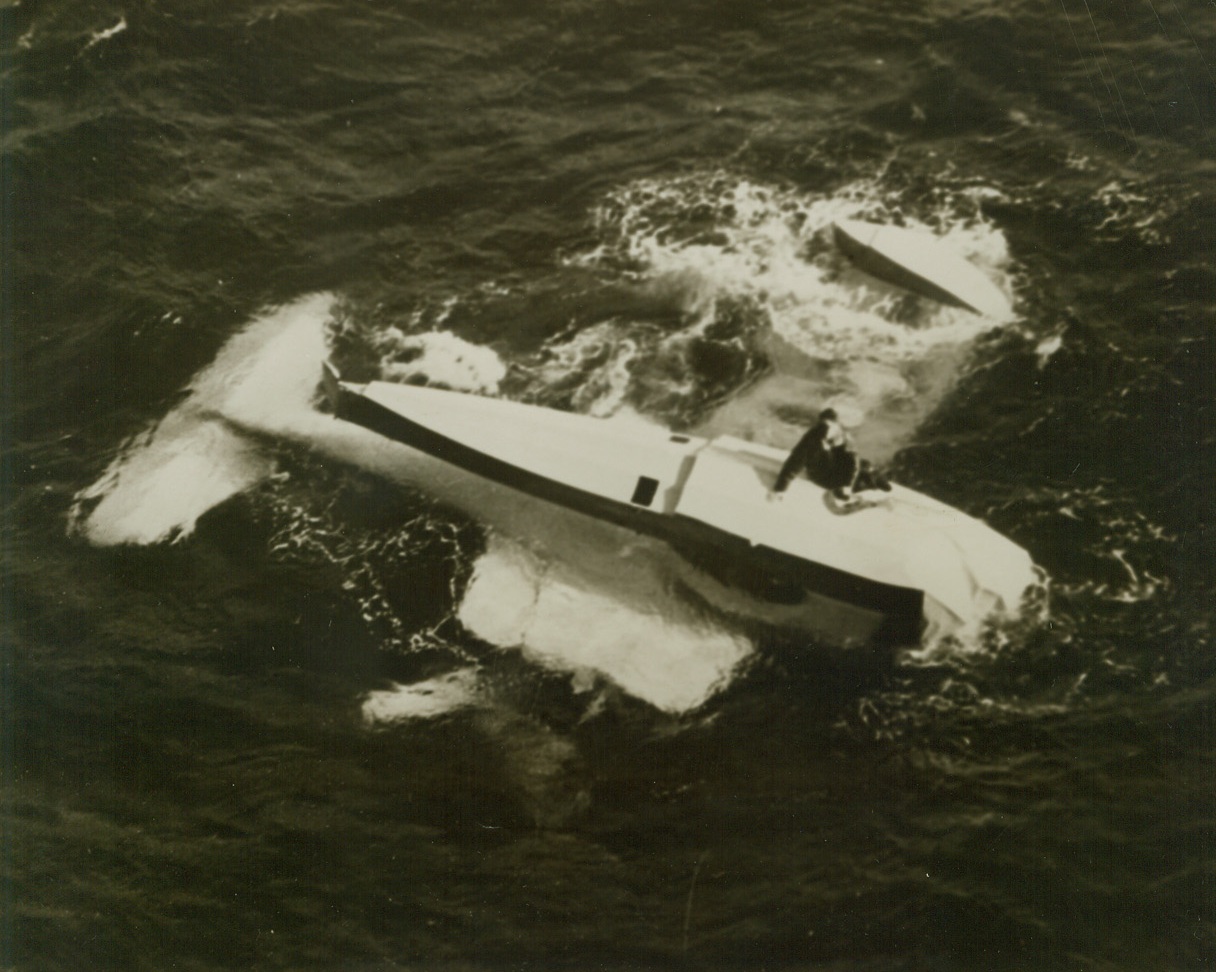
Blimp Rescues Downed Flier - (#1), 12/23/1943. Somewhere on the Atlantic - Aviation Mate 3/c Charles J. Schultz, clings to the pontoon of his overturned Curtiss Observation Plane, after being forced down “somewhere on the Atlantic”. This photo, just released in the United States, was taken from the U.S. Navy Blimp K-89, which dropped a life raft to the flier. The pilot of the plane, Ensign Arthur Masley, USNR, Batavia, Ill., was trapped in the overturned craft and killed. (See photo 708044). Credit: U.S. Navy photo from ACME;
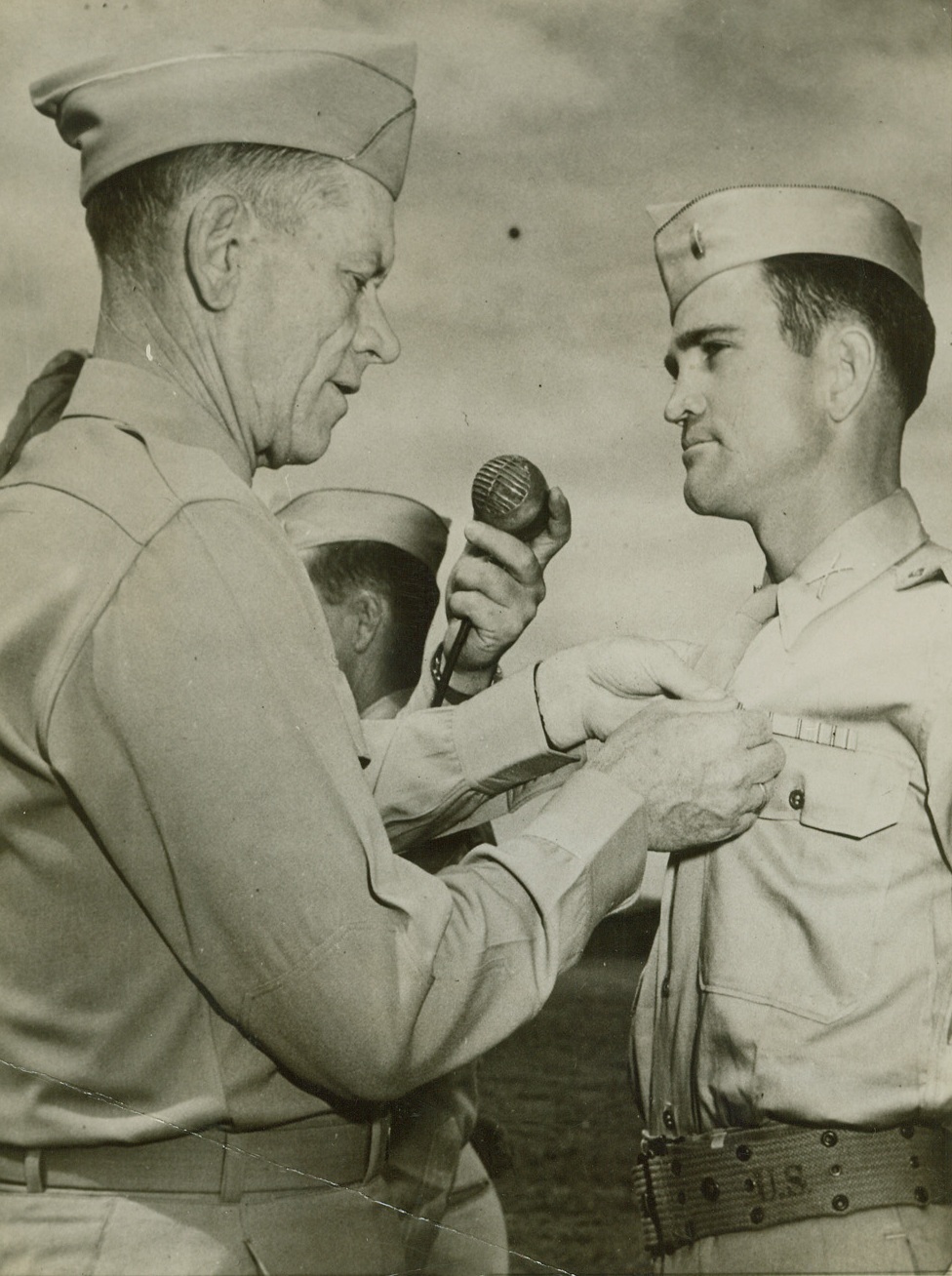
No Title. 12/29/1943. First Lieut. Thomas D. Hindmen, May, Tex., receives the Silver Star decoration for gallantry in action from Maj. Gen. Charles H. Corlett. His mother lives in May, Texas, where the lieutenant was born. His wife, Mary, lives at Carmel, Calif.;
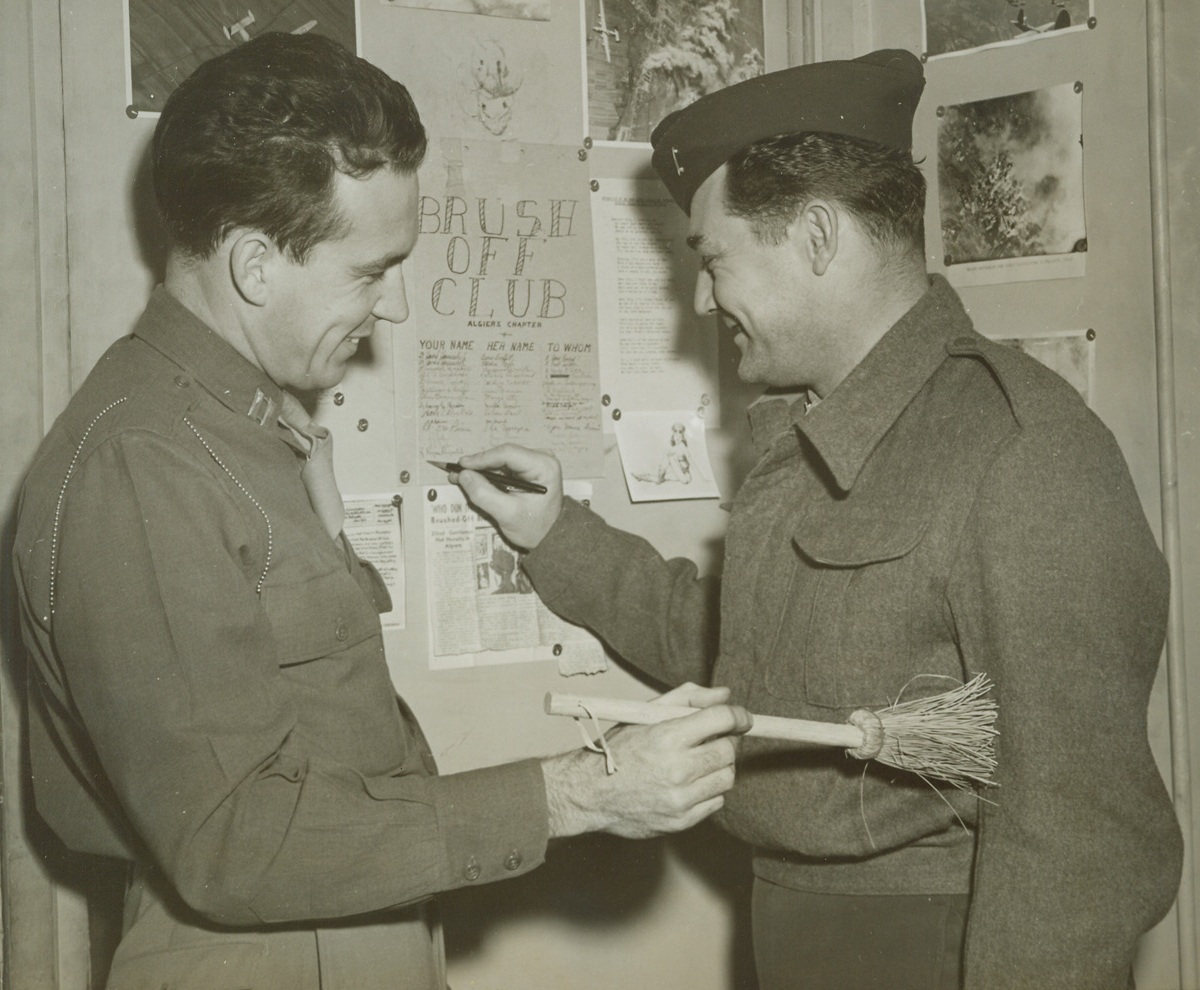
The End of Romance, 12/29/1943. Algiers -- Lt. Russell Brickell, of Fort Worth, Texas, signs his name to the ever-expanding roster of the Algiers chapter of the “Brush-Off Club” as charter member Capt. Howard Hammersley Jr. literally brushes his buddy off. Membership is open only to those overseas fighters who lady loves have ditched them. Capt. Hammersley hails from Roanoke, Virginia. Credit: ACME photo by Charles Seawood for War Pool;
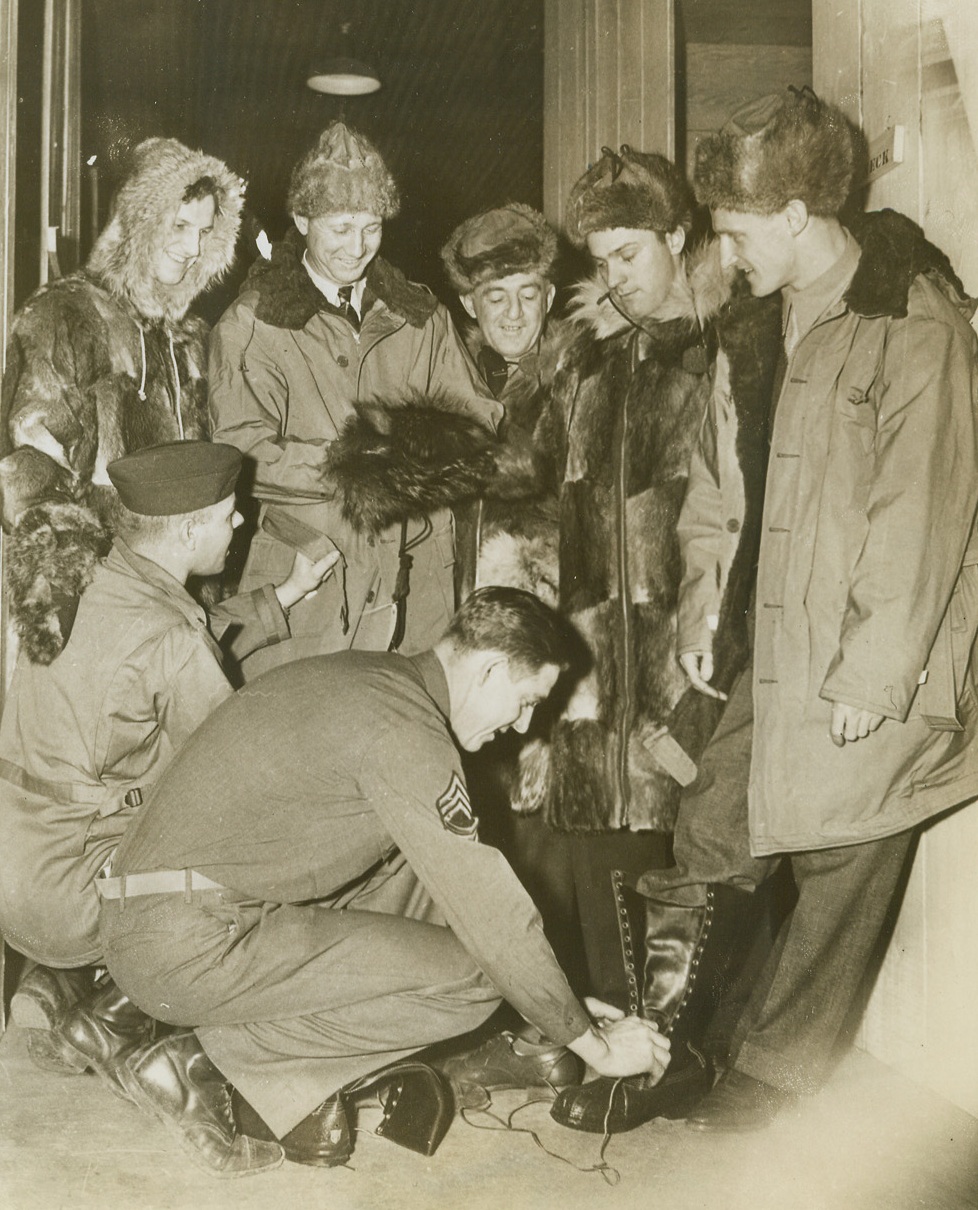
Warm Clothes for Cold Trip, 12/29/1943. Somewhere in Alaska -- Ready to tour Alaskan and Aleutian bases to put on exhibition games for our boys up there, these major league diamond stars get outfitted with heavy, warm clothing for their cold trip. Kneeling, Lt. Arthur Tober (left) of Bridgeport, Connecticut, adjusts a parka on Fred “Dixie” Walker, while Sgt. John A. Theoboldt of Monterey, California, fits a pair of shoepacks to Hank Borowy. Left to right, the baseball players are Stan Musial of the St. Louis Cards; Dixie Walker of the Brooklyn Dodgers; Frankie Frisch, manager of the Pittsburgh Pirates; Danny Ditwhiler of the Cards; and Hank Borowy of the New York Yankees. Credit: ACME;
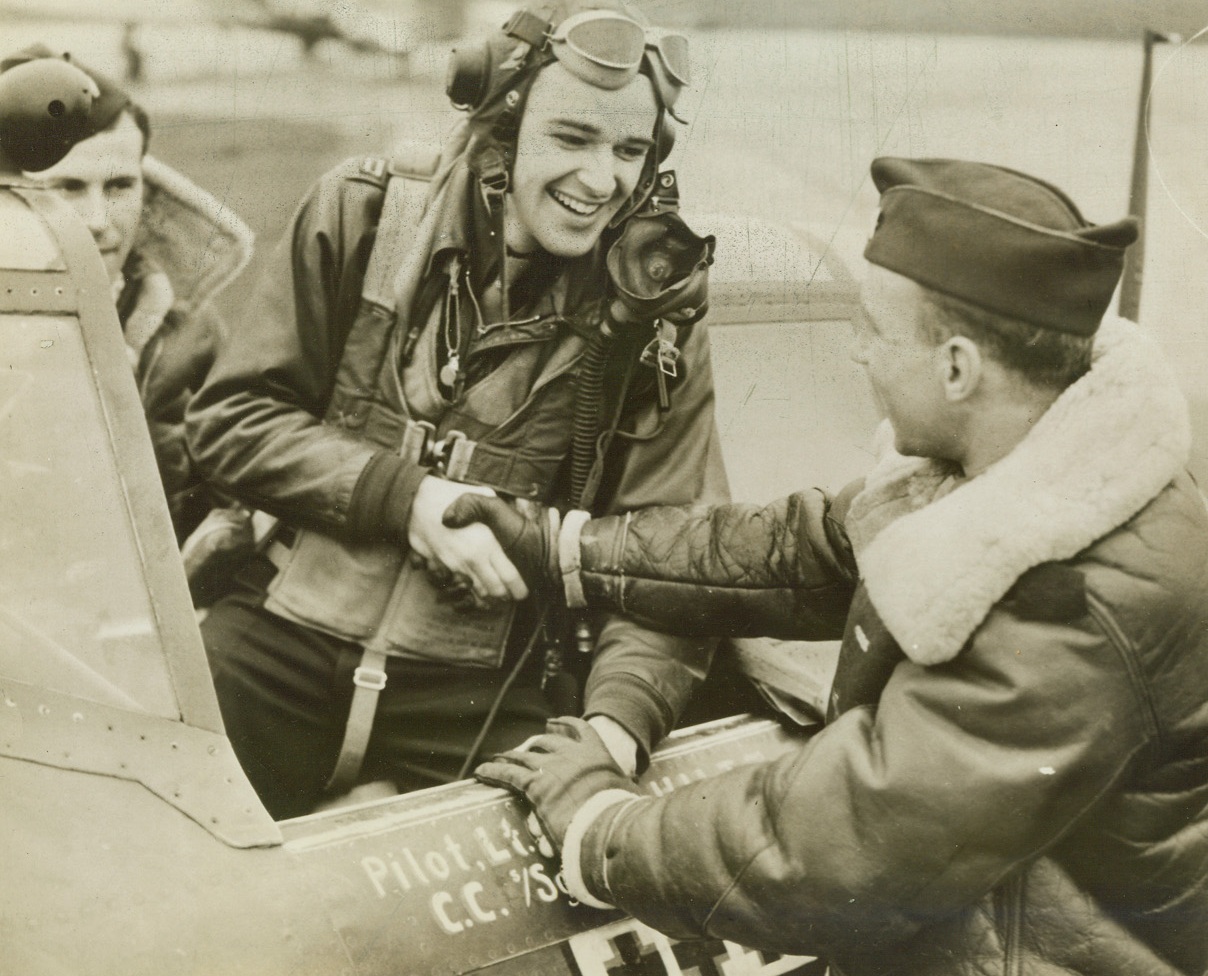
GOOD WORK PAL, 12/16/1943. ENGLAND—Two jubilant fighter pilots greet the new top-scoring ace of the U.S. 8th Air Force fighter command, Capt. Walker M. Mahurin, 24, of 927 West Wildwood, Fort Wayne, Ind., as he returned to his base in England from an escort mission over Bremen. On the flight he shot down three ME-110s to bring his total score to eleven. On the following Bremen mission, he increased his tally to twelve. Credit: U.S. Army Air Forces photo;
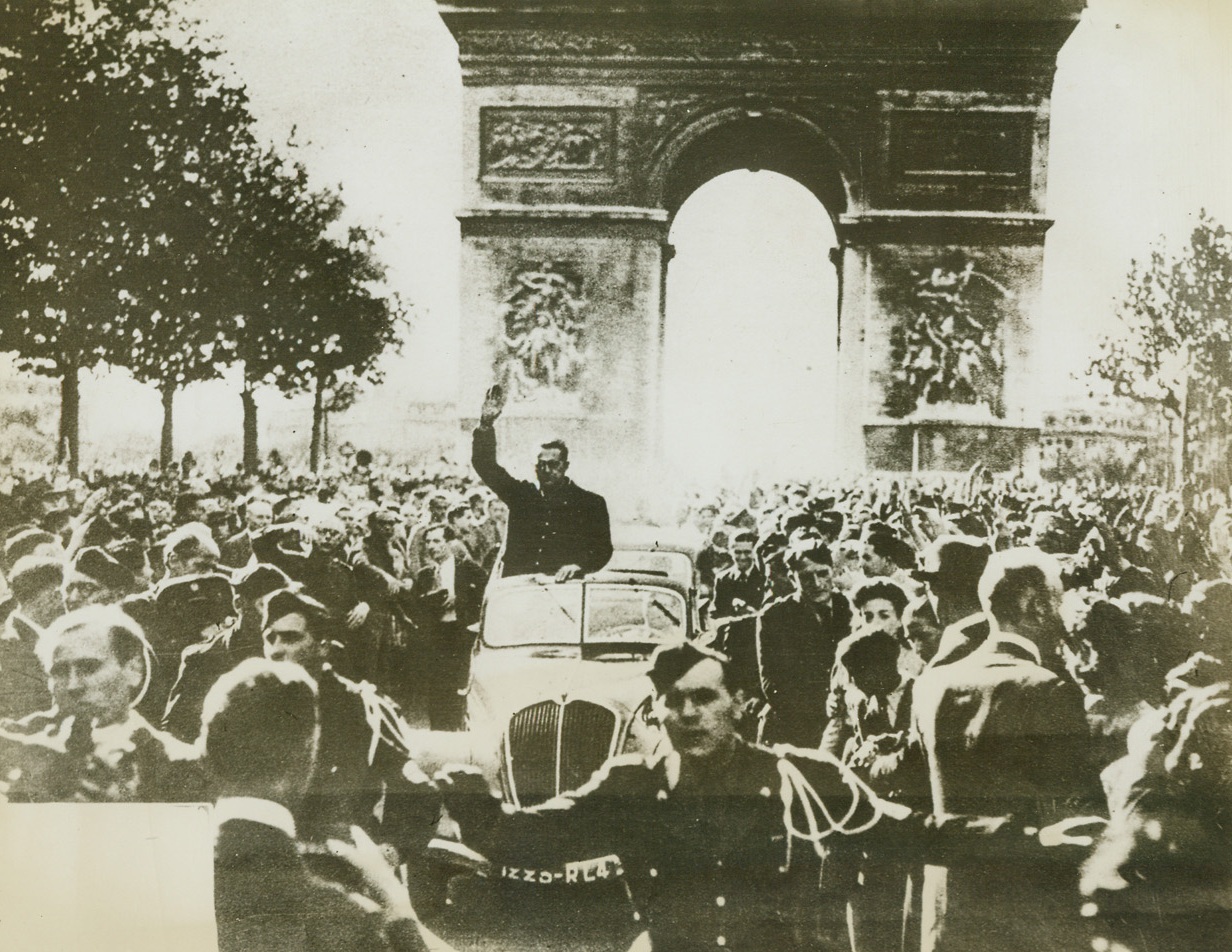
Heil! Heil! The Gang’s All Here!, 12/4/1943. Paris –The Germans probably meant this photo, received through neutral sources, as a neat little piece of propaganda, showing the leader of the French Popular Party taking a triumphal ride through the streets of Paris. However, the camera tells the truth as the French citizens greet the “leader” with the upraised hand salute of racism. Credit: ACME;
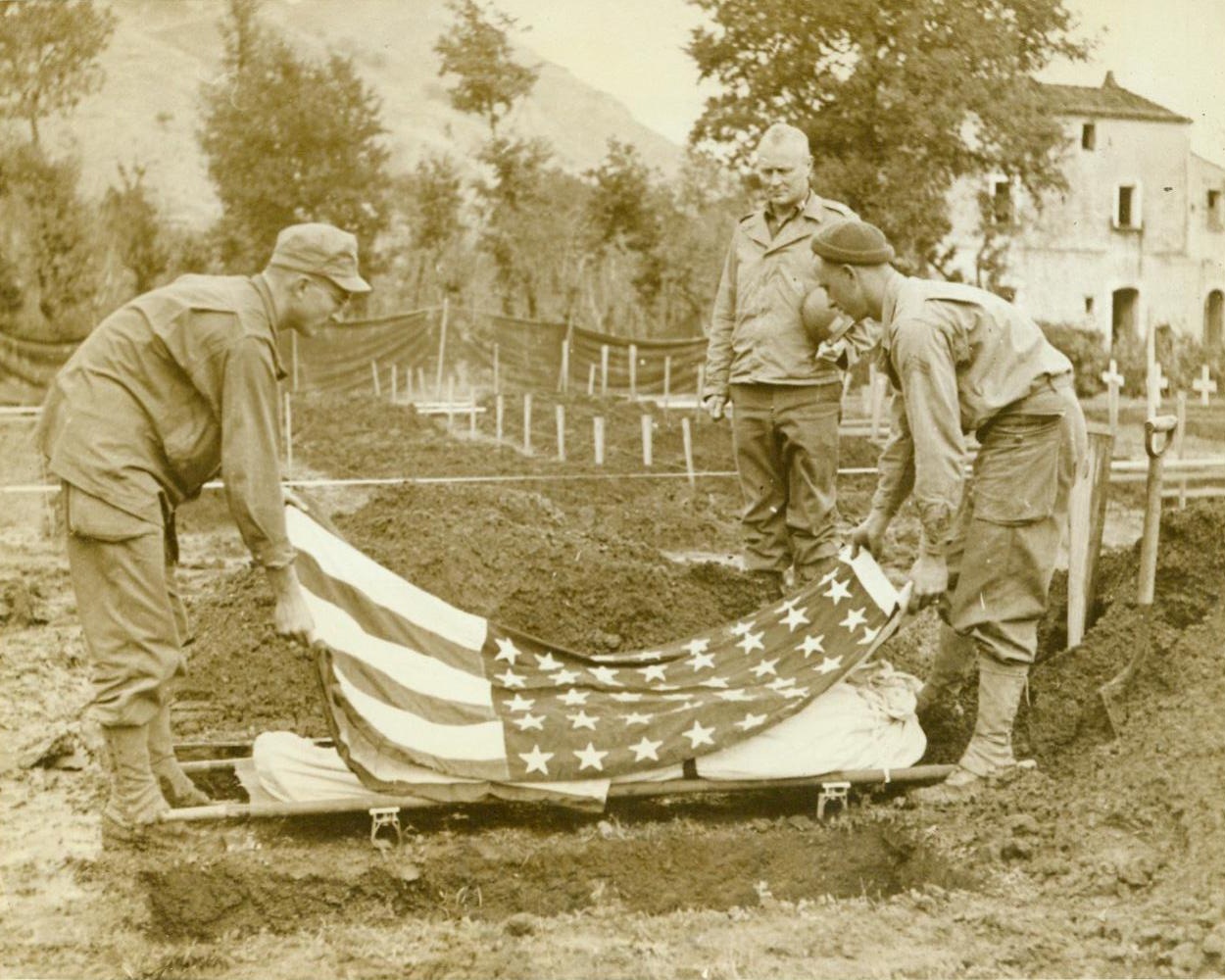
Last Rites in Italy, 12/19/1943. Italy—Capt. Christ A. Lehne, Lutheran minister from Fredericksburg, Texas, stands with bared head as two Fifth Army Fighters remove the stars and stripes from the body of a dead comrade. In the background, temporary markers and white crosses mark the resting places of other Americans who gave their lives in Italy. 12/19/43 (Acme);
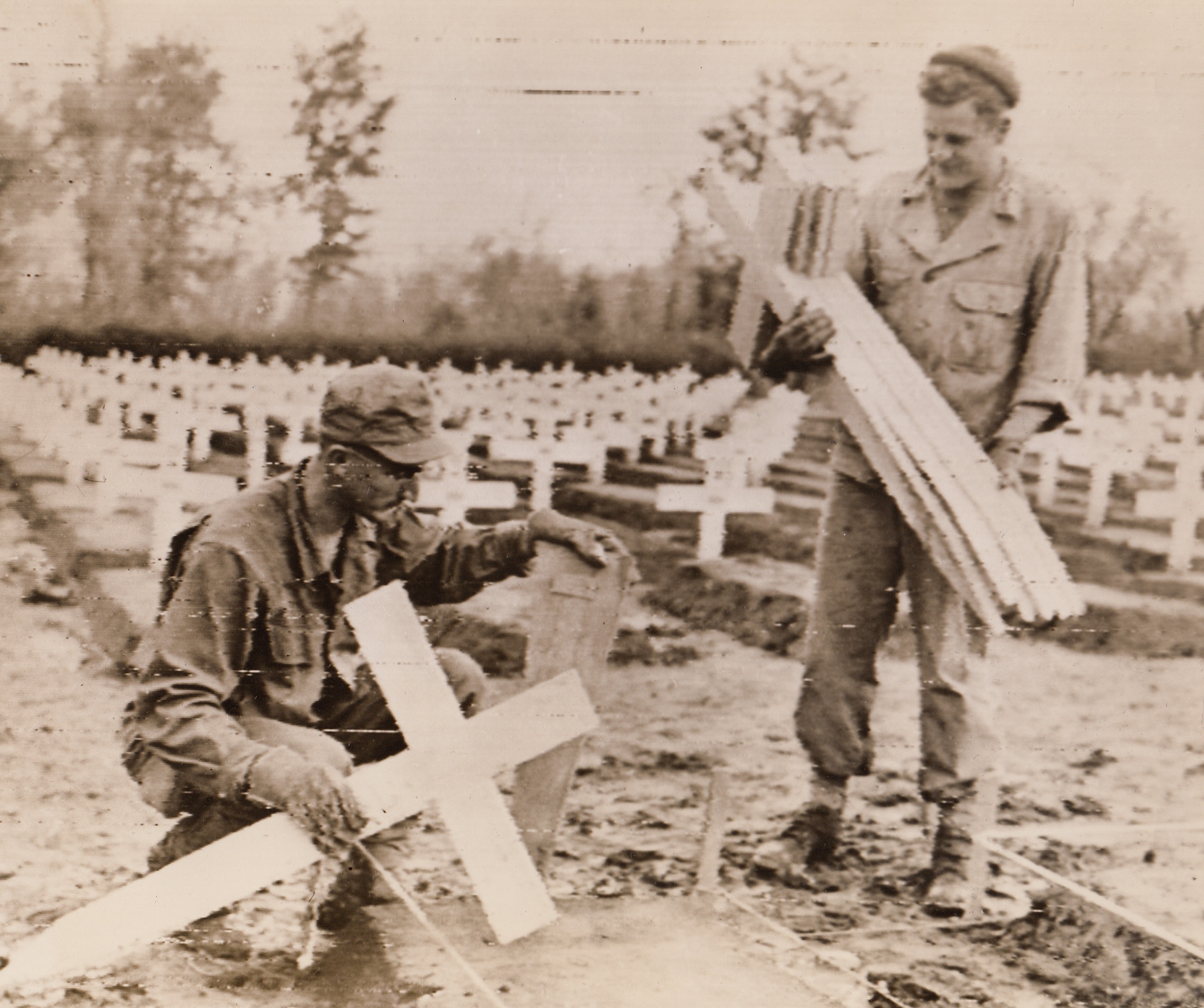
White Crosses Mark Our Graves In Italy, 12/11/1943. Italy –Row upon row of neat white crosses mark the graves of U.S. fighting men who are buried in Italy. Here, two American soldiers replace the temporary markers with the crosses and identification tags. 12/11/43 Credit (U.S. Signal Corps Raidiotelephoto From ACME);
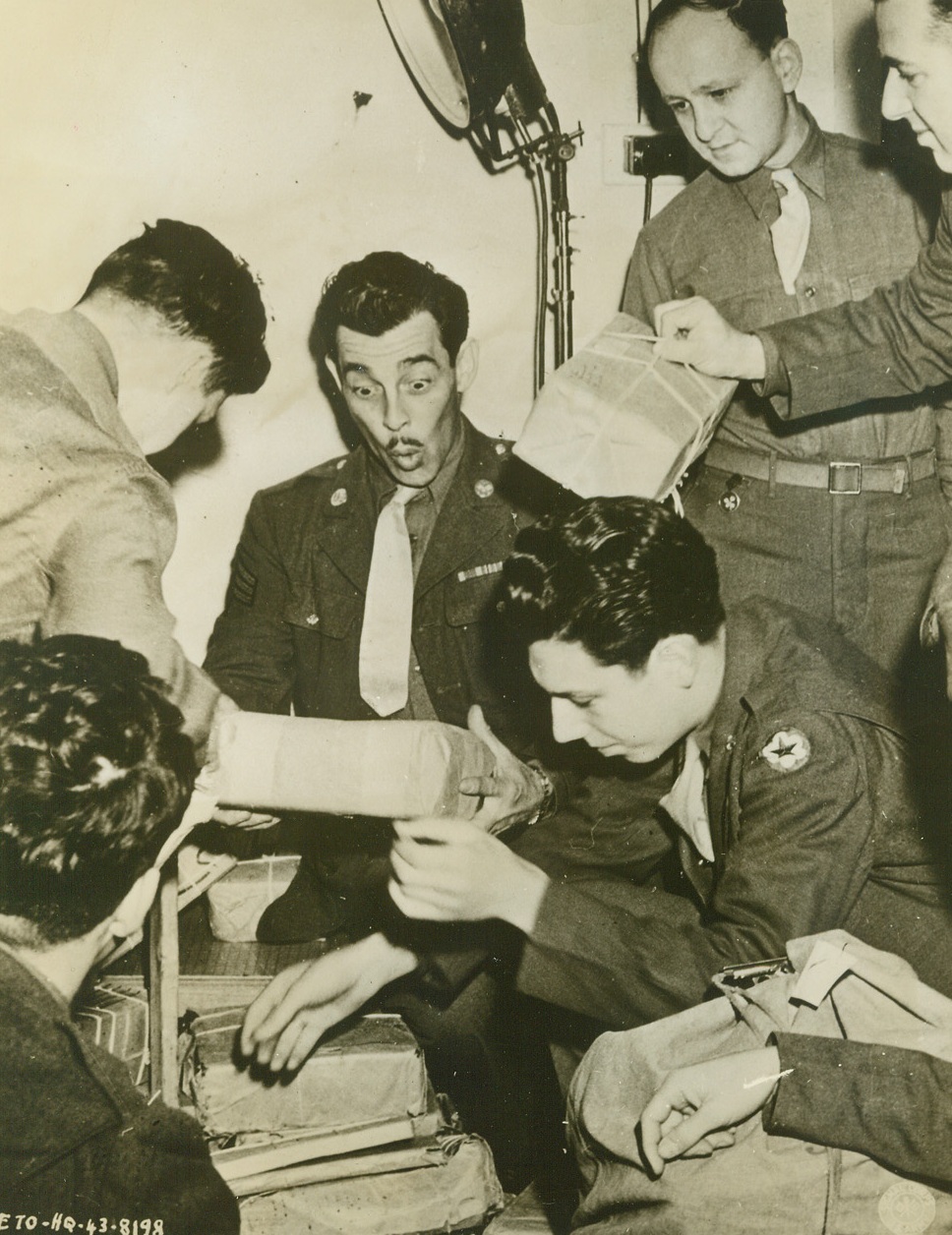
It’s Christmas for Yanks in Britain, 12/13/1943. England – The arrival in England of Christmas packages for Americans soldiers brings cheer and anticipation to this group of Yanks. Sgt. Kenneth L. Thiem (center, facing camera), of Los Angeles, California, whistles with delight as he receives his package, while Pvt. Leslie Rachline (kneeling, right) of North Bergen, New Jersey, eagerly searches for his gift. At top right (left to right) are Pvt. Mitchell Kucharsky, Brooklyn, New York, and Pvt. Walter W. Newman, Fort Wayne, Indiana. Credit: U.S. Signal Corps Photo from ACME;
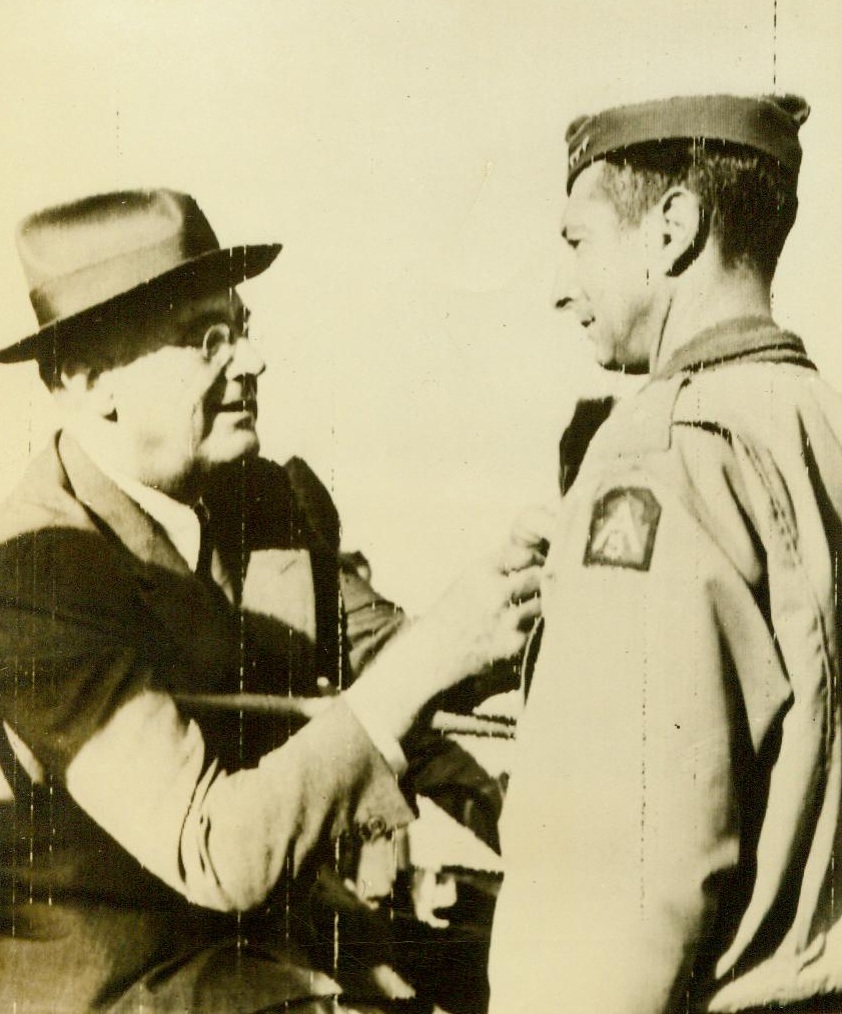
Decoration by The "Chief", 12/13/1943. Castelvetrano, Sicily—President Franklin D. Roosevelt leans out of his jeep to pin the Distinguished Service Cross on the field jacket of Lt. Gen. Mark Clark (Right), USA, commanding General of the Allied Fifth Army, in ceremonies at Castelvetrano, during the Chief Executive’s stop-off in Sicily on his way home from the historic Cairo and Teheran Conferences 12/13/43 (ACME);
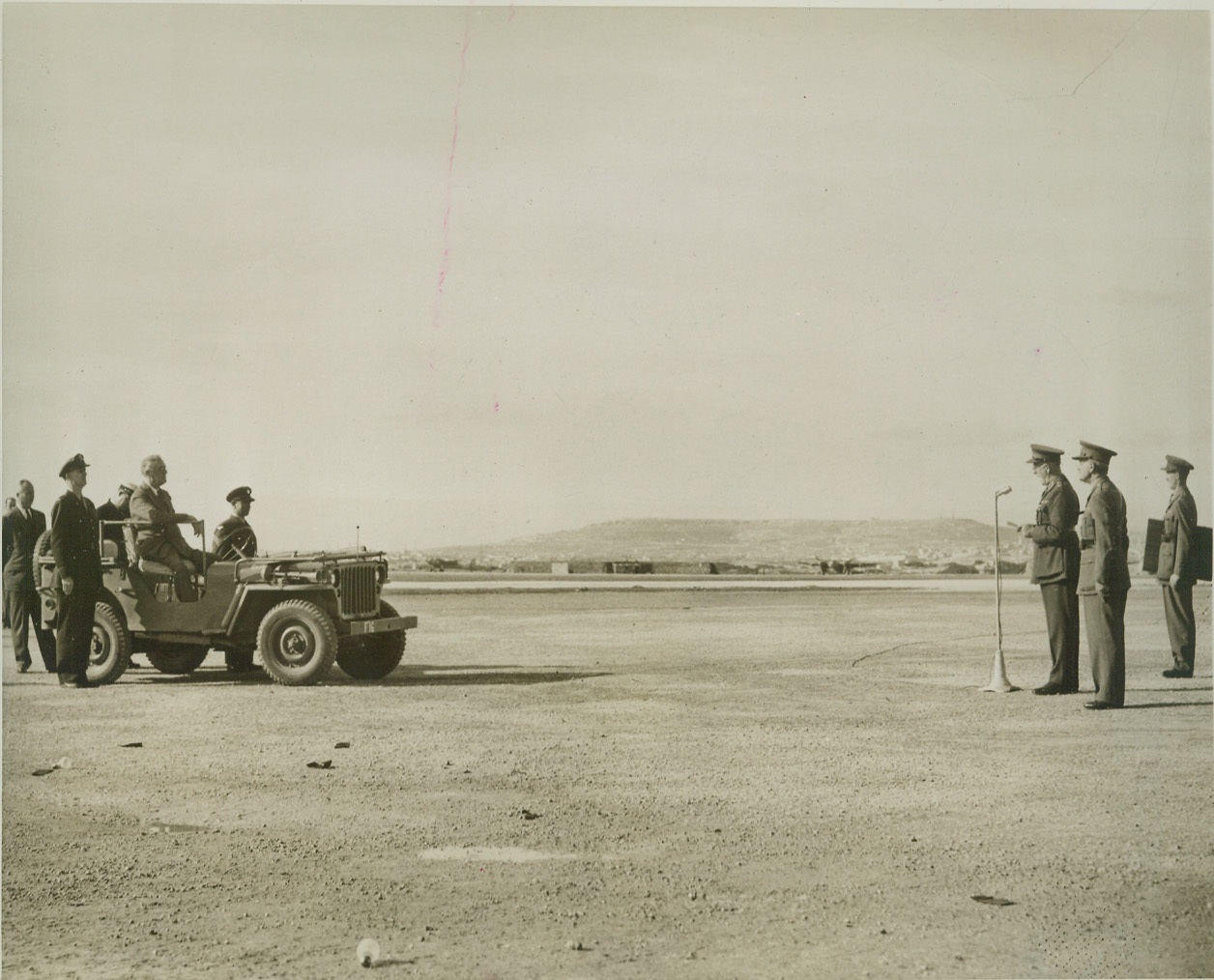
Lord Gort Accepts Scroll from President, 12/14/1943. MALTA – Field Marshal Lord Gort, (at microphone in group at right), as he made a speech of acceptance for a scroll presented to the people of Malta on behalf of the people of the U.S., and expressing American admiration for the courage and fortitude of the Maltese. Just before this photo was taken, the scroll was presented to Lord Gort by President Franklin D. Roosevelt, (seated in Jeep, at left). Standing near the rear wheel of the Jeep, (left foreground), is Major John Boettiger, the President’s son-in-law, who actually handed the scroll to Lord Gort, during the recent ceremony. Credit: (OWI Photo from ACME);
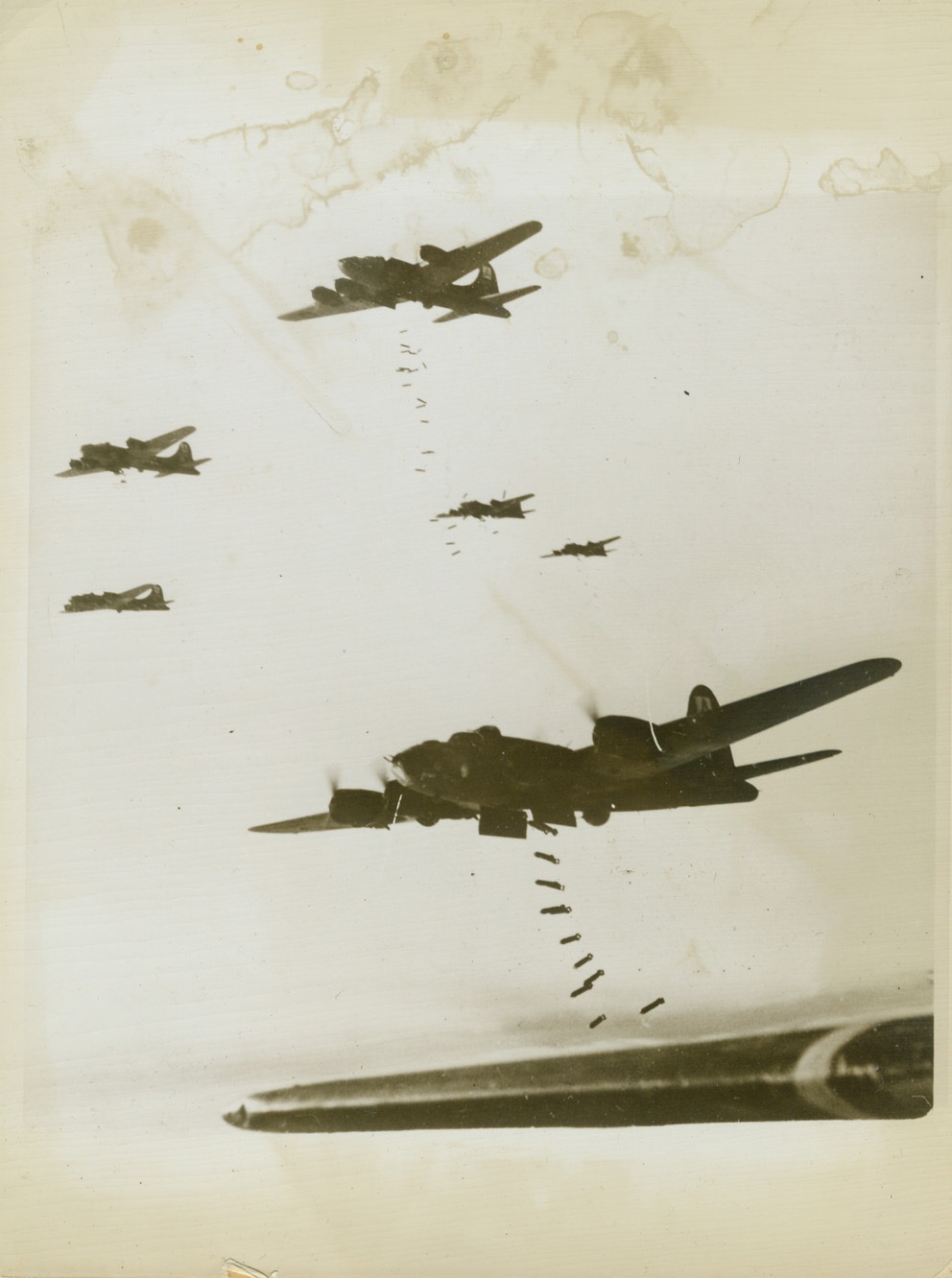
No Title, 12/9/1943.
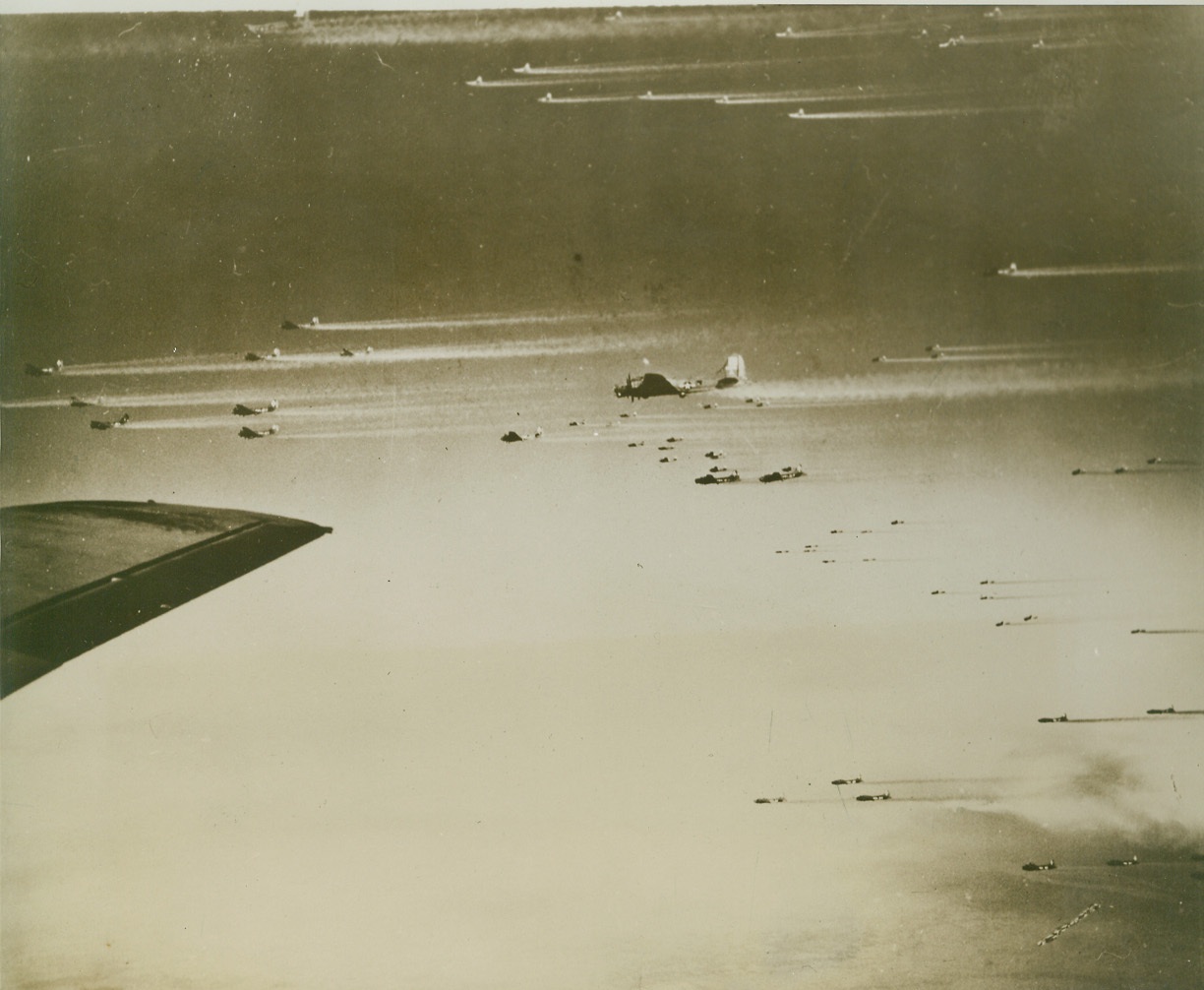
Headed for All-American Raid on Bremen, 12/15/1943. Washington, D.C.—This photo, just released in Washington, shows liberator and flying fortresses of the U.S. Army Air Forces, filling the sky as they head for the heavy All-American raid on Bremen, Germany, last Nov. 26. More than 1,000 planes took part in the raid and more than 60 can be counted in this photo. Credit: U.S. Army Air Forces photo from ACME;
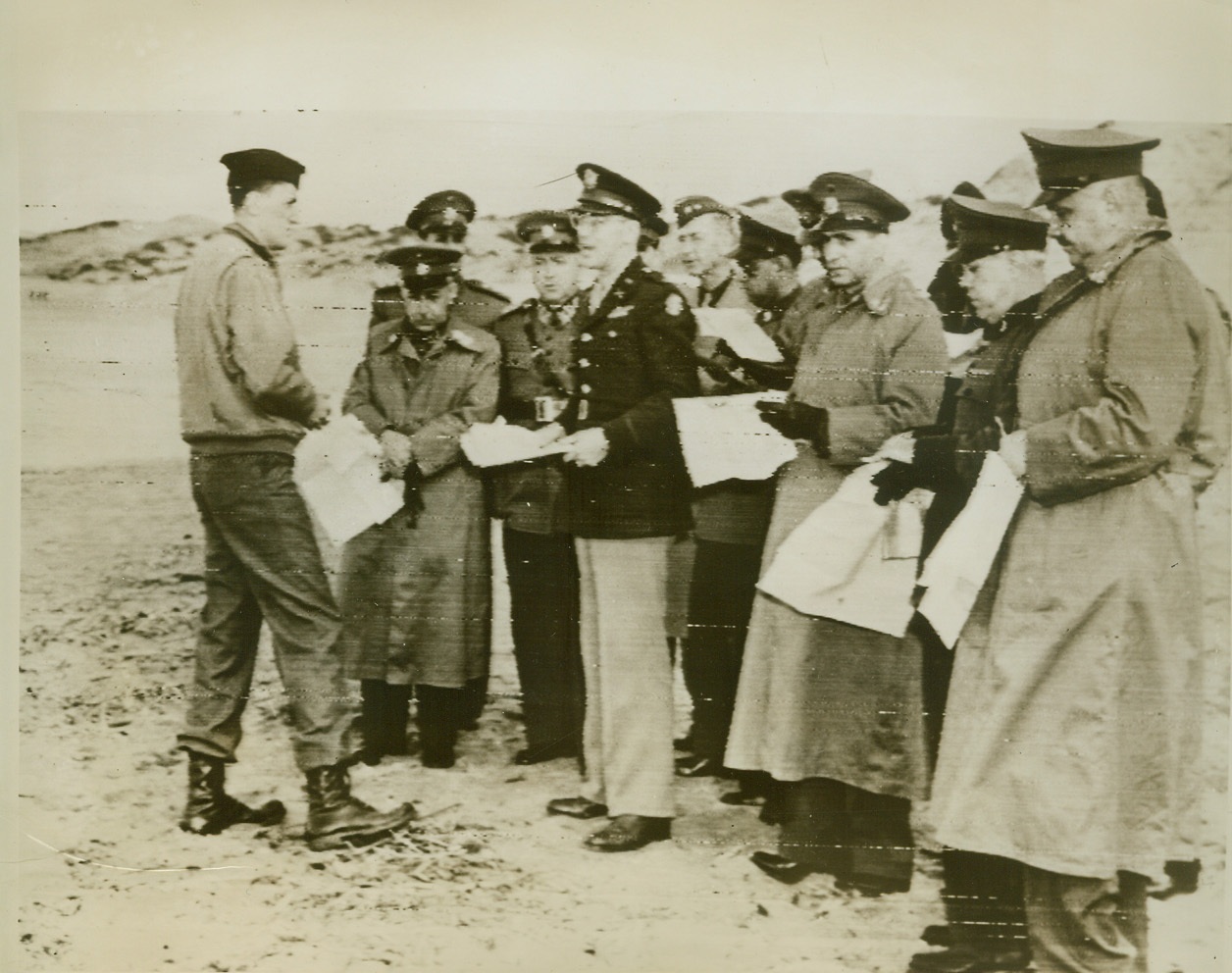
Brazilian Army Men in North Africa, 12/14/1943. North Africa—Members of the Brazilian-U.S. Joint Defense Commission listen to Maj. Dudley Williams give a resume of the Allied invasion of Algeria at St. Eugene, Algiers, one of the landing points. Prominent in the group are: Gen. Mascarenhas and Gen. Anor of the Brazilian Army and Maj. Gen. J.G. Ord, U.S. Army member of the Commission. Officer at extreme left acts as interpreter. Credit: Signal Corps radiotelephoto from ACME.;
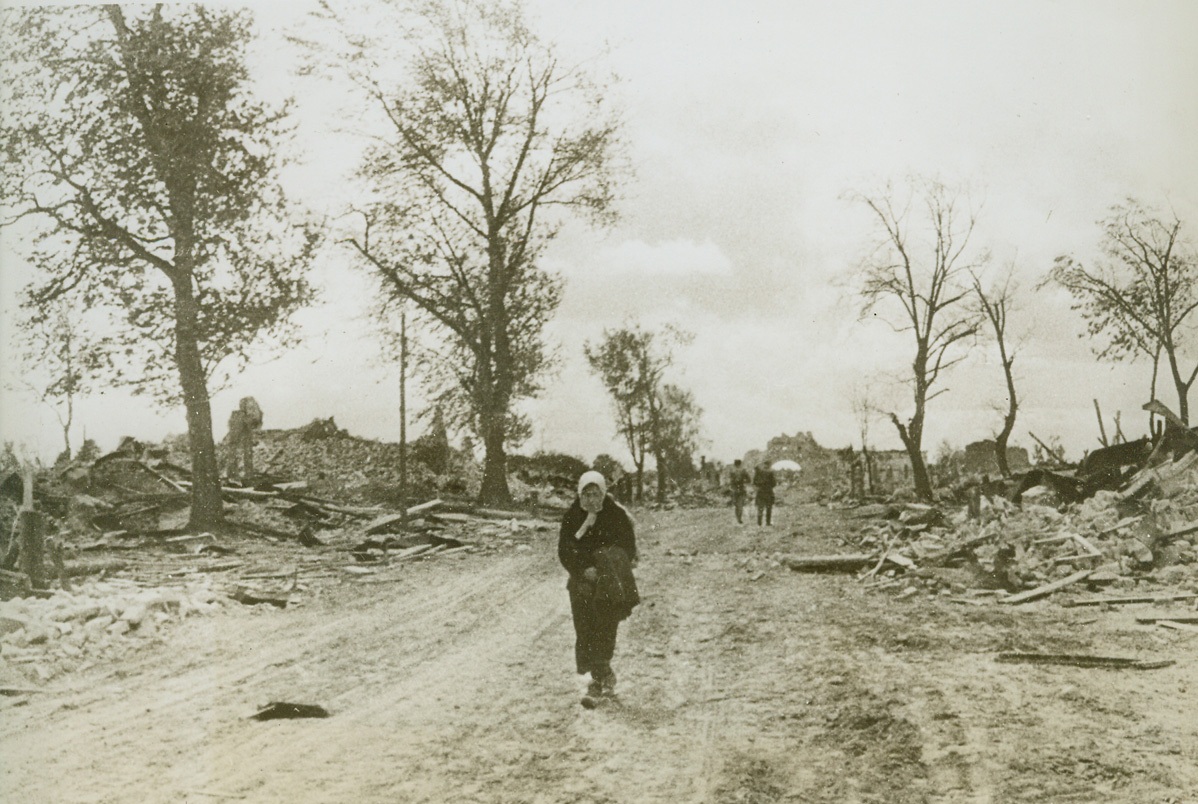
Main Street, 12/14/1943. New York City—A Russian peasant woman does no visiting or “shopping” on the main street of Zhizdra, a town liberated from the Germans. Retreating Nazis used a hit and run policy, burning and razing a town before they retreat. Credit: ACME.;





 Trash & Recycling
Trash & Recycling
 Online Payments
Online Payments
 City Documents
City Documents
 Parks
Parks
 Traffic Court
Traffic Court
 CITY PARKS
CITY PARKS
 Outdoor Recreation
Outdoor Recreation
 Volunteer
Volunteer
 Home
Home TRANSLATE
TRANSLATE
